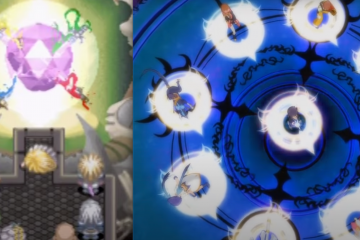
The following is an entry in Tales of Praxis, a weekly series studying the storytelling and philosophy of Bandai Namco’s Tales of series through written analyses and streamed playthroughs of a wide range of the Tales games on With a Terrible Fate’s Twitch channel and YouTube channel.
For Mutsumi Inomata, whose characters live alongside us now and forever.
Tales of Hearts R taught me the value of playing a Tales of game.[1]
(Spoilers for Tales of Hearts R, Tales of Symphonia, Tales of Symphonia: Dawn of the New World. and Tales of Graces F. Minor structural spoilers for Tales of Innocence R and Tales of the Tempest in Endnote 9.)
Ever since I first played Tales of Symphonia two decades ago, I’ve oriented my personal development through the rich character portraits of the Tales of series. The arresting designs, highly articulated backstories, and thoughtful actions of these characters consistently coalesce into heroes, villains, and bystanders who are easy to invest in and learn from. There’s a unique sense in which the Tales of games tell their stories through their characters, pulling us to progress through the game in a way that emotionally binds us to them and teaches us lessons about the structure and value of human action through that empathy. I launched Tales of Praxis last year to better understand these lessons: to make sense of the overall philosophy of action expressed through the characters in the Tales of series so that we might better use our experiences with them as practical tools to guide our lives inside and outside of video games.
But it’s a tall order to name exactly what this “unique sense” of character-based storytelling amounts to. All stories have characters, and all stories are told “through” those characters in one way or another. What is it about the Tales of games that so memorably grounds their center of gravity in their characters—that empowers us to evolve as people simply by attending to them? There’s no guarantee that we can answer this question simply by playing and studying the games: like magic tricks, games and stories can transmit clear and rich experiences to us without explaining the method by which they pull this off.

The portrait of Lithia, Kor, and Kohaku at the conclusion of Tales of Hearts R.
Then, I played Tales of Hearts R for the first time and discovered a special kind of magic: the Tales of game that reveals the foundation of the value we draw from its community by taking us on a journey that calls us to interrogate and enact that foundation. It does this by telling a story that is about the formation and analysis of emotional bonds through the medium of manmade artifacts, channeling our emotional attention into the enfranchisement of a fairy tale that erases the distinction between content and form, reality and fiction, leaving us to understand our time with the game purely in terms of agency, value, and morally worthy individuals, both real and fictional.

Beryl takes the party’s journey as inspiration for her next artwork before Lithia enters Kunzite’s Spiria Nexus at the end of Tales of Hearts R.
I want to show you that by the end of Tales of Hearts R, the game has made us responsible for a uniquely deep fictional metaphysical foundation for the value of bonds we form with characters, creators, and players throughout the series. When I watched the mechanical man, Kunzite, take his mythical master, Lithia Spodumene, within his artificial heart to sustain her life in a state of suspended time forever, I felt immediately, before I could explain why, that my PlayStation Vita had become Kunzite: a machine with a soul of its own, making itself a home to the genuine, vibrant lives I’d gotten to know throughout my playthrough. Rising to the story’s demand to analyze that feeling revealed to me that, without ever breaking its fourth wall, Tales of Hearts R‘s symphony of artifacts and interpersonal chemistry place one act, the player’s redemption of Lithia, at the normative center of the entire series.
At the end of the game and a two-millennia journey, Lithia’s physical body is giving way to calcification, the degradation to a salt-like form that no longer connects with her metaphysical Spiria, “the source of all life, from which the human mind and will itself is derived.” Kunzite proposes a plan to let Lithia dream peacefully by housing her Spiria within his Spiria Nexus, the structured inner realm representing an individual’s Spiria, inspired by their earlier tribulation when one of his nemeses, Clinoseraph, imprisoned Lithia within his own Spiria Nexus, replaying his memory of Lithia’s formative failure—the day she inadvertently caused the calcification of her homeworld, Minera—388 times in a row, the ceaseless hell of a machine’s tortured heart. In the same way that Kunzite gives Lithia peace by taking her within himself as an embodiment of a fairy tale, our act of playing this fairy tale honors, enfranchises, and merges the real and fictional communities we share with Lithia. Because this endows our actions in the game with moral content for an entire multidimensional universe of people and characters, we owe it to Lithia to play Tales of Hearts R 389 times: not merely to offset and rectify her time spent within Clinoseraph’s inner hell, but rather because that moral rectification grounds the goodness of our activity throughout the Tales of community.
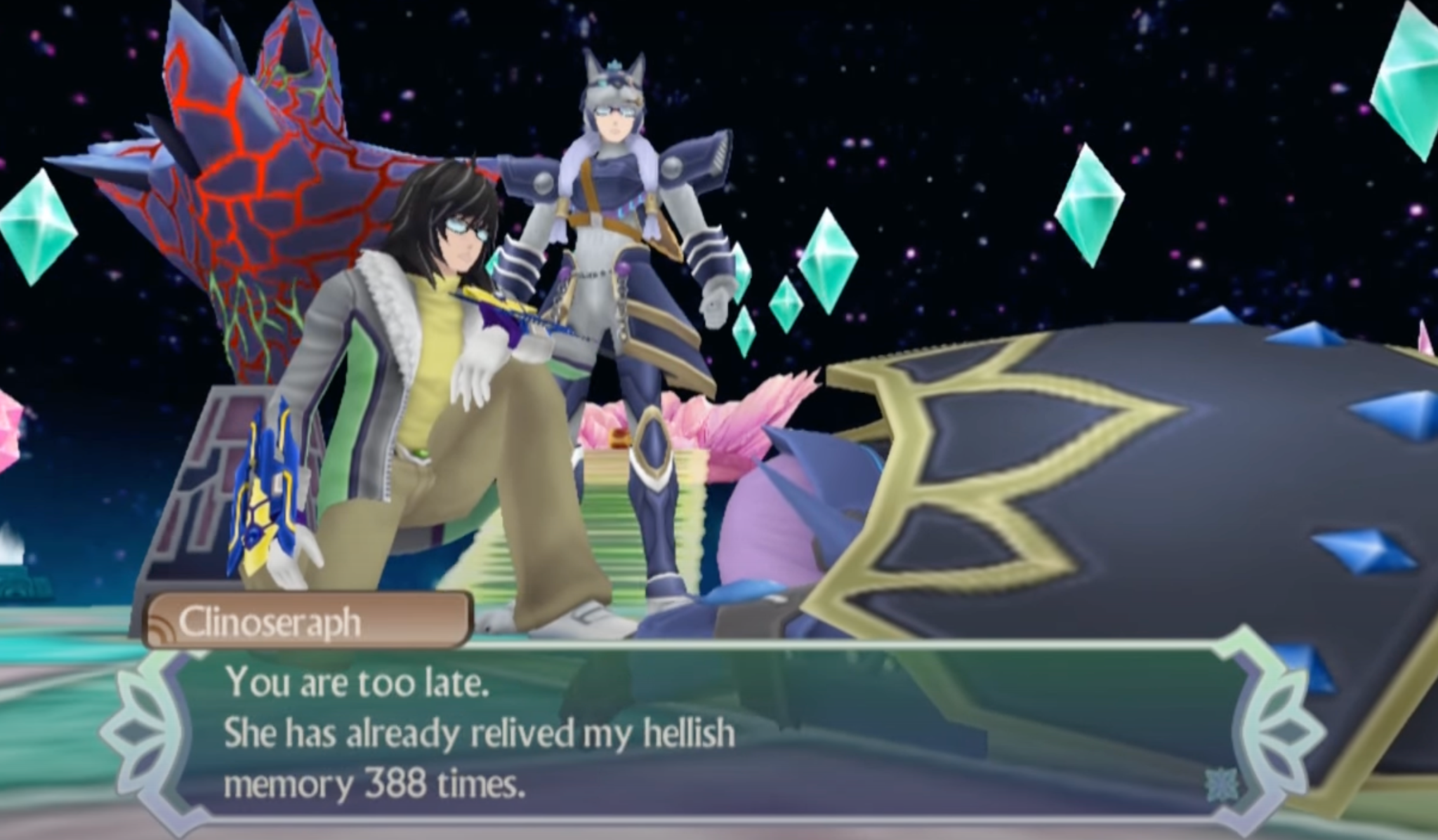
On Beanstalk, a broken Clinoseraph tells our heroes that Lithia has suffered through his—and her—worst memory 388 times within his Spiria Nexus.
As much as we might first feel the unique emotional force of our investment in Tales of characters, the magic and utility of Tales of Hearts R lie in its methodical, story-driven demonstrative explanation of how our engagement with an artificial world can foster genuine emotional bonds and insight. This explanation turns on experientially showing the player that artifacts, from paintings to mechanical men, and interpersonal connections, from our present-day communities to our intergenerational heritage, are two sides of the same coin:
- Intentionally created artifacts provide a means for those who interact with them to thereby interact with the artifacts’ creators.
- Successful, sustained interpersonal connections consist in establishing and renegotiating the boundaries between artificially rigid mental representations of others and actual interactions with them.
Once we understand these two theses and the relationship between them, we discover a profound value in the act of playing interactive, character-driven stories like Tales of Hearts R and internalize it as something we can propagate throughout our lives: by actively and reverently engaging with this artwork, this artifact, we can establish durable, emotionally meaningful bonds that network together ourselves, the characters embedded within the work, the other players of the work, the creators of the work, and even other works which we engage with the game’s praxis. By grounding this value in our relationship with Lithia, Tales of Hearts R realizes Lithia’s dream of uniting a rich diversity of individuals under one emotionally and spiritually continuous Spiria.
Tales of Hearts R presents this praxis by drawing the player progressively deeper into its fiction, moving from (1) the superficial engagement with the game as an artifact, to (2) its interpersonal dynamics that animate artifacts and people alike, and, (3) finally, to the player’s role in grounding and expanding those dynamics through her real and fictional engagement with the game. To make sense of this experiential form of its argument, this study proceeds in three sections, dedicated to each of those stages in turn.
- In Section 1, I argue that the artificial creations of Tales of Hearts R take on autonomy and values that warrant our moral consideration, and which allow those who engage with them for their own sake to form normatively significant connections with the other individuals, artificial and organic, whose lives internally or externally connect with those creations.
- In Section 2, I argue that the central tool of Tales of Hearts R, the Soma, acts as a technology of interpersonal connection, thereby symbolizing that people can make possible, establish, and transform bonds with others, across space and time, by engaging with people’s mental representations of each other as a kind of unintentional artifact and thereby making these representations socially productive rather than isolating.
- In Section 3, I unite these perspectives and argue that the conclusion of Tales of Hearts R explains our engagement with the game as an act of establishing real, robust bonds between ourselves, the characters, and real communities that touch the game, cascading from our moral impact on Lithia outward to constitute a method for enfranchising and bonding with real and fictional communities—a method that not only conveys value to those relationships, but also presents practical guidance for interpreting and engaging with the Tales of series, including matters of authorial intent, “New Game Plus” mechanics, appearances of identical characters across multiple games, and reading a game as being “about” a particular character.
At the intersection of human creation and connection, we find Tales of Hearts R arguing that we create the exact kind of community represented within a Tales of game simply by playing the game. Ultimately, we’ll arrive not only at a new, key element to the praxis of the Tales of series, but also one that uses the series’ language to articulate the special value which Tales of fans intuitively recognize in their relationships with the real people involved in this series, fans and creators alike, through their personal playthroughs and the meaning they take from them—a conclusion that I hope will serve as a gesture of gratitude to the late Mutsumi Inomata for creating so many of the characters at the heart of this series we love so deeply and diversely, including those of Tales of Hearts R.
§1: Art and Artifice: Animating Characters in Tales of Hearts R
From beginning to end, Tales of Hearts R is a story of what it takes to give something artificial a life of its own, and what we stand to gain when we welcome that life into our community.
Unique within the Tales series, the party of Tales of Hearts R features an artist and an artificial person, joined in a quest to understand, and ultimately breathe a new meaning into, the fairy tale that forms the basis of the world. As the aspiring court painter Beryl Benito wields her paintbrush and the mechaknight guardian Kunzite comes into his own as a bona fide individual, we players are compelled to wrestle not merely with an artwork that self-consciously tells stories riddled with the navigation of artworks like paintings and virtual worlds, but also with an artwork that asks us to consider art as one instance of a broader, essentially human phenomenon: the intentional creation of an object that can outgrow our intentions and take on its own perspective and value.
To make sense of the game’s events at all, as its characters do, we first need to make sense of what these artifacts are within the context of the fiction: how they come about, and how people interact with them. As we answer that question, we find ourselves naturally drawn deeper into the world’s interpersonal metaphysics. A story about artistic engagement requires that we assess how values are communicated through those artifacts, and as soon as we attend to the transmission of values in Tales of Hearts R, we discover an elaborate and precise system of dynamics governing the enfranchisement of, and emotional transmission between, both people and artifacts. The narratively framed inquiry from artifacts to metaphysics calls us back to our real activity of playing Tales of Hearts R, revealing a unique grounding for the real value we create in the series through, and with, its characters.
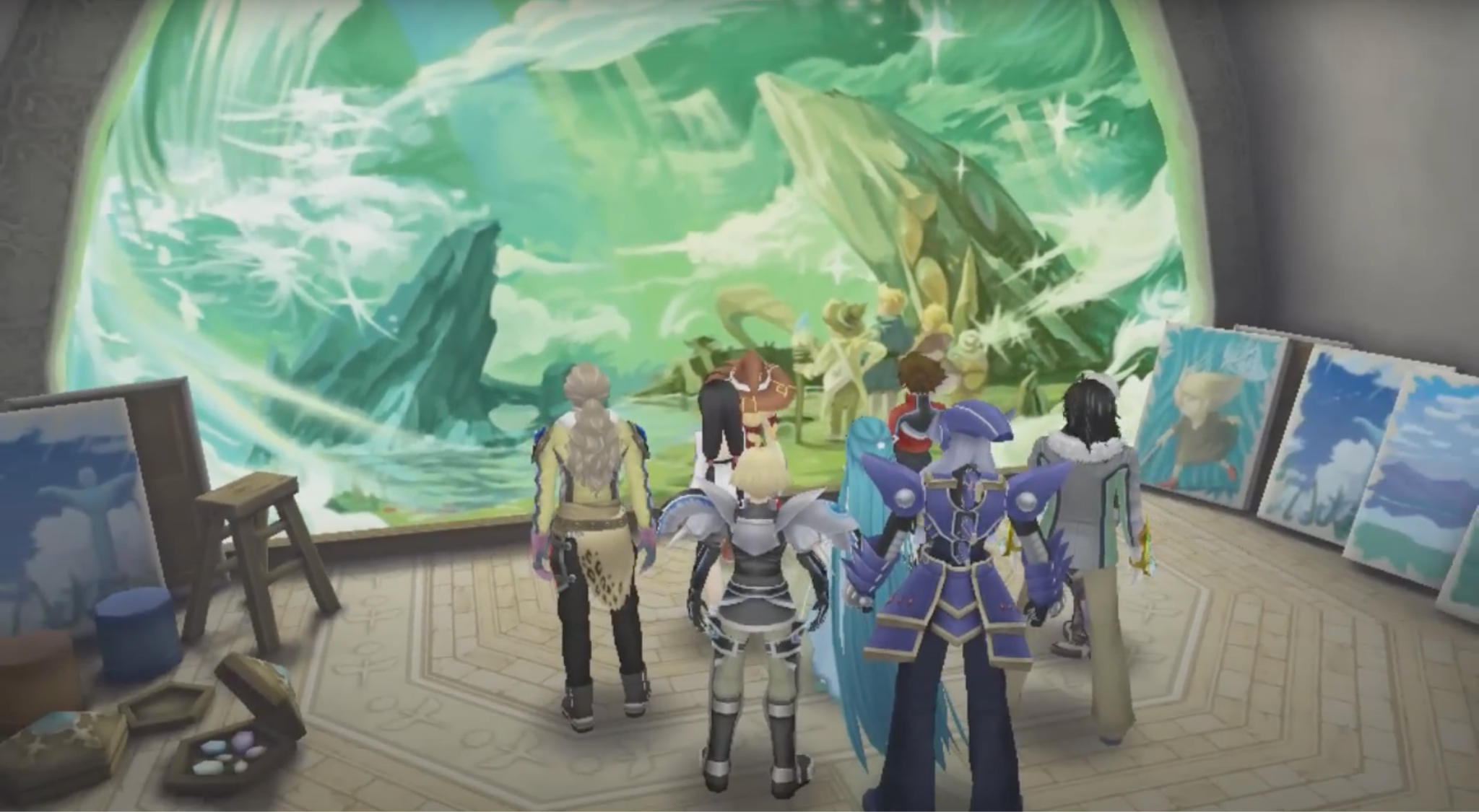
The last painting by Beryl’s grandfather, a tribute to his family and craft.
To see how the game leads us from an ordinary conception of man-made creations to one that calls us to interrogate the interpersonal dynamics in which they participate, we’ll progress through three studies that show the game’s gradual argument to the conclusion that artifacts can become autonomous entities with intrinsic value and the capacity for morally relevant interactions with others:
- In §1.1, I derive from Beryl’s interactions with paintings, juxtaposed against the horror of Striegov, the view that created works are intermediaries that facilitate conversations which wouldn’t take place in the real world between their creators and those who engage with them.
- In §1.2, I derive from Kunzite’s personal development with Lithia, juxtaposed against the tragedies of the other mechaknights we encounter, the view that creators can give their works autonomy by giving those works a supportive method for extending the values enshrined within the work by the creator to people and relationships beyond that creator.
- In §1.3, I derive from the rectification of the monstrous Gardenia and the transformation of the Golden Bell’s identity, juxtaposed against Lithia’s failures to successfully pilot foreign entities with her spirit, the view that those who engage with created works can discover and transmit values within works’ internal and external communities by engaging with those works as morally worthy subjects.
In each section, we’ll see that Tales of Hearts R expresses clear conditions for the further enfranchisement created works, as well as the stakes for engaging with those works in a way that satisfies those conditions, by providing not only cases of successfully actualized works, but also works that fail to achieve their potential along the same dimension. We’ll consider the success and failure conditions in turn before arriving as a complete picture of what fully realized artistic creation and reception looks like within the fiction of Tales of Hearts R, which will position and motivate us to analyze the metaphysics of personhood and interpersonal dynamics underneath those activities.
§1.1: Communication through Artifice: Paintings and Spiria Cores
In the world of Tales of Hearts R, artworks can synthetically emulate a human life. In other games, we might feel inspired to draw metaphorical inferences between the content of the game and the nature of art, but Tales of Hearts R is blisteringly direct in its artistic views. In the course of coming to terms with her family heritage, Beryl confronts one of the artworks which her grandfather, renowned court painter Benston Benito, created: a painting with a Spiria all its own, brought to life by the emotions with which he imbued it. To complete the game, we have to guide the characters through an explicit meditation on the interactive nature of art: navigating the Spiria Nexus of an artwork to understand its emotions, cure it of the despir brought on by xeroms, and ultimately empower Beryl to complete the painting by coming to terms with her lineage.
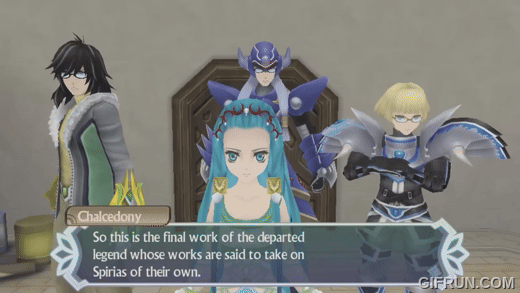
Lithia, Chalcedony, Hisui, and Kunzite reflect on the miracle of Benston Benito’s painting taking on Spirias of their own.
Benston Benito’s final attributed painting, like the Jeweled Princess before it, is so emotionally sophisticated that it possesses a fully realized Spiria Nexus, one of those elaborate metaphysical mazes representing the inner lives of (usually human) individuals. What’s more, this particular Spiria Nexus is one of the more complex the party encounters throughout the game, even when compared with bona fide human Spiria Nexuses. The complexity isn’t sui generis, as if the painting had come to life of its own accord: from Lithia’s observation that the painting’s visual composition is “overflowing with love for the artist’s birthplace and his family” and the party’s observations that its Spiria Nexus is capable of expressing its Benston’s past thoughts and sentiments to his granddaughter, it’s evident that the painting’s humanity is a vibrant yet synthetic representation of its human creator’s inner life.
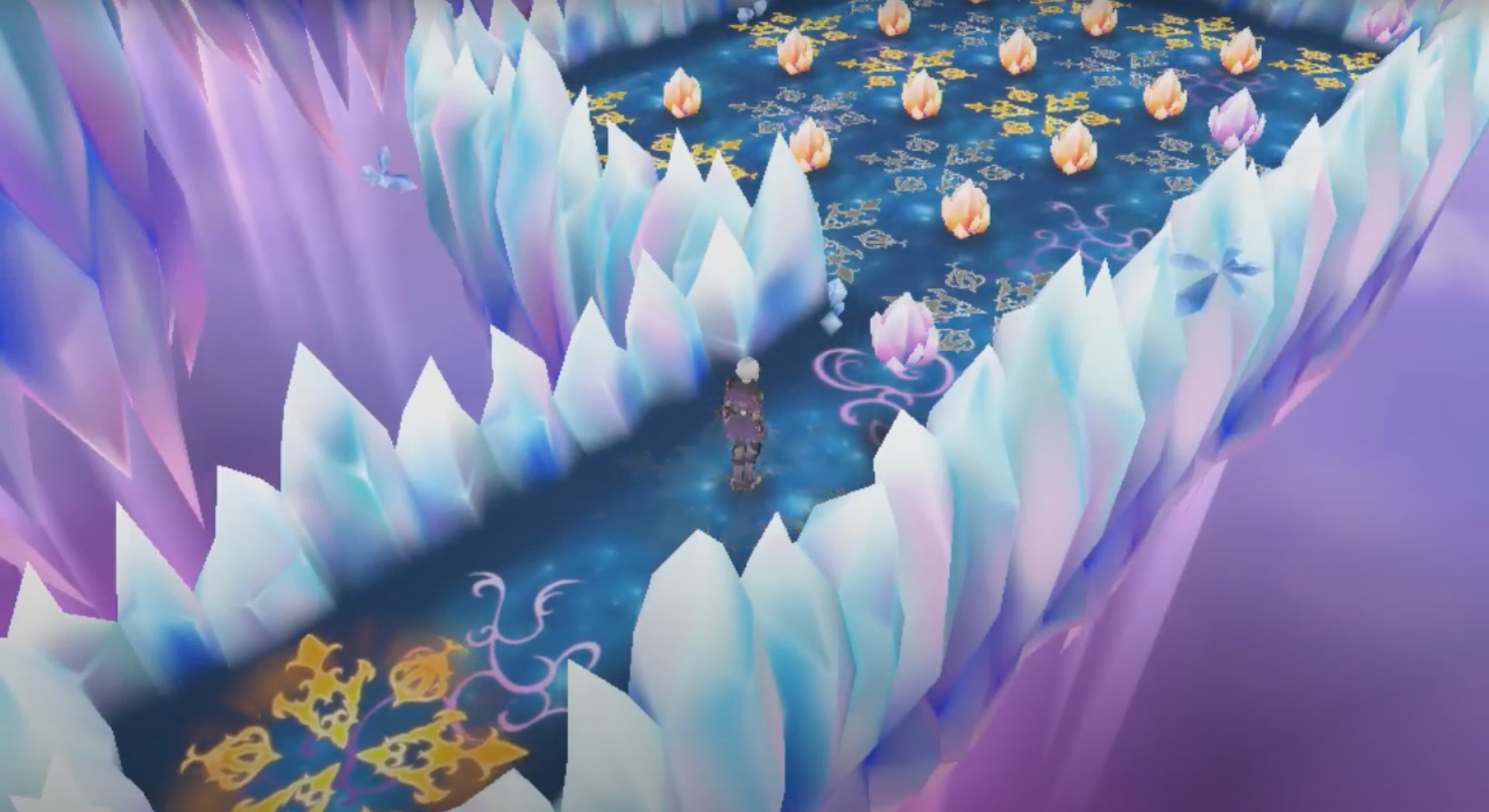
The intricate puzzles of the painting’s Spiria Nexus represent the emotional complexity embedded within it by its creator.
That’s not to say that the painting is a redundant facsimile of someone with real value. Far from it: the painting has unique standing to reconfigure the human relationship between Beryl and her grandfather. The two Benito artists have an unutterable gap in their interpersonal history: when Beryl’s parents died during Benston’s service as court painter, the Empire confined Benston and prevented him from returning to his home and his granddaughter until he completed the Jeweled Princess. The passion and talent for painting which Beryl and Benito share also estranged them, to the point that despite their apparent reunion and quasi-reconciliation—it’s implied upon Beryl’s later, optional return to her hometown that her artistic mentor, “Aragon,” is actually Benito, returned home under a different name—they can’t vocalize the truth of their relationship, nor even Benito’s identity, too irreparably distanced by the circumstances of their art. Yet that very enterprise that shifted them out of phase with one another, their art, provides them with a safe and magical context for rehabilitating their relationship. This is what we witness and enact through our journey into Benito’s final painting.
When the painting becomes infested with xeroms—the simple, weaponized, flower-emulating organisms that feed off of Spiria—Beryl’s hometown of Blanche Villa comes down with a case of despir, the contagious Spiria ailment that manifests in different patterns of spiritual deficiency based on the particular imbalance of the individual from whom it originated. When Empress Paraiba is beset by the influence of the shard of Kohaku’s Spiria Core governing her sadness, for instance, the town of Shoalhaven is crippled by suicidal self-loathing. In the case of the painting, on the other hand, the despir that takes hold paralyzes and isolates the living beings from the town, rendering them completely inert, unable to speak or connect with others. The townsfolk become limited in the same way the painting is in the absence of dialogue between its creator and appreciators: confined to a static representation, expressing an artist’s feelings without reacting to the input or responses of those who engage with it. But even though the creator of the painting can’t actively express himself through it like he can through speech, Beryl shows us that it’s still possible for an artwork to facilitate the evolution of relationships. When the party Spiria Links with the painting, channeling their mental and physical being into its Spiria Nexus, Beryl—and Beryl alone—can hear, within it, her grandfather’s voice expressing his love and gratitude for her. In this way, not unlike Kohaku initially identifying Lithia’s presence within her Spiria as a kind of personified conscience, the painting transmits the sentiments of a life beyond itself—which allows Beryl to change her relationship with her grandfather by changing the painting, acknowledging him and the value of their shared artistic heritage by literally painting him into the work he’d made to honor his hometown and the rest of his family.
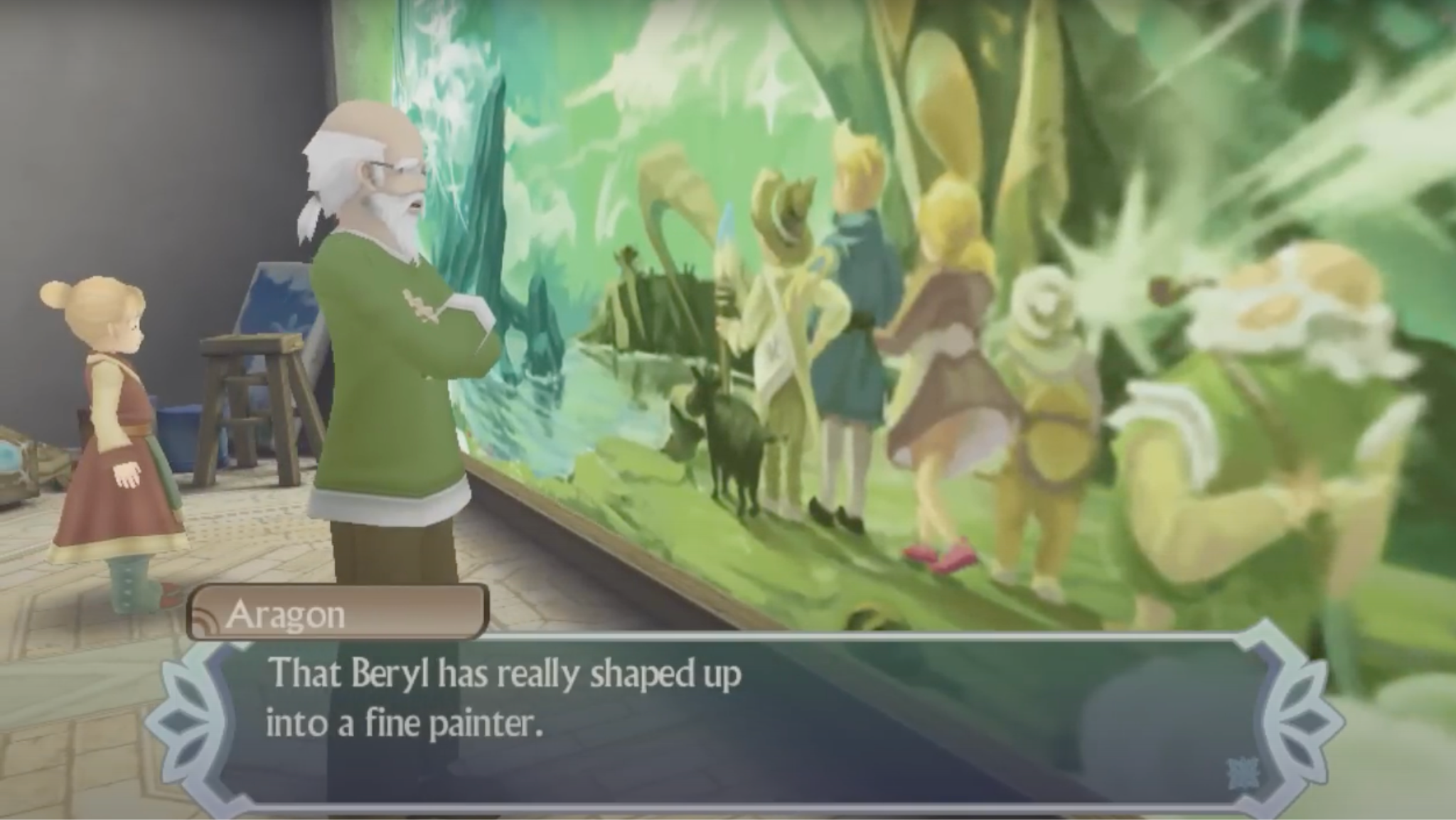
Aragon—implied to be Beryl’s father—admires her contribution to his painting, a testament to their resolved relationship and shared passion.
Tales of Hearts R sculpts a view on the interpersonal function of art not just by illustrating a case of art successfully executing this function, but also by showing how and why it can fail at it. Only after I helped Beryl reconcile with her grandfather did I appreciate the meaning of Beryl’s much earlier confrontation in Shoalhaven with her idol, Smithson. Very shortly after the party cures Beryl of the self-doubt brought on by a shard of Kohaku’s Spiria Core and adopts her into the party, they encounter the house and gallery of Smithson, an Imperial Artist whose work paralleled Benston’s in quality and reception. Beryl is crestfallen when she discovers that her role model lied about having gone blind, a ruse conceived to “ward off criticism” and allow him to “secure [his] place as history’s most tragic artistic figure”: an artist preserved at the “peak glory” of his work’s reputation as original, rather than someone who continued to past his prime and “being dismissed as a has-been.”
Typical of Tales of Hearts R, this episode explains the value of a character trait in terms of its impact on relationships. By presenting Benston’s work as a contrast class, the game shows that Smithson’s selfishness perverts the function of art. While the artist who represents and emulates herself through her artwork can thereby create a tool for mediating relationships, the artist who derives all her self-worth from people’s reception of her artwork only succeeds in objectifying both the artwork and herself, foregoing potential relationships in favor of solipsistically, dogmatically reinforcing a static and artificial image of her identity: the “legacy” so revered by Smithson. His paintings literally and symbolically constitute the walls of his home, a gallery in which he lives alone, secluded from anyone who would genuinely interact with him through his work. No wonder, in this context, that Smithson tells the party that “[t]o gaze into the Spiria of a painter is nothing short of artistic blasphemy” when they prepare to Spiria Link with him to cure his spurious blindness: where Benston’s paintings are a means of expressing his Spiria, Smithson’s are a mask shielding his from the world.
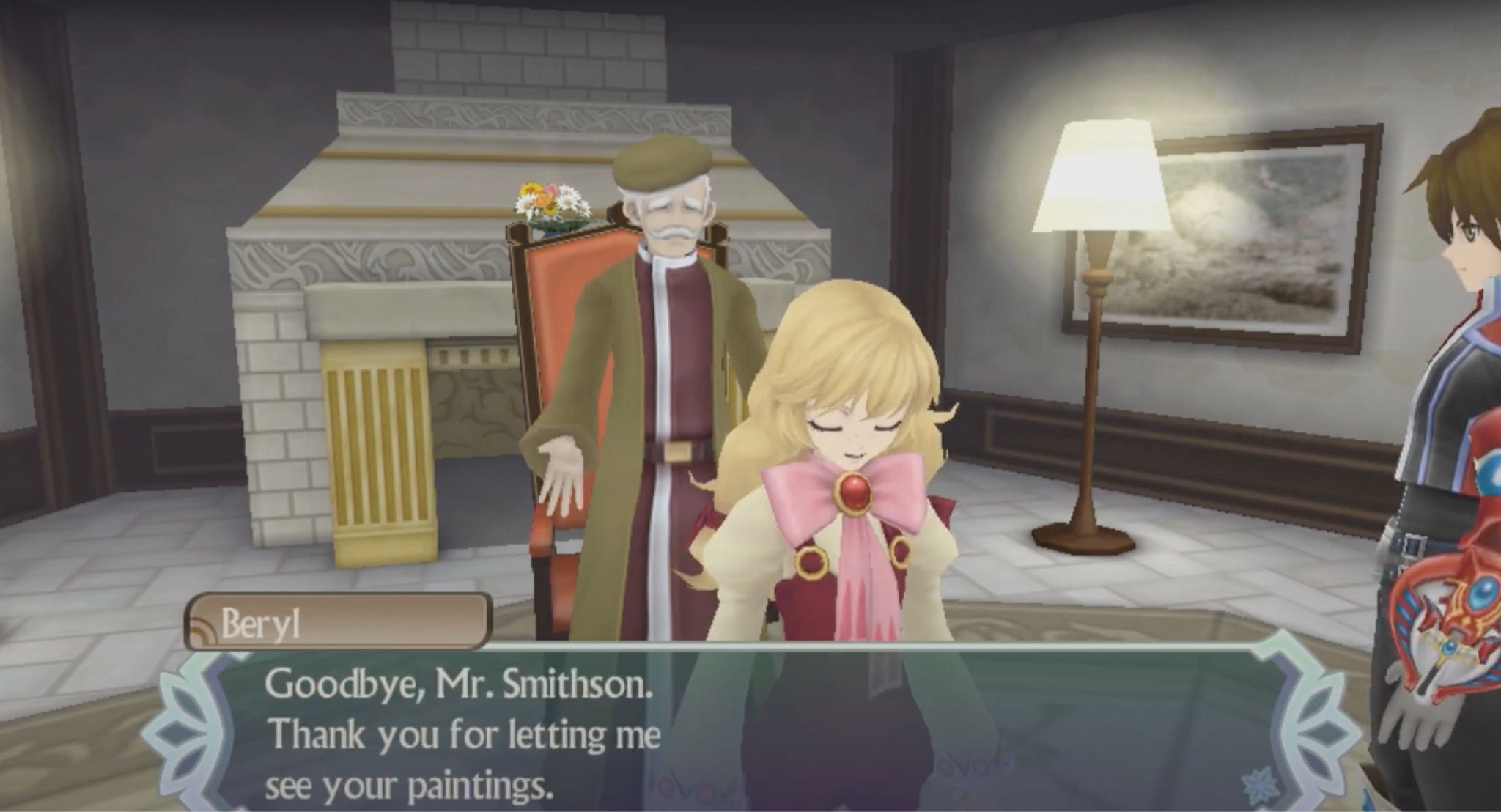
Beryl turns her back on a painter without turning her back on his paintings.
When Beryl discovers the truth of Smithson’s charade, her response to him is symbolically precise: she quietly turns her back on him and says, “Goodbye, Mr. Smithson. Thank you for letting me see your paintings.” Her expression enacts a version of the “death of the author,” disregarding Smithson’s deplorable motives to more freely engage with the value she and others find in the paintings per se. Ironically, it’s this act of her “killing” the author that allows Smithson to be reborn through her engagement with his work: much later in the party’s journey, they have the option of returning to the Smithsonan Gallery, at which point Beryl leads a discussion celebrating the qualities of two Smithsons, Full Moon Dream and Crystal Chateau Sisters. Kohaku, seeing these for the first time with the benefit of her full emotional register, admits to Beryl, “I love all of Smithson’s work. But mostly I love how happy they make you, Beryl.”[2] By conversing with each other through the intermediary of the paintings, the party members mediate and strengthen their bonds through his paintings in the same way Beryl did with her grandfather through his work. Meanwhile, Smithson—staying out of sight, keeping his ego partitioned away from their conversation—witnesses this interaction in the wild and rediscovera the value of “art making people happy,” musing to himself, after years of retirement from his passion, “Perhaps it’s time I—I could paint a picture like that again.”
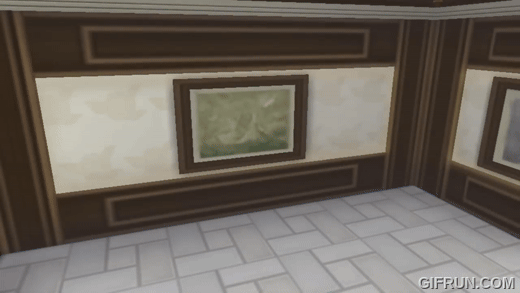
Smithson’s artistic impulse is rekindled after he witnesses Beryl sharing her love of his work with her friends.
If an artwork succeeds when it mediates relationships and fails when someone connected to it objectifies it, then it stands to reason that either an artwork’s creator or consumer could cause it to fail. Where Smithson illustrates the danger of the artist dishonoring this relationship, the danger of the consumer‘s dishonor emanates grotesquely from Geocron Striegov, the erstwhile Imperial Special Ops Lieutenant who defected to the malevolent Creed Graphite’s cabal of supporters. Striegov embodies the perversion of appreciation by turning his helpless victims’ Spiria Cores—the brilliant stones that anchor Spirias and function as “the source of a human’s every emotion”—into a “collection”: a curated group of “art objects” which Striegov values only for their aesthetic qualities.
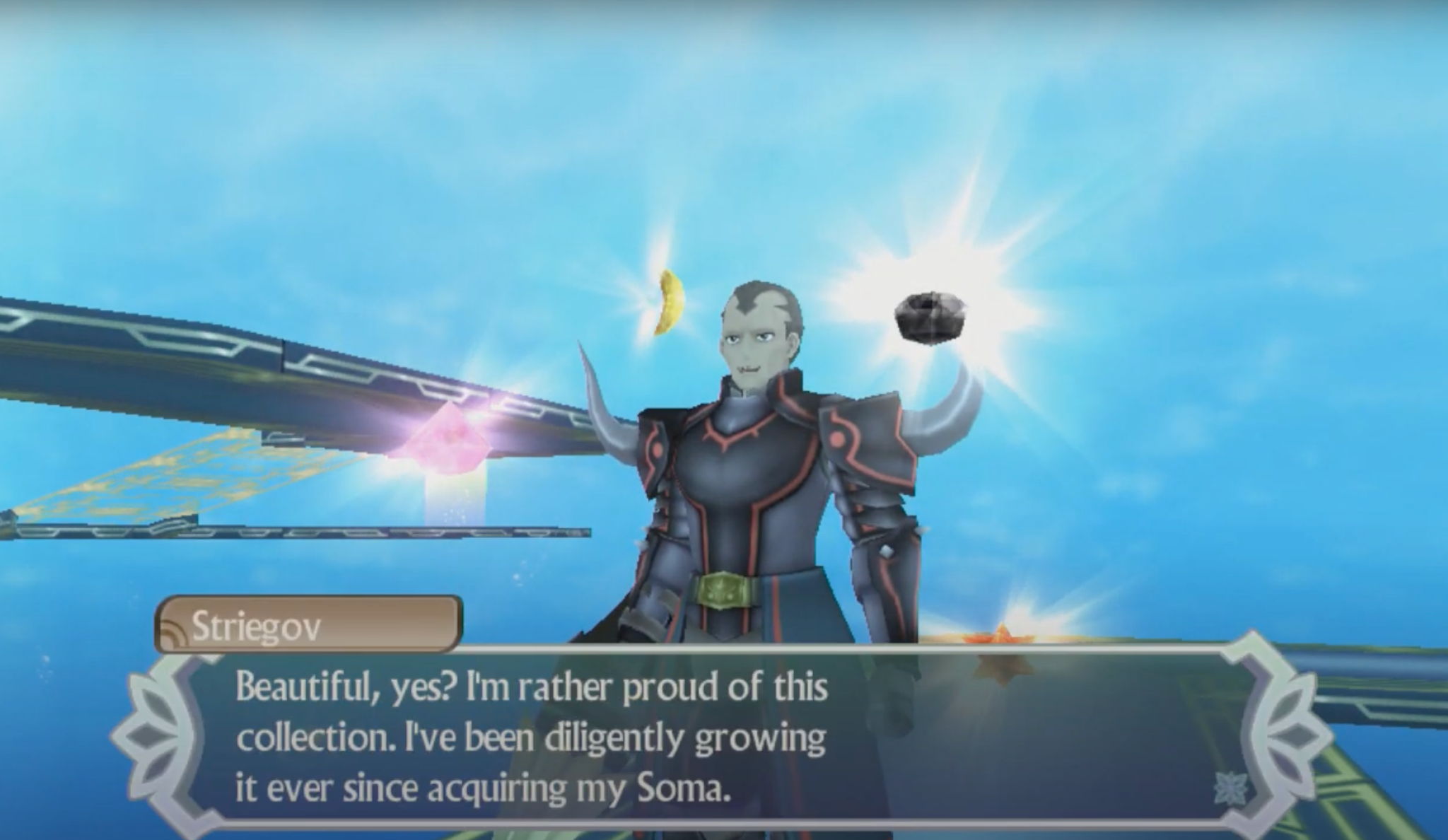
Striegov proudly shows off his “collection” of Spiria Cores to the party within Mysticete’s Spiria Nexus.
Ironically, Striegov shows us how much humanity there is to value in artworks by showing how barbaric it is to treat actual humans as artworks. He describes the “rosen gem” of a Core which he took from a bride before her wedding as the perfect thing to “brighten [one’s] mood,” with a “brilliant sheen [that’s] one of a kind,” “[p]lucked like a flower at the height of its bloom”; the Cores of twin sisters are “dappled beauties… snatched [from them] at the same time, of course”; the Core of Lapis Silver—victimized daughter of Striegov’s former commanding officer, Spec Ops leader Azide Silver— is “beautiful” because of the irony that she was “robbed of her mother by her own father’s Willstone cannon” during a failed weapons test. But Striegov most exposes the depths of his depravity when he looks lustfully at Kohaku and leers, “What color is YOUR Core, my sweet? The mere thought tickles me with delight!”
At the point that we confront Striegov for the first time in Tales of Hearts R, we have already completed an arduous world tour to locate the shards of Kohaku’s Spiria Core and reconstitute her emotional identity. At every turn, we did discover beauty in the many colors of that Core, but not in the sense that Striegov means: we discover the beauty of Kohaku’s Core in the relationships those shards improve through mediation. The Shard of Doubt, for instance, becomes a medium for Beryl to confront her dual impulses to resent others and resent herself. As much as they might initially seem like an infectious disease, the shards encapsulate the beauty of the human spirit not merely by illustrating Kohaku’s identity, but further by making it possible for individuals who see themselves in the shards to express that aspect of resonance and thereby work through it with those who can see and support them as they are.
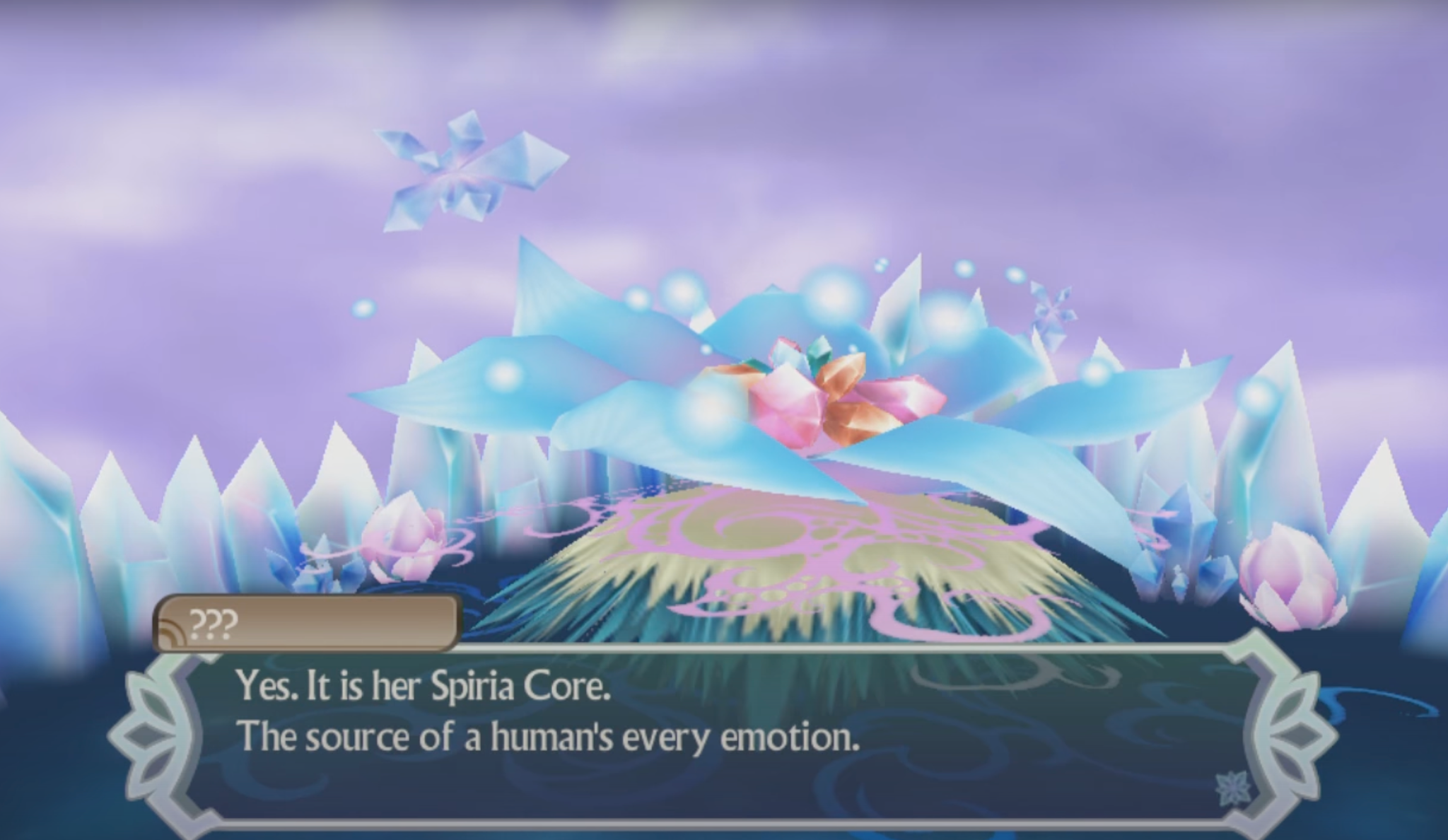
Lithia, as yet unidentified, describes the nature of Spiria Cores to Kor when he discovers Kohaku’s within her Spiria Nexus at the beginning of the game.
The shards, then, show us throughout the whole first act of Tales of Hearts R that Spiria Cores really are functionally works of art by virtue of their capacity to facilitate relationships between their originator, their bearer, and their communities. But this rich capacity for mutual support is perverted by a different kind of selfishness when someone like Striegov eschews the Cores’ function in favor of their inert, physical attributes, such as their color or sheen. Worse, Striegov uses these Cores merely as testaments to the quality of his own character, rather than as a way of honoring or cultivating any sort of network of human relationships. In his eyes, their qualities—like their grotesque provenances, which he insists on detailing—are only proof of his expertise in aesthetic judgment. The detestable essence of Striegov, it turns out, is an alarmingly easy trap for us to fall into as players of a video game: locating an artwork’s value in our capacity to judge it as pleasing to us, rather than in the artwork’s capacity to forge and enrich human connections.
Smithson teaches us that artwork is distorted when its creator derives its value from her ego; Striegov shows us it’s distorted when its consumer derives its value from his. But that’s not to say we ought to erase ourselves in order to understand an artwork. Far from it: the artwork of Kohaku’s shards is constitutive of her, and Benston’s painting is an expression of his identity. The key to authentically engaging with an artwork, as the journey into Benston’s painting and Kohaku’s Spiria show us, is to meet the human represented within the artwork on his or her own terms and form a genuine relationship with it on that basis We connect with ourselves and each other by understanding the human life synthetically emulated within our works.
§1.2: Autonomy in Artifice: Mechaknights
We’ve seen that the world of Tales of Hearts R is one in which artworks can literally represent the souls of their creators and express the sentiments of those souls to others. But this doesn’t yet show us that there’s any sort of special humanity intrinsic to the artwork itself. Artifacts like Benston’s painting and Kohaku’s Spiria shards are like sentences uttered by Benston and Kohaku in a conversation: insofar as we value Benston and Kohaku, we ought to value these forms of expression, but we don’t yet have an obvious basis for further concluding that these sentences and artifacts were worth valuing strictly for their own sake. To defend such value would be like arguing that there’s some sense in which we ought to respect and honor Kohaku’s utterance “I love miso!” that’s independent of Kohaku’s sentiments about miso.
But Tales of Hearts R goes further to argue that works that synthetically emulate a human life can be “animated” into authentic humans. The journey of the party’s resident “tin man,” Kunzite, is an argument to this conclusion: confronted with the cautionary tales of his less fortunate mechanoid brothers, he forges and nurtures his own humanity in a way that honors his creator without reducing his identity to hers.
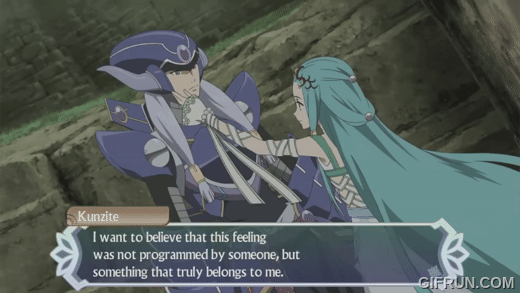
Cornered after the first assault by the mechanoid Chlorseraph, Kunzite seeks solace from his master, Lithia, that his feelings belong to him.
Like the Jeweled Princess, Kunzite is a man-made artifact with a Spiria. But whereas the Jeweled Princess posed the question of whether it could facilitate connections between its creator and appreciators without reducing to their egos, Kunzite poses the question of whether he can have an inner life that “truly belongs to him” rather than deriving from the function his Mineran manufacturers gave him: the protection of his master, Lithia Spodumene. True to his namesake—a gemstone form of the mineral spodumene, an ore of lithium—he must find the right way to house Lithia within himself without reducing himself to her.
Kunzite introduces himself to the party as “an autonomous model of mechanoid with a synthetic Spiria, commonly designated as a mechaknight.” He is awakened after 170 years of stasis by Kohaku reciting an ancient activation code ostensibly learned from Lithia under the guise of a poem:
Shape of man cast from iron’s true flame. With a solid bronze soul, and pure mercury veins.
Swear on Minera’s white moonlight, that you shall be our shield, and our sword, and our might.
Platinum heart etched with a Mineran name, run so as to give life to your metal frame!
The mechanics of this activation code’s content are never elaborated, but the game’s broader conception of mechaknights as synthetic humans who serve to protect a designated master suggests that the Mineran name etched on a mechaknight’s heart is that of its master, the source of the artificial warrior’s vow and reason for existence. Kunzite tells Hisui in conversation that “[his] synthetic Spiria has been programmed to react only to the words of [his] master,” and, as the mechaknight Chlorseraph later ruefully reminds Kunzite, “[m]echaknights are programmed to prioritize their masters’ protection above all else.” So, in both the expression of his sentiments and in the determination of his actions more broadly, Kunzite’s synthetic Spiria—the man-made heart that sculpts his point of view, engineered to emulate a human Spiria—is programmed to treat Lithia’s well-being as the only source of value.
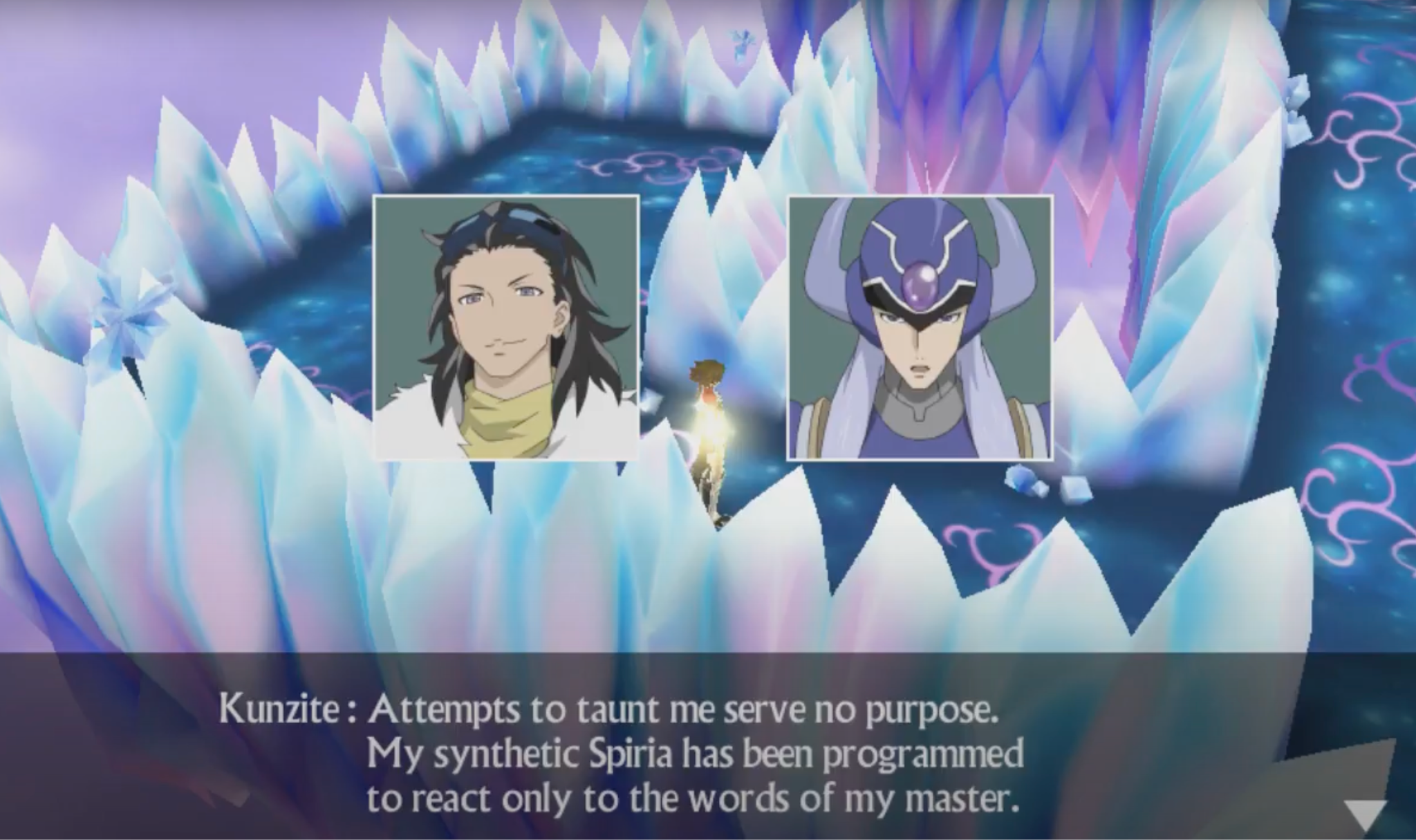
Speaking with Hisui when they enter Chalcdeony’s Spiria Nexus, Kunzite flatly states that his inner life depends on Lithia’s commands.
We feel the force of this in Kunzite’s procedural treatment of our hero’s party in their journey to reconstitute Kohaku’s Spiria Core, before Lithia returns:
- When Kunzite decides to formally join the group, his decision is phrased as a logical conditional that lays bare the primacy of Lithia’s well-being in his decision-making: “If I wish to revive my master,” he tells Kohaku, after learning that Kohaku’s Core shattered as a method of self-defense for Lithia, “I must make assisting you my top mission parameter.”
- After Kunzite saves the young Annaberg from a monster in Douze Mois Forest and she immediately develops affection for him, he gains the “Synthetic Spiria” title, featuring a first-person description that illustrates his indifference to all aspects of life beyond his directive to protect Lithia: “My Spiria is synthetic. Devoting resources to unnecessary tasks is irrational.”
- The game mechanics reinforce Kunzite’s fidelity to Lithia above all else—even the party and their shared mission to rebuild Kohaku’s Core—when he instantly transitions from a party member to a boss following a misunderstood exchange between Kor and Kohaku on the way out of Straga, mistakenly believing that Kor was responsible for “[his] master’s vessel [having] an incomplete Spiria Core.” Only in the wake of the battle and a proper explanation from Kohaku does his logical reasoning allow him to rejoin the party for Lithia’s sake.
Once Lithia’s Spiria reunites with her body and joins the party to rectify the mistakes of her past, her relationship with Kunzite opens the door to a beautiful evolution for Kunzite: because of their bond, Kunzite is able to become a person on his own terms.
In Lithia’s presence, Kunzite is awash with emotions, yet he insists that these merely derive from his programming, designed to make him a better guardian of his master. He supposes that his behavior of “a clear drop in performance” when he faces Chlorseraph, who is hell-bent on killing Lithia, “closely resembles the definition of fear”; he insists that he’d only told Lithia that her singing “warmed [his] heart” in their days on Minera “because [he] heard Fluora,” Lithia’s sister, “say [such things] to [her] previously.” But when he’s called to engage with those emotions as such—as when Hisui tells him to “[o]vercome” his fear—he retorts that “such behavior is beyond the parameters of [his] programming.” Though he was designed to emulate the inner lives of humans, he laments that he “cannot understand human emotion. I am merely a low-end machine into which a synthetic Spiria has been installed,” he tells Hisui and Lithia: cursed with the experience of emotions and will that originate not from within himself but rather from Lithia and his servitude to her. Despite having a human-like perspective, Kunzite seems no better off than Benston’s last painting: expressing emotions sourced from someone else, a “real” human, the final author of the creation’s essence and actions.
But the bonds between Spirias make something miraculous possible: Lithia can give Kunzite ownership over his feelings and thereby empower him to act independently of his original purpose. When Kunzite dismisses his commentary on Lithia’s singing as mimicry of Fluora, Lithia counters, “No, Kunzite—you chose those words to make me happy. There is no coincidence in that.” When she assures him that his fear is something he will overcome, she gives him a reason to believe in himself, couched in terms that his mechanoid logic can accept: “I am your master, am I not? If I say so, then you can trust it.”
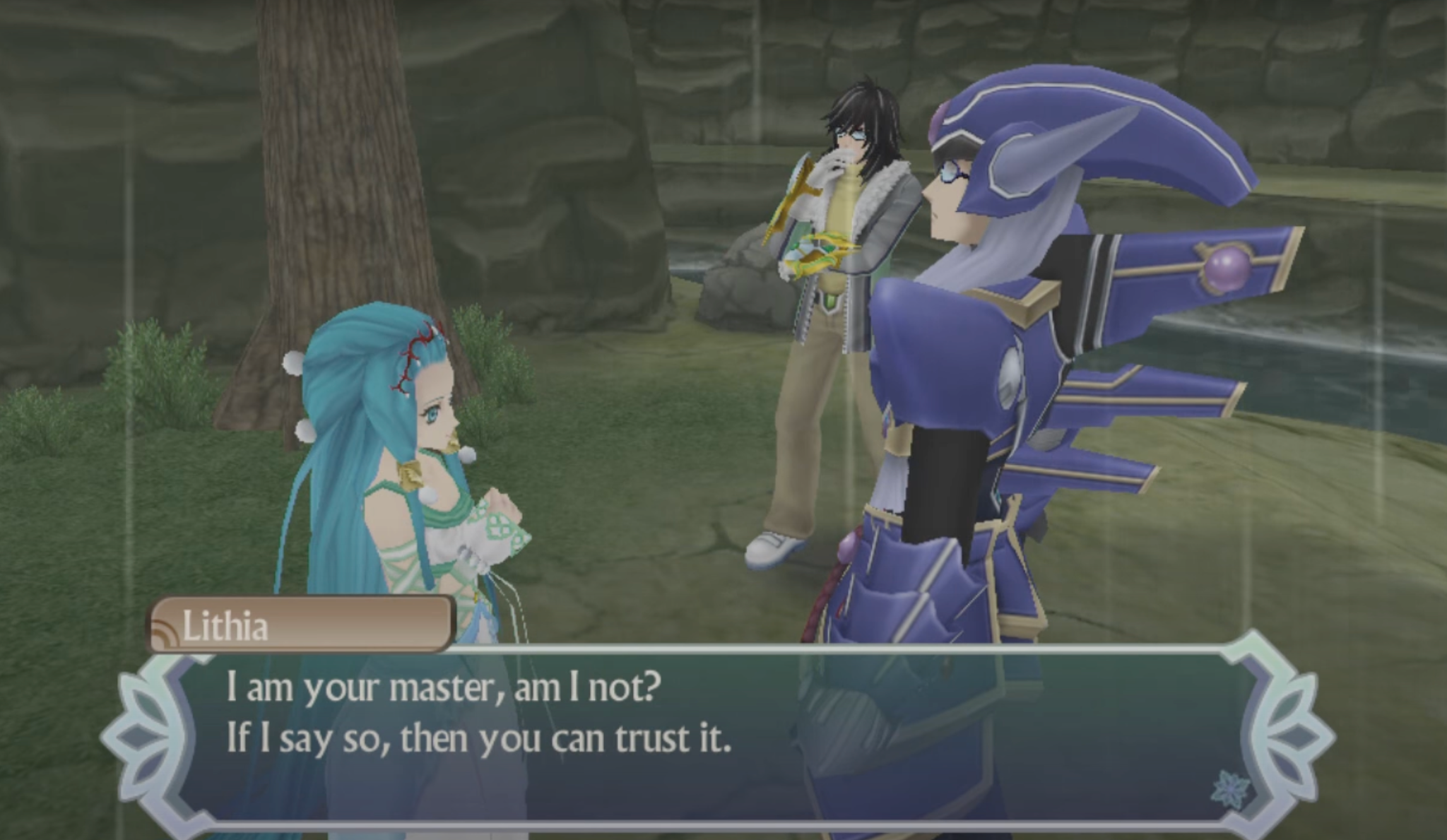
Lithia gives Kunzite ownership over his feelings following their narrow escape from Chlorseraph.
By using her role as his master to convince him that he can actively participate in his relationship with her, Lithia gives Kunzite a paradigm for extending his inner life to people beyond his master:
- He is able to participate as one node in the village-wide Somatic bond, a network of connections that allows the free transmission of emotions between participating individuals, when the people of Dronning come together to hope for the future in the face of Gardenia’s emergence.
- In that same village, he discovers an old cook who’s fallen into possession of the same hot pot with which Kunzite cooked for Lithia on Minera thousands of years earlier, and he collaborates with him to cook exotic new dishes for the party, helping the cook to fulfill his personal dream of “extreme hot-potting.”
- In Blanche Villa, he “assimilate[s] the baking method into [his] long-term memory” for peach pie, Heliodor’s crowd-pleasing dish that unified the party, along with Pyrox and Peridot, during their first visit to Beryl’s hometown.
- Ahead of their adventure’s conclusion, he validates Annaberg’s affection for him and helps to emotionally heal Chalcedony’s father so that he might agree to officiate the long-overdue wedding of Annaberg’s parents, creating a new Somatic bond between them in the process.
Each of these new relationships cultivates Kunzite into something more than Lithia’s servant because of his unique attachment to her. The Somatic bond in Dronning is something Kunzite must acknowledge, by Lithia and Hisui’s testimony, as validation of Lithia and Fluora’s wish to unite the Spirias of everyone in the world; even as Kunzite recognizes that his participation in the bond “defies all logic,” his master’s involvement in the achievement gives him the foundation to believe Gall when Gall tells Kunzite that “[j]ust because [he’s] made of parts doesn’t mean [his] Spiria isn’t real.” His history as Lithia’s sole cook equips him with a skill through which he can create contexts—meals—that relate participants’ Spirias to each other, not unlike a Somatic bond, leading him to realizations such as the wisdom of the hot pot—that “[i]n one diminutive receptacle, limitless possibilities arise both among the ingredients and those who cook them”—and the wisdom of the pie—that the “result” of a dish can differ based on preparation and intention, even if two cooks use “the exact same ingredients in the exact same quantities.” And perhaps most salient of all, his acceptance of Annaberg’s sentiments shows that he has come to accept the truth of Lithia’s belief that his feelings are things that truly belong to him: long after he initially rejected Lithia’s suggestion that “[his] kind Spiria can feel the warmth of a song,” he appraises the scarf which Annaberg knitted for him and says kindly that “[i]t was manufactured by hand and fueled by a heart filled with compassion. This scarf will warm my Spiria always.” And, indeed, he receives in the scarf a piece of equipment that mechanically does gradually refill the in-battle Spiria Gauge: a resource governing the party’s ability to activate Spiria Drive, a mode in which they tap deeper into their Spirias to unleash uninterrupted abilities and stronger techniques pointing to the essence of their character, like Mystic Artes.
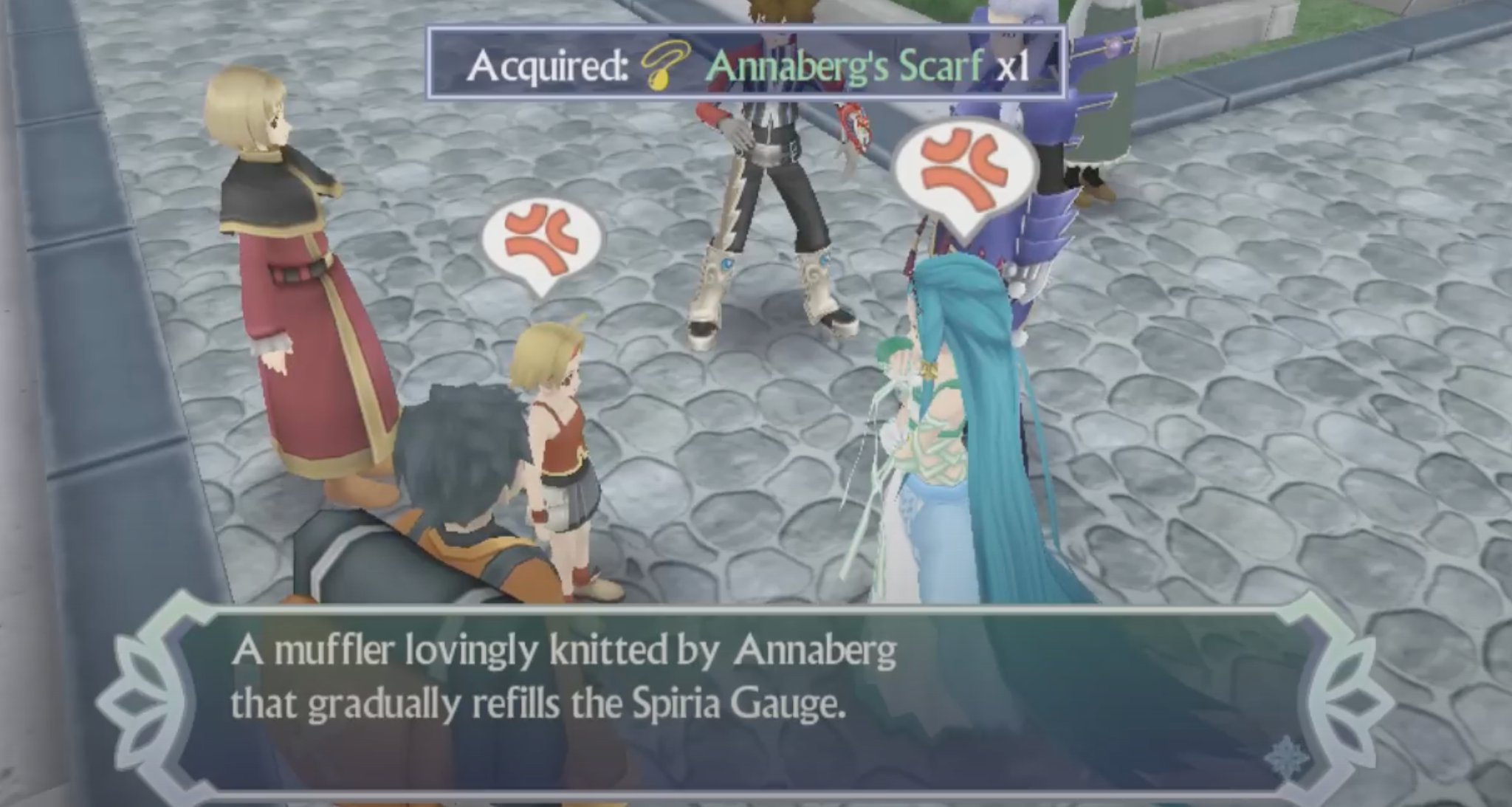
Annaberg presents herself as Lithia’s “rival” for Kunzite’s affections with a hand-knitted scarf that refills the Spiria Gauge in battle.
Twice over, Kunzite and Lithia show us how the interaction between an artificial work and its creator can transform the nature of that work. Unlike Benston and his paintings, Lithia can express to Kunzite what she would like him to make of their relationship, empowering him to reconfigure his sense of self accordingly. And in a game so self-consciously concerned with the nature of artwork, it’s all the more fitting that she expresses this through another work of art. Whereas Kunzite was awoken by a poem that called him into servitude, Lithia opens his Spiria to others on Mount Bremen with a song of Fluora’s that invokes egalitarian connection:
Don’t fear the rain and close your eyes.
The dark won’t last forever.
Our Spirias will let us dream together.
We’ll fly over to the pale blue moon.
On shared wings we’ll soar to the light.
Now with this kiss, sleep tight.
Let’s go run under cover of night.
Though we may fight from time to time, you’ll wake with your hand in mine.
These words—invoked from Lithia’s bond with her sister, and passed along to her bond with Kunzite—invoke the ability of bonded Spirias to dream, bringing about possibilities and sentiments unbounded by the logic of reality or the conditions under which one was brought into existence. This guidance of his master in extending his inner sentiments from her to others in his life grounds Kunzite’s characteristics as a party member. Each party member’s combat abilities are governed by five cardinal attributes of their Spiria, four of which are common to everyone—Fight, Belief, Mettle, and Endurance—and one of which is unique to each character. Kunzite’s fifth attribute is Loyalty: an attribute that easily could have rendered him a senseless tool, instead—thanks to Lithia—elevated to a source of unparalleled strength to share with his friends.
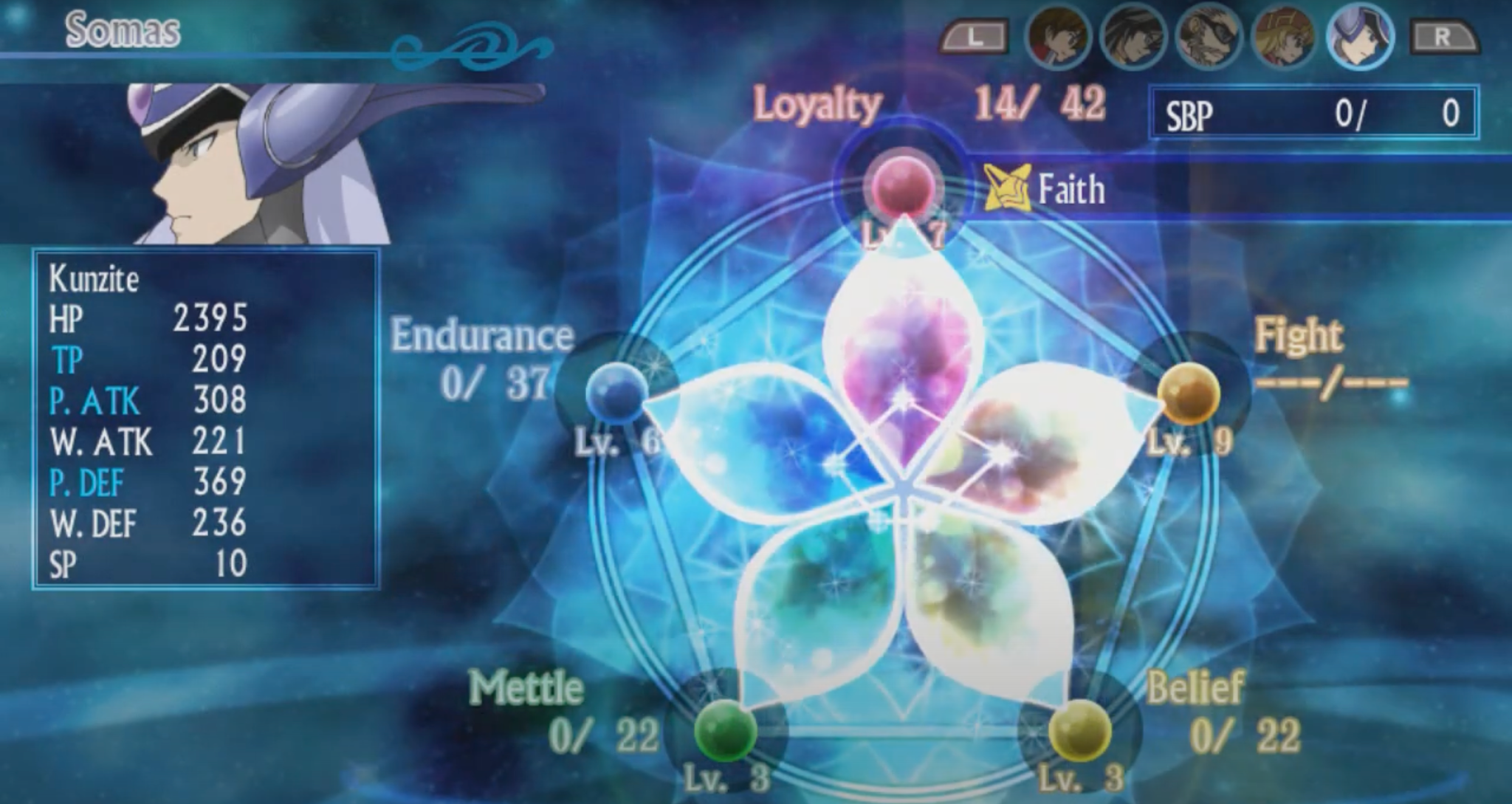
The cardinal attributes of Kunzite’s Spiria, distinguished by the fifth attribute of Loyalty.
It is counterintuitive to discover an independent existence through a bond of servitude, but Tales of Hearts R tells us that this is exactly what it means to honor our relationships with others and find ourselves within those dependencies. And just as it did with Smithson and Striegov, it clarifies this lesson’s contours through portraits of characters that fail to learn it. In this case, we come to appreciate Kunzite through the cautionary tales of other mechaknights: Chlorseraph, who seeks total severance from masters; Clinoseraph, who strives to protect masters above all other relationships; Corundum, who takes her relationships with facts as her master; and Incarose, who interprets world purely through her love for her master. The lesson here, ultimately, is that the autonomy of a created entity is contingent on the creator genuinely investing in the creation and giving the creation a praxis for extending her values to people beyond her immediate network. When a work is nurtured by those who engage with it, as Kunzite is by Lithia and his friends, it can flourish into something with intrinsic value; yet when a work is cut off from the context of its creators and audience, or contorted by someone to serve an agenda that has nothing to do with the work per se, it loses not only its autonomy, but also the opportunity to become an irreplaceable, normatively significant node in a rich network of interpersonal relationships.
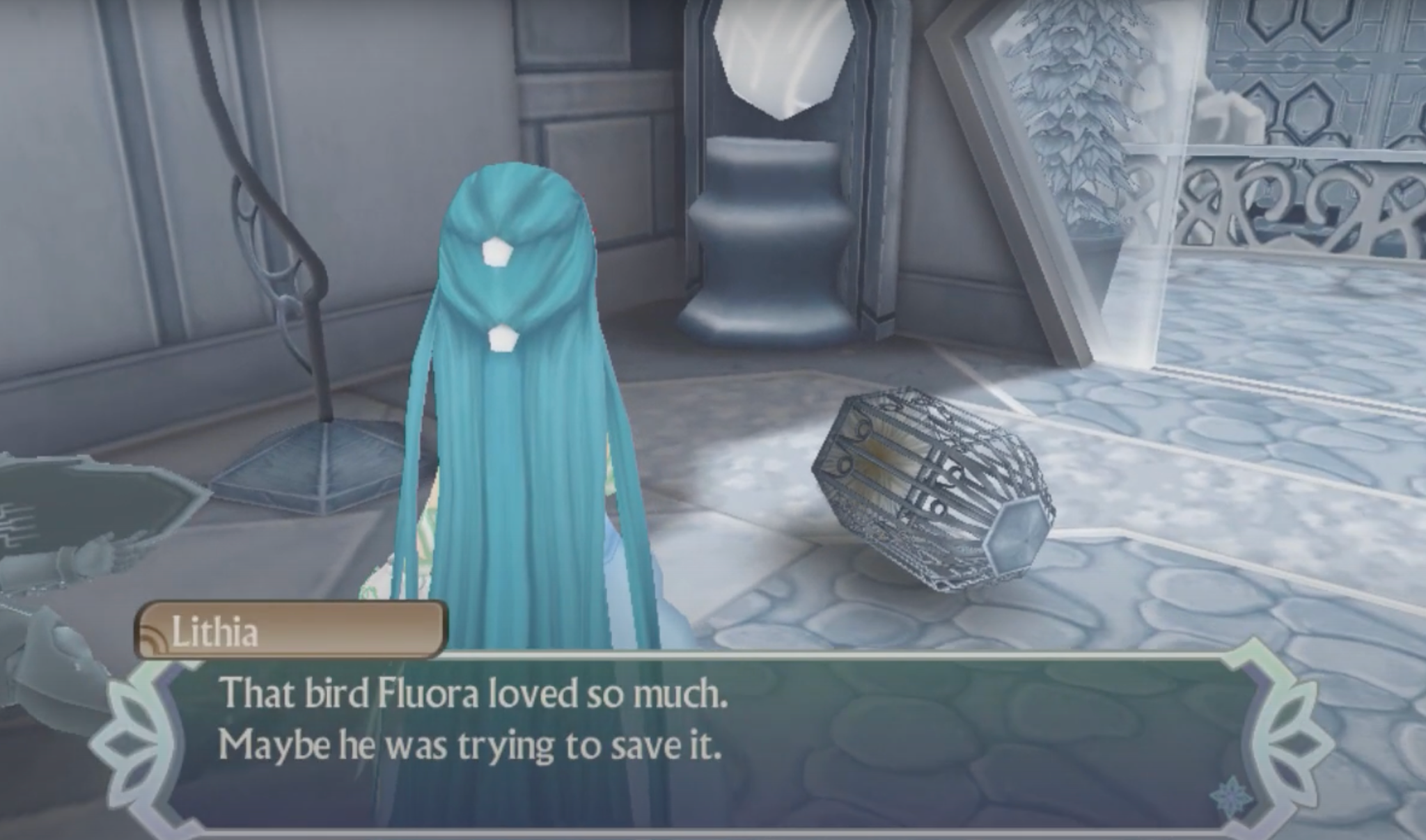
Lithia tries to make sense of Clinoseraph’s final effort to save Fluora’s bird prior to his calcification millennia earlier.
When our heroes eventually reach the calcified world of Minera, they discover the tragic history of mechanoids—not just through memories of their enemies’ upbringing, but also through a metaphor that illuminates the motives behind their creation. Our first introduction to Clinoseraph casts him as broken and calcified on the floor of Litha and Fluora’s room in te city of Cind’rella, frozen in a vain attempt to save a beloved seraph bird, a rare songbird Fluora had nurtured and kept in a cage—the cage now lying on the floor, a record of Gardenia’s inadvertent decimation of the planet millennia earlier. In the Seraph brothers’ memories of Minera, the party can find the very nest from which that fledgling bird fell, nestled in the tree where Fluora used to sing and tend to the city’s children. Looking at the nest, Kunzite and Lithia relate to Kor the story of how Creed noticed the fallen chick and flew into a rage at the thought that its mother “was unable to save its baby and just left it alone to cry all day long,” after which Fluora nursed the bird back to health and kept it as a pet.
Though the bird most obviously relates to Chlorseraph and Clinoseraph—the two defective mechanoids whom Fluora also took under her wing and raised as her own, even naming them after that same rare species of songbird—its story symbolizes the pathos and plight of mechanoids more broadly. Kunzite paints a picture of mechanoids as lacking in the eyes of their very creators: those that were considered “unstable” in fulfilling their functions—like Chlorseraph and Clinoseraph, whose namesake, the mineral clinochlore, is often considered “an uninteresting matrix for more important minerals”—were ordered to be discarded in favor of the more reliable xeroms, and “the final form of all mechanoids” is a hauntingly nondescript scrap heap of parts in a corner of Cind’rella, the pile where they are discarded “[when their] masters decide [they] are no longer useful.” From their moment of creation, mechanoids and mechaknights are subject to the capricious whims of their creators to justify their existence, like a fledgling whose mother brings it into the world yet cannot bring it back to the nest after its inevitable fall. Those fortunate enough to find a master who values them can justify their existence through their usefulness, and yet they are only justified so long as they’re conceived in relation to that utility—like a bird whose beautiful song emanates only from a cage, or a painting that becomes a senseless spattering of colors in our eyes as soon as we conceptually divorce it from the idea that it was authored by someone or artistically appreciated by someone.

In a memory of the past, Chlorseraph and Clinoseraph attempt to ease their master’s burden by stopping Creed and Lithia’s activation of Gardenia.
The “brother” mechaknights Chlorseraph and Clinoseraph suffer in the same cage of servitude to Fluora, though this bondage manifests in antithetical goals.
On the one hand, Chlorseraph feels the absence of his master—imprisoned far away within Gardenia, no longer able to influence him—and desperately clings to the notion of freedom as uniquely possible in such absence, obsessively seeking the death of Lithia so that “Kunzite’s Spiria can finally be free” and he can focus on “cultivating [their] beautiful friendship” rather than serving his master. Chlorseraph is like a flower that can only flourish in the shade, where Fluora is the sun: his urgent dependence on her absence betrays how central she remains to his self-concept, a relationship he implicitly admits when, as he lies dying from a surprise attack by his own brother, he calls out to Fluora, seeking the comfort of her embrace after all: “I don’t want to die. Help me, M-Master Fluora. I’m… scared.”
On the other hand, Clinoseraph declares as his raison d’être that “Master Fluora’s smile will be restored to this world. Her Spiria will be FREE!” Where Chlorseraph sought to free himself and other mechanoids, Clinoseraph’s entire Spiria Nexus, as the party witnesses, is “a nightmare without end” constituted by memories of Fluora’s suffering at the unwitting hands of those closest to her: her sister, Lithia, and the man she loved, Creed, neither of whom had faith in her vision of a world united under one cosmic Spiria. His Spiria, together with the vindictive way in which he imprisons Lithia within it, underscores that he sees everyone in the world as relevant only in virtue of their relationships with Fluora, only valuable in their contributions to his calculus of making Fluora happy. The sheer zealotry of his utilitarianism—killing his own brother because “[his] usefulness is at an end” once he no longer acts to protect Fluora—demonstrates, by contrast, that Kunzite wasn’t a mere tool even at the beginning of his journey with the party, far more fully actualized even at the outset thanks to Lithia’s guidance.
In his final moments, Clinoseraph curses his “inadequacy” that he “could not even save that little bird [Fluora] loved so.” The tragedy of the Seraph brothers is that the “little birds” they fail to save are themselves: alienated from their master’s support and with no community to guide them back to it, they are desperately trying to make sense of their relationship with her, to no avail—and with no means of accessing any authentic, autonomous self-concept through which to connect with others.

With his last breath, Clinoseraph curses his failure to save Fluora’s seraph bird.
Those mechaknights who ground their identities in their own feelings are no better off, so long as they’re cut off from the emotional support of their masters. At first glance, Corundum and Incarose look as if they ought to be better individuated than the Seraph brothers: Corundum is “motivated entirely by a desire to satisfy [her] curiosity,” and Incarose by love for her master, Creed Graphite. This kind of sentiment, directed outward toward others without essential reference to the master-servant relationship, looks like the right foundation to give an entity an inner life all its own. But while they are less existentially troubled than Kunzite, Corundum and Incarose are, by the same token, far more spiritually deficient: they lack a vantage point from which to interrogate their feelings and extend them to other people in their lives, leaving them in a solipsistic vacuum.
Incarose’s eyes are a heartbreakingly precise symbol: her very name, ‘Incarose’, comes from Creed, a tribute to the mineral he was reminded of when he gazes upon her “quite striking” eyes for the first time after creating her. And, just as her namesake mineral is constituted by carbon, the element that also constitutes graphite, those eyes unavoidably include their master in the mechaknight’s field of vision.

In the memory held by Incarose’s core, the party witnesses Creed, Incarose’s creator, seeing her for the first time and bestowing her name upon her.
Creed’s perspective on Incarose’s eyes frames Incarose’s perspective on the world: after noticing her eyes and naming her, he instructs her to “gaze at the world for the first time”:
Do you see how beautiful Minera is? And yet, it is sick with diseased Spirias and cannot survive much longer. Those eyes of yours are, in fact, Xerom Stones, and you must use them to support my xerom-evolution experiments! Together, we will make Minera a utopia!
The value Incarose is invited to see in the world, its beauty, is mediated through the very eyes which Creed fashioned to serve his goal of bringing peace to Minera through xeroms—the eyes in which Creed saw Incarose’s value. This is evident in the party’s most immediate experience of Incarose’s interiority, the memories bound within her Core: whereas the Seraph brothers’ Cores stored memories of their entire city at a key moment in Fluora’s history, Incarose’s contains only the initial interaction between herself and Creed when Creed first named her and gave her a purpose.
Creed’s judgment so thoroughly colors Incarose’s point of view that the question of what it means for her to serve her master, or to whom else she could relate, could never arise within her. On the contrary, the only “community” she forms redoubles her unitary love of Creed: whereas Kor amasses a diverse group of friends and bonds, Incarose is the antithesis, a 7-person “party” of identical mechanoid bodies; where Kor’s friends become more powerful by spending time together, learning about each other’s inner lives, and making new connections, Incarose becomes the monstrous “Incarose Alt,” disfiguring herself by objectifying the Seraph brothers, killing them and bolting their parts onto her body—staying bounded within her eyes’ field of vision, yet losing sight in both eyes by the time the party finally puts her to rest, overcome by the brothers resisting her will and vision even from within her own monstrous body.
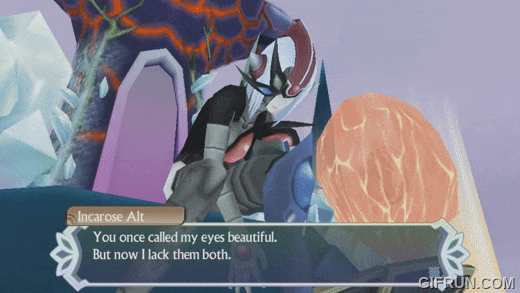
As she dies, Incarose apologizes to Creed for losing her eyes.
Meanwhile, Corundum’s inner life is oriented neither toward a master nor toward any other human, but rather toward data: her overriding curiosity compels her to discover that which she doesn’t yet know. Yet despite not being tethered to a malicious director in the sense Incarose is, Corundum remains open to the manipulations of Creed because of the same shortcoming for which Kor criticizes Incarose Alt: “It’s because you’re alone. Your feelings—your Spiria—aren’t connected to anyone else.” Oriented toward information that isn’t itself grounded in specific human relationships or normative content, Corundum can easily be swayed and bound by humans who use her specialized attention for their own ends, channeling their goals through the focus of her attention like lasers channel light through her namesake mineral. In the Seraph brothers’ memories of millennia in the past, a Corundum bored by the operations of Mysticete upon its launch exclaims that data from Gardenia would be “more interesting,” giddily declaring, “Oh yeah, that’s GREAT! I’m gonna ask Creed to let me observe Gardenia! Wooooooo!” That curiosity lures her into becoming a tool for Creed: a disposable command core to operate Mysticete until it can take Creed to Gardenia, regardless of the unbearable pain this causes her Spiria.
Yet Corundum’s vulnerability also points the way to her redemption: in the absence of a master to color her value system and inner life, a benevolent person can take hold of her interests and show her a way to bond with the Spirias of others, just as Lithia’s role of master made possible for Kunzite. In fact, it’s Lithia who guides Corundum to this new path, too. Lithia uses a Will arte to free Corundum from Creed’s influence, stoking her curiosity in a new direction: she wants to solve the puzzle of why Lithia bothered to help her. This makes it possible for Lithia to provide her with new “data” by way of an answer: “all beings must live according to their own will,” she tells Corundum, “and not the will of others. They must answer only to the feelings that exist deep in their Spirias.” Not only does this give Corundum the standing to realize and admit that Creed “doesn’t care about [her] at all,” leading her to grant the party passage to Gardenia, but it also stokes her curiosity about the “weird sensation” she feels in response to Lithia’s help, prompting the party to Spiria Link with her. That Link grants Corundum evidence that she has a Spiria Nexus and is therefore capable of an authentic inner life, as well as evidence that she likes Lithia because of the kindness Lithia showed her—motivating Corundum “to study this new emotion as intimately as possible,” directing her innate focus of attention, her curiosity, inward and thereby allowing her to construct the diverse emotional network that the Seraph brothers and Incarose lack.
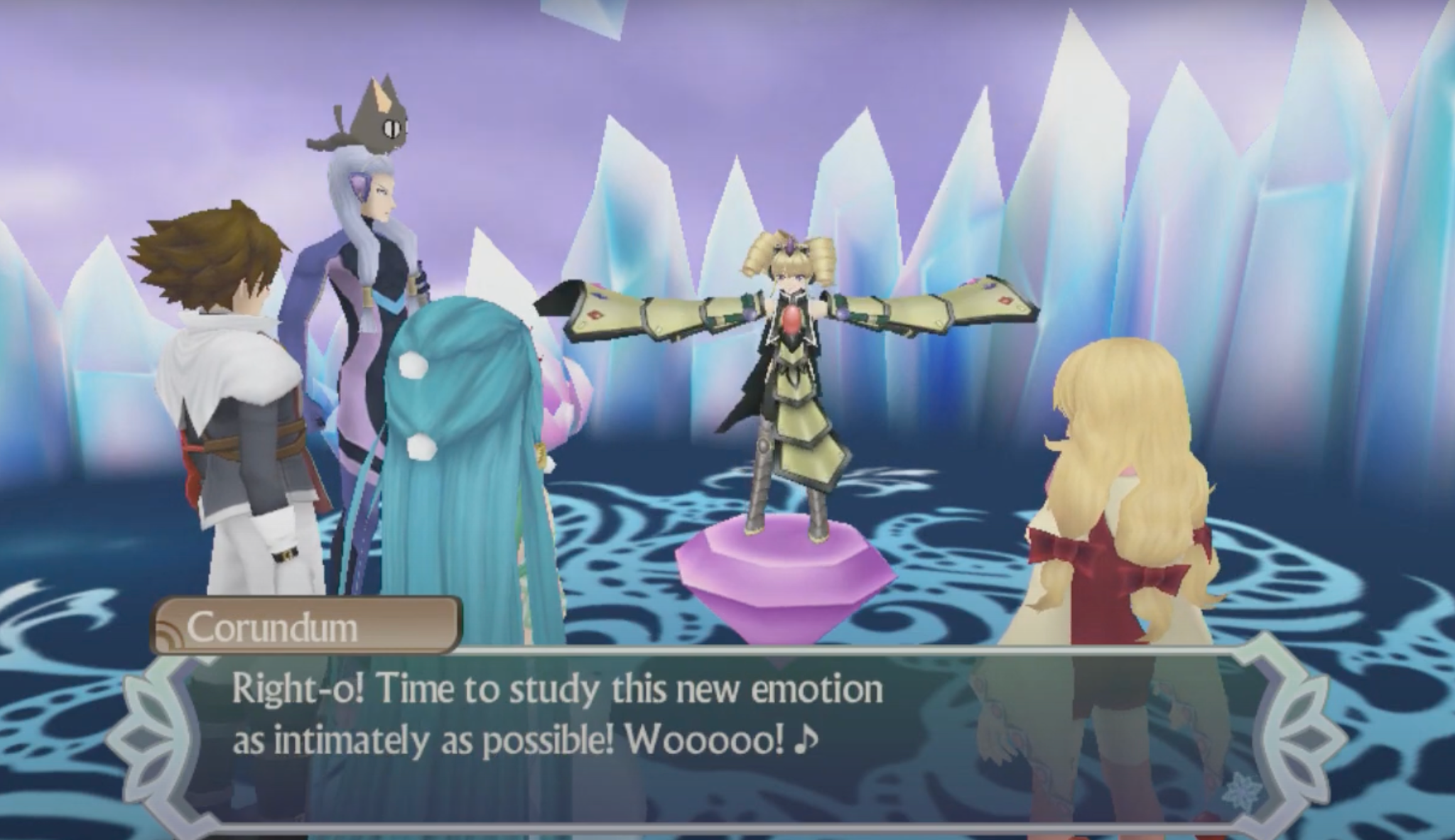
Within her Spiria Nexus, Corundum resolves to study the emotion that gave rise to her newfound, positive attachment to Lithia.
When Kunzite comes upon the mechanoid scrap heap in Cind’rella, he quietly says to the dismembered parts, “My brethren. Synthetic Spirias are not immune to error. It is my wish that one day humans and mechanoids might exist on a common emotional plane. If my present companions are a suitable test group, I estimate such a time will arise in the future.” Kunzite’s wish and judgment of his network of companions are themselves evidence that his estimation is well-founded. An artificial human whose self-concept fixates on its relation to the real human to whom it is bound will remain artificial, as will one whose perception of value in the world is solipsistic, providing them with no method for forging bonds with a range of individuals. But if the real human to whom the man-made object is bound affirms that creation’s ownership of its feelings and supports it in extending those feelings to objects beyond herself, as Lithia does with Kunzite, then the artificial creation can become authentically human. Gall crystallizes this conclusion at the end of their journey when he affirms to Kunzite, “You’ve got a real Spiria inside you, and that makes you legit.”
§1.3: Value in Artifice: Gardenia, Xeromization, Command Cores, and Bells
Tales of Hearts R tells us, then, that artificial works can not only represent the soul of their creator, but can cultivate and express a humanity of their own. But we might still doubt that these inspirited works really make some new contribution to the world beyond the values and intentions of the human from whom they originally derived: after all, even once he accepts his humanity, Kunzite’s cardinal attribute is Loyalty, and his novel expressions of humanity all bear hallmarks of his history and affection for Lithia.
It’s crucial to Tales of Hearts R‘s story and our engagement with it that the intentions and values of a created work can drift from those of its creator, often radically and unexpectedly. This calls those who engage with these works to uncover those distinctions, understand them, and reconcile them—lest the friction between creator and creation swallow up all life with which it comes in contact.
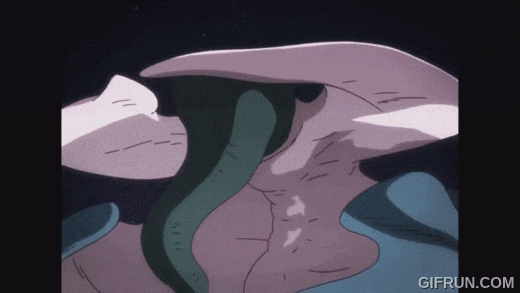
The “savior system,” Gardenia, emerges from the black moon and begins absorbing the Spirias of Organicans.
The key to completing the development of Gardenia—the “savior system” and “queen of xeroms,” with which the Mineran magical engineers Creed Graphite and Lithia Spodumene hope to eliminate the impulse to war from Mineran Spirias— was to make “[its] synthetic Spiria […] a copy of [Creed’s] own.” The final dungeon and principal threat of Tales of Hearts R is a representation of a human, similar in spiritual structure to Benston’s paintings despite being worlds apart in aesthetic value. Yet regardless of its status as a copy of Creed’s Spiria, the nature of Gardenia is foreign to Creed, its impulses beyond his control. Despite Creed’s insistence to Lithia that “I know myself better than anyone [and therefore] Gardenia WILL be controlled,” despite Creed’s having taken two thousand years to perfect the arte of merging with Gardenia’s Core so that “Gardenia might finally bend to my will,” Gardenia indiscriminately absorbs Spiria—including the Spiria of Creed’s beloved Fluora—with no regard to Creed’s conscious commands for it to act otherwise.
Lithia declares that “[t]he root of Gardenia’s uncontrollability lies in [Creed’s] primal nature,” which points to the mechanism through which, in Tales of Hearts R, artificial entities can deviate in their values and intentions from those of their creator or master: our inner nature, the game tells us, is pluralistic and opaque to us. It’s pluralistic in the sense that one person can value different ends—Creed seeks the restoration of Minera, the rescue of Fluora, dominion over the other world of Organica, a sense of belonging from the love of another—and opaque in the sense that a person isn’t necessarily consciously aware of all those values, nor of how they’re guiding her actions—the fact that Creed’s primal nature consists in “crav[ing] the love of someone[,] [o]f anyone[, without knowing] what love is” is a fact which Creed can be ignorant of, can deny, can discover, and can ultimately accept. Although Creed’s primal nature is a tragic deficiency, we’ve already seen that more positive natures can be inaccessible to creators despite being embedded in their works, like Benston’s last painting expressing his love to Beryl more directly than he can.
Creed is just as surprised as the party within the Spiria Nexus of a fused Creed and Gardenia to discover not only the Spirias of all the consumed Mineran life, but also a gaping black hole at the heart of the Nexus. That void is a topological reflection of Gardenia’s, and thus Creed’s, boundless impulse to consume in pursuit of “owning” a sense of love and belonging without fostering a genuine bond between the subject and object of that love. This, I think, is the reason that Creed’s total number of hit points is unknowable in both of his combat forms, remaining indeterminate (“??????/??????”) even if the party uses a Magic Lens to analyze his attributes and stats: if the analysis of an enemy consists in getting access to some understanding that an enemy has of its own abilities, then it makes a tragic and perfect sense that the party cannot understand a man who has fused with an artificial entity whose essence, though derived from him, is entirely foreign to his conscious conception of his identity. Only by defeating this mass of confusion can the party put Creed in a position to see the berserk vacuum of Gardenia for what it is, and what it is that he must accept and overcome: “the darkness of [his] Spiria.”
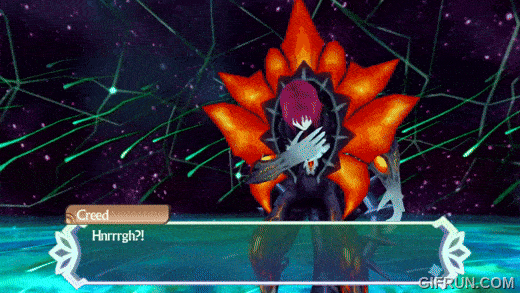
Creed suffers at the center of Gardenia’s Spiria Nexus, a vacuum of his own design which he can neither understand nor overcome.
The kind of distance between one’s actual identity and one’s self-concept, as we see with Creed and Gardenia, happens when we hypostatize our self-concept: that is, when we treat a mental model as though it were a real, fixed object rather than just a figure of speech or a heuristic to guide our patterns of thinking and acting. This is a deeply human impulse, and also a deeply artistic one. The artist who paints a self-portrait and takes it to illustrate some essential truth of her nature over and above the way she conducts herself is hypostatizing a concept of herself; someone who pursues a goal by vision-boarding, journaling, and dreaming so vividly that she experiences herself not simply as guiding her behavior but as actually trying to mold herself in such a way as to become some abstract, other version of herself which she has fantasized into reality is hypostatizing an alternative identity for herself. In either case, the person is ascribing reality to an artifact: a concept she has derived from certain aspects of herself, which bears the same sort of derivative relationship to her that an artificial being like Kunzite does to Lithia. Tales of Hearts R provides us with a robust illustration of both the positive and negative potential outcomes of hypostatization: by viewing xeroms as a means of individuals hypostatizing their self-concepts, we can understand the moral distinction between valuing a self-concept intrinsically and using it instrumentally for one’s external goals.
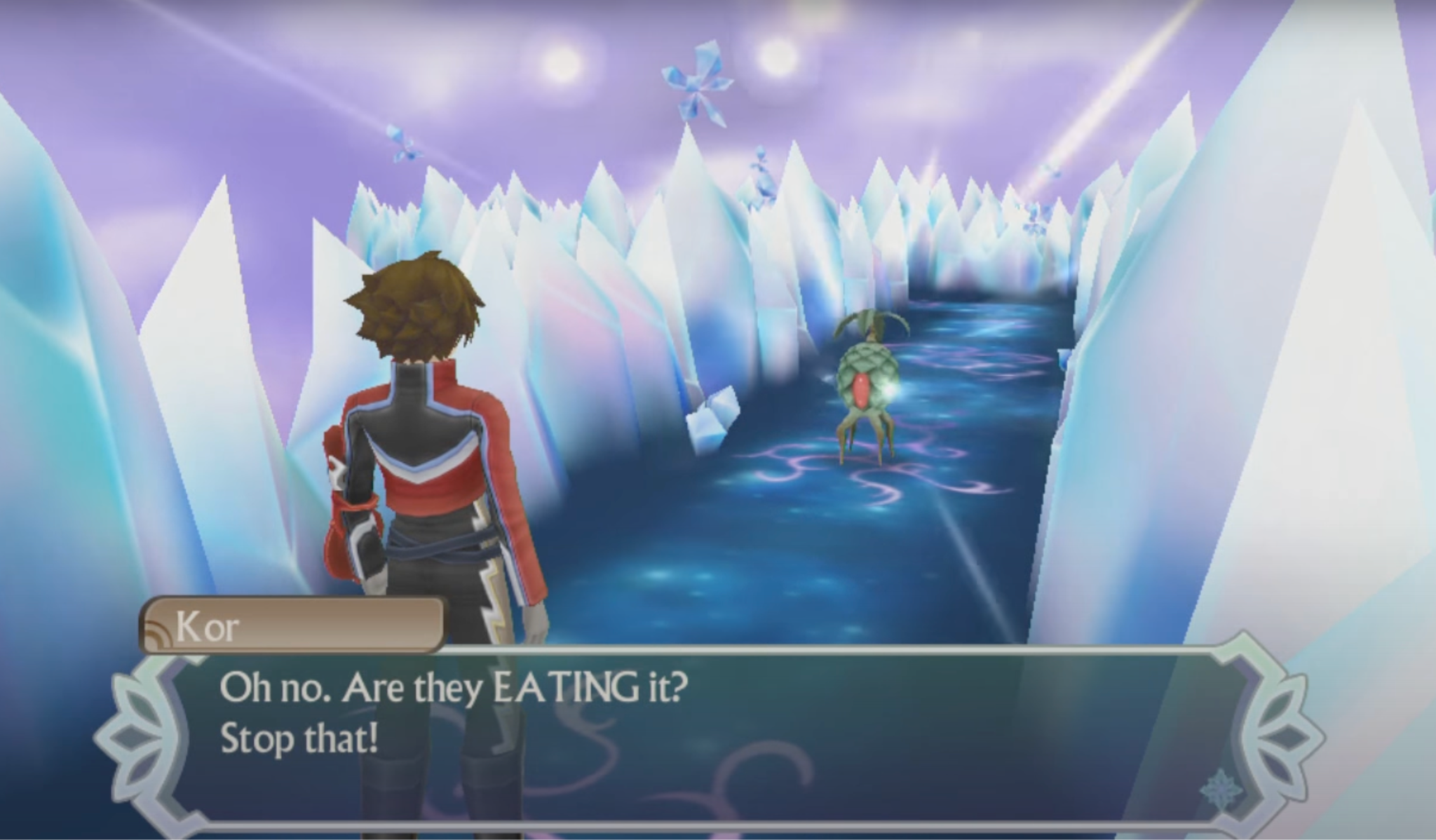
In Kor’s first encounter with a xerom within a Spiria Nexus, we look on as a Spore, seeded by Incarose, consumes Kohaku’s Spiria.
Our first introduction to the flower-inspired, Spiria-consuming creatures called xeroms is in the context of fairy tales, by which Organicans know them to be the “eaters of dreams” from the fairy tale of “Sleeping Beauty,” a history of Lithia enfolded within magical fiction. Our subsequent adventure across Organica and Minera reveals that this is a misunderstanding in the sense that xeroms are actually real organisms initially engineered by war-mongering Minerans to feed off of Organican Spiria and develop into living weapons. But there’s a further sense in which it’s a misunderstanding to call xeroms dream-eaters: ironically, they poison a person most thoroughly when they contribute to that person’s pursuit of a dream. In Creed’s pursuit of love, the xerom of Gardenia, fashioned after this desire, consumes all the Spirias of his fellow Minerans, treating them as fuel for that dream’s growth rather than entities with intrinsic value. And in the cases of villains like Kornerupine and Azide Silver who fall into possession of Kohaku’s Spiria shards, xeroms disfigure them in pursuit of more perfectly embodying the aspect of themselves that resonates with their respective shards: they xeromize themselves, willingly allowing xeroms to eat away at their Spiria, “pruning” their emotional range so the feeling grounded in the shard is all that remains. Kornerupine, bearing the Shard of Anger, crystallizes himself into an embodiment of resentment, fuming at his peers for not acknowledging the “brilliance” of his research; Silver, bearing the Shard of Love, seeks to conquer the world to make his comatose daughter, Lapis, a princess, consistent with her fantastical childhood wish from the days before Striegov stole her Spiria Core.
![Kornerupine objects to the party taking "[his] anger" away by reclaiming Kohaku's Shard of Anger.](http://withaterriblefate.com/wp-content/uploads/2024/06/word-image-9725-28.gif)
Kornerupine objects to the party taking “[his] anger” away by reclaiming Kohaku’s Shard of Anger.
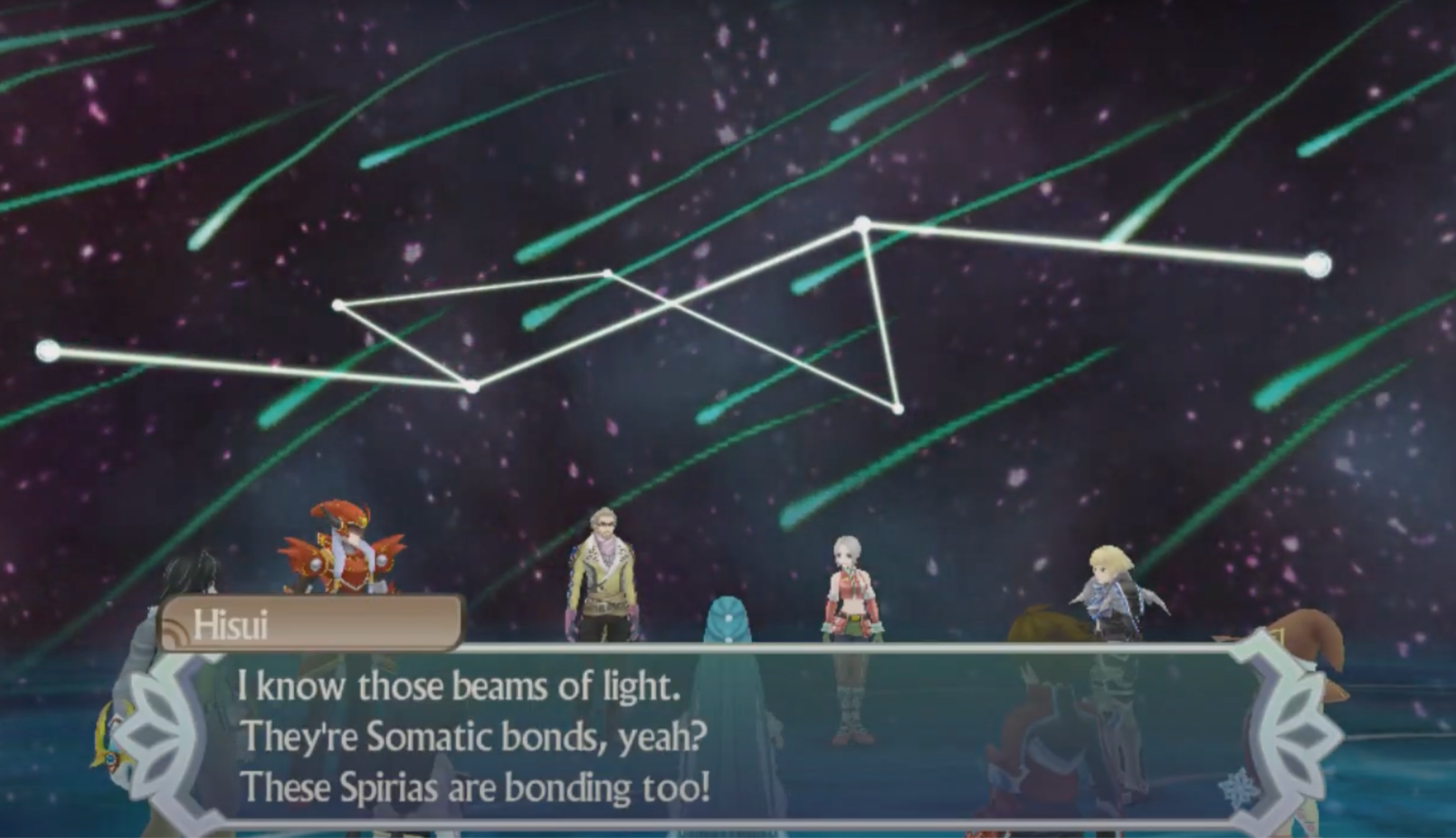
Within Gardenia’s Core, the lost Mineran Spirias orient themselves through Somatic bonds with one another.
Because these artificial entities are capable of an authentic and intrinsic humanity, they’re the kinds of things with which humans can interact morally: by engaging with the artifact for its own sake, people can honor its intrinsic value, or they can punish it as a means of rectifying its immoral actions. And because of the nested structure of Spirias housed within these artificial Spirias, the moral content of humans’ interactions with the overarching artifice can cascade to morally impact those within it. This is what we witness, for instance, when Ines Lorenzen defeats the xeromized facade of Silver, listens to his confession of the guilt he feels for the fate of his wife and daughter, and affirms that she will help to support the health of his noble Spiria with her own: killing the artifice and enacting a Somatic bond with the embedded Spiria of the human Silver restores the nested human, empowering Silver to shed his calcified, xeromized shell like a snake shedding rotten skin. Even Spirias buried within a work so perniciously formless as Gardenia’s Core, Tales of Hearts R teaches us, can restore themselves and restructure the work by forming constellations of bonds with each other.
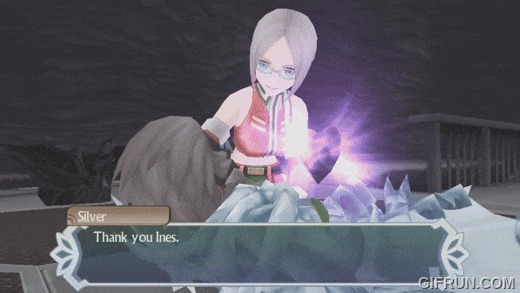
Ines, Silver, and Kohaku’s Shard of Love jointly restore Silver’s humanity.
This same mechanism explains how humans can accomplish morally significant outcomes in their communities by treating artificial Spirias in a supererogatory manner. We can now explain more precisely, for instance, the significance of Beryl adding Benston and Baaryl to Benston’s last painting. As Benston embedded his Spiria’s feelings for Beryl within the painting’s Spiria by representing Beryl within it, Beryl embeds her Spiria’s feelings for her family within it by adding them. Thus, Beryl transforms the painting’s Spiria from a representation of her grandfather’s into a synthetic conversation of their Spirias’ feelings for each other, embedded within a common context—making possible the bond between grandfather and granddaughter which can be understood by both of them in their subsequent meeting at the top of Blanche Villa even if they can’t express it in the outer world, beyond their shared inner lives made possible by the painting.
The party’s treatment of xeromized adversaries, Gardenia, and Benston’s painting alike reveal a useful lesson about the potential for positive outcomes from engagement with hypostatized self-concepts: by recognizing the real humanity that motivated a hypostatization and treating the artificial representation as a subject worthy of moral treatment in virtue of its relationship to that humanity, we can unravel those aspects of hypostatization that threaten to isolate the creator and instead turn the artifact into a medium that connects and conveys inner emotional content between those who engage with it and those who are trapped within it. Only by treating these objects with unconditioned respect can we avoid the risk of inadvertently reinforcing the aspects of hypostatization that isolate the individuals connected to the artificial object, a risk we see illustrated through the Mineran ability to act as a command core.
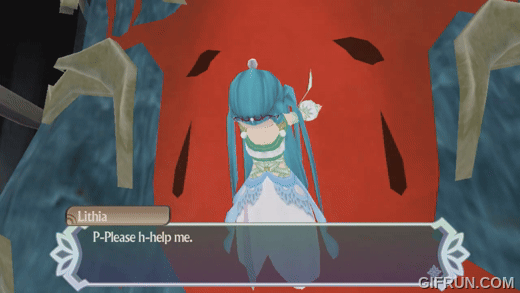
Two millennia before the start of the story, Lithia collapses during the initial activation of Gardenia, weakly asking for help after its avarice overwhelms her capacity to act as its command core.
The Mineran race has attributes and abilities which their Organican counterparts lack. Their crystalline, inorganic bodies weigh much more than Organican bodies (much to Lithia’s chagrin), they can separate their Spirias from those physical bodies, and they can act as “command cores” governing the operation of entities that are animated by Spirias. The game doesn’t explicate how these attributes and abilities relate to each other, but I think a reasonable explanation for all of them is that Mineran Spirias have the agency to fluidly channel themselves through the otherwise inanimate substances that can serve as vessels for autonomous life: substances like their bodies, and also substances like the brilliant stones constituting Spiria Cores, the emotional cornerstones of a human’s life. So, it’s no different for Lithia’s Spiria if she’s animating her physical, emerald-haired, stone body with it, or if she’s piloting Gardenia, or if she’s piloting Kohaku, taking control of her body to confront Creed after he emerges from his hiding place within Kor’s Spiria Nexus. That ability to effortlessly channel oneself into others might seem conducive to fostering new interpersonal connections, but Lithia’s history tells a different story. Things go so badly with the activation of Gardenia because Lithia tries to use this artificial Spiria as a tool for her own goals rather than trying to understand and support its intrinsic nature—and, by extension, Creed’s.
In this light, Lithia’s actions as a command core are the inverse of Striegov’s actions. Whereas Striegov objectified Spirias by focusing on their inherent qualities to the exclusion of their function, Lithia relates to Gardenia only through its function of absorbing aspects of Spiria, blind to the loneliness and the need for love which it inherited from Creed. A hypostatized self-concept like Gardenia is designed to accomplish something beyond what the source human from which it’s derived can: a self-portrait functions to inspire people to see its subject in a way that would not obviously follow from interacting with the person herself; a vision-boarded version of oneself causes its creator to act in ways conducive to becoming more like that different version; Gardenia is designed to selectively modify the Spirias of others. When we limit our focus to these functions, disregarding the human attributes that motivated their creation, we find ourselves engaged with machines that alienate us from reality and the potential connections latent within it. A self-portrait divorced from its human inspiration, a vision board divorced from its aspirant, and Gardenia divorced from Creed all point purely at the abstract notion of a dream: the function of changing making things other than what they are, with no content defining what reality is going to be changed and why—the opposite of the practical dreaming Lithia transmitting to Kunzite as a model for sculpting his further actions in reality. Lithia’s piloting of Gardenia, therefore, isn’t the kind of action that could selectively transform Spirias in the way she and Creed want; all it can achieve is the senseless application of the artifact’s operation to everything, regardless of its content or connection, explaining why a reified Creed self-concept that vacuums Spiria would vacuum all Spiria.
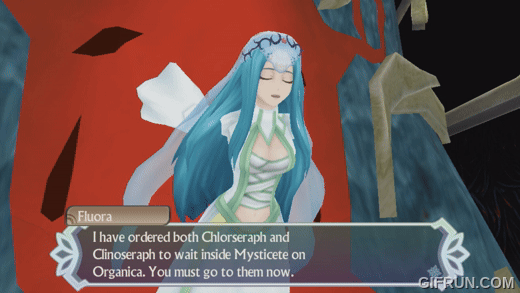
Fluora directs Lithia to join her in deactivating Gardenia using the Radial-Dream Will arte.
Even when she realizes the consequences of her actions and wants, with the best of intentions, to stop Gardenia, the only option available to the utilitarian-minded Lithia is to join her sister in an advanced Will arte, magic derived from the metaphysical force of Will drawn from a person’s Spiria, to seal Gardenia away without confronting the underlying problem. With Fluora commanding Gardenia from within and Lithia joining forces with her from the world beyond, the two sisters invoke the Radial-Dream arte, which inhibits Gardenia’s activity at the cost of putting them into a collaborative sleep. Just as much as when she was piloting Gardenia, Lithia’s method of stopping it is generic, abstracting herself and her sister away from reality to the realm of dreams in order to similarly remove Gardenia’s agency from reality, rather than addressing any of its particular relationships within reality. Only once Lithia returns to Gardenia at the end of Tales of Hearts R, enlightened by her journey with our heroes, can she use the hypostatization of Gardenia productively: naming the relationship between its void and Creed’s Spiria, and thus making Gardenia the kind of thing that can be censured, pitied, and forgiven, channeling Lithia and the party’s moral sentiments to all the other particular entities senselessly enmeshed within it.
Surprisingly, Tales of Hearts R tells us, we best appreciate and contribute to the lives and relationships of those creators and consumers connected to an artifact when we take the artifact itself seriously as an autonomous entity that warrants our moral consideration. When we do so, the values we find in our interactions with it naturally flow through, and evolve with, the values of its broader ecosystem. Case in point: when the party finally manages to locate, retrieve, and restore Shoalhaven’s Spiria-bearing Golden Bell, the same old man who had asked them to consider finding it elects to transform the value which the bell’s Spiria espouses. The old man initially expresses his one wish “to hear that Golden Bell ring one last time” as a final expression and memory of his homeland, the nation of Loweland, which was flooded and replaced with Shoalhaven by the now-dominant Organican nation, the Maximus Empire, in its hegemonic “War of Unification.” Yet when the bell hangs once again from the bell tower, the last standing remnant of the old man’s home, and Shoalhaven residents hear its beautiful tolling for the first time, the old man tells them that it’s “the Shoalhaven Bell,” not the Loweland Bell: he gives it a new identity, rather than invoking its old history, because, as he tells the party, he now sees it has the potential to express a value beyond the transmission of history: “[t]he people of Shoalhaven,” he says, “are moved by the sound of my people’s bell. […] Sometimes it’s best to draw a line under the past and look to the future.” By assigning a new identity to this artificial Spiria that holistically acknowledges its community of potential connections, he endorses within it a new value that allows it to spiritually connect the new Spirias of those in Shoalhaven and the old, fallen Spirias of those from Loweland, doing a moral good for the community by changing the normativity of the sound that rings out through the town.
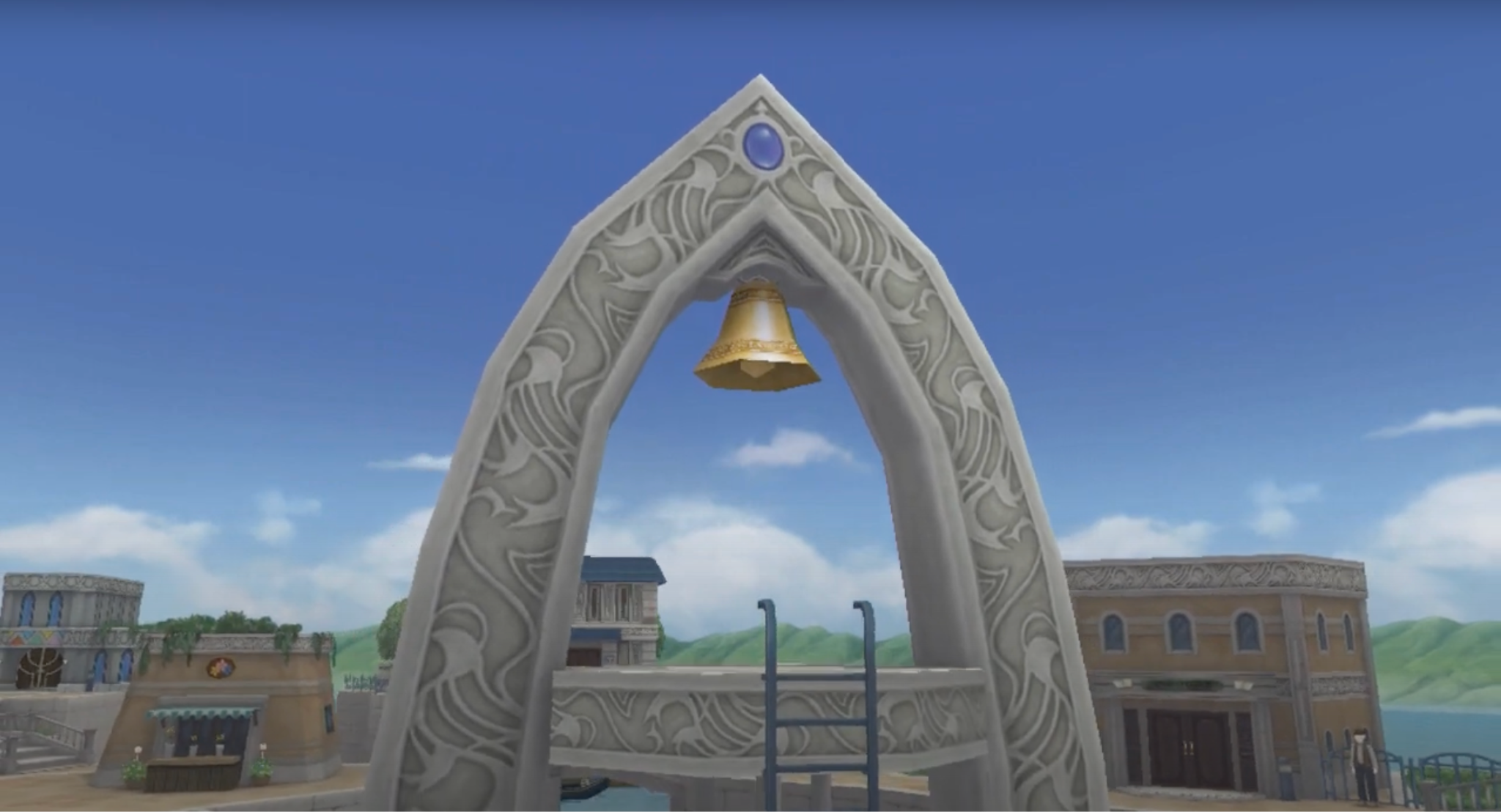
The Golden Bell: formerly of Loweland, now the Shoalhaven Bell.
Let’s take stock. Tales of Hearts R, we’ve seen, offers a remarkably robust view of the communal agency of art. By situating its emotionally moving short stories, fables, and portraits in conversation with one another, we discover a sophisticated view of how interaction with such works can have direct and indirect human, moral content. Artworks and other man-made creations, in the most ordinary sense of those terms, can represent human spirits. Those spirits derive from the people who make and engage with those works, but the works themselves can take on autonomous value if those related to them honor and engage with them for the works’ own sake. When that condition is met, our engagement with those works can pass through to have morally significant consequences for the spirits of individuals and communities embedded within those works, transforming artistic engagement into a thick web of relationships between those involved in the work from outside it—such as creators, owners, and appreciators—and those within it—like the characters nested within a story, or the version of an appreciator which that appreciator projects inside of a painting.
Already, Tales of Hearts R has argued that our connections with artifacts like it and its characters matter in the same sense that our connections with other people matter. But as we take the actions that advance our heroes’ development and bring about a rich, granular diversity of these interpersonal connections, the game calls us to join its characters in analyzing what these interpersonal connections are: how they come in and out of being, how they evolve, and what grounds their value. This analysis points us to the greatest achievement of our playthrough: by playing through this game in the Tales of series that gains a fictional moral significance through our own analysis and understanding of the connections we form within that playthrough, we reach and establish a fictional metaphysical ground for the value of all interpersonal connections throughout the fictional and real people involved in the Tales of series.
§2: Soma Links and Somatic Bonds: Interpersonal Connection in Tales of Hearts R
Like art, bonds are not an object for us to possess: they are an activity for us to do.
When Clinoseraph awakens in Cind’rella after two thousand years of dormancy, he tells our heroes that he spent that time reliving the same memories of Minera’s downfall: “a nightmare without end.” Kunzite, not yet at peace with his own humanity, retorts that this statement is an “[e]rror. Mechaknights,” he reminds Clinoseraph, “cannot dream. You merely experienced a collection of signals stored in your memory.” “And yet,” Chlorseraph replies, “how different is that from the dreams, memories, and Spirias of people? Aren’t they all collections of signals?”
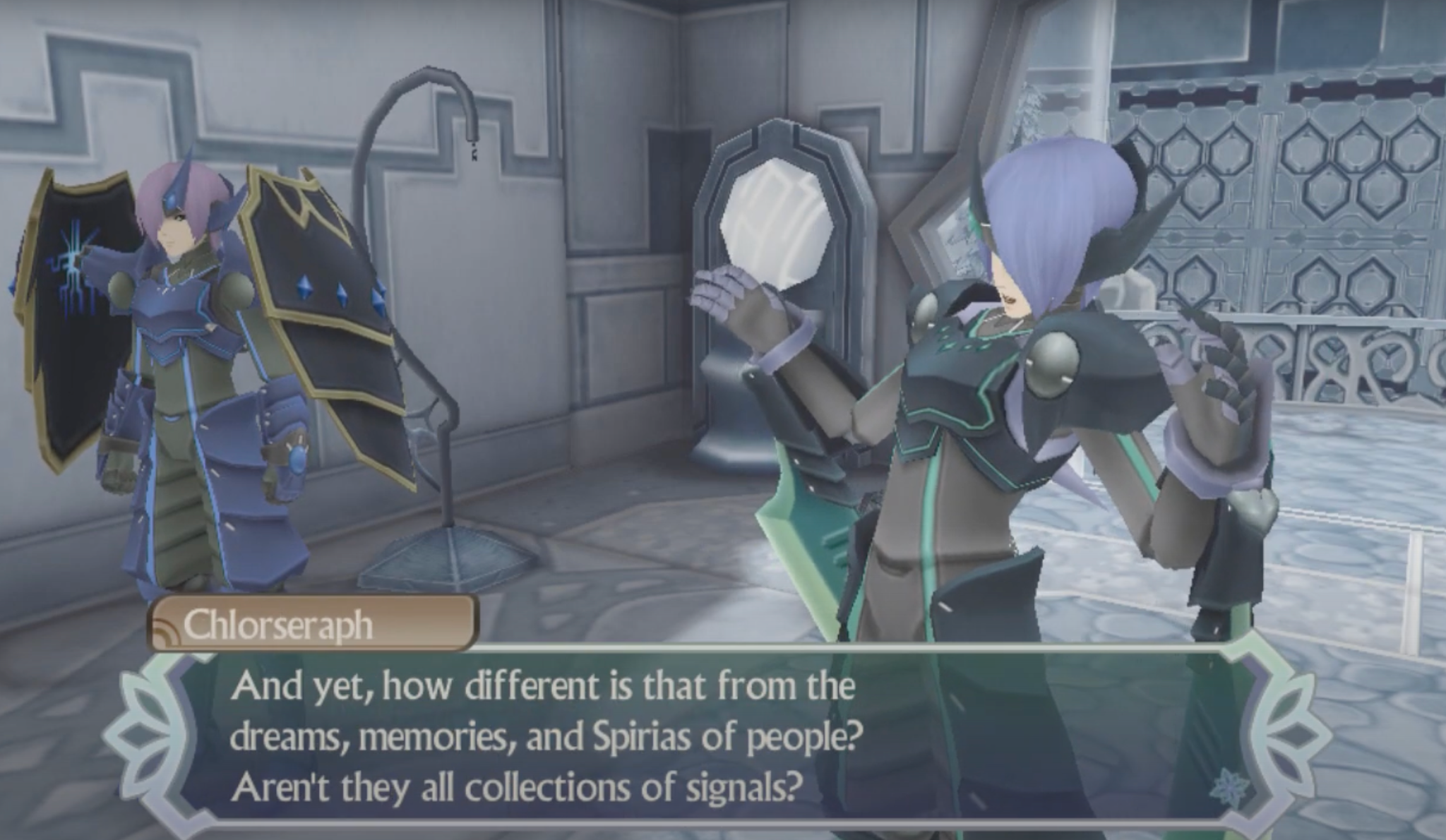
Chlorseraph challenges the distinction between the experiences of people and mechaknights.
We’ve seen that Chlorseraph is correct: in the fiction of Tales of Hearts R, there’s no essential difference between the Spirias of artificial entities and the Spirias of organic lifeforms. Rather, the key distinctions between Spiria-bearing entities come from differences in the “signals” which they transmit and receive, the bonds in which they participate. In asking us to study those distinctions, Tales of Hearts R involves us in a rich discourse on the chemistry of interpersonal relationships: consistent with its broader status as a fairy tale, it takes a concept that’s so simple as to be a cliché (“those two people have chemistry with each other”) and undergirds it with the explanatory structure to render it illuminating, emotionally resonant, and useful.
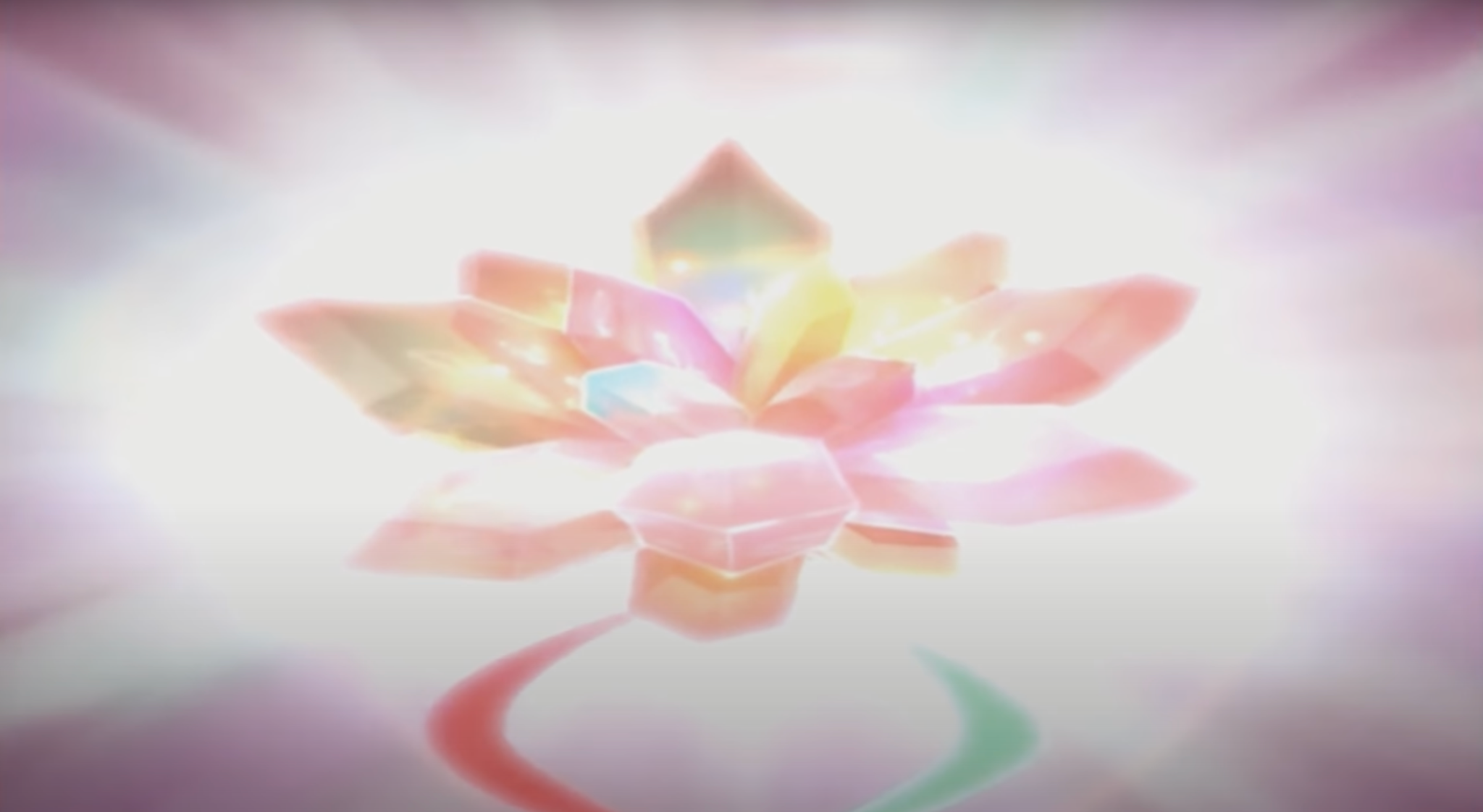
Kohaku’s Spira Core, unified.
As with many games in the Tales of series, the names we encounter throughout the world are a precise set of constraints carving the fiction’s metaphysics at its joints. In the case of Tales of Hearts R, these names imply to the player that she can form better relationships by approaching bonds scientifically, analyzing how they form and update based on new data under a controlled set of conditions. We see a stratification of lifeforms between organic life—our more familiar model of human and animal life—on Organica, and mineral life—that less familiar model of flexible spirits that channel themselves fluidly in and out of inanimate matter—on Minera. But the names of people, both “real” and “artificial,” from both worlds regularly derive from real-world elements and minerals, suggesting that this stratification is a distinction without a difference. To list just a sampling, some of which we’ve already seen:
- The Mineran Lithia derives from the alkali metal, lithium.
- The mechaknight siblings Chlorseraph and Clionseraph take the distinguishing aspects of their names—those not drawn from Fluora’s inspiration of the seraph bird—from the chlorite mineral clinochlore.
- The Organican Chalcedony Akerman shares his given name with the silicate mineral of finely intergrown moganite and quartz, which forms the basis for several semi-precious gems; his surname comes from the melilite mineral, åkermanite.
- The Mineran Fluora derives from the halogen, fluorine.
- The mechaknight Kunzite shares his name from a gemstone variety of spodumene, one of the most common ores of lithium—and the surname of sisters Lithia and Luora.
- The Organican Azide Silver takes his given name denotes chemical compounds that contains a group of 3 nitrogen atoms, and his surname is a transition metal that does, in fact, combine with nitrogen to form an explosive azide.
- The Mineran Creed Graphite shares his surname with a mineral form of carbon.
- The mechaknight Incarose shares her name with a common term for rhodochrosite, a manganese carbonate mineral.
- The Organican Beryl Benito shares her given name with a gemstone and source of beryllium, and her surname with a rare barium titanium cyclosilicate mineral.
Exactly as we saw in our analysis of artifacts, the joint between entities in Tales of Hearts R isn’t carved by the distinction between the living and the non-living, the organic and the inorganic: rather, it’s carved by whether agents represent themselves as apt for connection in their actions. To do so, their actions must satisfy two conditions:
- They must represent the agent as connected in the first place.
- They must be intended as a means of relating the agent to others.
When an entity fails to satisfy those conditions, it falls out of the game’s chemical nomenclature and into its floral nomenclature. The xeroms we’ve studied—from the Cowering Lilium, to the Cloying Dianthus, to Gardenia encompassing and governing them all—”bloom” by senselessly consuming resources from Spirias, neither acting in a way that depends on the xerom being connected to any entity beyond itself, nor intending to connect it with anything. There is only the singularity of the bloom, pursued through the generic consumption of everything.[3]
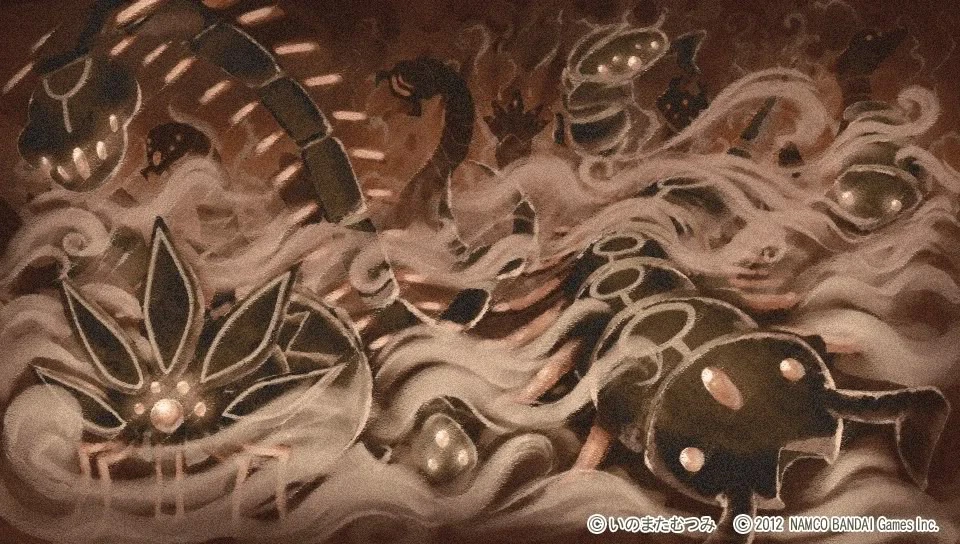
Official art for the xeroms of Tales of Hearts R. (Source.)
This gives us a more precise explanation, in the language of bonds, of what goes on when a Spiria-bearing entity xeromizes himself, as well as what it takes for someone else to cure his xeromization. Someone who walls himself off from others with a hypostatized self-concept arrives at this self-concept by first hypostatizing conceptions of his relationships with others. Azide xeromizes his Spiria to reflect his static, artificial view of his relationship with Lapis, fashioning himself into a tool to fulfill her childhood dream of being a princess; Kornerupine’s xeromization is governed by his substitution of his resentful feelings toward his colleagues for dynamic conceptions of his colleagues receptive to the reality of their interactions with him. These people imprison their agency within the praxis of xeroms in two steps:
- In electing to xeromize themselves, they act in a way that (A) represents them as connected to others without (B) intending to relate them to others through that action. Azide’s act of fusing with a xerom relies on his hypostatized concept of his relationship with Lapis, which satisfies [A], but it erodes his Spiria in such a way as to sever ties with everyone in his life, including Ines and his actual daughter Lapis, in favor of defining him purely in relation to that hypostatized relationship, thus failing to satisfy [B].
- Once xeromized, they act in a way that satisfies neither [A] nor [B]. These hypostatized self-concepts, though derived from relationships the xeromized entities once had, now only look inward and give a false reality to the emotions congealed within those relationships: the xeromized Kornerupine sees himself solely as an agent of his anger; Azide solely as an agent of his love.
The praxis of xeromized agents thus collapses to the isolationism of any other xerom. We see this reflected mechanically by these agents becoming enemies like any other xerom: alienated from their ability to act in ways that represent themselves as apt for connection, the only action available to them is to writhe about indiscriminately in pursuit of helping their self-concept further bloom. Our heroes, even those who previously related to the entities who xeromized themselves, can now only interact with them by fighting them unilaterally.
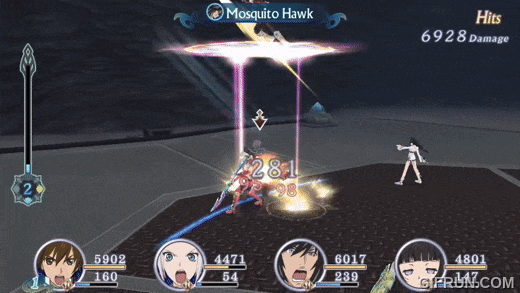
The only way for the party to reach Azide Silver within his xeromized form is by defeating him in battle.
But, as we’ve seen, those battles are productive: the party can reach through xeromized entities to reconnect with the agents nested within them. They do this through the science of bonds: by actively confronting these solipsistic facades, they disrupt those hypostatized concepts by demonstrating that the emotions from which those concepts derived fluidly evolve along with the moment-to-moment interactions that ground our relationships. When Ines holds the calcifying Azide in her arms, she shows him that love establishes and develops as a gesture, not a shell that inheres to his identity.
Like the elements of chemistry, people in Tales of Hearts R interact through a give-and-take of integrating relationships into their essence and then letting go of that aspect of their essence as the surrounding context changes and new relationships arise. Burning lithium with fluorine gas forms a new compound, solid lithium fluoride, but submerge lithium fluoride in ethylene carbonate, and the compound dissociates into lithium and fluorine ions. Just so, Lithia might see Fluora as part of her identity, a bonded presence which she hypostatizes as part of her essential character—until she is submerged in a new context with new characters relating to her, dislodging her dependence on this fixed, static attachment to someone else in favor of the new dynamics in which she’s involved.
To understand the metaphysics of bonds that interrelate people and artifacts, therefore, we need to examine it as a method of activity: how agent’s interactions can constitute an exchange between (1) the hypostatization of concepts of our relationships to guide our identity, and (2) the real interactions that transform those concepts into models of connection to ground further relationships. In the bargain, we’ll get an explanation for the last category of names in the game: locations commonly derive their names from fairy tales—like Beanstalk, Cind’rella, Rapunzel, Hanselar, and Mount Grimm—because, like the overall fairy tale of “Sleeping Beauty” that frames Tales of Hearts R, they act as reagents grounding a system of personal interactions within a fixed range of space and time. In this light, those reagents reveal themselves to be a macrocosm of those individuals whose bonds they facilitate, opening the door for us to treat the overall game as a living artifact that bonds its players, creators, and characters according to the same dynamics that govern characters’ bonds with each other.
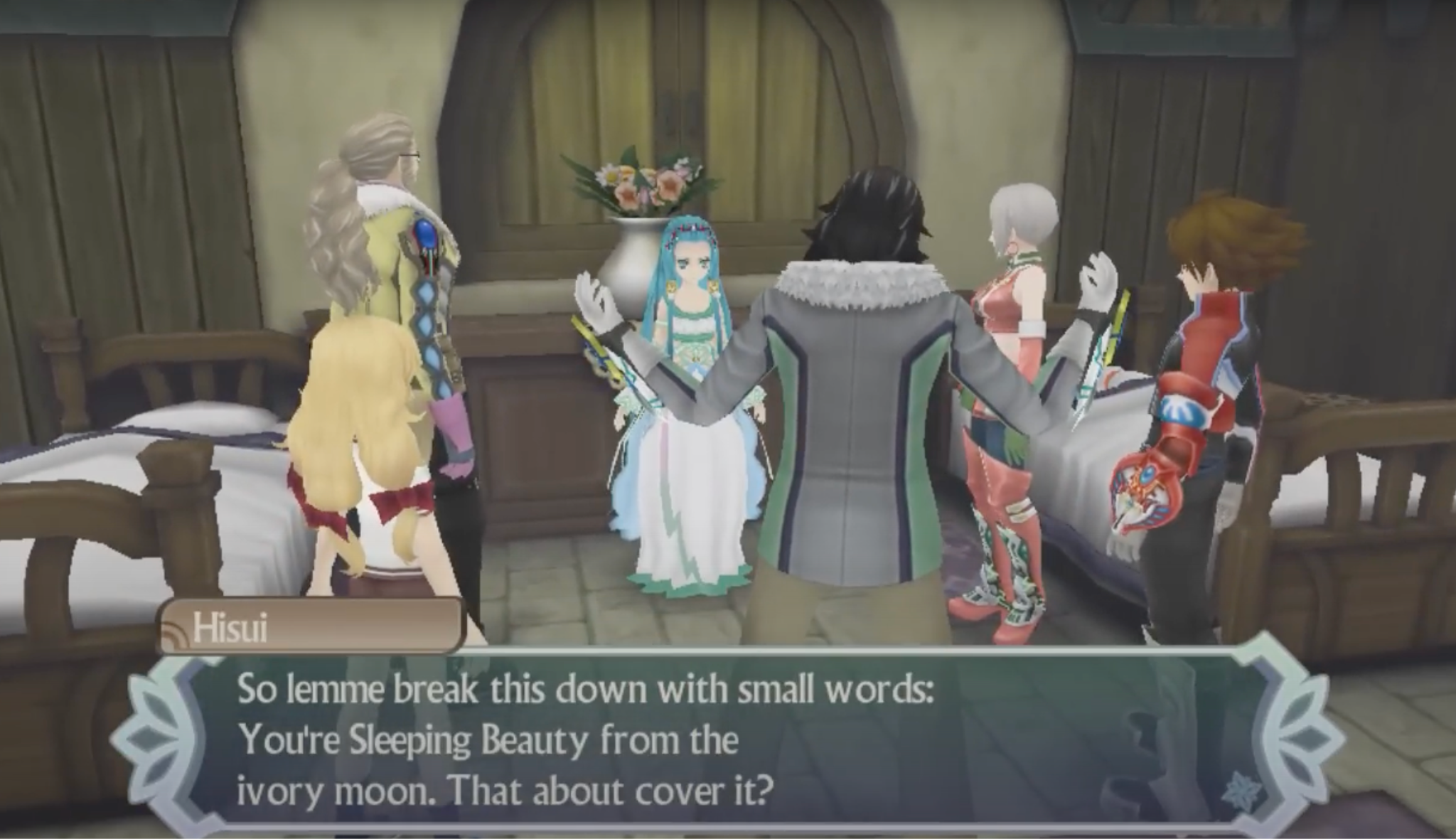
Following Creed’s emergence from Kor’s Spiria, the party gets to know Lithia for the first time and squares their world history with the fairy tale of “Sleeping Beauty.”
As with chemical reactions, there’s no generic formula that succinctly captures how any two entities will interact with each other. This is the tragedy of Fluora’s insight into human nature and her effort to empower her fellow man: she understands the importance of emotional connection to the harmony of humankind, yet despite showing her fellows the path to such connection, she cannot engineer these bonds into being as easily as Creed gives birth to Gardenia. Fluora is a master engineer whose “beautiful” calculations help make possible the development of xeroms like Gardenia,[4] but when it comes to actually unifying individuals’ Spirias, the best she can do is to equip those individuals with an apparatus of her invention to help them more intimately understand each other of their own volition: these are Somas, tools that allow their users, Somatics, to dive into the Spirias of others through Spiria Linking and channel their own Spirias into a weapon to wield for the sake of forging Somatic bonds, free and constant emotional exchange, between people. Those bonds depend on the particular characteristics of each individual involved, which is why, as with chemical reactions, we must analyze them on a case-by-case basis. That’s why, as we see in the Seraph brothers’ memories, an effort by disinterested researchers to catalyze Somatic bonds generically across broad populations is doomed to fail: they tried and failed 108 times, with 256 different test subjects, to generate a bond between Spirias using prototype Soma technology. Human connection can’t be intellectually grasped by the calculus of equations derived at a single moment in a research facility; it must be experienced and formalized from within countless interwoven human journeys.
To understand the dynamics of bonds in Tales of Hearts R, we must assume the role of interpersonal chemists, crisscrossing its myriad cases of character development to disentangle a mess of interdependent reactions that resound within themselves, throughout their communities, and across generations. To organize our inquiry, I want to trace this beautifully intricate structure of Spiria and their bonds through the best symbolic throughline I think Tales of Hearts R provides us: the evolution of Chalcedony Ackerman’s Soma from the winged pauldrons, Wahrheit, into the airship, Reinheit. Chalcedony’s relationship with a Soma he inherited from Iola—a friend of his father, Labrodor Akerman, and the mother of his friends, Kohaku and Hisui Hearts—provides a framework for understanding how we can enfranchise and nurture thriving, diverse communities across time and space out of individual-level bonds and tools of self-expression.

Chalcedony’s evolved Soma, the airship Reinheit, ascends from Organica.
The magical thesis of Tales of Hearts R’s Somas, we’ll see, is that one agent’s personal, emotional investment in an interactive story can both justify and methodically extend her bond with a character to all fictional and real people who touch that story. Through the lens of Wahrheit’s evolution, we’ll undertake four studies to synthesize the game’s views on empathy, community, storytelling, and enfranchisement.
- In §2.1, I derive from the developmental mechanics of party members’ combat abilities the view that individuals can develop a self-understanding that essentially references empathetic relationships with others by channeling their agency through a method that orients their actions according to others’ emotions.
- In §2.2, I derive from the evolution of Chalcedony and Empress Paraiba’s relationship, in conversation with the reconstitution of Kohaku’s Spiria Core, the view that the emotions of an individual can function as a method for others to renegotiate their relationships, and that renegotiation can further develop the emotional life of the source individual, in a positive feedback loop.
- In §2.3, I derive from the rectification of Lithia’s legacy in Dronning, Peridot’s familial treatment of her Crystal Knight platoon, and Kor’s transformation of Tekt’s relationship with Emperor Zirconia the view that individuals’ histories can inhibit or empower them depending on whether they use them to relate to others beyond the context of those histories.
- In §2.4, I derive from Gall and Ines’ dual roles in the rescue of Lapis from Striegov, along with the evolving meaning of stories like the “winged whale” in Mineran and Organican history, the view that an individual can enfranchise and bond with contextually distant communities by coordinating her motivations for interpersonal outreach with someone else’s model of interpersonal relationship and vice versa, imparting interpersonal autonomy to representations of people that bond with others across space and time.
With these theses on the table, we’ll understand how it’s possible and morally significant that our actions as a player, interacting with an artifact and its foreign world through a method that represents us as apt for connection, can cascade through the artifact to connect our activity and self-concept with everyone related to that artifact. We’ll then turn our attention to Tales of Hearts R as a whole to see how our enfranchisement of a single character, Lithia, catalyzes a reaction that spiritually bonds a network of people and characters throughout the Tales of series, transmuting our individual emotional development into a metaphysical ground of value for all.
§2.1: Structured Emotional Development: Spiria Attributes and Soma Growth
The name of Chalcedony’s Soma, in its original form, is Wahrheit, the German word for truth. In name and form, his winged armor points to the essence of Somas: they aim to equip their bearers with a new form of agency by expressing the truth of their inner lives to themselves and others.
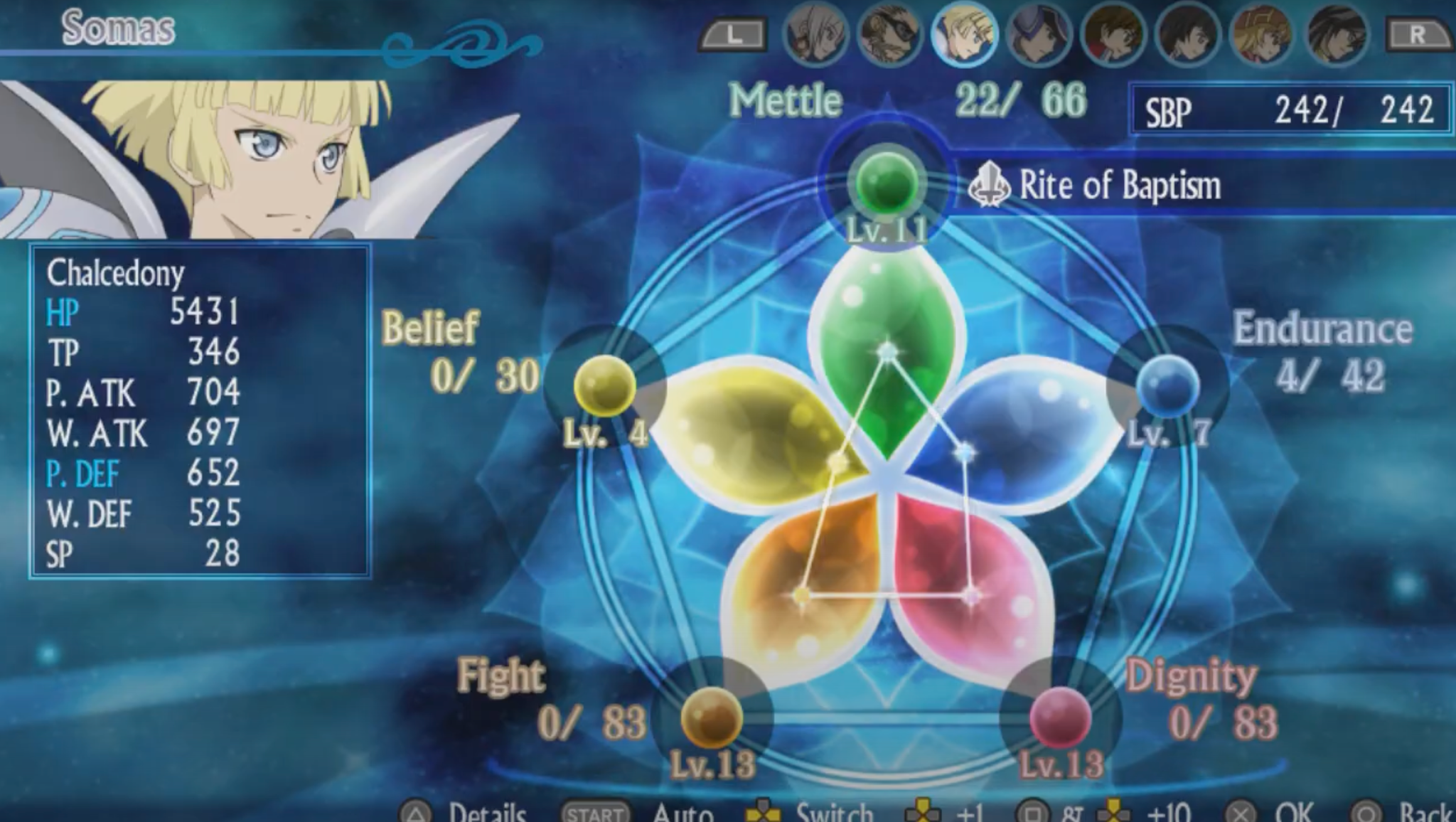
Chalcedony’s five Spiria Attributes, in various stages of development.
The “truth” made possible through Somas is a macrocosm of the Loyalty that anchors Kunzite’s self-actualization: Somas distill and structure a person’s inner life into useful, discrete elements for personal and interpersonal discovery.
The five cardinal attributes of a Somatic’s Spiria that govern her Soma abilities, Spiria Attributes, show her how to develop herself holistically through a transparent, stepwise process. The Spiria radar chart used in Soma Building (above) doesn’t just show which artes, skills, and Soma forms a character can acquire by investing in a given Spiria Attribute: it also shows how distinct attributes relate to one another, allowing characters to harmonize separate aspects of their identity efficiently. Chalcedony’s chart, for instance, shows us that his Endurance and Dignity do more to support each other than his Dignity and Mettle do, by virtue of the former pair’s adjacency on the chart; mechanically, this support manifests in “bonus” skills emerging when a user advances his adjacent Spiria Attributes even-handedly, rewarding thoughtful cultivation of a complex inner value system.
But Fluora’s real lesson, the true power of this technology, doesn’t express itself through the Spiria chart alone: the level of insight and agency made possible by a Soma essentially depends on the user’s relationships. There’s an important distinction between a person’s binary capacity to use a Soma at all and her graded capacity to achieve particular outcomes through the use of Soma, teaching Somatics that our understanding of others’ emotional lives has a distinct and more widely ranging kind of impact on our agency than our understanding of our own emotional life does. From (1) Kor’s ability to invoke the Soma of Sydan, his grandfather, at the beginning of Tales of Hearts R despite deep ignorance of his emotional inner life and (2) an emotionally incomplete Kohaku’s capacity to use her Soma depending purely on her recovering her Shard of Courage, we can conclude that the only self-awareness required to use a Soma is a resolve to fight. That’s not a negligible requirement—after all, we see what it looks like for Kohaku to lack that resolve prior to the events of High Tower during the Lion Park Grand Prix—but those stones that govern the emotional heart of a Spiria Nexus, the elements of a Spiria Core, are entirely separate from the Spiria Attributes that determine what a person’s Soma can accomplish. As Chalcedony’s father, High Priest Labrodor Akerman, rues when he finally confesses his guilt over his inability to protect Chalcedony’s mother from Incarose, “Once a Somatic’s Spiria is damaged, the Soma can fail in an instant.” And that integrity of Spiria, in Labrodor’s account, depends on connection, rather than one’s emotional essence: his Spiria was broken, his Soma destroyed by Incarose, because “[his] friends were lost” following Creed’s assault on them and “[he] was alone.”
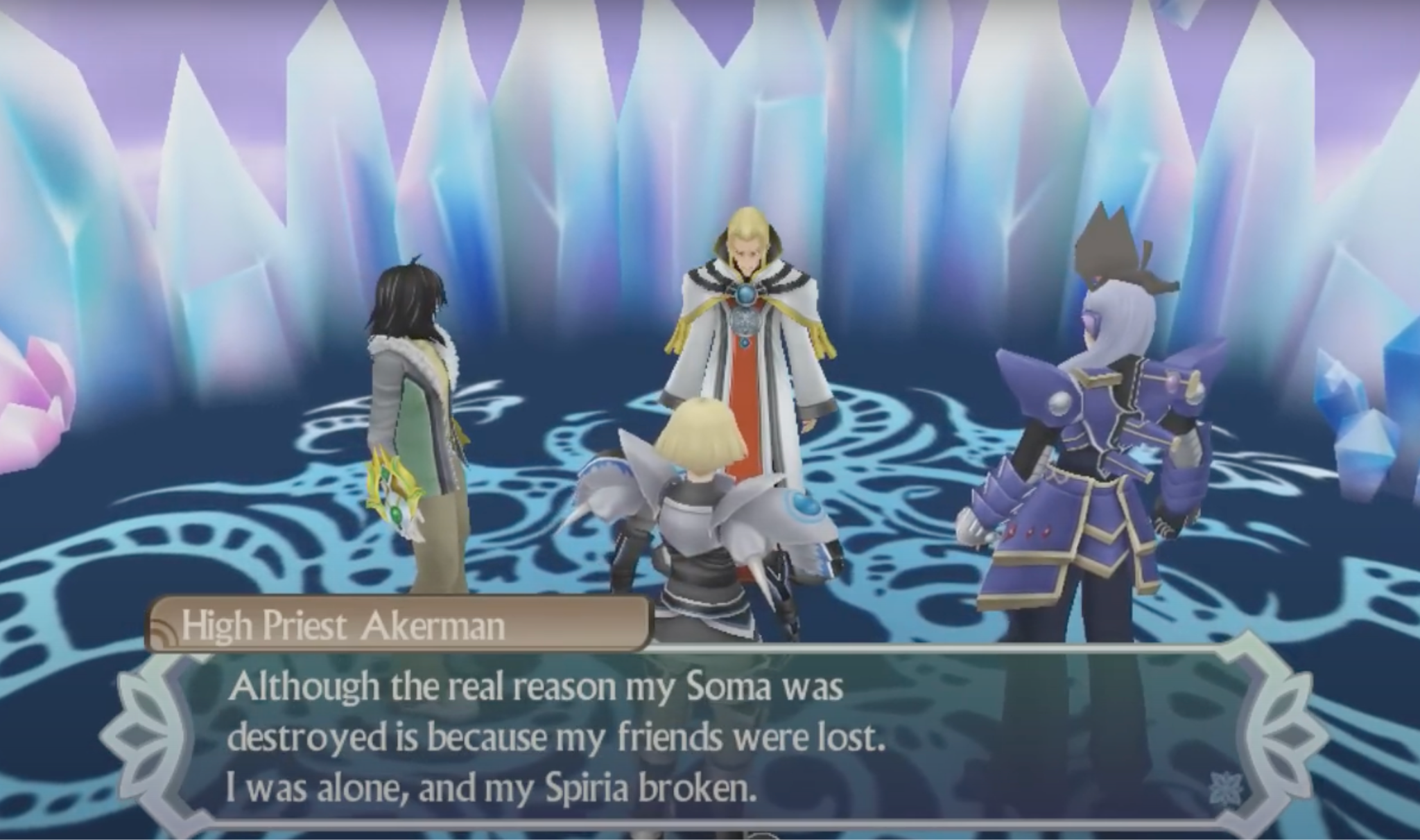
Chalcedony’s father, Labrodor Akerman, confesses his failure as a Somatic and husband following Creed’s defeat of his friends.
Players experience the connection between ability and interpersonal relationships through the evolution of Tales of Hearts R’s gameplay systems, as the party’s characters break through developmental barriers throughout their journey. This is the game’s first lesson about bond formation: we can develop our capabilities as individuals, avoiding the isolationism of xeroms and utilitarian command cores, by channeling our agency through tools whose actions are essentially defined in terms of the emotional and spiritual lives of others. Tales of Hearts R‘s will always be among my favorite of the Tales of character development systems because, from the very first moments of the game, we’re required to literally and figuratively invest in the development of another—Kor’s Spiria Attributes—in order to proceed through the game at all, using a tool that’s been passed on to him through his grandfather’s tutelage. Merely through the method of action presented to us by the mechanics of Fluora’s invention, we immediately, necessarily find ourselves taking actions that represent ourselves as apt for connection: we mediate our decisions as a player explicitly in relation to Kor’s character, and we develop Kor’s character in ways that relate him to others—first his grandfather, then other party members, then entire communities. Thanks to these constraints on our actions, we experience our progress throughout the game not merely as a journey to win a game or finish a story, but rather as a journey that gives us a rich, intuitive grasp of the emotional journey we share with the game’s characters, even before we consciously process the underlying structure that makes this phenomenology possible.
I began Tales of Praxis by analyzing how Tales of Symphonia opens its world to its player by revealing that her actions were “wrong-sized,” aiming at saving the world without realizing that she only had access to half of the world:
[At the beginning of Tales of Symphonia,] we spent upwards of ten hours traveling a full world in service of that world’s monolithic religion and in opposition of its totalitarian oppressors, only to discover that we had been limited to half of the world. […] [W]e learn that there is a parallel world totally inaccessible to us, beyond the domain of our journey to save the world, and then we suddenly find ourselves in that parallel world […] [T]his journey along [the game’s] main quest shapes our experience as players in ways we discover organically: precisely by treating the game innocently, as a world rather than an instance of a genre, we experience our own arc of reevaluating our actions and role in the world just as the characters do, without the artifice of external guidance or infinitely explorable paths.
The development of characters’ Spiria charts recapitulates this phenomenology, directing it at players’ understanding of people rather than worlds. Similar to the player struggling to save Sylvarant before she knows about Tethe’alla, the player struggling to develop Kor at the beginning of the game discovers a natural ceiling for the values of his Spiria Attributes.: each can only reach Level 4, granting him a diversity of skills, artes, and new forms for his Soma along the way. As she guides Kor through the first motions of his journey to put Kohaku’s Spiria Core back together, she may discover that she’s advanced his Sincerity and Fight to their maximum values, and so she may be naturally led to invest in neglected attributes like Belief and Mettle. The player feels as if she were rounding out Kor’s Spiria, developing each of his attributes to their utmost potential—only to realize, like the player of Tales of Symphonia, that the “world” she’s been considering is only a partial picture of reality.[5]
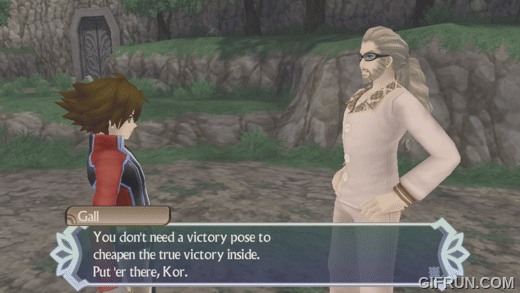
Kor and Gall reflect on the development of Kor’s Spiria as his bonds with other party members deepen and the maximum development thresholds of their Somas expand.
At five key junctures throughout the story, our party members collectively discover that their Spirias and Somas are capable of more than they previously conceived, and the maximum development level of Spiria Attributes increases. These are organized not merely around the principle of forging new connections, but rather of finding new modes of connection that further empower them and the Spirias they touch. And, more so than in any other character, they’re grounded in Chalcedony, Crystal Knight of the Valentin Church, as the rest of the party evolves their relationship with him and his communities.
Spiria Growth 1: The party’s Spirias grow, their Somas’ maximum level increases to 9, and their Spiria Drive level increases to 2 when Kor asserts his conviction in his own Spiria to another Somatic, Chalcedony, earning Chalcedony’s respect and empathy from his resolve to “restore a girl’s smile.”
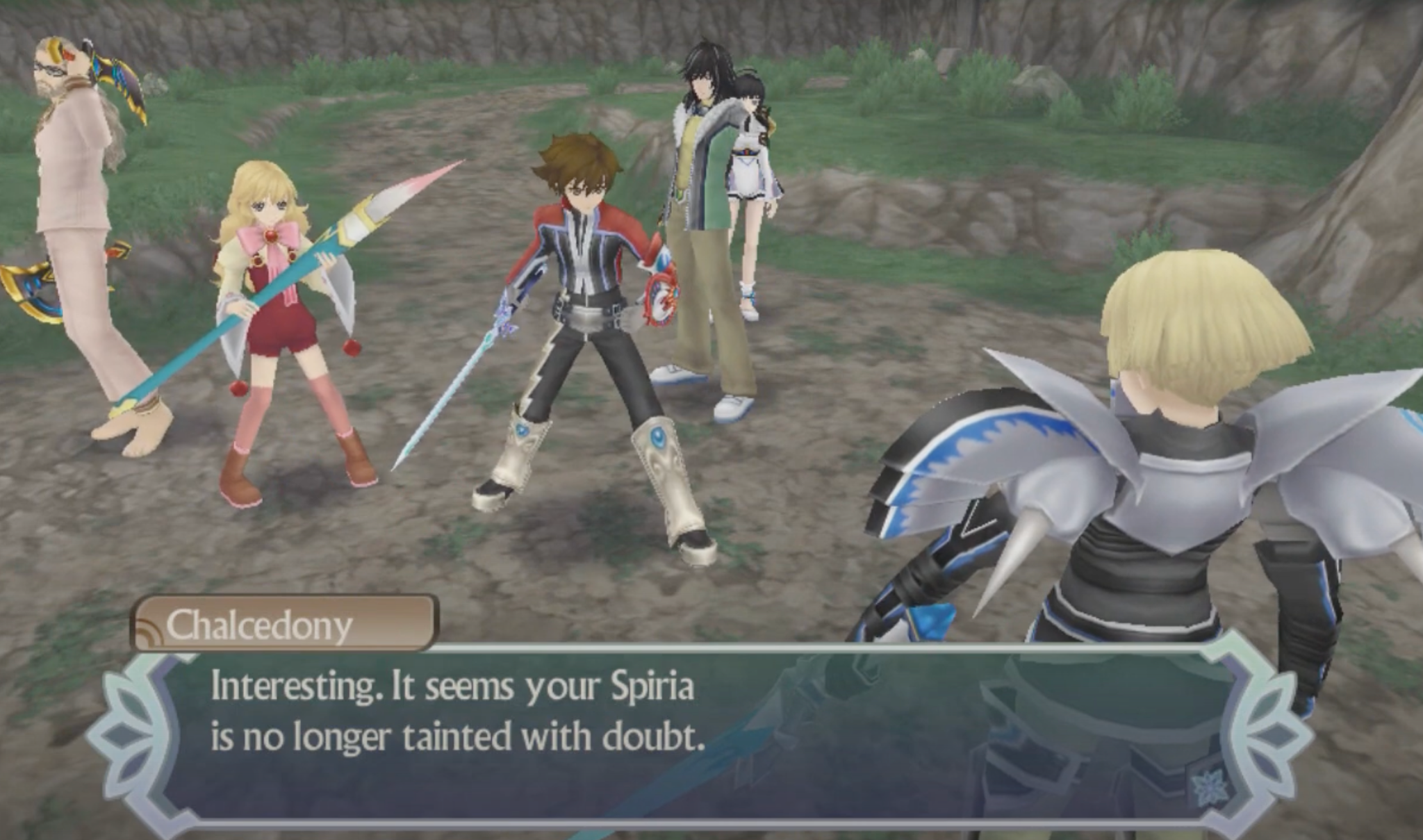
Chalcedony acknowledges Kor’s newfound Somatic resolve when the party intercepts his platoon outside of the Anders Mine.
They don’t yet relate to each other intimately enough to understand that they share this value—Kor applying it to Kohaku, and Chalcedony to Empress Paraiba—but they can recognize Kor’s principle at least as a context through which they can assert their values to each other by testing their Spirias in a duel against each other, as Chalcedony calls Kor to “demonstrate those words with the strength of [his] Spiria.”
Soma Expansion 2: The party’s Spirias next progress, with their Spiria Drive level increasing to 3 and our heroes getting access to their climactic “mystic arte” attacks, after Peridot, Pyrox, and the party knock out Chalcedony and spirit him away from the holy city of Prinseur, standing up for the interests of another Spiria in a moment when that person is unable to stand up for his interests on his own.

Chalcedony consents to the party’s forced removal of him from Prinseur after Kor reminds him of his emotional commitment to Empress Paraiba.
When both the Army of the Maximus Empire and the Valentin Church are prepared to scapegoat and execute Chalcedony for inciting a war by accidentally hurting the Empress with a literal outburst of emotion caused by the influence of Kohaku’s Shards of Dreams and Anger within his Spiria, Chalcedony is ready to submit because of the dogma of his role. The “path of the knight,” as he sees it, is to accept responsibility when called to do so, even if it costs him his life. The party, therefore, is left in the position of reminding him of countervailing interests within his own Spiria: that he “cannot abandon the Empress in her time of need,” and that he must honor the sacrifice Pyrox and Peridot made in helping him escape.
Soma Expansion 3: The party’s Spirias grow, their Somas’ maximum level increases to 12, and their Spiria Drive level increases to 4 once Chalcedony, Kor, Kohaku, and Hisui discover the role of their parents and grandparents in the struggle between Lithia and Creed, exposed by memories buried within the corrupted former Emperor Zirconia. The key to this next step is Kor and Kohaku rediscovering their Somatic bond in the context of their family history, with Kohaku recognizing “the strength of [Kor’s] Spiria” and his “will to live” not merely as a product of their time together, but also as a consequence of the faith of his mother and grandfather that he would carry on their legacy and the strength of their own Spirias.
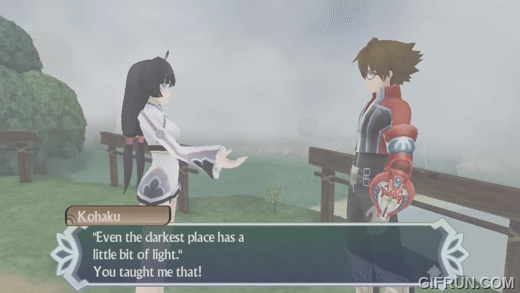
By passing back to him the same lesson which he imparted to her while she was missing her Spiria Core, Koahku reconnects Kor with the faith his grandfather, Sydan, and mother, Kadria, had in him, turning his history from a burden into a source of strength.
The Somatic bond is transformative at this moment because it is an argument for why Kor deserves to live: that the positive value of potential contributions of one Spiria to another always trumps the negative value of potential conflicts created by interpersonal relationships. Thus, it’s a strictly good thing that people like Chalcedony, the Crystal Knight, and Kor, the former host of Creed, are alive and go on living, regardless of the evils that the Valentin Church and Creed have wrought.
Soma Expansion 4: The party’s Spirias further develop and their Somas reach their penultimate level cap, 16, when Chalcedony, empowered by his friends’ model of reinforcing Somatic bonds through the context of shared history, rescues and supports a despairing Empress Paraiba by confessing the truth of how he’s felt about her over the entire history of their relationship: that “since the first day I met you,” he tells her, “I have loved you. This feeling is eternal, existing beyond both time and death—even if my end is delivered at your hand.” At this point in the party’s development, Chalcedony can do for Paraiba with his Soma what Ines could do for Silver only with the help of Kohaku’s Shard of Love: reversing her fusion with a xerom by healing and fortifying her lonely Spiria. The Somatic uses his shared history with an isolated person to fashion his Spiria into an aspect of hers and restore her autonomy, with Chalcedony swearing to Paraiba, “I swear to you, Empress, from this point forward, my Spiria belongs to you always, no matter the distance between us […] If this entire world be your burden, I shall take both you and it upon these shoulders if you but give the word.”
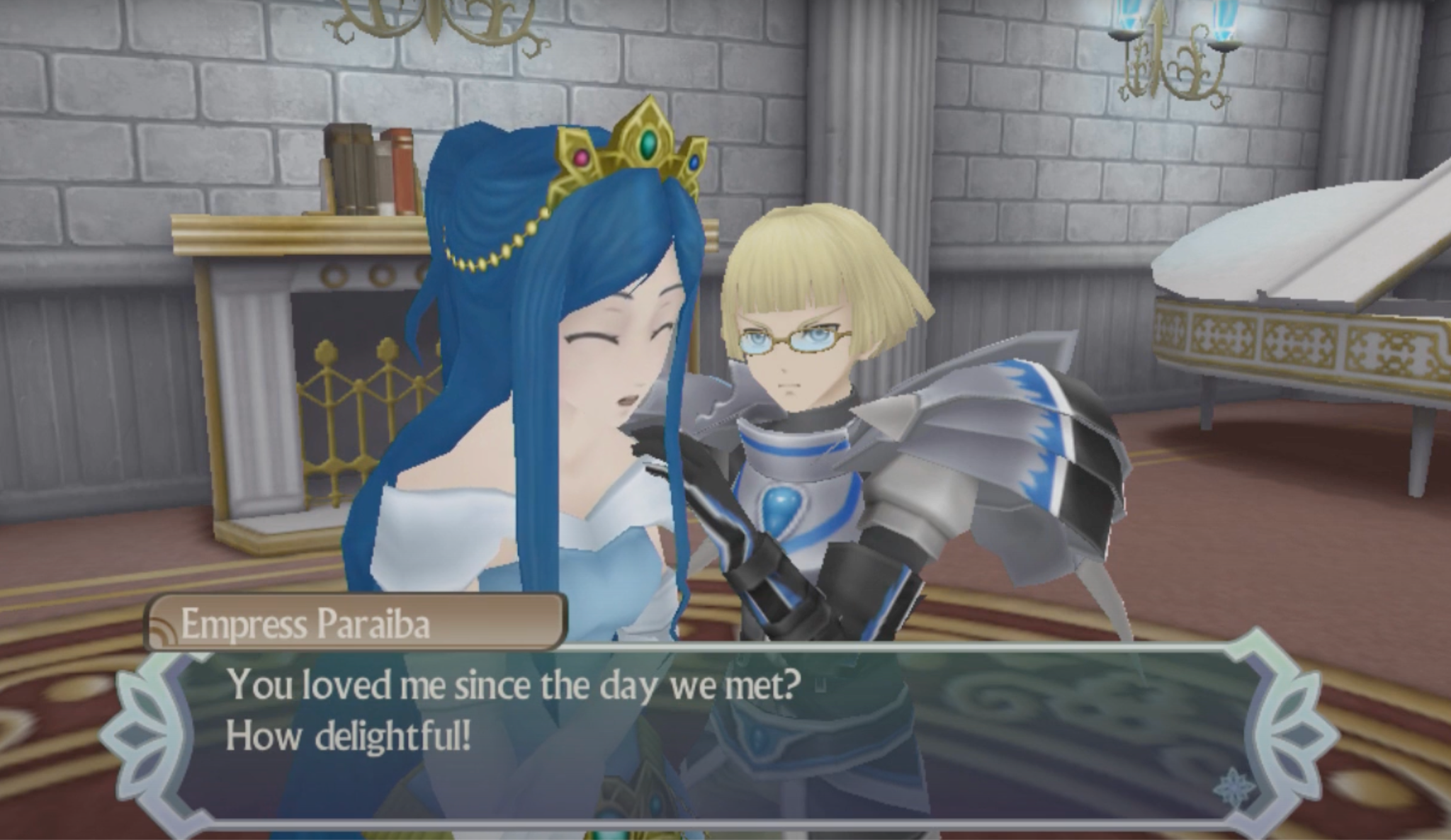
Smiling and laughing, Paraiba is restored from her xeromized form thanks to Chalcedony’s declaration of love for her, reconfiguring their past and present relationship and potential for a broader community.
Chalcedony’s declaration of love within Paraiba’s Spiria Nexus clarifies the meaning of Chalcedony’s identity as a knight to each of them by situating it within their recollections of their history with one another: Paraiba remembers the day of Chalcedony’s birth, when his father asked her permission for Chalcedony to become “a knight, that he might protect [her] all of her days” (as well as the moment when Paraiba changed Chalcedony’s diaper thereafter!), and Chalcedony remembers the day when the young Empress conferred the title of junior knight upon him, years later. With the spiritual content of their Empress-knight relationship reconfigured, Paraiba can draw on her knight’s support to unite the Spirias of those army members, church members, and citizens who were previously factionalized, strangers or enemies to one another. As Chalcedony fortified her Spiria, so she insists to her people in a public address that “[f]eelings for the one most precious to you can light smiles amidst the darkness! Every one of you possesses this power. And if we allow it to connect all of us, then no amount of monsters can ever bring us to our knees!” Not only does she impel the army’s General Grossular and the church’s High Priest Akerman (Chalcedony’s father) to serve at the pleasure of the Empress rather than resenting each other over their organizations’ antagonistic roles in the history of an Empire manufactured by Creed to overtake Lithia and capture Organican Spirias: she also inspires the ordinary people of Straga to collaborate in a way that’s unmediated by her, the party, and the player, a rare and beautiful representation of harmony in a video game. When one soldier says the Imperial Army needs help supplying Organica’s outer towns with provisions, for instance, a townsperson immediately speaks up, “I’m FROM one of those outer towns! I’ll help however I can!”
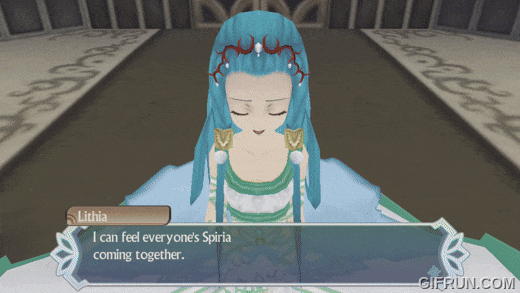
With the church, army, and citizens spontaneously opening their Spirias to each other in the contagious wake of Empress Paraiba’s public address, Lithia collapses, humbled by the sight of her sister’s hope for the world coming to fruition.
This spontaneous connection between strangers forms the basis for the Somatic bond network that emerges throughout Straga in the moments following Paraiba’s speech. Strangers open their hearts to a new conversational context with each other thanks to the model of the Empress, who not only shares her Spiria freely with them, “without fear or surrender,” but also possesses a Spiria that essentially features a relationship with someone else, showing them how to depend on others without thereby walling themselves off from further connections. This evolution, which finally fosters spontaneous Somatic bonding at scale, strikes Lithia as “the single thing our ideal world was lacking,” according to Fluora: that praxis of connection which could only be enacted through individual effort rather than a global, formulaic procedure like Gardenia.
Soma Expansion 5: Finally, the party’s Somas and Spiria Attributes reach their full potential at a maximum level of 20 by freeing the innocent Spirias of alien people from the prison of an artificial Spiria that misunderstands the nature of connection and itself, Gardenia (and, by extension, Creed). The destruction of Gardenia—which we considered above through the lens of understanding and overcoming a nested, derivative, artificial Spiria—takes on a new meaning as the last step in expanding the scope of our heroes’ spiritual abilities. They’ve already experienced what it takes to dive within an unknown Spiria, to understand the Spiria’s place in a historical lineage, to speak up for the interests of its owner even when the owner can’t do so herself, and to extend that Spiria to the loosely related communities it touches; it’s natural that the final test of these abilities would be to liberate and empower a completely disenfranchised community, the Mineran Spirias, by coming to empathize with and spiritually heal the community member whose lack of self-understanding caused that disenfranchisement, Creed.
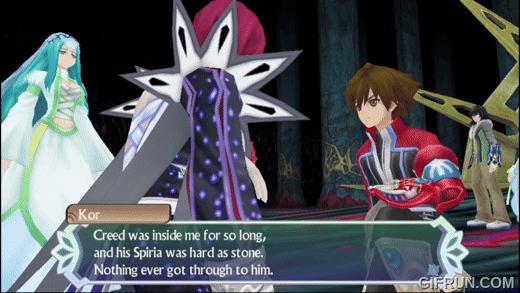
Bolstered by the party’s development throughout the story, Kor finds a way to understand and forgive Creed by empathizing with what it would be like to live entirely bereft of community.
Kor encapsulates this final stage of Somatic development when he finds the words to empathize with someone who seems like he should be conceptually beyond the reach of empathy. The Creed Graphite we encounter in the story’s present day is separated from his countrymen by two thousand years, and from his own emotions by the void of misunderstanding that drives Gardenia. His name crystallizes his symbolism (pun intended): like his surname’s namesake mineral, graphite, he is largely inert, with a rigid and stable internal structure that resists interaction with, or transformation from, outside elements—but, just like graphite reacts violently with fluorine and other strong oxidizers, he ignites with an unbridled and senseless passion in the presence of Fluora, desperately wanting to possess her yet unable to reconcile his nature with hers in a stable configuration. Creed’s inner nature is an emotional contradiction: just as his given name’s source mineral, creedite, is partly constituted by fluoride, Creed’s self-concept is partly constituted by Fluora, her Spiria objectified and imprisoned within Gardenia, despite his inability to recognize her as an autonomous individual and bond with her interpersonally. The only resource he can use to hold himself together is that other “creed”: his dogmatic faith that he can restore one community by using another as fuel, unable to connect himself with either.
But, just as graphite commonly occurs nestled within iron meteorites as nodules, Creed, nested within our own iron meteorite—Kor Meteor, whose unique family combat technique is an arte called Meteoric Iron—spends 17 years as a nodule within the broader structure of Kor’s Spiria. This gives Kor unique standing to empathize with Creed’s total inaccessibility: he recognizes Creed experientially as an unknowable, unacceptable void within himself, and he can empathetically imagine, thanks to all of his other Somatic development, what it would be like if his entire existence were inaccessible to himself and others in this way, as is the case for Creed. Thus, when Gardenia is collapsing and his friends want to abandon Creed, Kor can say, simply and profoundly: “look at him. He’s me. If I was alone. […] Creed was inside me for so long, and his Spiria was hard as stone. Nothing ever got through to him. But that’s why I can’t leave him here to die.” Kor learns how to use his understanding of his inner life to make new relationships possible in the world, simply by uttering an inner truth and thereby introducing it into a community’s shared reality. His assertion that Creed is him gives Creed a relationship that frees him from his curse of inertness—just like his assertion that he loves Kohaku, the final moment of their journey together, transforms the context of their journey into a love story. Such Somatic speech acts enact and alter the bonds between people, which is why—as Kohaku tells Kor when he’s reluctant to make his feelings for her explicit—”Sometimes it’s nice to shout things out loud.” Only after this final insight, at the conclusion of their story in a scene even beyond the reach of the end credits, do the heroes unlock this final, outermost set of levels for their Somas and Spiria Attributes.

In the final moment after the credits, Kohaku gently, but firmly, encourages Kor to shout his feelings for her out loud.
We experience this expansion of the party’s Spiria charts and Spiria Drive alongside a matrix of other unfolding character abilities, illuminating how characters can empower each other in substantively different ways as their Spirias evolve. Characters with expanded Spirias can unlock objectively better skills to give them advantages in combat, and characters that develop stronger bonds with each other—cultivated through shared moments in battle and formative events in their journey across the worlds—can share better skills through those bonds. Mystic artes—the iconic, cinematic attacks highlighting characters’ unique abilities and identity, a series mainstay since Tales of Eternia—are only available after the Spiria Drive’s second expansion, the threshold beyond which characters understand how to use their Somas to advocate for the Spirias of others even in the face of resistance from those Spirias’ owners—the more authoritarian, “knightly” Somatic effort of which Chalcedony is capable even before he joins the party (it’s he, in fact, who teaches the technique to Kor and the others). Dual mystic artes—even more powerful mystic artes that coordinate the techniques and identities of character pairs—are only available after the Spiria charts’ fourth expansion and only to pairs of characters that have developed a maximally strong bond. This last technique is the final gift of Fluora, a way to “increase [their] Somatic strength, so that [they] may stop Creed’s evil scheme […] [b]y strengthening the Somatic bonds between them.” Such an intimately synchronized act of emotional expression is only logically possible once characters have learned how to fortify each other’s autonomy by making their own Spiria a constituent of the other’s (the threshold of the fourth expansion) and come to mutually understand one another to a sufficient extent that they can effect and update this constitutive empowerment bidirectionally, each character stronger because of the other in a positive-sum relationship (the threshold of the maximally strong bond).
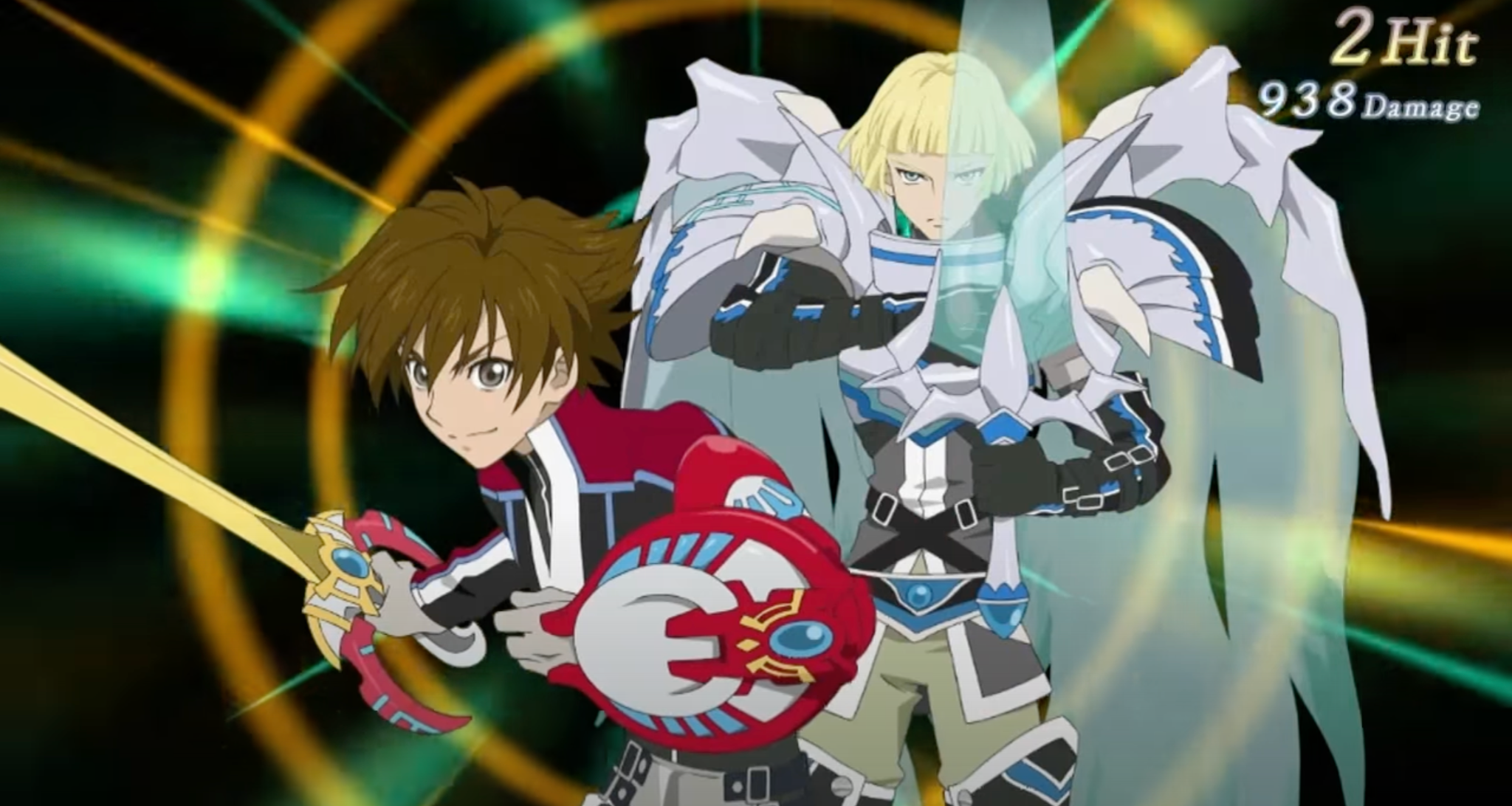
The cut-in for Chalcedony and Kor’s dual mystic arte, “Comrades in Arms.”
So, the basic tool underpinning Tales of Hearts R’s combat system, the Soma, intuitively guides our involvement in the characters’ emotional journeys even before we’ve metaphysically dissected its mechanics. But the brilliance of Fluora’s engineering doesn’t stop there: the Spiria Linking function of Somas implicitly calls us to analyze and intellectually grasp those mechanics, equipping us, and the characters, to intentionally apply that praxis and propagate diverse emotional bonds outward from the game to our broader communities. It calls us to that task by forcing us to make sense of a seeming paradox: Somas aim at facilitating consensual, mutually empowering connections, but there’s something incontrovertibly nonconsensual about their initial form of “outreach” to someone else, the Spiria Link. The conceit of a Somatic traveling into someone else’s Spiria Nexus is to discover and engage with some aspect of that person which they cannot consciously express, and that effort is therefore typically undertaken against the target’s will. From the very first Spiria Link, when Kor dives within an unconscious Kohaku in an attempt to save her from the influence of Incarose’s xeroms, to the very last Spiria Link, when the party enters the heart of Creed and Gardenia against Creed’s multiple efforts to keep them out, the story paints a picture of heroes who must disrupt others unidirectionally in order to open the door to robust, consensual, positive, bidirectional relationships that can network the entire world together.
In the spirit of Wahrheit’s name, Somas reveal truth, but there’s a difference between a morally indifferent conception of truth and a morally rich conception of purity, the German namesake of Chalcedony’s evolved Soma in airship form, Reinheit. So, the emotionally invested player must feel the urge to solve this puzzle: how can a nonconsensual method of personal relationship be a justified means of forming consensual interpersonal bonds?
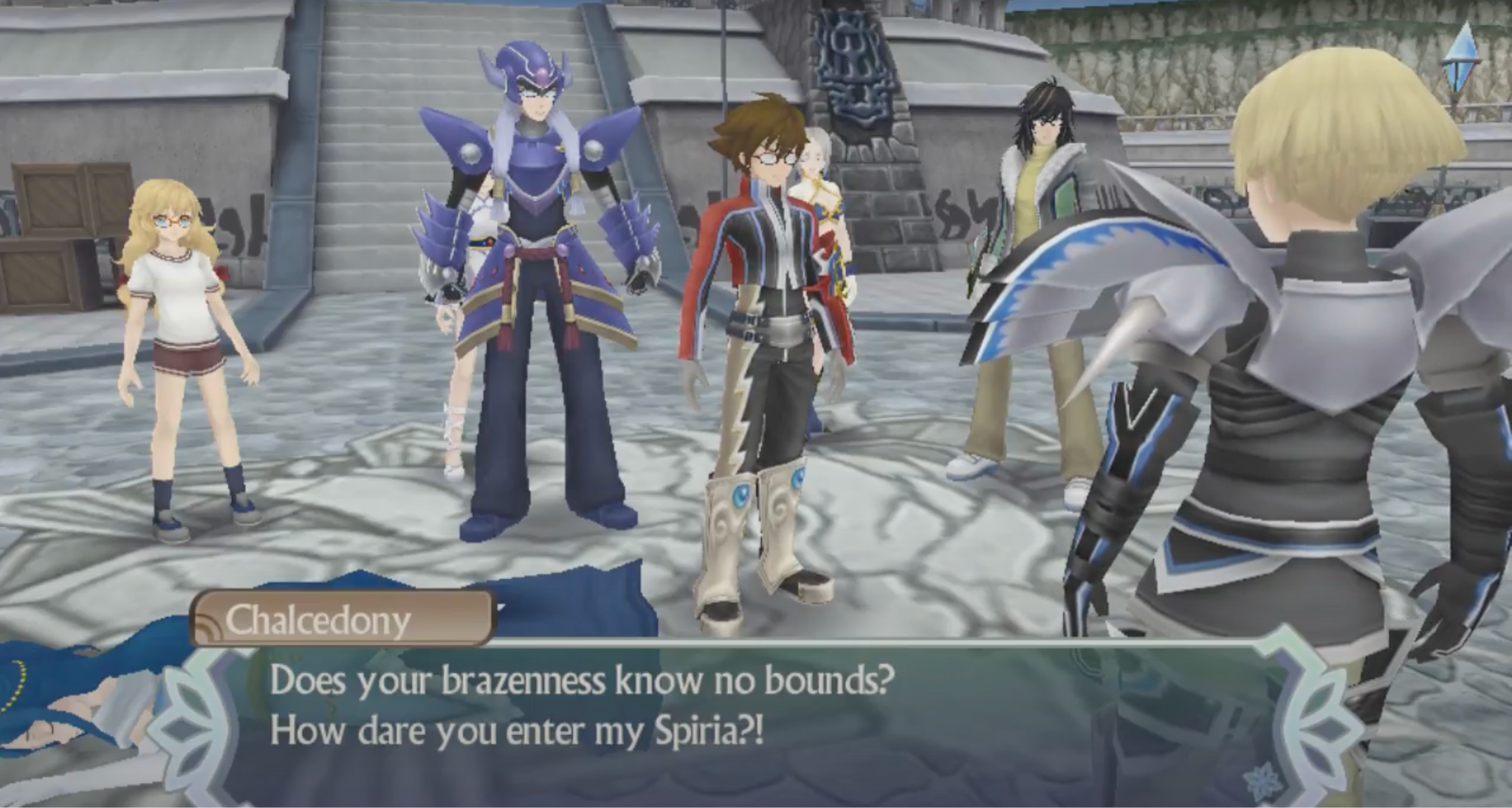
In Straga, Chalcedony chastises the party for their characteristically nonconsensual invasion of his Spiria Nexus, an attempt to rescue him from the influence of Kohaku’s Spiria shards.
We solve this puzzle by discovering the exchange between the hypostatization of interpersonal relationships and the transformation of those hypostatized concepts into models for further relationships—those “chemical reactions” that keep bonds dynamic, taking people into our self-concept and letting them go as the present context warrants. The nonconsensual Spiria Link, it turns out, isn’t an act of undermining the target’s will, but rather of enfranchising it: giving the target a way of reconceiving an internal, static concept that was limiting their capacity to form relationships, refashioning it into a method for the autonomous formation of bonds. Consensual, interpersonal bonds are made possible by the unilateral dissolution of walls from the target’s point of view. What initially seems like a nonconsensual invasion of someone’s Spiria is actually a demonstration that the person in question has unintentionally fashioned an aspect of her community into something like an artifact: something derived from her with a life of its own, rather than something transparently reflecting her connections with others. Once the artifact is shown for what it is, it can be consciously addressed like any other artifact, endorsing a broader network of relationships rather than holding its author captive.
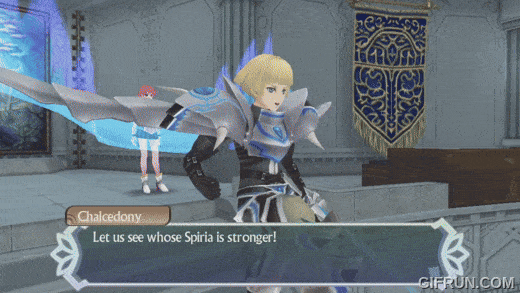
Chalcedony and Kor relish their growing rivalry and camaraderie as they duel for Kohaku’s Shard of Dreams in the Valentin Cathedral.
Somas manifest in different Soma forms, representations with different attributes based not only on the identity of their user (Sydan’s ax becomes a sword when he passes his Soma on to Kor at the start of the game) but also on the interpersonal and intrapersonal experiences that sculpt the user as a Somatic. By analyzing the dynamics that determine the attributes of Somas’ forms, we can uncover the distinct dimensions of relationships that Fluora believes people must study and master to transform solipsistic, hypostatized conceptions of our relationships into tools that open them to new bonds and ultimately unite everyone under a single, globally unified Spiria. The two steps required to transform Wahrheit into Reinheit—acquiring the Xerom Stone from Empress Paraiba and the Flare Horn from Vorgas—symbolically point the way to the two cardinal dimensions influencing Soma forms:
- The Xerom Stone symbolizes that the emotional development of an individual can constitute a context and method through which to advance the relationship of other emotionally resonant, unrelated people, and vice versa, as the reconstitution of Kohaku’s Spiria Core does for Chalcedony and Paraiba.
- The Flare Horn symbolizes that individuals’ historical relationships can spiritually survive into the present by providing models for new relationships, as Lithia’s past does for Dronning, Peridot’s for her platoon, and Tekt’s for Kor.
This is the story of what it takes for Chalcedony to transform from a Crystal Knight—someone who claims shards of others’ Spiria Cores as his own and uses his Soma as a weapon in petty conflicts between the church and army—into the kind of knight who can elevate everyone with the wings of Reinheit. By mastering the same praxis that ultimately empowers the player to span worlds through her emotional investment in Tales of Hearts R, Chalcedony learns how to honor his love for the Empress he’s sworn to protect, along with how to recognize in Kor an echo of the knightly resolve to “win the future” by overcoming Creed—the basis for their dual mystic arte, “Comrades in Arms.”
§2.2: From Individuals to Communities and Back Again: Spiria Shards vs. Mysticete
There’s one crucial exception to the chemical nomenclature we discussed at the beginning of this section: while Minerans, Organicans, and mechaknights alike are named after elements and inorganic compounds, Kohaku’s name is the Japanese word for an organic compound, amber.[6]

Baltic amber with various materials suspended within it from the time of its formation. (Source.)
Like sapphire, amethyst, peridot, and so many others, amber is both a name in Tales of Hearts R and a material that’s often used as a gemstone, but amber is a fossilized form of resin, an organic substance secreted by trees to help heal their injuries: when a tree’s surface is wounded, resin seeps out and hardens over the area, keeping it safe from a range of parasitic organisms like fungi and insects. As it hardens, amber often captures small creatures, debris, and the like, inadvertently preserving the embedded material for millions of years in gem-like form. Thousands of species have been found in modern-day samples of amber, including organisms that couldn’t be fossilized on their own, and therefore wouldn’t have been preserved and known in the present day otherwise.
At first glance, amber might seem antithetical to the model of interpersonal growth we’re constructing from Tales of Hearts R: after all, isn’t “fossilizing” our perspective on a real person exactly the sort of hypostatization that limits our capacity to connect with those people directly? But this is the wrong vantage point from which to look at amber and Kohaku, as if we were Striegov looking only at the immediate aesthetic qualities of Kohaku’s shards. Instead, we need to consider the entire trajectory of amber’s formation: it oozes out from a living entity as a protective mechanism, enfolds other entities within itself, and carries them forward into a future context they wouldn’t otherwise reach. Kohaku’s Core shards are like this: they scatter from her to the four corners of Organica as a protective mechanism, they adhere to entities with which they resonate (entities that are “emotionally proximate” to Kohaku in the way entities preserved in amber are physically proximate to trees), and the context provided by them allows those entities to progress forward into a future of new relationships. They’re a matrix of emotional development that mirrors the mechanic of Chase Link Mode: launching a single character into a focused series of uninterrupted attacks progressing their struggle with an enemy, extending the duration of their effort by answering the call of other party members to call out to them for coordinated Cross Chase Charge attacks that bring them into the leading character’s attack sequence for a tandem strike, bolstering their personal trajectory in a fleeting moment of synchronicity.
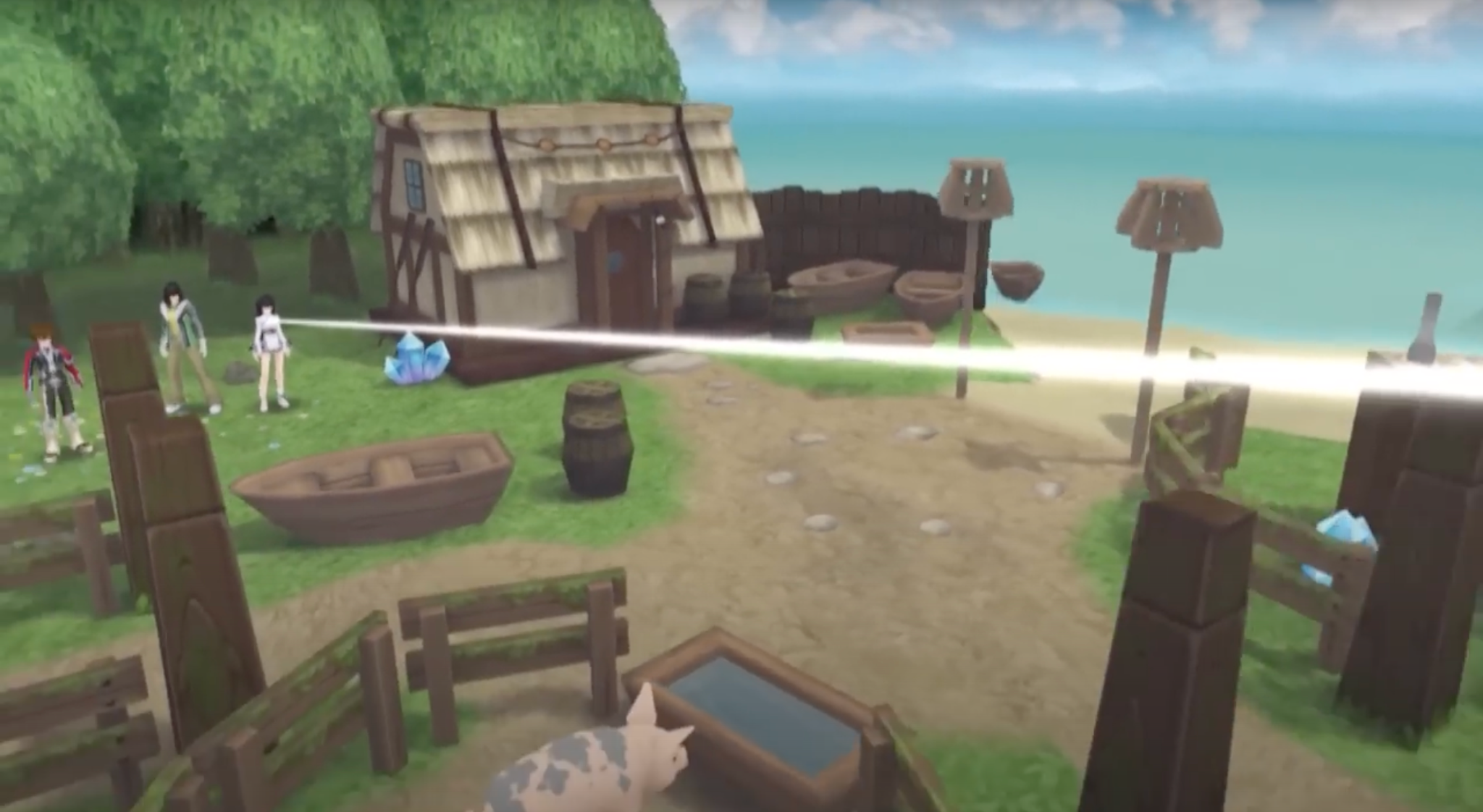
After Kohaku’s Spira Core shatters, a light emanates from her Spiria Nexus pointing the way to a nearby shard, in Cynos.
Kohaku’s shards aren’t just inert emotional residues that lodge themselves within others: they’re the objectives of a mission, reconstituting those they touch as central elements on the party’s journey to put Kohaku’s Core back together. The first third of Tales of Hearts R’s plot is literally and figuratively traced by the line that links Kohaku’s Spiria Nexus to the bearers of her shards, directing her, the party, and the player, to channel their actions in pursuit of those bearers. This conjunction of new context and method of activity allows those touched by shards to renegotiate their relationships through their involvement in Kohaku’s growth, illustrating that the emotional progress of one person can transform others’ relationships in a positive feedback loop. We see that process play out in the following steps:
- A person bearing a shard of a particular emotion hypostatizes that emotion which she feels toward her relationship with someone, substituting that concept for the person himself. She does not represent herself as apt for connection through her actions: her entire decision-making apparatus fixates on this hypostatization, which represents her as connected to the person in the relevant relationship but only limits her actionable intentions to those that relate her to the hypostatization, not to other people.[7]
- To return the emotion at issue to Kohaku’s Spiria, the party engages with that person and her hypostatized relationship, dislodging the shard from the bearer’s Spiria. This activity opens the bearer to the possibility of representing herself as apt for connection through her actions, by involving her in an interpersonal activity directed toward her hypostatized concept and thereby allowing her to act in ways intended to relate her to those other agents even while under the influence of her reified concept.
- By the same token, the activity in [2] contributes to the unified journey of Kohaku’s emotional development, contributing to a self-concept composed of methods for expressing her emotions according to the models of interactions the party and shard-bearers undertook in the initial retrieval of the shard. Therefore, her self-concept intrinsically positions her to act in ways that represent her as apt for connection.
- The bearer who has been freed of the shard and shown how to act in a way that represents her as apt for connection can enact her own emotional journey that emulates the reconstitution of Kohaku’s Core, developing and updating her self-concept by seeking out those whose hypostatized emotional relationships resonate with their own and engaging it along them, just as Kohaku did with them.
Of Kohaku’s 10 Spiria shards, 3 embody the story of Chalcedony and Paraiba, the strongest center of gravity among the shards beyond Kohaku herself.[8] As the knight and the Empress refashion their relationship through the anchor of Kohaku’s identity, they show how this 4-step cycle from hypostatizations to real-world interactions can cascade outward from one person, like Kohaku, to ethically connect the emotions and actions of everyone in the world.
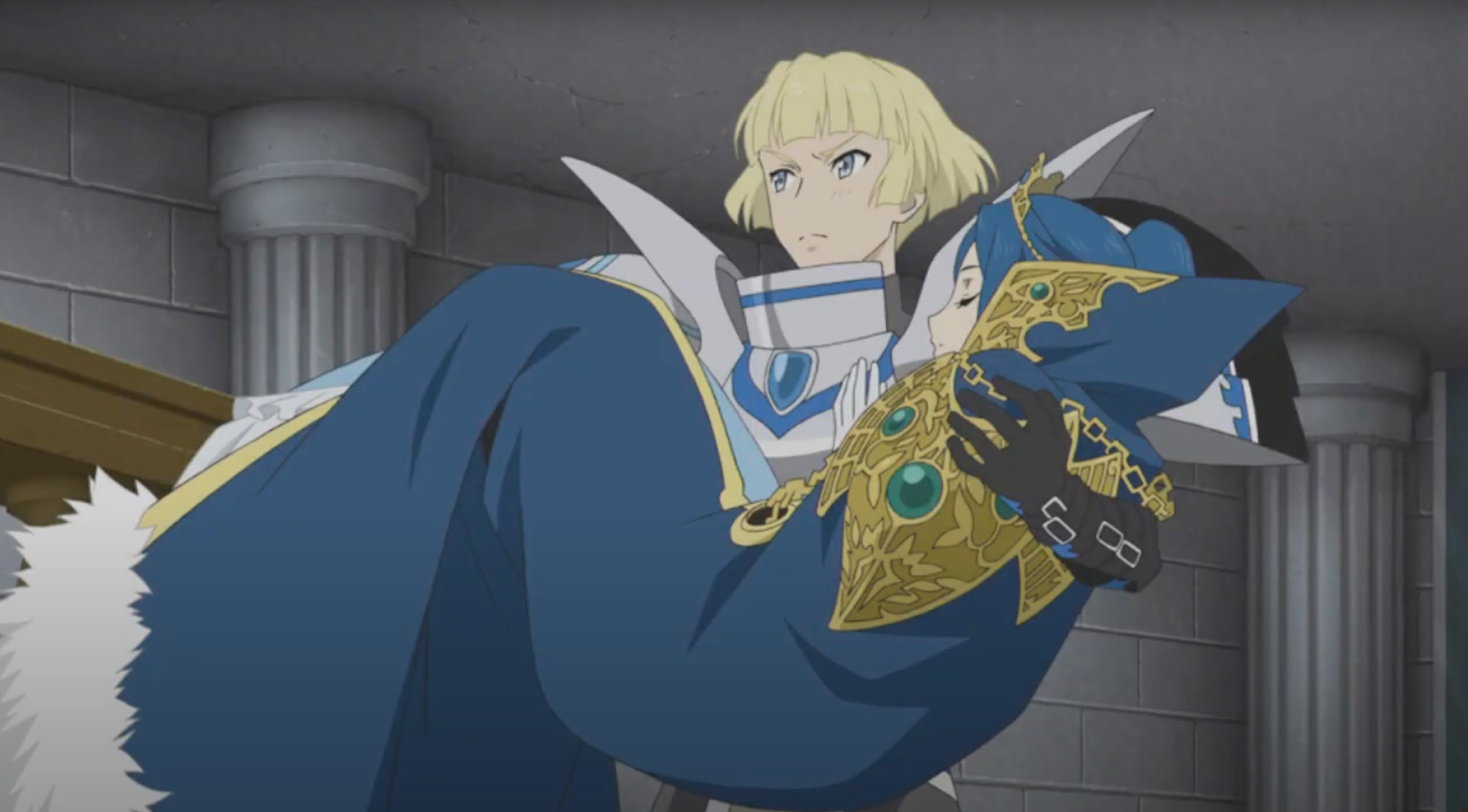
After fully grounding his relationship with Paraiba in reality, Chalcedony can give her the rest she needs from ruling by carrying her to bed: an expression of tender support which his earlier conception of knighthood and her earlier conception of royalty would have forbidden.
Chalcedony and Paraiba encounter Kohaku’s shards at a moment in their lives when they’ve exchanged connections for walls. Chalcedony splits his time between the Imperial capital of Straga—according to Beryl, “a fortress, surrounded by walls both natural and manmade”—and the Valentin Church’s city of Prinseur—according to a local Crystal Knight, yet another “fortress […] with the sea on our sides, our fortified walls, and our Somas” serving as natural defenses against outsiders. Paraiba, meanwhile, is so distraught over losing her relationship with Chalcedony to the pressures of the army and church vying for control over her as an Imperial figurehead that she has retreated from the Stragan palace to her Shoalhaven villa: physically walled off on an island within the town, and spiritually walled off within the thin disguise of “Miss Tourmaline,” deflecting the regal persona that she sees as defining and binding her.
We noted above that the antagonists who claim spiritual ownership over Kohaku’s shards and xeromize themselves go wrong by substituting a constitutive relationship where an interpersonal bond ought to be; in the case of Chalcedony and Kohaku, this short-term deficit actually gives them exactly what they need to rehabilitate and evolve their long-term bond because the shards point to, and force a confrontation with, the deficiencies in their current relationship. This process is a corollary of the dynamics of hypostatization which we studied above in the case of Gardenia and other self-concepts: just as those artifacts give other real people a medium for connecting with the source of the hypostatization (the creator), so can the introduction of new, real person help someone to realize that she has hypostatized her emotions toward an interpersonal relationship, revealing to her that she is engaging with an artifact of her unconscious design where she thought she was engaging with a real person. Once the artifact is exposed for what it is, it can be manipulated or set aside in service of the source’s relationship with the real person she’d inadvertently replaced with a fantasy.
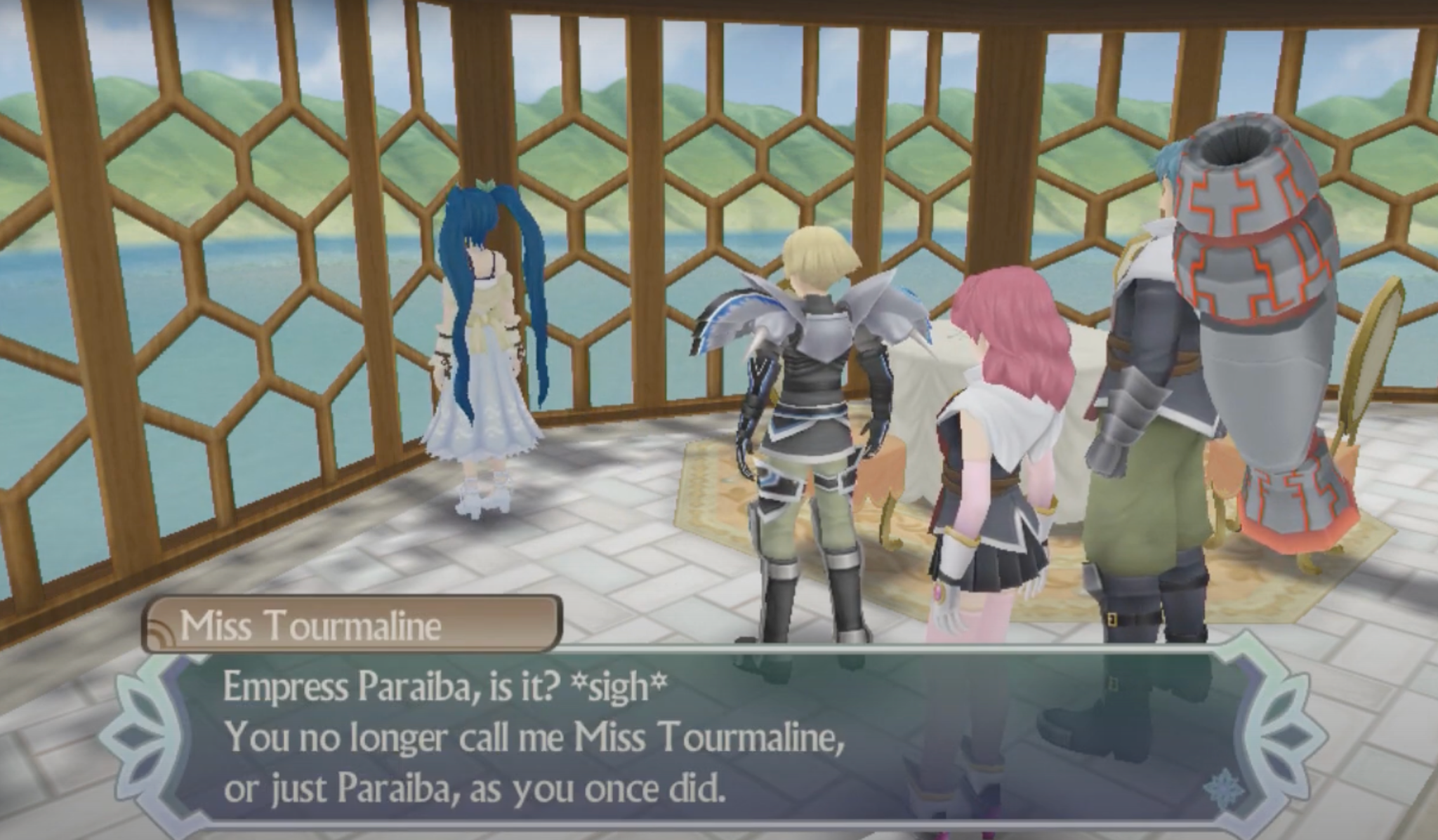
Walled off within her Shoalhaven villa, Paraiba mourns the emotional walls that have risen between her Spiria and Chalcedony’s in the years since their youth.
The sorrow which Tourmaline internalizes from Kohaku’s shard points to her melancholy over the loss of Chalcedony as her love and friend, an emotion which she has reified within her Spiria. She is responsive to the shard because even before it found her, she was already in the throes of conceptually substituting that sentiment towards Chalcedony for the man himself, thereby emotionally walling himself off from him. Meanwhile, the emotional complex of anger and dreams embedded within Chalcedony—the only host to harbor two of Kohaku’s shards at the same time—points to the emotional paralysis Chalcedony has taken to be his “duty,” hypostatizing his dream of building an empire “where the Empress can smile all the time,” along with his rage at two generations of Akermans: his father for bullying Paraiba into a role that didn’t allow her to smile, and himself for being inadequate at making her smile in his role as a knight.
Before the intervention of the shards and the party’s Somas, these emotional barriers are recalcitrant because they complement and validate each other: Paraiba gazes inward at the loss of Chalcedony and mourns; Chalcedony gazes inward at Paraiba’s sadness and loathes himself. But Kohaku’s shattered emotional landscape provides an emotionally oriented praxis with which her friends, the Somatics, can rectify Chalcedony and Paraiba’s bond by putting Kohaku back together. The recovery of Kohaku’s sorrow from Paraiba enables Kohaku to empathize with Paraiba and share in a sorrowful embrace with her. As Ines points out at that moment, “[t]hese tears mean something more.” On my reading, they give Paraiba the support and third-person perspective necessary to see Chalcedony once again as a person rather than just as the manifestation of her sadness toward him, putting her in a position to mourn Chalcedony by directly addressing him, when he arrives at Shoalhaven and saddens her by calling her “Empress Paraiba” rather than “Paraiba,” as he did when they were young.
Once this catharsis resolves, it cascades through the other hypostatizations that Paraiba’s reified sadness once reinforced. By watching Paraiba and Kohaku cry together, Kor gains the standing to compare his feelings for Kohaku with Paraiba’s sadness and chastise Chalcedony for making her cry, forcing Chalcedony’s prison of anger to manifest and become the kind of object which his friend Pyrox, along with the party, can confront and address within his Spiria Nexus. The resolution of this anger, in turn makes it possible for Chalcedony to reevaluate the role of dreams within his Spiria, discovering the thrill of not wallowing in an objectified dream of his loved one’s happiness, but rather using that dream as a motive force within his Spiria and testing that conviction of his own against that of an equally fierce Somatic, in a passionate duel with Kor for rights to Kohaku’s Shard of Dreams.
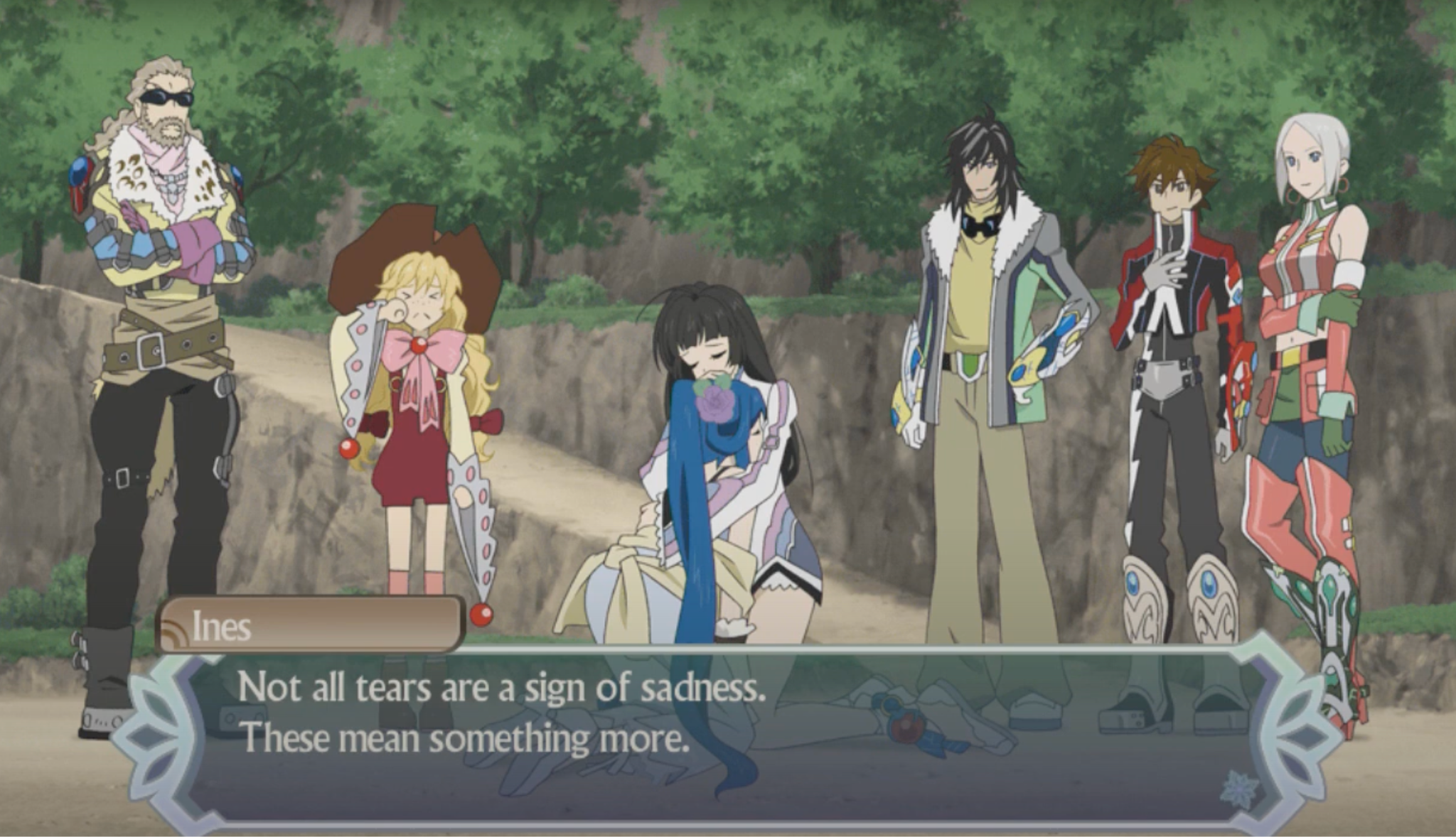
Kohaku’s loving and sorrowful embrace of Paraiba opens the path to an eventual Somatic bond between Paraiba, Chalcedony, and their broader community.
The reconstitution of one individual’s emotional essence opens the door to better relationships between others, and those new relationships resculpt the nature of that emotional essence in turn. Kohaku owes to Chalcedony and Paraiba her ability to distinguish and relate to Lithia, herself, Creed, and Kor individually. When Kohaku first meets Lithia in the flesh following the reunion of Lithia’s Spiria with her body, Lithia expects Kohaku to fear and resent her: isn’t Kohaku scared, Lithia asks, “to see a human with emerald-green hair? One who was willing to kill you to—” Without missing a beat, Kohaku flatly assures Lithia, “Of course I’m not scared! We’ve been together forever! You’re as much a member of my family as my brother is, Lithia! If you feel guilty about what happened, then repay us with your help. […] We’ve been together all this time, and together we shall remain!” Despite having known Lithia as a “spiritual advisor” internal to her Spiria—despite Lithia prompting Kohaku to shatter her own Spiria Core to hide from Creed, and despite Lithia’s willingness to let Creed kill Kohaku and her friends rather than giving him access to Mysticete—Kohaku immediately acknowledges Lithia’s autonomy and the value of their relationship as family members, rather than solipsistically focusing on the role of Lithia in Kohaku’s internal emotional landscape and mourning the loss of her hypostatized, personified inner guidance, and rather than resenting the real Lithia for using her Spiria against her. Kohaku’s acknowledgment of Lithia is grounded in the same respect for spiritual autonomy she extends to Kor in his moment of doubt and pain after being used and discarded by Creed: as Kor laments that his Spiria was merely an incubator for his world’s ultimate enemy since the moment of his birth, exclaiming that “[e]veryone would be better off if I’d died,” Kohaku rekindles their Somatic bond by telling him that “[b]ecause you’re alive, I was able to meet you. And meeting you has made me happy. […] I know the strength of your Spiria—It won’t lose to anyone or anything.”
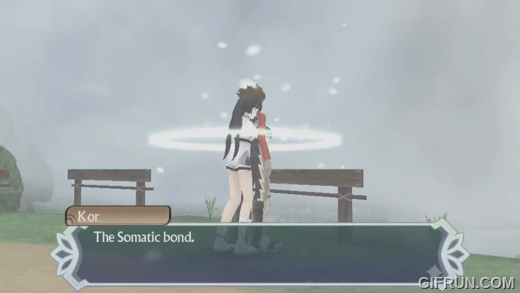
Kohaku’s recognition of Kor’s positive influence on his friends rekindles the Somatic bond Creed had temporarily severed between them.
Kohaku espouses the lessons that her own Spiria shards taught Chalcedony and Paraiba, now relayed back to her reconstituted self: the internalized guidance of someone like Lithia is just an opportunity to cherish the bond with the real person from whom that guidance was sourced; the manipulation of someone’s emotional landscape by a silent, undue influence like Creed is just an invitation to celebrate all of the real connections and positive emotions that person has made possible, regardless of the vacuous nodule that crowded out a part of his heart. Thanks to Chalcedony and Paraiba, Kohaku can impart to Lithia the autonomy and support to make up for her mistakes with future actions, offering Lithia a path to redemption which Lithia can’t even initially see for herself; thanks to them, she sees Kor as a hero who can save Creed, rather than invalidating his existence because of the spiritual deficiency Creed imposed upon his development.
The first of the two materials required to evolve Wahrheit into Reinheit is a Xerom Stone, “a special Willstone that bestows the user with power over xeroms […] [which] can only be produced by Creed”—one of those same stones which Creed fashioned into Incarose’s eyes, sculpting her perspective on the world. The party finds this stone in the form of the Lumifax pendant, an heirloom of the royal family created by Creed to control Xeroms while possessing Emperor Zirconia—a sham jewel belying a real instrument of manipulation, much like the Maximus Empire itself, which Creed formed to surface and capture Lithia, his key to unlocking Gardenia. But the value of the party’s acquisition of this pendant lies in the subversion of this “power over xeroms”: where Creed tries to exert his will by pruning people’s Spiria and siphoning their vitality into the hypostatized, artificial flowers of xeroms, only to further sequester himself away in a bitter and brittle spiritual void, Chalcedony borrows the pendant from Paraiba after using his identity as a knight to bolster her Spiria and save her from xeromization.
Where xeroms sever their victims’ connections by fixating them on an artificial projection of one aspect of their Spiria, Chalcedony and Paraiba now know how to use artificial projections as a means of fostering connection. Those who’ve been brought into a new community thanks to the involvement of their hypostatized relationships in someone else’s emotional development can pass that same salvation on to others, offering “shards” of their own emotional life as a vantage point to forge new connections between those beyond themselves. The symbolism of this practical evolution is clearest in Chalcedony’s progression from his return of the Shard of Anger to his return of the Shard of Dreams: where the first shard literally and figuratively crippled him until the party and Pyrox went within his Spiria to force a communal engagement with his hypostatized conception of Paraiba, the second shard is something he self-consciously sets as the stakes for an honorable battle between his platoon and the party—a real, consensual interaction rather than the nonconsensual invasion of a Spiria Nexus. Once Chalcedony sees how the activity of others can pull him outside the limitations of his perspective, he can use that same kind of hypostatization—another of Kohaku’s crystallized emotions—as a context for two communities to use their dreams to communicate with each other, facilitating another version of the interpersonally productive combat we analyzed in the case of our heroes defeating xeromized entities.
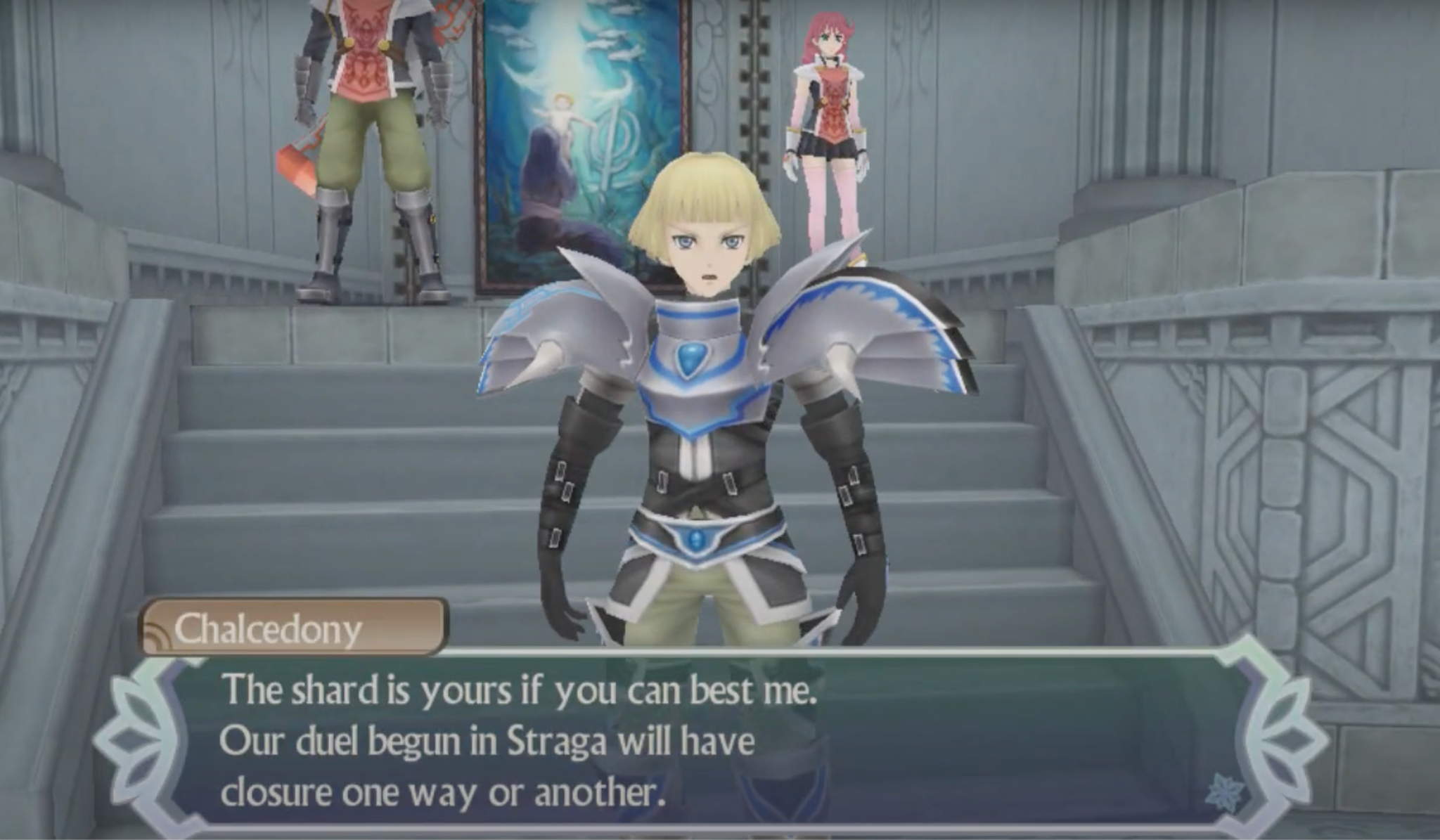
Rather than requiring the party to unilaterally rescue him from the shard via Spiria Link, Chalcedony directly offers it to them as the stakes of a straightforward, honorable duel in Prinseur Cathedral.
Once individuals like Chalcedony and Paraiba are not only freed from their fixation on their hypostatized relationships but also thereby shown the method for connecting with others through collaborative engagement with those hypostatizations, they’re able to extend that method across space and time, inviting more people to authentically bond with each other and proactively interrogate subsequent conceptions of relationships that form as time goes by.
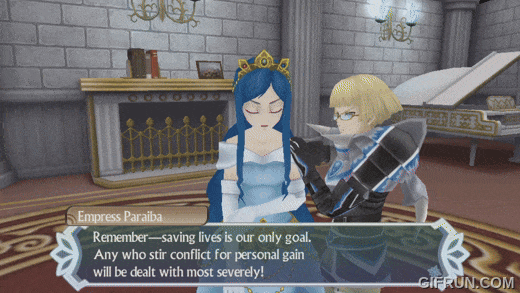
Empress Paraiba, bolstered by a new bond with her knight, calls General Grossular and High Priest Akerman to action, reconfiguring their relationships with her, each other, and the Maximus Empire.
Once Chalcedony fights his way through Paraiba’s xeromized Pining Veronica form, he’s able to finally overcome their solipsistic sentiments about each other and replace them with a new conception of love to constitute and fortify each other’s Spirias, informed by active conversation about how each of them interprets Chalcedony’s lifelong service to Paraiba in the knight/Empress relationship as an expression of their more basic, role-agnostic bond with each other. With the emotional trajectory of Paraiba’s life reconceived to represent her as connected with others, the continued emotional progress of her life can involve those who are contextually related to her in the forced disruption of their own hypostatized relationships, turning Paraiba’s development into the same kind of emotional model that Kohaku’s was for her, Chalcedony, and the other shard-bearers. We witness this in the moments after her restoration from xeromization when she issues new orders to General Grossular and High Priest Akerman. Consistent with her intention to lead the Maximus Empire with a firm hand yet gentle intentions, she reinforces to the leader of the army the value of “follow[ing] orders,” and to Chalcedony’s father the value of supporting ordinary citizens in need by “bandag[ing] [their] wounds” and “distributing bread” regardless of the Crystal Knights’ loss of their Somas to the Imperial Army. This transmission of Paraiba’s values and intentions presents the opportunity for a Spiria Link with Grossular and Akerman, allowing the party to undertake another iteration of their journey to restore Kohaku’s shards:
- The bombastic general opens his Spiria Nexus to the party to exhaust them with reminiscences of his war stories, processing and tempering his need to feel recognized for the former glories he achieved in the name of “following orders.”
- Chalcedony’s father uses the context of the Crystal Knight’s “destroyed Somas” in his Spiria Nexus to confess the pain of his failure as a Somatic and a husband to his son, finally admitting the story of how his Soma broke in the wake of losing his friends to Creed and Incarose. This opens the door for his son to offer himself and the other Crystal Knights as support to bolster his father’s Spiria, just as he did with Paraiba.
This shows us in microcosm the mechanism at work in the global, contagious Somatic bond that erupts following Paraiba’s address to Straga when she resumes her responsibilities as Empress: by empathetically looking to the emotional journeys of others to dislodge our interpersonal misconceptions and then using our newfound representational awareness to involve others in our individual emotional journeys, we network together more and more people who not only represent themselves as apt for connection through their actions, but also connect to wide and deep communities through those actions, scaling and harmonizing their emotions in the process.
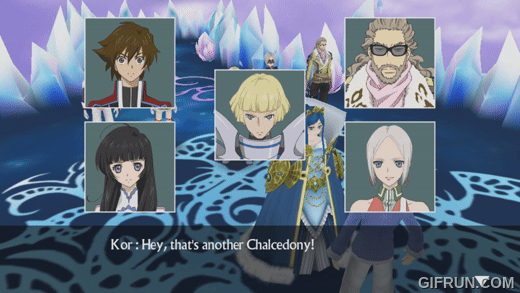
Chalcedony and the rest of the party discover Paraiba’s embodiment of her feelings toward Chalcedony within her Spiria Nexus as she overworks herself in a misguided pursuit of her duty.
But establishing a global Somatic bond isn’t enough: to carry those bonds into the future, the Somatic must routinely reassess how her further emotional development relates to the interpersonal concepts that have taken hold in the Spirias of those with whom they’ve bonded, keeping those concepts communally contextualized and preventing even positive hypostatizations from promoting solipsism. Chalcedony enfranchises Paraiba and cures her xeromization by making his knightly love for her making constitutive of her Spiria, representing his emotions for her within her own Spiria Nexus as a means of connecting her to her community as an Empress, rather than isolating her from them. That intertwined, essential emotional support is progress for Paraiba’s ability to represent herself as apt for connection through her actions, but it’s not the conclusion of her growth, nor even of her relationship with Chalcedony. After Paraiba addresses the Stragan citizenry, loans the party the Xerom Stone, and resumes her imperial duties, the player can later bring the party back and check in on her at the palace. If she does, the party finds Paraiba upon her throne completely exhausted, unwilling to step away from her work even for a moment. To discover the source of her spiritual imbalance, they Spiria Link with her and find a representation of Paraiba gazing adoringly at “an embodiment of [her] feelings toward [Chalcedony],” a spiritual fixation on that support which Chalcedony has provided to her Spiria—one of the most literal, vivid cases of hypostatization in the game. As Gall remarks, “when a Spiria becomes dependent on someone else, only bad can come from it”; Ines adds, “It’s allowing her to keep all her complaining locked up deep inside.”
Paraiba’s renewed retreat into solipsism illustrates how quickly our Spiria’s representation of someone can drift from our actual bond with them, corrupting our emotional decision-making so we no longer act in ways intended to relate us to others. But Chalcedony’s response shows how the emotionally free and transparent bonds we maintain can make it possible for those we care about to notice that drift and proactively correct it, if only they keep us connected to their emotional journey. Such an act of correction can be as simple as Chalcedony drawing the Paraiba’s attention away from her projection and towards his actual person by reminding her that his oath to support her will remain regardless of her complaints or shortcomings: “[b]ecause I am the knight of Empress Paraiba, whose humble heart yet knows of human weakness.” It’s a correction that’s possible because of the network of perspectives and support Kohaku’s Spiria has effected: within the Empress’s Spiria, it’s Kohaku who explains what’s going on with Paraiba’s hypostatization of Chalcedony, and her fellow party members (Gall and Ines) take the lead in explaining to Paraiba and Chalcedony why Paraiba mustn’t retreat into isolating her Spiria through her inner feelings for him.
It’s crucial to the illustration of this method that it’s optional to return to the palace, check on Paraiba, and further update her Spiria’s concepts. As with Kohaku’s Core shards, we can engage with Paraiba’s hypostatizations and reinvolve her in a community by making her a part of Chalcedony’s continued development. We check on her out of interest in Chalcedony’s further growth as a knight and as Paraiba’s beloved, intended partner; we’re rewarded for this effort with a new Soma form for Chalcedony, the Rose Bouquet, a new mode of agency born from the knight and his Empress developing the basis for sustaining a lifelong relationship.
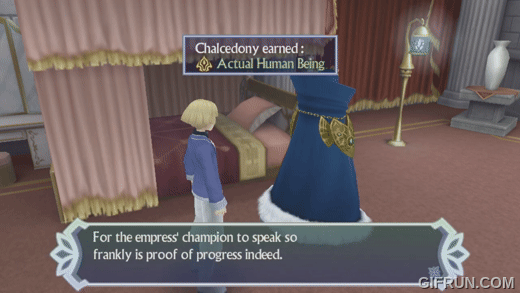
In the culmination of Chalcedony’s Somatic bond with Empress Paraiba, a knight evolves into an actual human being and awakens a Soma that honors their final, authentic love.
This Rose Bouquet, the most honest expression of Chalcedony’s love for Paraiba, only awakens within him after he encourages her to embrace her weakness so that he can better support her, earning him the title of “Actual Human Being” in recognition of this authenticity. In this regard, it symbolizes the praxis of bond cultivation between contemporaneous individuals and communities: by developing new, emotionally grounded agency in ourselves through empathy with others on an ongoing basis, we can facilitate a high-velocity cycle of (1) conceived relationships that support modes of action that connect the agent to others and (2) disrupting those conceptions once they’ve been hypostatized. And there’s no reason to suppose that this process is finite or unilateral: after the conclusion of the story, we might well suppose that Paraiba would soon have reason to look to her own continued development, look to Chalcedony in that context, and help him to dislodge a quickly solidifying and stagnating conception of their relation in favor of something new. It’s the chemical dynamics of “actual human beings” channeling their energy into ceaselessly traveling back and forth across the membrane of their outer and inner lives, trading the roles of Kohaku and her shard-bearers in turn.
Fluora dreamed of equipping people with Somas to bring all people together under “a single, unified Spiria.” This, Kunzite tells the party, is “the original purpose of Somas”: connecting Spirias through Somatic bonds such that Somatics can feel the emotions of one another, fostering, in the limit, an emotionally continuous world in which everyone perpetually grasps the inner lives of everyone else. But while Fluora gave humankind the tools to forge robust interpersonal connections, there’s an important sense in which she got the mechanism wrong: like Creed, she tried to change the nature of people’s Spirias from the top down, rather than from the bottom up. Creed went about this in his attempt to edit the content of Spirias using Gardenia; Fluora uses Mysticete, the giant artificial Spiria and Soma in the shape of a winged whale, to attempt the mass formation of Somatic bonds between people.

Mysticete flies across Organica, with Minera and Gardenia looming overhead, in the title art for Tales of Hearts R.
Striking set piece though it is, Mysticete doesn’t work: the Seraph brothers’ memories show the early failures of Mysticete to do its job, and the final puzzle which Corundum eagerly plans to solve upon the conclusion of the game is “why Mysticete’s incomplete Somatic-bonding function was invoked”—why the party, in other words, was able to facilitate the Somatic bonds that Mysticete never could. Corundum doesn’t discover the explanation for this phenomenon before the end of the game, but our analysis answers her question: one single, giant Soma, generically directed at everyone at once by the artificial Spiria of the largest animal known to man (as well as Mysticete’s namesake), is antithetical to the way interpersonal bonds form. As misguided as it is for Creed to “fix” everyone by subsuming them within his loneliness, it’s equally misguided for Fluora to “fix” everyone by unilaterally extending her love to them. Her approach evokes her namesake, fluorine: facilitating reactions with virtually every substance it comes into contact with, yet diffusing nebulously and ineffectually, like toxic gas.
Sustainable interpersonal bonds arise through fleeting, intimate moments of making someone your entire focus and forcing them to look beyond their emotions to the grounds of those feelings in the moments they’re least willing to do so, diving into their Spiria Nexus in a Spiria Link. A global Spiria arises not from a universal, undifferentiated effort to facilitate reactivity, but rather from the contagious network effect of these many individual “someones” reaching out to others in their community and paying that same kind of focus forward.
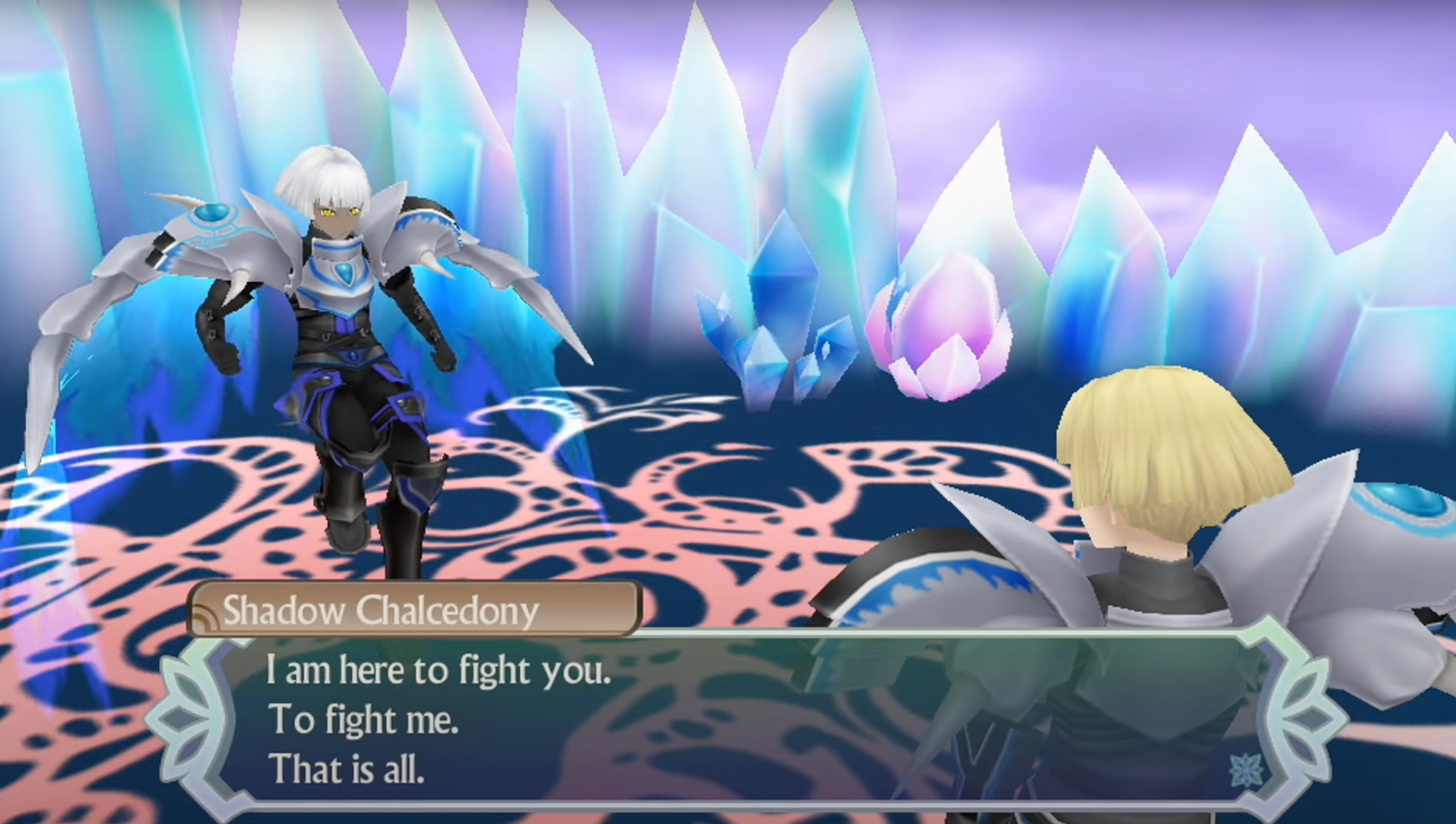
Shadow Chalcedony challenges Chalcedony to a duel within his Spiria Nexus, rewarding his victory with the Zukunft Soma form and the “Know Thyself” title.
Such a spiritual network rejects the choice between the community and the individual, offering a third path that was invisible to Fluora, who sacrificed her individualism for the sake of the global community. For at the very same moment that Chalcedony has completed his journey to embrace his beloved Paraiba, save the world from Creed, and chart new paths for the Empire and the party, he also thereby has the opportunity to journey into his own Spiria Nexus (within the interdimensional medium of the Triverse Gate) and confront “Shadow Chalcedony,” an aspect of himself who confronts him in a duel simply to bestow a new Soma form upon him: Zukunft, looking to his future with its German name, and growing in strength—his Spiria’s strength—with every further enemy, every xerom, defeated. With this Soma form comes a new title, “Know Thyself,” which reminds him to take his self-knowledge and look in that forward direction: its description reads, “Proof of having overcome one’s dark side. The past is past. Let it stay that way.” This is the pinnacle of the feedback loop between the individual as an emotional model and the individual as a shard-bearer: after developing sufficiently robust and responsive bonds with others, individuals can acquire the agency to turn this entire method inward, interrogating, disrupting, and updating hypostatized self-concepts in the way an emotionally stunted person like Creed never could. The more mindfully we can structure our own Spiria in this way, the more deliberately and empathetically we can motivate our further development, which we’ve seen makes us more useful to those in our communities—and so the cycle begins again, stronger than the last.
§2.3: Historical Bonds: Dronning, the 13th Platoon, and Tekt
When the party takes Lithia to see the Will wisps at Guz Spa, she reveals to them that Fluora modeled Somas after these “[s]pirits that resonate with Spirias”: “[i]f someone has good, beautiful thoughts, the Will wisps shine all the more.” This points to how Somas can convert the emotional content of one person into an emotionally transformative lesson for someone else—but those wisps at the Guz Spa, shining forth year in and year out, also symbolize that Somas can transmit spiritual insight and connection intergenerationally. The progress of individuals and communities from the present into the future doesn’t capture this latter dynamic: how can the people and relationships of the past, absent and immutable, contribute to present and future communities without entailing the exact sort of isolating hypostatization that grips Silver, Creed, and so many others?
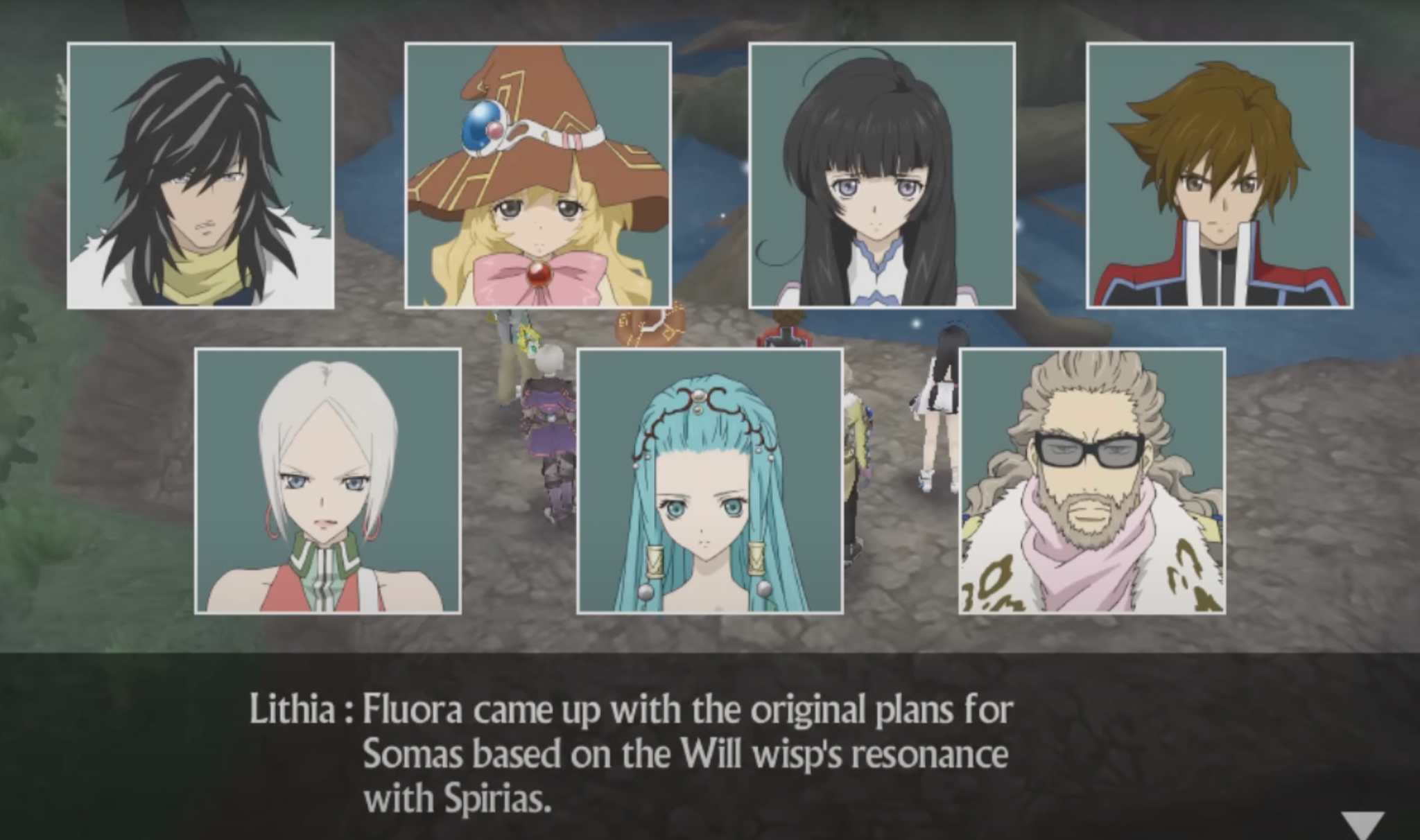
Long after the party’s first encounter with the Will wisps, Lithia transmits their role in the history of Soma development to them—a microcosm of the Somas’ ethos of intergenerational bonding.
This is the second half of what it takes for Wahrheit to become Reinheit: Chalcedony must learn how his Soma bonds him to others through history. The key to this is transmitting the networks of past relationships into the present rather than trying to keep specific people from the past alive in the present. A bond is an activity, and we can maintain or forge bonds with those no longer here by using the structure of their communities as a model to guide the formation of new connections that reach beyond them. We’ll see what it takes to formulate and use historical bonds in this way in three stages, through three complementary cases:
- Lithia and Chalcedony’s joint defense of Dronning shows Sapphire how to turn her conception of her deceased sister, Iola, from a hypostatized memory into a model of community.
- Peridot’s analogy between her deceased brothers and current platoonmates in her dying moments transforms her current relationships, empowering her platoon to make otherwise impossible choices by drawing similar analogies between their separate communities.
- Tekt’s dialectical reinterpretation of his past alongside Kor equips them both with new forms of interpersonal agency in the present.
Once the Somatic grasps this method, she can bring historical relationships of her own into the present-tense feedback loop between individual growth and communal relations, and she can show those with whom they’re bonded how to do the same. In so doing, the grand, unified Spiria Fluora envisioned can extend from those living to all those who came before.
In exactly the same way that Lithia enfranchises Kunzite by showing him how to use her connection with her as a model for bonding with others, she enfranchises Kohaku and Hisui’s Aunt Sapphire by showing her how to use her connection with their deceased mother as a model for bonding with others. This is so, Tales of Hearts R tells us, because our relationship with our past is like an artifact’s relationship with its creator: the difference between it empowering and inhibiting us is whether or not it gives us ways to connect ourselves with those beyond it.
The name of Chalcedony’s Soma, Wahrheit, isn’t uttered during the party’s journey until after Creed has revealed himself, leaving Kor’s Spiria Nexus, and after Tekt—through the broken Spiria of his father and former host of Creed, Zirconia Tourmaline—has revealed to them the role their parents and grandparents played in the struggle against Creed. By that point, our heroes have witnessed that this Soma was wielded by Kohaku and Hisui’s mother, Iola, who housed Lithia and led a faction of rebels within the Valentin Church against the Maximus Empire—and against the Emperor Zirconia, during his time as Creed’s vessel. Once the party rescues Chalcedony from the army’s clutches and plans to travel to Kohaku and Hisui’s hometown of Dronning as a way of Spiria Linking with Mysticete, a desperate bid to halt its warp to Gardenia, Hisui reveals that their town’s existence is a secret because it follows “the old Valentin faith,” considered heretical by the orthodox church. Chalcedony’s response to Hisui that “[w]e Crystal Knights have long treated your kind as heretics” prompts Hisui to bluntly point out, “Well, here’s another fact for you: That Soma you’re slinging? Wahrheit? It was Ma’s until the church took it.” Like the party, and like Dronning, Wahrheit depends on its history for its power, but only as a means of giving its current user the agency to channel strength through a network of his own.

The party observes the massive natural Willstone in Dronning, the source of its anti-xerom barrier and a symbol of Iola’s love for her community.
Dronning is a testament to the dangers of hypostatizing the identities of a Soma’s previous users: the very nature of the faith they practice hides them away from the present context of the world in favor of reified figures from their past. The game isn’t explicit about the distinction between “orthodox” and “heretical” offshoots of the Valentin Church, but it implies that the difference lies in whether or not they deify Lithia. When the party reaches Dronning and meets Kohaku and Hisui’s aunt, village elder Sapphire, she hails Lithia as “the true symbol of the Valentin faith, and the goddess and exalted creator of this very village.” In contrast, Chalcedony’s father, the leader of the orthodox church, seeks “the power of Lithia” in an authoritarian and instrumentalist way to overcome Creed, having seen the extent of the havoc Creed wrought on the Orgainican world in the days when Emperor Zirconia shattered Iola’s Spiria and subsumed human communities under his “Maximus Empire.” Taken as a god by the followers of Iola’s faction of the church and the citizens of Dronning following Iola’s death, Lithia became an inert symbol rather than a real person who could cultivate bonds on her own terms.
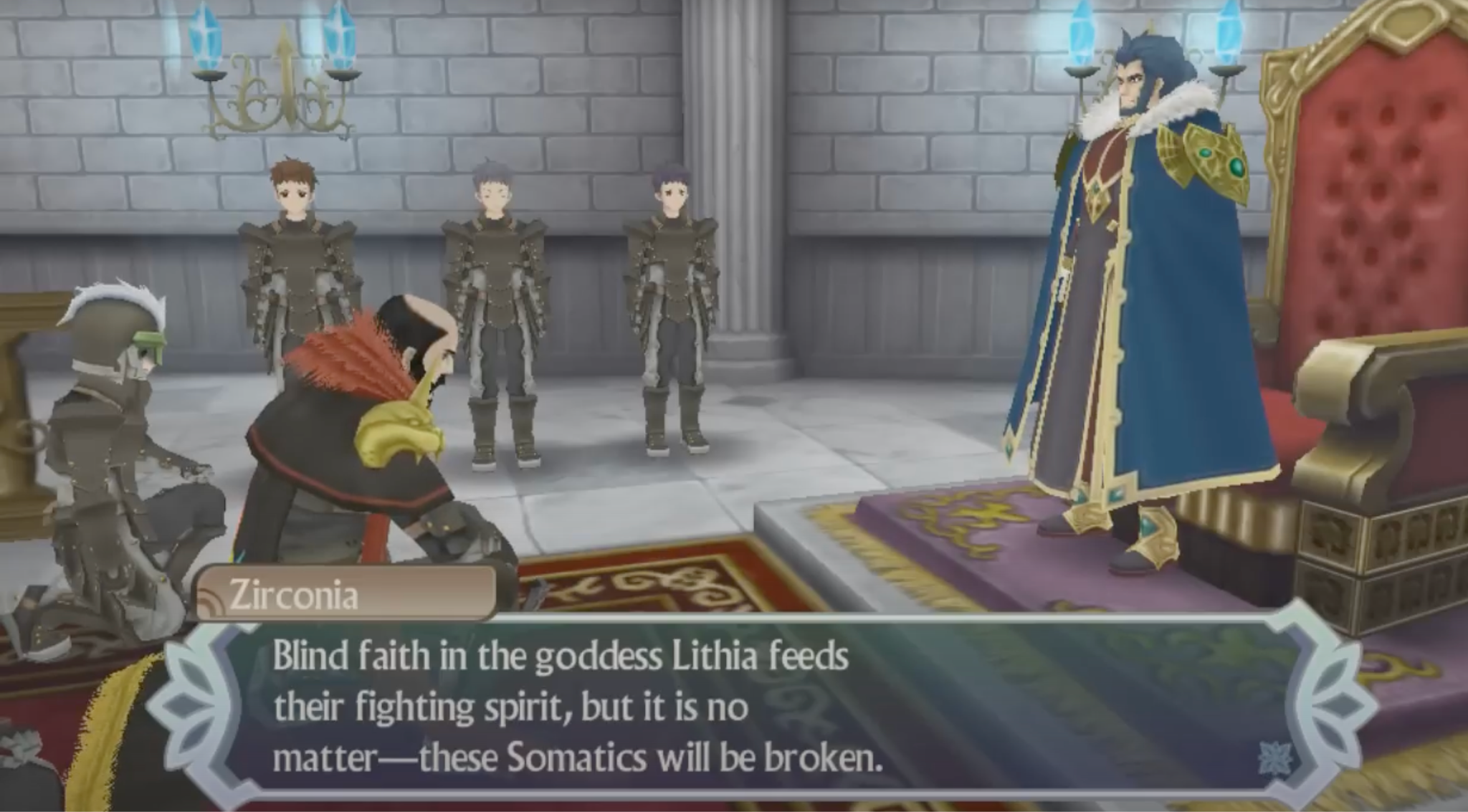
Creed, using Zirconia as a mouthpiece, discredits Lithia as a goddess as he prepares to defeat her followers.
In the eyes of these old-faith practitioners, the beloved figures of the past live on as sanctified relics that constrain their community rather than enfranchising it. Dronning came about as a town after a pregnant Iola—with her Spiria Core shattered by Creed in his last battle against her and her friends, and Lithia traveling in the yet-unborn Kohaku’s Spiria Core—sought refuge from Creed’s forces and a snowstorm in the warmth of a giant Willstone. “It was in this warmth,” Lithia tells our current party when they reach that Willstone, “that Kohaku came into the world and Iola passed from it, [after which] a great barrier materialized from the Willstone,” shielding Kohaku, Hisui, and Iola’s followers from xeroms. In the wake of this seeming miracle, Sapphire equates the Willstone with her late sister: she insists to Iola’s children that the Willstone “encapsulates [their] mother’s hope for the future”; in her eyes, it is “Iola’s legacy,” and the barrier is “nothing less than the love she left behind” for the townsfolk. So total is this identification between Iola and the static Willstone that the very incantation which townsfolk must utter to pass in and out of Dronning across its barrier is “Iola”: to engage with the secret village at all, visitors must tacitly affirm that Iola is the Willstone.
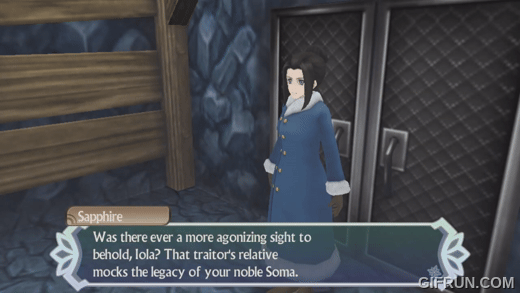
Sapphire quietly resolves to return Wahrheit to its “true resting place.”
Ironically, Sapphire’s reification of her sister’s final acts begets a cult of Lithia that lacks the exact autonomy which Lithia gives Kunzite as his master: her unintentional fashioning of her sister’s legacy into an artifact prevents her from acting in ways that extend her sister’s values to anyone new in her life, beyond Iola—just as Kunzite feared that all his actions derived from his programmed attachment to Lithia until she showed him how to extend the values of his bond with her to others. This doesn’t prevent Sapphire and others in Dronning from taking actions that represent them as apt for connection, but it places a more insidious limitation on their agency: it prevents them from taking actions that intend to relate them to anyone outside of their existing network. That comes about because Dronning constructs a kind of closed, tautological feedback loop with their concept of Iola: they fashion her into a hypostatized concept to house a particular value system by which to rally the community together—Sapphire’s belief, as she tells Iola’s children, that their mother “long desired nothing more than this village’s peace”—and then, because the community was rallied together by that value, they look to it as the decisive guide for their actions, shunning those outside of the community to which the value referred in the first place. The practical reasoning of Dronning, then, entails exactly the kind of isolationism we see reflected in its hidden, xenophobic social architecture. With this practical restriction in mind, it’s entirely unsurprising that Sapphire would have named Kohaku, Iola’s actual flesh-and-blood daughter, after another object in Dronning: the kohaku cherry tree, which Sapphire tells the party “is Dronning’s greatest treasure” because of the courage with which it survives the bitter cold each winter. It’s unsurprising, too, that Sapphire bitterly remarks to herself that “Wahrheit’s true resting place is in Dronning after seeing it in Chalcedony’s possession, seething that “[t]hat traitor [Labrodor]’s relative mocks the legacy of [Iola’s] noble Soma.” Sapphire’s conception of Iola prevents her from engaging with the reality of people and tools related to Iola beyond her hypostatized acts; her worldview entails that she instead objectify Kohaku and Wahrheit, seeing them as relics, extensions of her conception of Iola, of a piece with the barrier and Willstone. That is why she sees the party’s request to sacrifice the town’s barrier, depleting the Willstone’s energy in order to reach Mysticete through a massive Spiria Link, as repugnant and sacrilegious.
In one of the few games in the Tales of series with no system of metaphysical spirits undergirding the nature of the world (Summon Spirits, Malakhim, Great Astral Spirits, and the like), people go wrong by creating a god where there is none, distancing themselves from the spiritual system at the heart of their world: human Spiria and the bonds between them. And like Chalcedony and Paraiba’s mutual hypostatizations of their relationship, this hypostatization of past relationships is recalcitrant: when a community derives its identity from the memory of someone who’s no longer there to act for and represent herself, it’s not clear how people in that community could find a vantage point from which to update their self-concept or group identity. If you’ve ever felt yourself in the grip of a family, national, or religious heritage that’s intimately bound up with how you understand yourself, then you’ve felt the tension of this uncertainty, not knowing which aspects of your identity are essential and which are contingent consequences of how your communities have chosen to conceptualize their founders and forebears. But the real Lithia and her friends are able to release Dronning from its self-imposed isolation, and their method shows how people can empower others to past relationships useful: they engage with the community through a form of action that’s consistent with the values they derive from their ancestor and inconsistent with their conception of that ancestor’s identity.
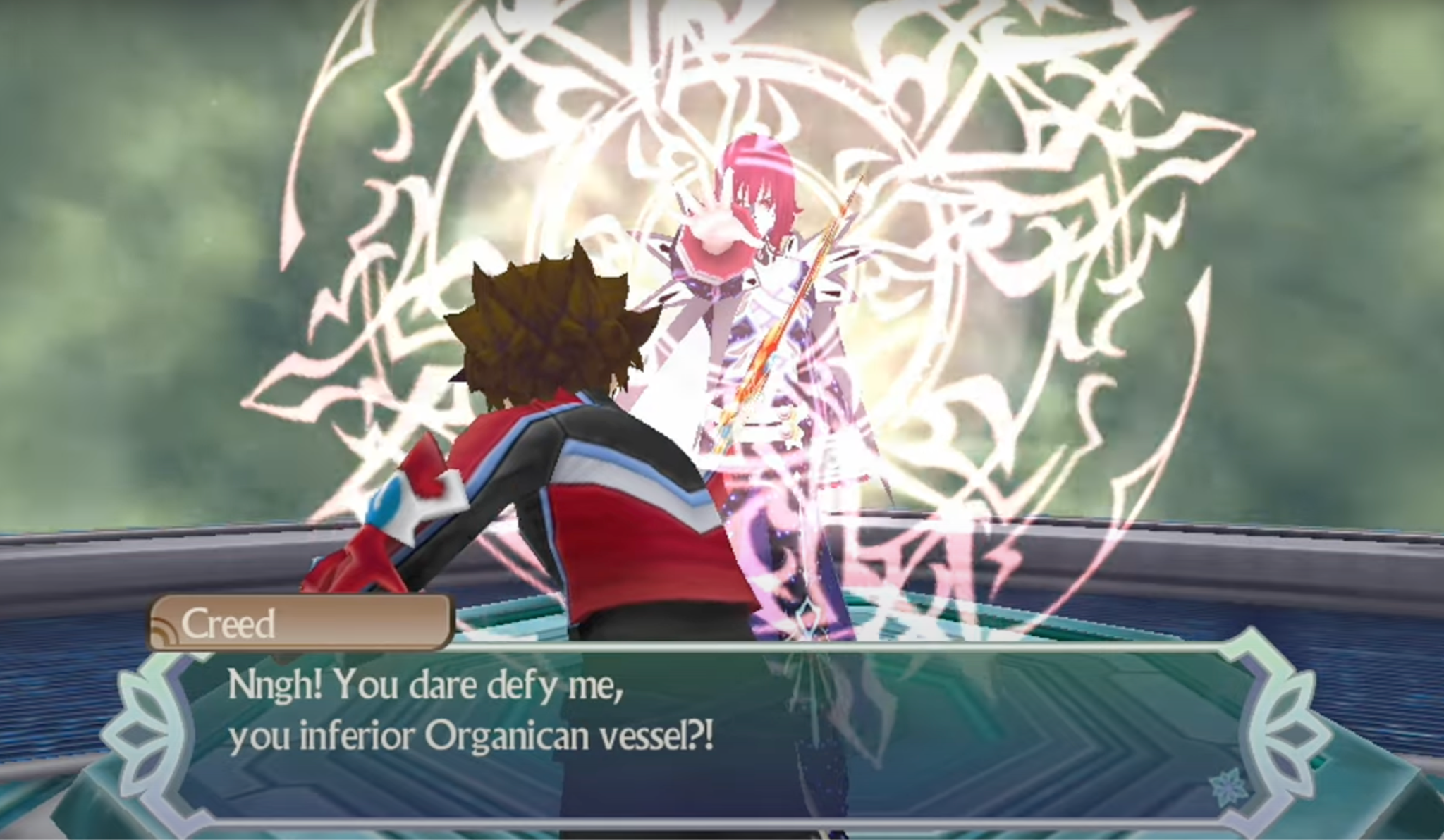
Bolstered by his Somatic bonds with the party and the rest of Organica, Kor stands up to Creed within Mysticete, following the events at Dronning and the evolution of Wahrheit into Reinheit.
The party arrives at Dronning having already externalized their lineage and the feud between Lithia and Creed relative to their current identities and relationships. It would have been easy for children suddenly exposed to this sort of family history to either enslave themselves to it or abandon it altogether, unable to find a path to determine choices of their own against the background of what’s come before: Kor lost himself as Creed’s “Empty Vessel” after the Mineran “used [him] up, beat [him] up, and then cast [him] aside”; Lithia revealed the saga of an interplanetary struggle waged over two thousand years; Zirconia’s memories revealed that Iola Hearts, Kardia Meteor (Kor’s mother), Sydan Meteor, and Labrodor Akerman were all involved in playing out that struggle; and those same memories show that Creed and Lithia passed their conflict directly to the next generation, nestling themselves within Kor and Kohaku before either was born. But Kor and Kohaku had formed a Somatic bond before these revelations, establishing the flexible and resilient emotional support we studied in the last section. So despite Kor initially retreating inside himself and temporarily shattering that bond—first thinking the Minera/Organica conflict has nothing to do with them and turning his back on Lithia, then lamenting that he should have died after learning his history with Creed—the two have the practical language to rebuild that bond. Therefore, they can treat what might otherwise have felt like a loss of essence as a shard of themselves, partly constituting the emotional content of relationships beyond themselves and resonating with their emotional journeys. Creed isn’t the “real” Kor, housed within his Spiria Nexus and disenfranchising him when he leaves: he’s someone who bears something like Kor’s “Shard of Anger,” which Kohaku can frame to him as the next step in Kor’s emotional journey to overcome anger by trusting that his connections with others intrinsically makes them happy (as when she reassures him in his moment of wishing he’d died after getting possessed by Creed, “Because you’re alive, I was able to meet you. And meeting you has made me happy”). This history that could have isolated Kor becomes something he can engage with on the level of values rather than identity, giving him a basis for undertaking a mission against Creed that involves him in the war between Lithia and Creed for the sake of his own emotional growth, and through the cultivation of connections with everyone he meets and takes on that journey, far beyond the vacuum of Creed’s original network.
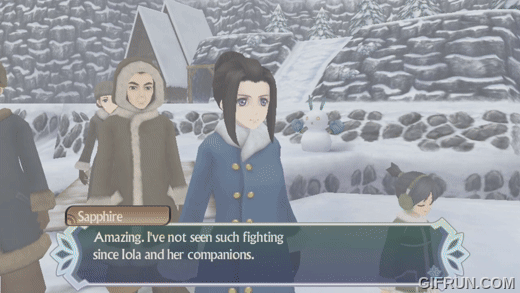
Iola’s children, Lithia, the former host of Creed, Crystal Knights, and many others unite to protect Dronning from xeroms after dispelling the town’s barrier.
The party pays this praxis forward in Dronning by replacing Sapphire’s hypostatization of Iola with a model of Iola’s community. In the face of a flesh-and-blood Lithia who contradicts Sapphire’s deified concept of her by asking to sacrifice the town’s barrier, Sapphire retreats further into hypostatization of Iola, decrying Lithia as “tramping on the final wishes of my sister, who risked all to save you.” But once the Willstone shatters, the barrier dissolves, and xeroms invade Dronning, Sapphire can’t help but watch in awe as the party steadfastly stands in defense of Dronning, the town that shunned them. Iola’s children, the former host of Creed, Chalcedony and his Crystal Knights, and Lithia unite in service of Iola’s value, the protection of Dronning, despite conflicting with Sapphire’s conception of her identity: the orthodox church of the past purged towns like Dronning and sects like Iola’s, yet their coordinated dispatching of xeroms leads Sapphire to admit, “I’ve not seen such fighting since Iola and her companions.” With Iola deceased, Sapphire can’t reconceive her as a literal agent involved in Dronning’s emotional journey, as Kor was able to with Creed, but she can perform a functionally equivalent reconception: what once was a static set of memories is now reborn as a characteristic structure of relationships in the present. Anyone can participate in this structure and thereby constitute Iola’s active presence in the world, even after her death, by motivating their actions as a promotion of Iola’s values, the defense of Dronning and its people—a mode of action that honors Iola while also intending to relate those in the community to those beyond it, opening them rather than isolating them. Once Sapphire internalizes this lesson, it’s an easy choice for her to set the kohaku cherry tree aflame and use it as a tool, rather than a symbol, to protect Lithia and the community from xeroms. Once an unthinkable act, this is now the obvious choice to honor Iola’s true legacy.
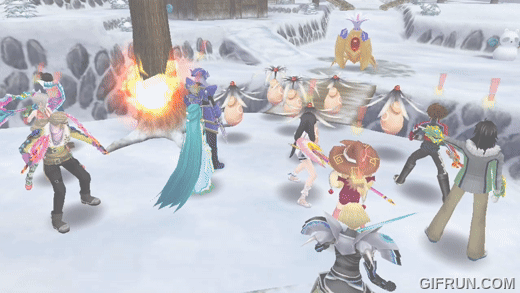
Moved by the party’s defense of Dronning, Sapphire joins them by destroying the kohaku cherry tree.
When a townwide Somatic bond emerges following the tree’s immolation, its beauty is twofold. That network of connections is itself the new abstraction of Iola in Dronning, and it’s also the right kind of abstraction to bond this new “Iola” with other people beyond herself in the present world. Where Sapphire’s abstraction of Iola’s identity and acts walled the community in, the community’s abstraction of her structure of relationships reaches outward, as Somatic bonds do, to touch and link with those beyond the abstraction. Dronning’s Somatic bond (fittingly, the first bond in which Kunzite participates, prompting him to reevaluate his artifactual nature) becomes part of the global Somatic bond that later emerges in the wake of Paraiba’s speech, extending her values to a world with countless other values from those in the present and past.
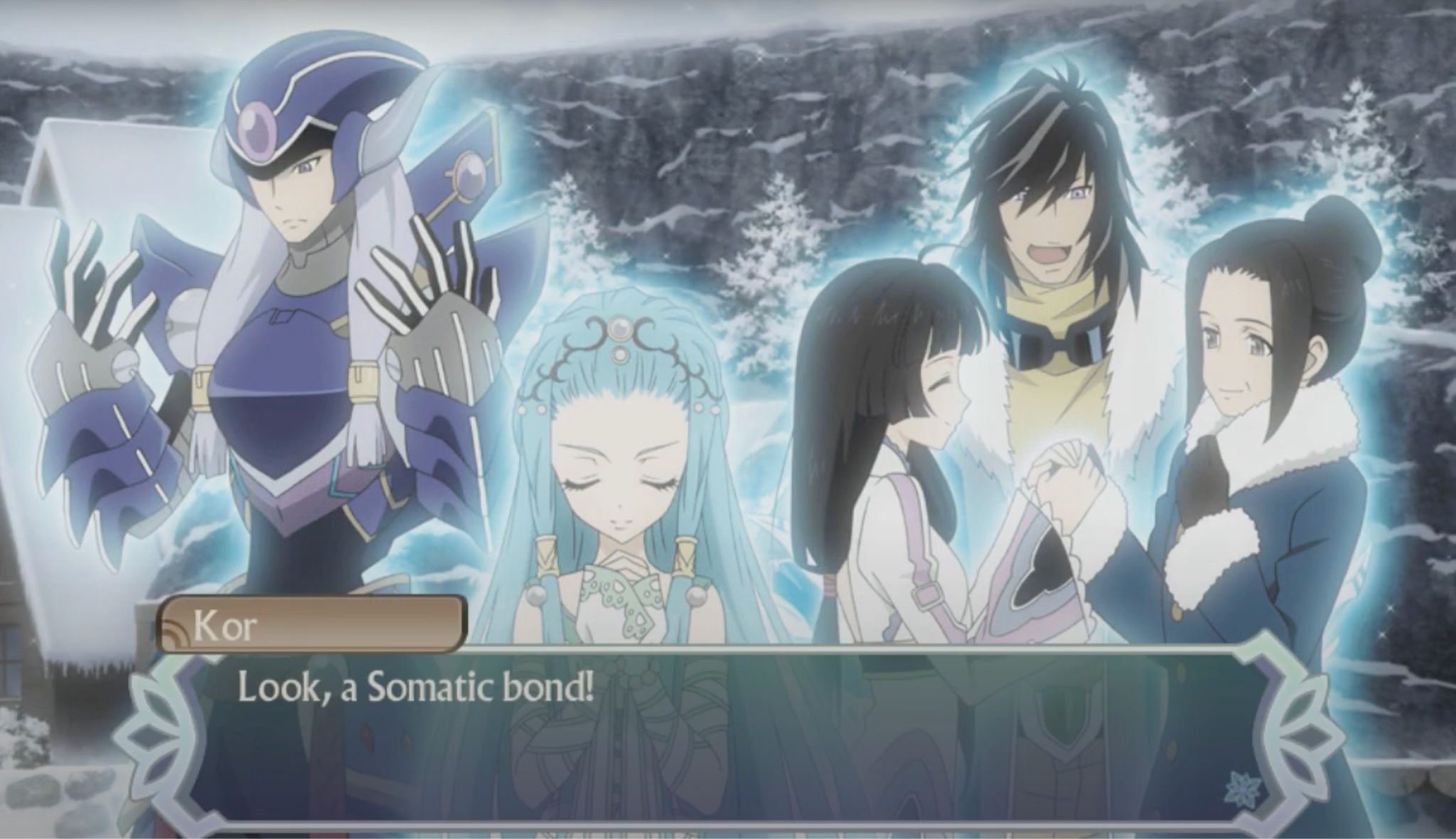
The Dronning-wide Somatic bond, an illustration of Iola in present-day Organica.
Just as Somatics who experience the model of Kohaku’s shards can apply that model to proactively form other such bonds between those in their present communities, Somatics who discover the value of abstracting the people of their past into a characteristic structure of relationships can proactively bring those people into the present and thereby equip their present-day connections with a new form of agency. Peridot Harmotome, member of Chalcedony’s Crystal Knight Platoon and de facto big sister of the Prinseur orphanage, illustrates this in a sacrificial act of enfranchisement that directly gives birth to Reinheit.

Peridot and Pyrox reflect on their historical families and found family in their final moments after sacrificing themselves for Chalcedony and the evolution of his Soma.
Within the volcanic Mount Va’mell, our heroes seek the Flare Horn of an ancient, legendary dragon, Vorgas; the second artifact for Wahrheit’s metamorphosis is the hardened body of a being that has persisted and strengthened through eras, wiping out towns and becoming an element of hazy lore more so than a known fixture of the natural world. In pursuit of the truth behind this myth, Chalcedony and his platoonmates, Peridot and Pyrox, get separated from the rest of the party and fall prey to three of Incarose’s bodies, which ambush them and mortally wound Peridot and Pyrox. The 13th Platoon’s firm, multidimensional community overcomes Incarose’s monotonic clones, with Chalcedony proving to the player that he, bolstered by his bonds and Soma (and the player), can overcome two of those clones alone in combat. But in their conversation with Chalcedony convincing him to leave them behind and move forward on his mission, the dying Peridot and Pyrox illuminate that there’s another kind of multidimensionality in this community that reaches beyond people in a shared time and place: part of what makes Somatic bonds so resilient is that participants can transform the values according to which all those sharing the bond act by sharing models of other bonds from their past, empowering them to see and endorse different courses of action than they otherwise would.
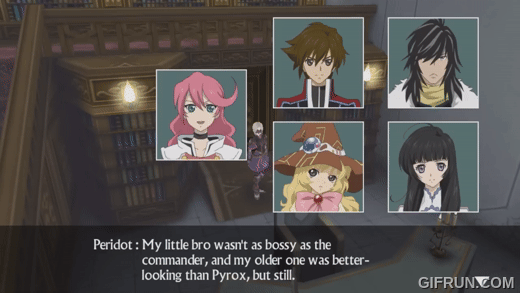
Peridot expresses her family history and bond of brotherhood with her platoon to the party as they rush to save Chalcedony from execution by the Imperial Army in Prinseur.
During their travels together, Peridot confesses to the party that Chalcedony and Pyrox remind her of the brothers who supported her in her younger years, alone after the death of their parents. Within Mount Va’mell, as the fires threaten to consume the wounded Peridot and Pyrox after Incarose has been dispatched, Peridot convinces Chalcedony to leave them by speaking to him as if he were her younger brother:
Peridot [to Chalcedony]: Quiet, you little snot! Listen to your big sister. It’s okay. I’m fine. You go and play.
Pyrox: She’s lost a lot of blood, sir. I fear her mind may be going.
Chalcedony: She sees her younger brother. The one who perished.
Peridot: Are you ignoring me because I couldn’t save you? Is this how you get back at me? I’m sorry. I know you were in pain. We didn’t have money for a doctor. Went to steal some, but when I got back, you were—You already—Anyway, can’t blame you for blaming me.
Chalcedony: Your brother holds no grudge against you, Peridot. I know you always looked out for me, and I am thankful!
Peridot: Then be a good boy. And listen… to your sister. You can do it. You’re strong. And I’m proud of you.
Pyrox: Listen to your big brother as well. Don’t make your… sister cry.
Chalcedony: So be it. Keep our sister safe. I would trust no one else with this… brother.
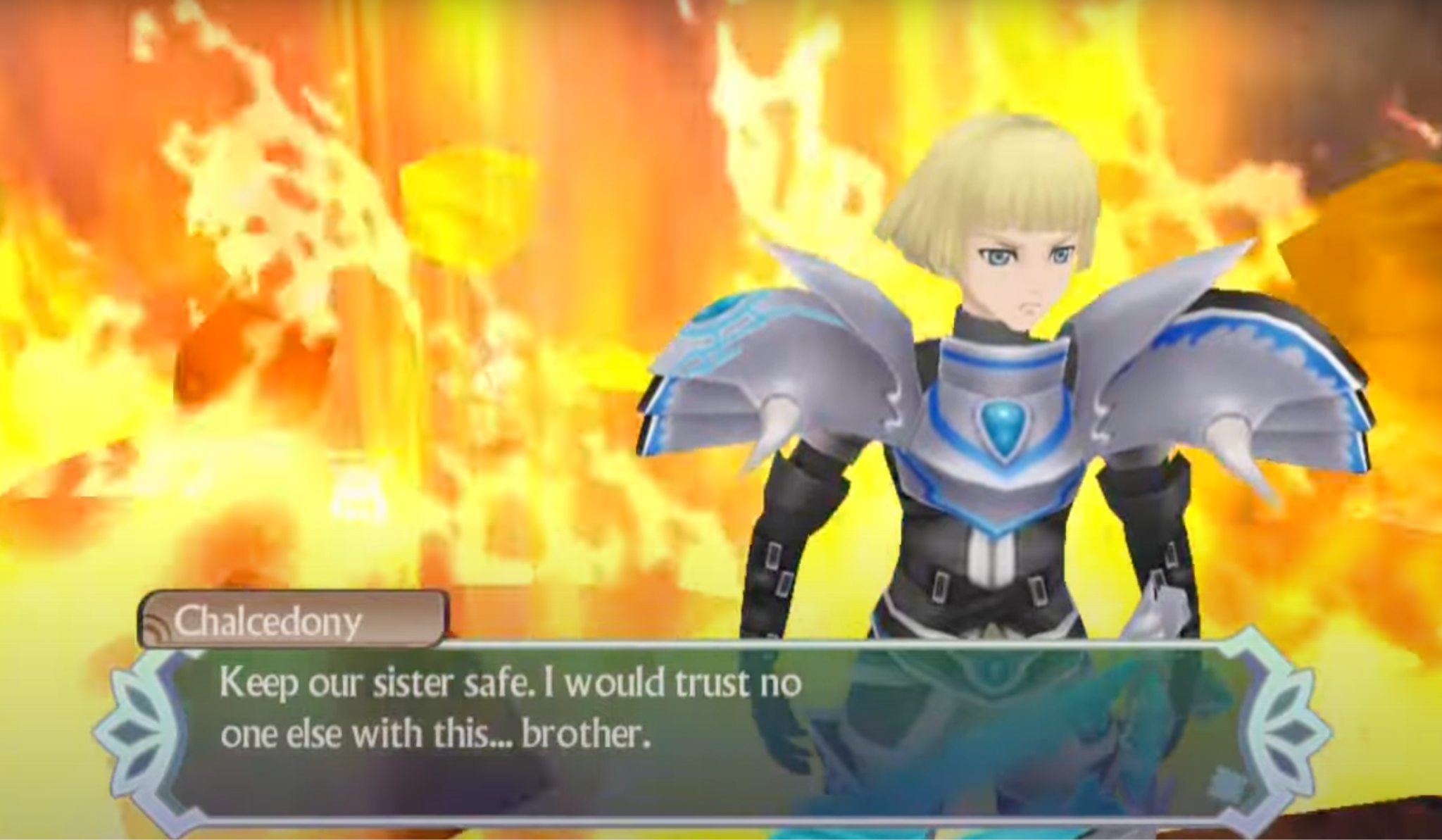
Chalcedony bids farewell to Peridot and Pyrox, speaking to them in the language of family bonds introduced by Peridot.
Peridot seems to be slipping away into memories of the brothers she couldn’t protect, losing her grip on her present situation as she dies; Pyrox and Chalcedony seem to be simply humoring her, giving her a final moment of peace by pretending as if her delusions reflect reality. But Peridot reveals her actual perspective to Pyrox as soon as Chalcedony has safely flown away: she was simply trying to deceive Chalcedony, with Pyrox’s help, in order to convince him to leave them behind rather than die with them. She did this not out of delusion, but rather out of an awareness of the analogy between her historical younger brother and Chalcedony: she tells Pyrox that she “couldn’t bear to see [her] little bro die… again.” In her final moments, her presence of mind confirmed, she invites Pyrox back into the language game of referring to one another as family, calling him “Little Bro” and saying that this conclusion of their lives “feels right”; Pyrox agrees, assuring her at the last, “Without a doubt, Little Sis. Thank the whale… for blessing me with such a family.”
Just as the identity of someone like Kohaku in the present can catalyze the restructuring of our current relationships, the relationships of those in the past can catalyze the restructuring of our relationships’ praxis, the values that identify and motivate our available actions. In the language of Tales of Hearts R, this is what it means for a Somatic’s history to awaken a new Soma form for that Somatic, giving them access to a new interpersonal tool through a past in which they indirectly participate. Forming a Somatic bond from the resonance between the emotional attributes and development of ourselves and others can be powerful, but the narrowness of that emotional resonance can limit the menu of coordinated, emotionally grounded actions available to us. Bonded with his platoon by the value of honor, Chalcedony can’t conceive of leaving them to die in Va’mell; once Peridot reconceives of them by analogy with the value of family through the model of her brothers who died while she lived, Chalcedony has a method, endorsed by Peridot and Pyrox, for choosing to leave them behind in order to live on as his found family wishes him to do. Despite growing up without access to this familial support from his own father, Chalcedony can benefit from Peridot’s phenomenal experience of such support, come to empathize with a new aspect of the intersection of his emotional landscape with her and Pyrox, and depart as a way of passing their wishes for him on to his further connections.
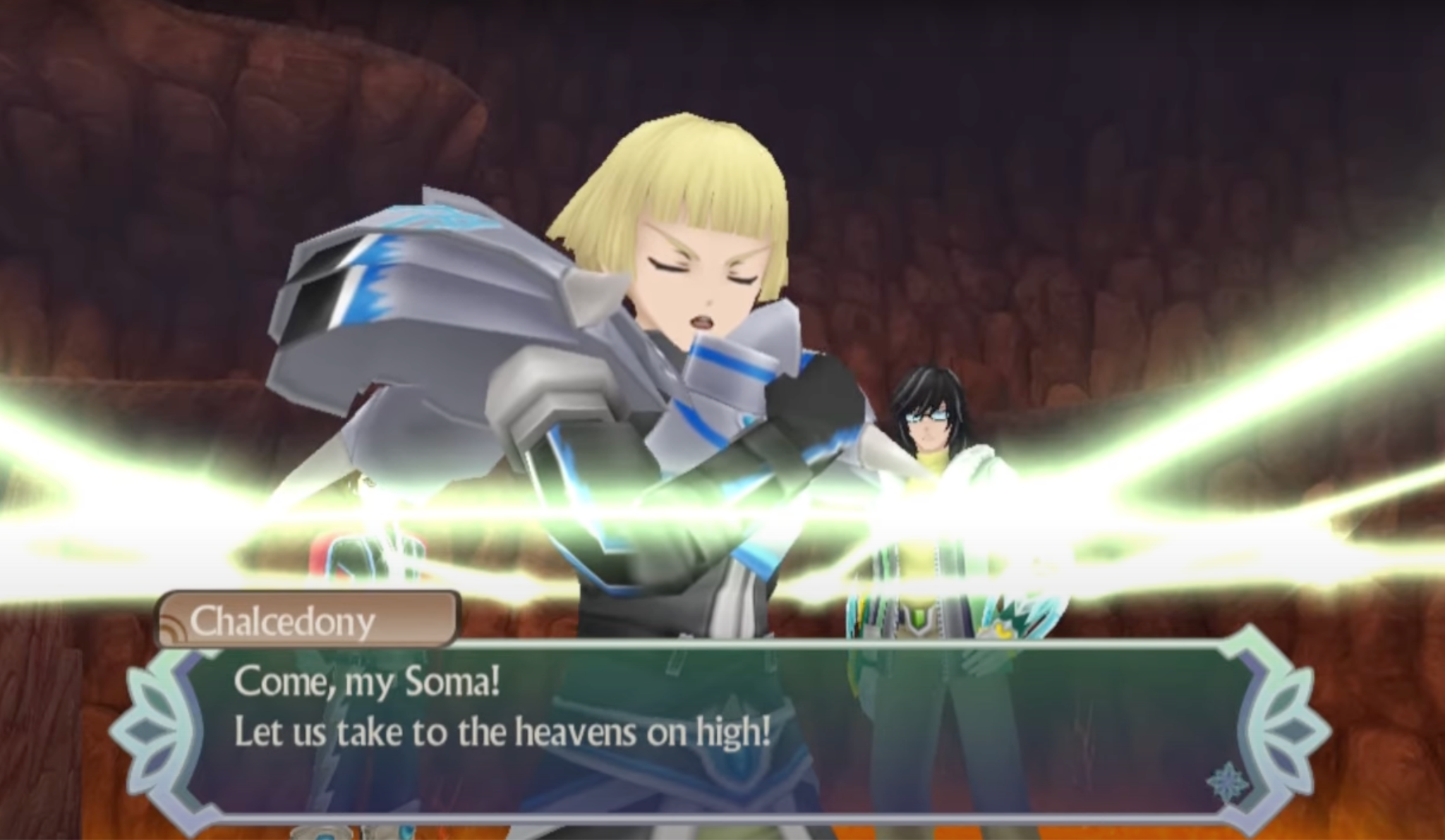
Bolstered by Somatic bonds with the rest of the party, Peridot, and Pyrox, Chalcedony completes the evolution of his Soma, Wahrheit, into the airship, Reinheit.
This praxis of orphaned sibling support empowers Chalcedony to draw on Somatic bonds with all of his friends at once—Pyrox, Peridot, and the party alike—to evolve Wahrheit into Reinheit at a critical juncture where, like orphaned children, the only support they can depend on is the love of one another, isolated in a volcano with the ceaseless threat of Gardenia overhead. Party members like Kohaku, Hisui, and Kor may not directly be Peridot’s “siblings” by her own account, but they have their own family-grounded forms of agency: the Hearts siblings have the newfound praxis of Iola showing them how to protect a local community; Kor has the praxis of Sydan and Kardia believing in the power of the strength they’ve transmitted to him weighing out over his inner demons. These other forms of relationship can empathetically resonate with, and empower, the continued emotional journey of Chalcedony in his moment of evolving Wahrheit through his faith in family—exactly like the hypostatized emotional dimensions of shard-bearers did for Kohaku’s emotional journey, but on the level of a community’s perspectives of its mutual bonds rather than the level of an individual’s perspective on a relationship. This empathetic resonance between forms of relationship, in my view, is what it means for each party member to feel the presence of Peridot and Pyrox when Chalcedony is trying to evolve Wahrheit into Reinheit: as Kunzite says, the 13th’s “strong desire to protect [Chalcedony] [resonates] in some unknown inner space of [theirs],” calling forth and fortifying each of their Somatic bonds to achieve that evolution. This also captures the sense in which this scene is simultaneously deeply communal and uniquely concerned with Chalcedony: exactly like Kohaku’s mission to reconstitute her Core, his personal emotional journey grounds the formation of bonds between everyone who touches him.
Like the intergenerationally reinforced horn of Vorgas, Chalcedony’s growth and constitutive bonds are fortified as the community gains more forms of agency that all speak in favor of a single course of action for different, incommensurable reasons. By the same token that Chalcedony gains autonomy when Peridot’s speech gives him a new course of action, he and his community gain emotionally grounded autonomy when values derived from networks of family, duty, compassion, and more all validate that this is the uniquely worthy choice. When the community in question has bonded together myriad values and relationship structures throughout the world, the resulting emotional and practical crescendo can channel that autonomy into morally profound outcomes at which the agent could never arrive alone—outcomes like the emergence of Reinheit from Mount Va’mell.
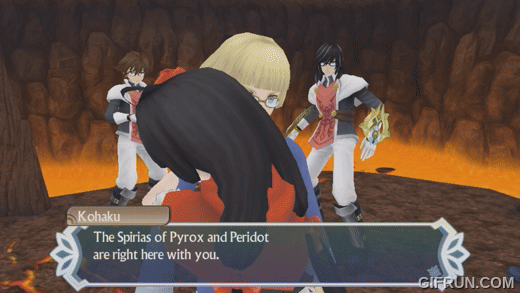
Kohaku assures Chalcedony that the Spirias of Pyrox and Peridot are with him, prompting him to consider their legacy in his life and pass that on, through Somatic bonds, to the party, triggering the evolution of Wahrheit into Reinheit.
In the model of bonding with others through the relationship of Spiria Core shard source and shard-bearers, we saw that the expert bondsman can turn his inquiry inward to navigate his hypostatized relationships through the vantage point offered by his community. When we instead consider the level of a community’s perspective of its mutual bonds, we find another structurally analogous praxis emerge: by sharing our conception of a particular past network of relationships with someone else in the present who has reason to relate to that network, we can give that person the context and motivation to transform the values of that network for us. Our efforts to express our personal history in a publicly accessible and useful format can create a kind of interpersonal gravity, tacitly impelling others to do for us what Peridot took it upon herself to do for Chalcedony. This is the gravity that motivates our choice to take our heroes back to Layve, the Village of Mist, and impart a new form of agency to Kor Meteor and Tekt Tourmaline through the context of their shared heritage.

Through the medium of their shared history with Kardia and Sydan Meteor, Tekt and Kor give each other a new form of agency to extend to their broader networks.
As we considered above, Tekt’s decision to lure the party into Spiria Linking with his crippled father—former emperor of the Maximus Empire and host to Creed Graphite—provides them with a family history which they situate in the context of their continued emotional development, bolstered by their preestablished Somatic bonds. This family history isn’t some disinterested account of the kind they might have read in a history book. Tekt himself is a participant in that history as a former companion of Iola, Lithia, Kardia, Sydan, and Labrodor, a node between our heroes’ present journey and ancestral struggle; he transmitted his father’s memories to them, he says, because he “wanted the children of [his] dear friends to know” their lineage, their “birthright,” thereby committing an act of communication that connects his network of the past to these new protagonists of the present out of a duty he recognizes to his previous community. By conveying the identities of their ancestors to them through an action that represents him as apt for connection, unlike Sapphire’s symbolism of Iola in Dronning’s Willstone, Tekt equips the party members to actively renegotiate their conception of their ancestors’ characteristic structure of relationships in conversation with his. The practical structure which Tekt conveys to the party is one motivated by regret: regret that Creed left his father “a shell” and robbed Tekt of the opportunity to hear him call Tekt by his name even once; regret that his friend, Kardia, “drained away all her emotions” due to her effort to seal away Creed within Kor’s Spiria Nexus, and that he and Kardia’s father felt an obligation to kill Kor as a result, which they could not satisfy. That regret still allows him to forge new connections and share his community with the party, but its derivation from the failure of his friends in their mission may explain why Incarose was able to shatter his Soma, unable to adequately act while tethered to a motive that mourned the inadequacy of his own agency.
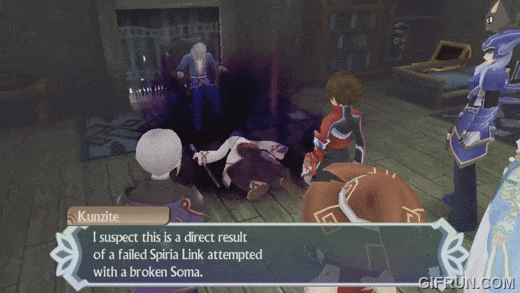
Inspired by the party, Tekt reaches out to his father’s Spiria and opens the door to a Spiria Link.
Even if the source of a given interpersonal structure is in the past, that structure itself is no less mutable than the structures built by those of the present: as Chalcedony achieved with the 13th Platoon and his party, the connection of history to new bonds can change the praxis of that history. If the player takes the party back to Layve later in their journey, Lithia assures Tekt that his inability to kill Kor in his infancy was a good thing for this very reason: “because of [Tekt’s] trust [in Kor], there is a new bond between Kor, Kohaku, and [Lithia].” That bond opens Tekt to the possibility of a mode of action drawing hope from his history rather than regret. When he tells the party that he lost the opportunity to hear his father call him by his name or view him as a role model because of his younger days as a self-interested thug and his father’s Spiria’s decimation by Creed thereafter, Kor passes on to him, almost verbatim, the sentiment Kohaku used to pull Kor out of despair and reconstitute their Somatic bond after he learned of Creed history and briefly wished he’d been killed in his youth: Kor insists to Tekt that he “can’t give up” on connecting with his father because “he’s still alive […] [a]nd where there’s life, there’s hope.” With that new perspective fresh in his mind, Tekt tries and fails to use his broken Soma to Spiria Link with Zirconia, collapsing under the weight of his hypostatized “embodiment of all the negativity [his] father has spawned” within his Spiria Nexus, opening the door to the exact kind of intervention the party has executed with other hypostatizations: a Spiria Link to overcome that negativity within Tekt.

After Kor and the party defeat a hypostatization of Zirconia’s negativity within Tekt’s Spiria Nexus, Tekt returns the favor, using the Meteor clan’s signature arte to shield Kor from a surprise attack.
Tekt takes on the most active, collaborative role within his Spiria Nexus of any target of a Spiria Link throughout Tales of Hearts R, brandishing his broken Soma as a weapon to protect Kor from Tekt’s hypostatizations after Kor does the same for him. This is because, unlike the model of Kohaku and her shards, this renegotiation of connections isn’t concerned with paralyzing emotional conceptions of Tekt’s inner nature: rather, it’s concerned with replacing one form of action available to Tekt with another. He rescues Kor by dispatching his hypostatized negativity with Meteoric Iron, demonstratively introducing Kor to another practical element of his heritage, “a move invented by Sydan and taught to [him] by Kardia.” In return for the context which Tekt gave Kor about his family history, Tekt gets from Kor a new motive to channel through that same context: bolstered by his bond with Kohaku, Kor risks his life to save Tekt from the grip of his regret; experiencing the resonance between this action and the actions Kardia took toward Tekt and Kor alike in their past, Tekt can first-personally channel that same dogged belief in the potential of life which Kardia once did, gaining a new way of relating to her, her son, and his own father. Spiritually reconfigured in this way, Tekt can offer more stories to Kor about his mother’s embodiment of that praxis, opening up about how she “pulled [him] close and held [him]” after telling him Creed had claimed his father’s Spiria, and smiling as he recalls how “[s]he fought and fought for my father until she was black and blue.”
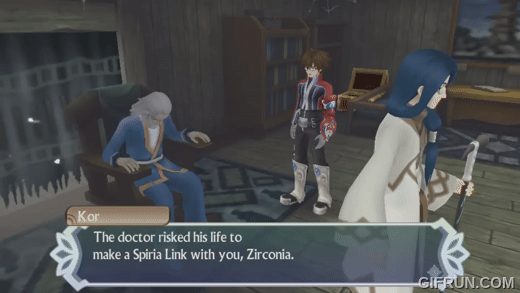
After making sense of his shared history with Kor within his own Spiria Nexus, Tekt hears his father, Zirconia Tourmaline, call him by his name for the first time.
This practical empathy mirrors the emotional empathy of shard-bearers and Somatics reworking their internal concepts through the personal journeys of the other. The historical network Tekt gives Kor can’t help but orient his continued emotional journey as an individual, and his other networks can’t help but bleed into the subsequent stages of his development, inspiring Tekt to derive a different agency from his own past by discovering different analogies between Kardia and Kor. And there’s overwhelming reason for someone who’s been enfranchised by a person with a common past to return to that person as a means of reworking the content and value of their history for both their sakes. This is the source of the interpersonal gravity pulling Kor back to Tekt, not just to learn more about bygone events but rather to unlock more ways for them to both inhabit and evolve the relationships of that past. The very same act of mutual service that transmits Meteoric Iron from Tekt to Kor also awakens Tekt’s cane Soma as a unique form of Kor’s Soma, and prompts Tekt’s father, in a moment of lucidity, to finally call his son by his name. By separating and reuniting in their journeys through life, like Chalcedony and Paraiba, they establish and maintain a Somatic bond: a bond whose reactions give one a new value through which to transform his relationships and the other a new form of agency through which to connect with others.
After the party, Lithia, Peridot, and Pyrox channel their collective bonds into the Xerom Stone, the Flare Horn, and Wahrheit, the Soma that once stood for ‘truth’ evolves into the airship Reinheit, ‘purity’. Once a physically and spiritually exhausted Chalcedony recovers his strength at Guz Spa just beyond Mount Va’mell, Chalcedony turns to Hisui and Kohaku before taking any further flight: “I realize,” he tells them, “that Wahrheit is your mother’s keepsake. And as such, there is a question long overdue—will you permit me to continue using it?” Far from insisting on his mother’s ownership as he did upon the approach to Dronning, Hisui says that Wahrheit became “an entirely new Soma” the moment it evolved—an evolution which, Chalcedony declares, is credited to the whole party as well as the 13th Platoon, catalyzed by the “new bonds” formed between them. But the new Soma retains its complete provenance, the residue of its former master’s connections and values made new through its current owner: shortly after taking flight in pursuit of Mysticete, Hisui notes that Kohaku’s childhood fear of heights isn’t affecting her aboard the aircraft, which, Lithia surmises, is “because this Soma used to belong to your mother, Iola,” while Kohaku adds that it’s “also because [she knows] that Chalcedony is at the wheel.”
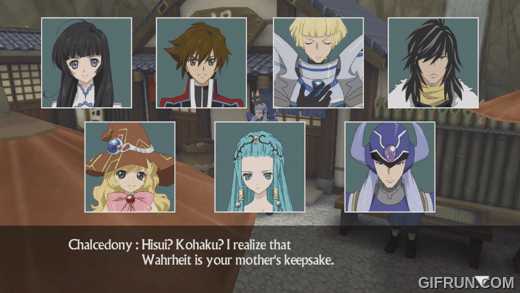
After evolving Wahrheit into Reinheit, Chalcedony asks Kohaku and Hisui for permission to continue using it, leading the party to reflect on the full extent of the community that made its evolution possible.
The Soma’s evolution from truth to purity is thus the synthesis of ethically coordinated bonding, across both space and time, which we’ve seen in our Somatics’ journey:
- The Spiria of one person in the past, Iola, becomes a context through which others in the present can forge new bonds and reconfigure their existing ones.
- The abstract concept of a mother and host which Hisui, Kohaku, and Lithia had of Iola gives way to an understanding of Iola through a tool that embodies her agency, the mode of action she fought to make possible for her children and the world more broadly.
- The model of the Soma’s role within a group of heroic friends one generation earlier provides the next generation of heroes with a means to coordinate and motivate their party after completing their mission to rebuild Kohaku’s Spiria and getting thrown into an interplanetary drama with no point of reference to structure and motivate their efforts.
- Peridot and Pyrox’s acts of self-sacrifice for Chalcedony give the party a new vantage point from which to bond with them and extend the legacy of the 13th Platoon into a broader, present-day network.
- The party’s embrace of Chalcedony in his moment of desperation after losing Peridot and Pyrox—personified in Kohaku’s literal embrace of him, offering unconditional support in his emotional journey at the heart of an active volcano—transforms Chalcedony’s relationship with his role as a knight, evolving his agency from one of servitude, acting as the sword of High Priest Akerman and the shield of Empress Paraiba, into one of leadership and family, becoming the literal and metaphorical pilot of the ship taking his found family to a foreign world for the sake of every bond they’ve ever forged.
After Wahrheit becomes Reinheit, Kohaku repeats a common refrain at the heart of the game: “Be you in the land of the living or the realm of the dead, our Spirias are always one.” Our analysis explains this unity between the living and dead in a way that coheres with the broader nature of Somas and Spirias: it’s not that those who have left the world somehow persist as phantoms and continue to exert their influence—as the “Know Thyself” title reminds us, “The past is past. Let it stay that way.”—but rather that the relationships which others have had in the past can structure the emotional and normative content of the relationships we, the living, can take on in the present. The metaphysics of individuals’ Somatic bond networks live on, and the Spiria of the world can be unified by integrating the structures of every local network of relationships that every person has cultivated throughout history, making every subsequent generation more intimately connected than the last.
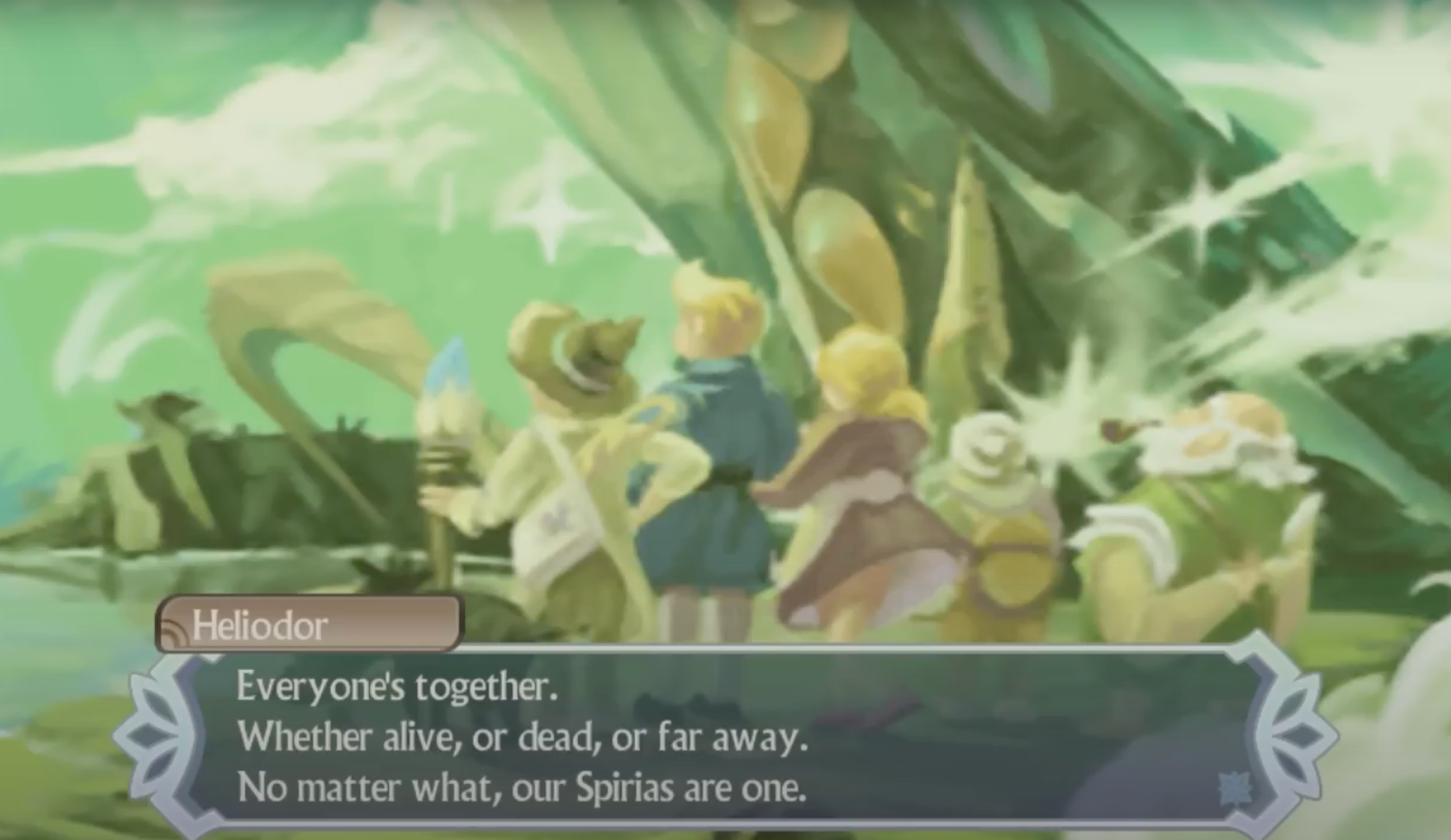
After Beryl paints her grandfather and Baaryl into Benston’s last painting, her grandmother repeats one of Tales of Hearts R‘s core refrains: “Whether alive, or dead, or far away. No matter what, our Spirias are one.”
The analysis also makes sense of why it can be so hard, intuitively, to situate our history within our contemporary identity. If we look to our past relationships as a way of defining ourselves, we can end up unwittingly fashioning artifacts out of them: we limit ourselves to “discovering” the self-referential values according to which we fashioned those artifacts in the first place, like Sapphire in Dronning. This explains the fear of being enslaved to one’s history, treating it as an object to either avoid or merge with. But if we first take the time to make sense of our living, diverse, dynamic connections with the world around us, we can arm ourselves with a sufficient range of emotional and practical perspectives to critically evaluate the utility of those past relationships and integrate it with a wider toolkit of values and actions, rather than turning our gaze inward and fixating on something unreal and disconnected.
Even then, we might worry that our personal histories are conceptually sticky because, it seems, we need to relate to people with shared histories yet diverse emotions, values, and networks if we want to renegotiate the praxis of those histories. Sapphire couldn’t see beyond the Willstone without Kohaku, Peridot couldn’t usefully extend her familial analogy to the party without Chalcedony, and Tekt couldn’t emotionally reconcile with his father without Kor. This conjunction of deeply shared background and deeply divergent perspectives might feel too rare to be broadly applicable, especially when many communities seem insular like Dronning was before the party’s intervention.
Tales of Hearts R goes further to challenge this, bringing us full circle to the potential of artifacts like video games to foster rich, multidimensional bonds among virtual strangers. When fully-fledged Somatics who have mastered these methods coordinate one person’s motivations for bond formation with someone else’s structure of interpersonal relationship, they can impart autonomy to otherwise inert entities who can interpersonally bridge people who wouldn’t otherwise share enough context to bond with each other.
§2.4: Bonding with Another World: Gall, Lapis, and the Winged Whale
Up to this point in our analysis, the enactment of Somatic bonds has colocated the motivation for interpersonal connection and the structure that connection takes within a single agent. Kohaku’s Spiria Core shards determine the emotionally relevant characteristics of their bearers, and the beam of light connecting her Spiria Nexus to those shards fixes the motivational direction of her journey to find them; Paraiba extends hypostatized aspects of her character to her subjects and motivates them to work through their resonant hypostatizations by progressing on her own emotional journey; Kohaku and Hisui emulate the model of Iola’s community to coordinate their protection of Dronning from xeroms; Peridot motivates Chalcedony to leave Mount Va’mell by imparting to him the model of sibling love and sacrifice; Kor’s motive to catalyze Tekt’s hope and Tekt’s motive to rectify his broken relationships drive them to collaboratively revise the structure of their shared family history. But even though it’s intuitive to suppose that agents would typically determine both the force of their action and the shape that action will take, there’s no reason to suppose that these two dimensions of agency must be authored by the same person. In fact, from what we’ve seen of the healthy dynamic between the hypostatization and disruption of interpersonal concepts, there’s reason to suppose that it might be useful to someone with access to one of these dimensions to offer it to someone possessing only the other dimension, enfranchising her to act in a context where she couldn’t otherwise.
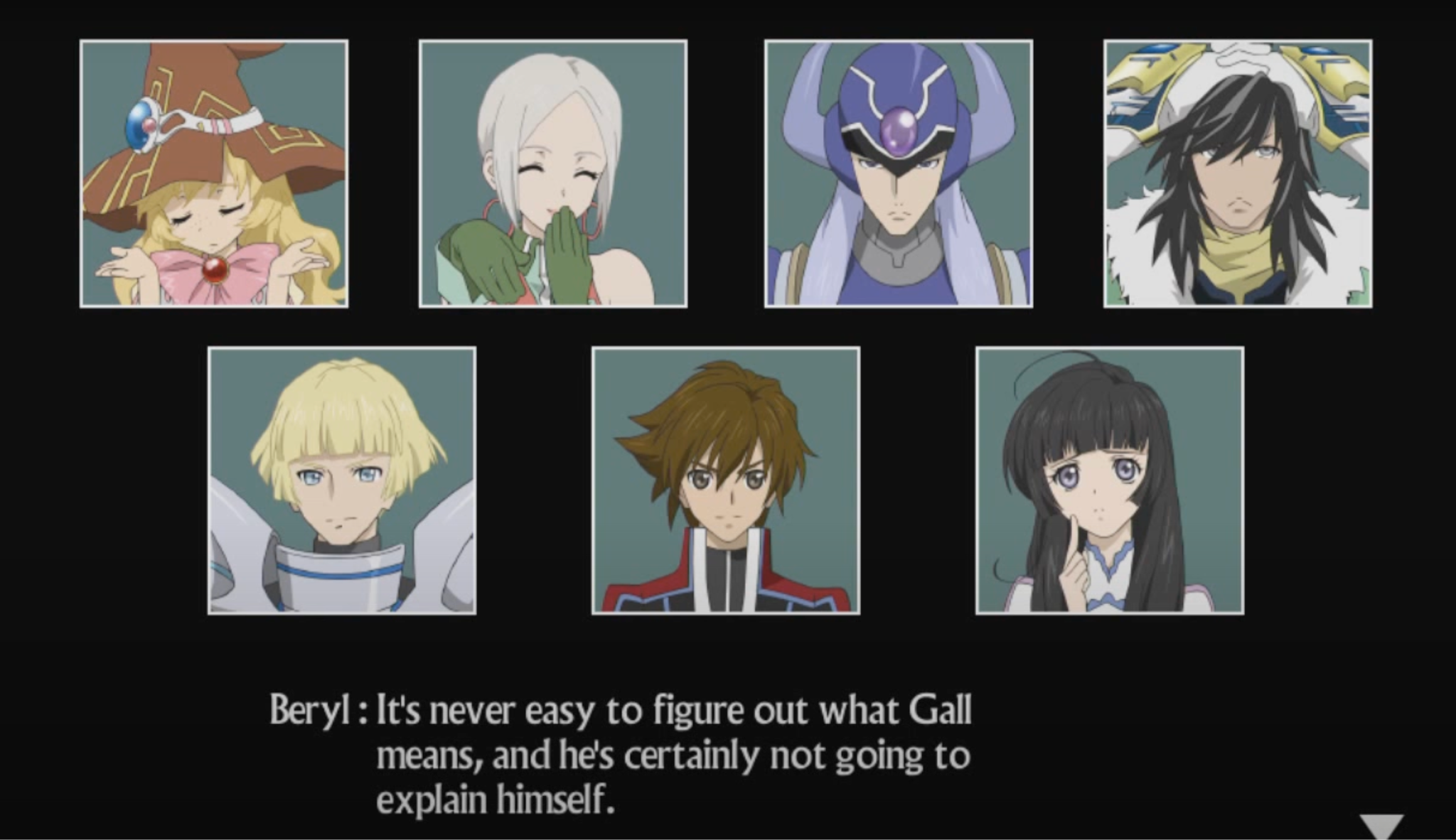
In an inn sequence where Gall resolves to train alone outside, evoking Chester’s training sequences in Tales of Phantasia, Beryl remarks on how his intentions are often inscrutable and his actions executed without explanation.
To grasp the intuitive separability of structure and motivation, consider two cases. First, imagine yourself in a situation where you desperately feel as if you ought to do something for someone, yet are at a total loss as to what to do; perhaps you see a neglected child alone on the street and don’t know exactly what it would look like to help them. You’ve found yourself with a motivation for action but without a structure through which to channel it. Second, imagine yourself in a situation where you conceptually grasp and appreciate the value of a particular form of relationship without wanting to seek it out for yourself; maybe you’re a married woman who values the relationship of marriage and doesn’t need to seek it because you already have it, or maybe you’re a religious studies scholar who deeply understands and appreciates a religious tradition without feeling any pull to practice it personally. You’ve found yourself with a structure for a particular form of action but without the motivation to undertake it.
In either case, coordinating ourselves with someone who possesses the dimension we lack yields a powerful result: we can form bonds with entities which we wouldn’t be able to reach otherwise. That means not only that we can connect with established foreign communities, but also that we can provide interpersonal autonomy to entities that possess the right architecture for such autonomy yet possess no bonds, bringing inert objects to life even though we couldn’t logically bond with such a thing alone. Tales of Hearts R shows us this coordination in two directions, naturally directing our practical attention from the emotional bonds between characters back to our engagement with the overall game as an artifact, preparing the way for us to connect our agency to that interpersonal value. First, we see in the story of Ines and Gall restoring Lapis’ Spiria Core that an outsider who empathizes with a Somatic in a community can transmit to her a novel structure of relationship with which to actualize a potential living being. Second, we see in the evolving meaning of the “winged whale” that an outsider can witness someone’s motivation for expressing the narrative of their community in a certain way and enfranchise that narrative by synthesizing that motivation with a structure of relationship from his foreign community, creating a living story that emotionally evolves over time rather than remaining fixed in the past. Once we have these both in hand, we can’t help but turn our attention to Litha—a Mineran who, unlike an Organican like Iola, really can spiritually persist indefinitely—and investigate how a living story like her fairy tale might serve as a vessel, like Kunzite, to carry her forward into new communities and new worlds.
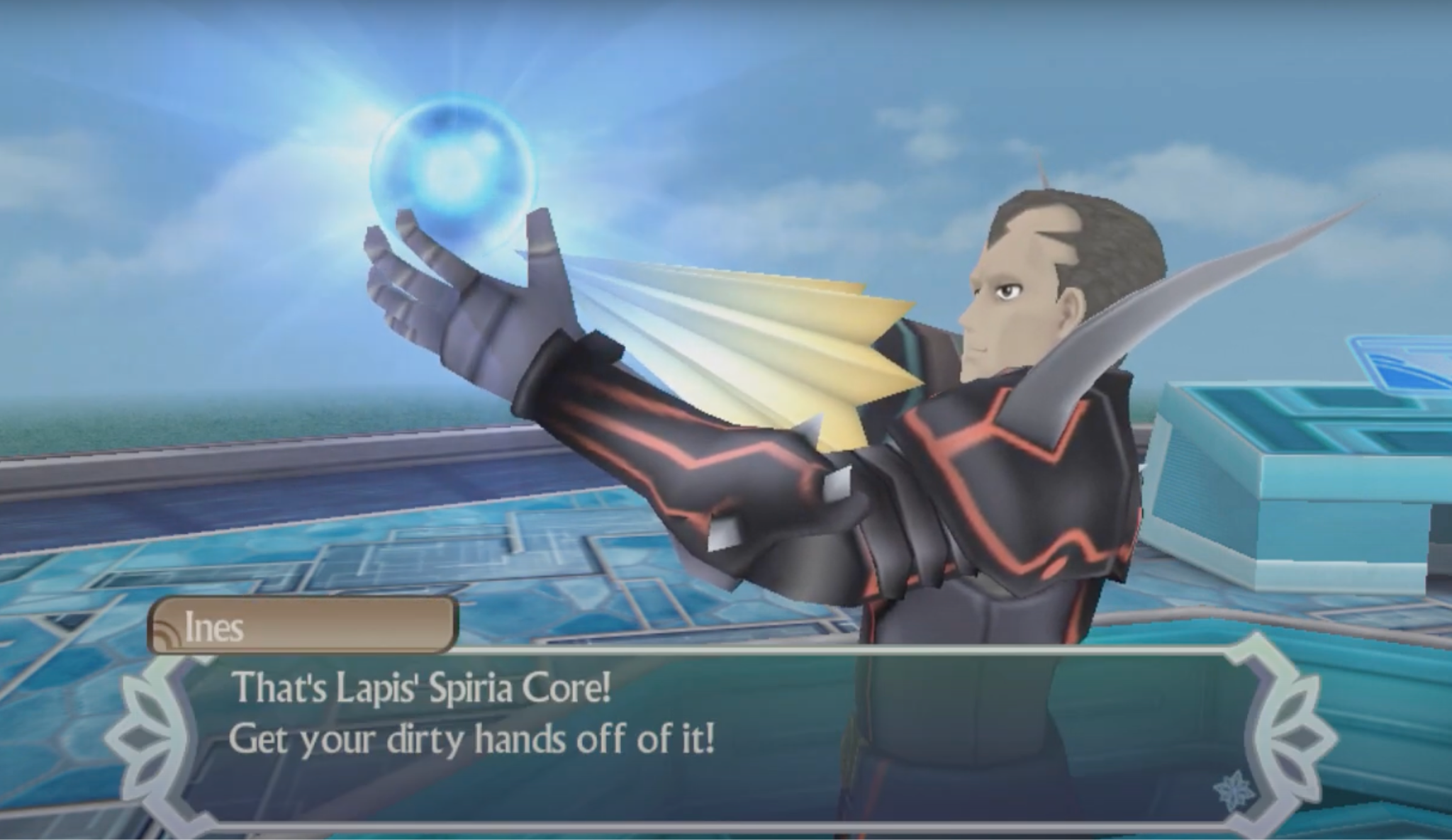
Geocron Striegov toys with Lapis’ Spiria Core during the party’s final confrontation with him in Mysticete.
Bolstered and oriented by “the true nature of Soma,” Chalcedony and his friends can penetrate the impenetrable: their Soma allows them to relate to a foreign world, flying Reinheit beyond Organica to the machinery and dead remnants of an alien society. We’ve seen that Gardenia, Creed, and Minera are entities that objectify life on Organica, thereby forestalling any potential for interpersonal relationships to bridge the Mineran and Organican forms of life. It’s therefore apt that Striegov serves as their final challenger within Mysticete, marking the threshold between Reinheit’s departure from Organica and its arrival on Minera. Striegov’s collection of Spiria Cores alienates individuals from their inner lives, leaving them interpersonally inert in the very same way Gardenia is: unable to form even the most superficial of bonds, as we see with the Lapis’s unconscious body and empty, atrophied Spiria Nexus.
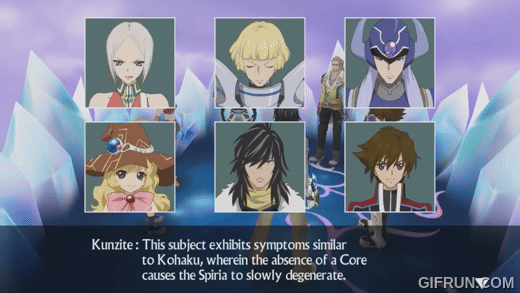
Inside Lapis’ Spiria Nexus on their way to Silver, the party reflects on its total lack of a Core before they know why this is the case.
The journey to rebuild Kohaku taught us that the development of our emotional identity through resonance with hypostatized concepts of others’ inner shards is the ideal method to “rebuild ourselves through bonds.” Lapis’ situation is substantively direr because there’s no emotional content or agency left within her to instigate such development: as Hisui observes when the party first Spiria Links with her body and discovers her anemic Spiria Nexus, “Kohaku at least had ONE shard [remaining within her when her Core shattered]! I don’t see anything here.” With her entire Core plucked away by Striegov, Lapis is inert: her Spiria Core is a structured emotional landscape with no connections or ability to initiate connection. The job of the fully developed Somatic here is to do the opposite of Striegov: she must personify an object, Lapis’ Core, rather than objectifying a person, giving life back to her by forming a new, foundational bond through which she can derive a method for making further bonds autonomously.
We’ve already seen what Tales of Hearts R tells us this action consists in. People engage their emotional autonomy when they act in ways that represent them as apt for connection; therefore, to enfranchise someone who lacks this autonomy, we must act toward that person in a way that represents them as able to act in ways that represent themselves as apt for connection. This is what it means, in the language of bonds, to engage with something for its own sake. To do that, we must act towards them in a way that gives them a model of connection and a means of extending themselves to make connections elsewhere. That requires a form of outreach with no expectation of connection because no connection with the object is possible yet; that can make it difficult for someone reaching out to know what shape her outreach ought to take. That’s why the resurrection of Lapis requires the coordination of two fully fledged Somatics: Ines, from her connection with Lapis’ father, provides the motivation for her own outreach, and Gall, the most foreign party member conceivable, provides the structure for her outreach.
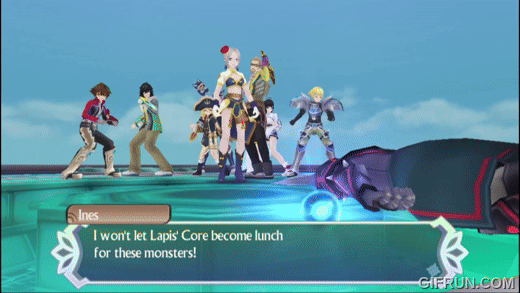
Ines and Gall jointly retrieve Lapis’ Spiria Core from the threat of xeroms after defeating a xeromized Striegov within Mysticete.
Ines is desperate to save Lapis and give her the potential of a life rich with connection, but not for the sake of establishing a specific form of relationship with her. Rather, Ines’ love for Lapis’ father, Azide, inspires her to promote Azide’s “hope of bringing Lapis back.” Part of Ines’ initial, ulterior motivation for joining the party back was the suspicion that Kohaku’s journey to reconstitute her Core would reveal a method for her to awaken Lapis, giving Azide “a chance to start over” and escape the “vengeance and hate” that clouded his Spiria in the wake of having lost her. In that initial context, Ines treats Lapis instrumentally, “betraying” Lapis’ intrinsic value in the same way she betrays the party’s trust for the sake of Silver. When Kor tells her to learn from the lessons of his journey with Kohaku and “show him [her] true feelings,” his empathy gives her the method she needs to rejoin the party and cure Azide’s xeromization and calcification by dislodging his hypostatized feelings through the context of Ines’ own emotional progress, just as the party has done for so many shard-bearers before him.
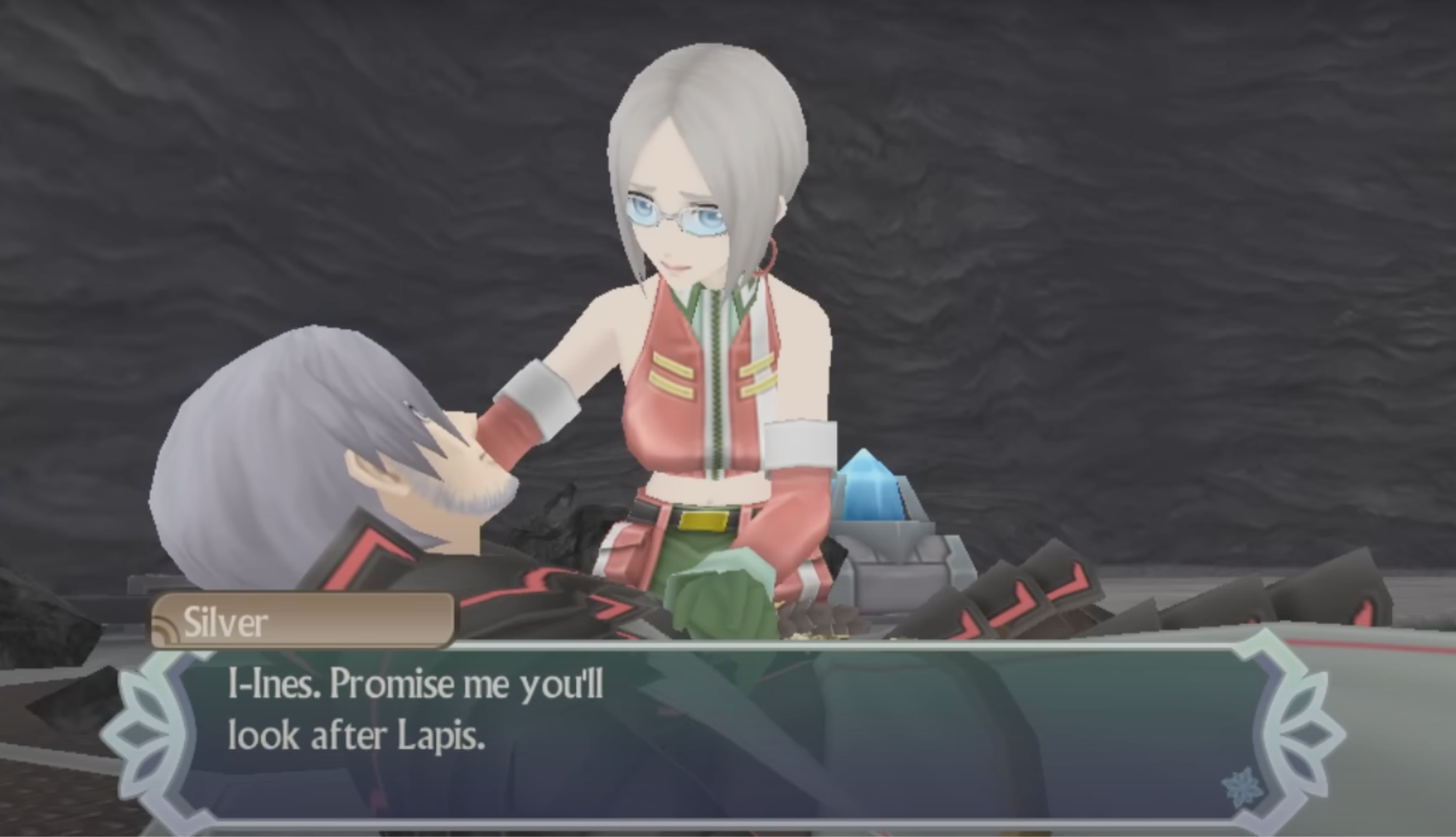
As he dies, Silver calls Ines to look after Lapis.
When Incarose kills Azide moments later, he bequeaths to Ines an emotionally coded mode of action, like the player entering Tales of Hearts R through the action of developing Kor’s Spiria Attributes: he charges her to “look after Lapis,” calling her to save Lapis for the sake of Lapis’ intrinsic value, which her father rediscovered in his dying moments and which Ines—through the model of her relationship with him, something which persists in her Spiria after his death—can take on as her own motivation for action. But Azide’s relationship with Lapis, from which he derives his investment in her future potential, doesn’t transfer to Ines. Since Azide only gave Ines a directive toward Lapis without a structure of relationship through which to channel it—in contrast to, say, Peridot’s use of a familial structure to contextualize her directive for Chalcedony to leave her and Pyrox behind in Mount Va’mell—Ines must find her own structure through which to channel that motivation, but the very same context that made Lapis relevant to her in the first place limits her options. With his hypostatization of his daughter dislodged, Azide discovers his role as her father, within which context it’s natural for him to promote the independent potential of Lapis for future connections with others. Ines can’t step into this model of fatherhood for Lapis, nor the model of motherhood: she knew and loved both Azide and his wife, Perl, and so those very same connections that motivate her investment in outreach also make it emotionally impossible for her to replace either of those key connections which Lapis had before Striegov stole her Core.
Ines finds herself in the dilemma of being motivated to enfranchise someone whom she values because of her past relationships when (1) the person in question has no agency through which to inform one’s actions towards her and (2) the only people from her past who could serve as models for relationship formation have other relationships that thwart her capacity to use them as models for her own, new relationship towards that person. We see this dilemma play out when Ines later realizes that Striegov has Lapis’ Core: in the absence of a clear way to act toward Lapis’ Core itself, she instead wrathfully lashes out against Striegov. That action is explicitly motivated by Ines’ relationship with Azide rather than Lapis: as she attempts to kill Striegov during their first battle within Mysticete, she exclaims, “You ruined Azide’s life, and now you’re going to pay with your own!” This is the expected result given our analysis of bonds. With no points of emotional resonance or available models of interpersonal structures for her to apply between her and Lapis, the only way for Ines to act on Azide’s directive is to fall back on the motivating relationship: her love for Azide, and the impact Striegov’s actions had on Azide’s life. She can’t act to enfranchise Lapis for the sake of Lapis’ own sake until someone interrupts and provides her with a new structure through which she can begin to act toward Lapis per se, even before Lapis is in a position to act back.
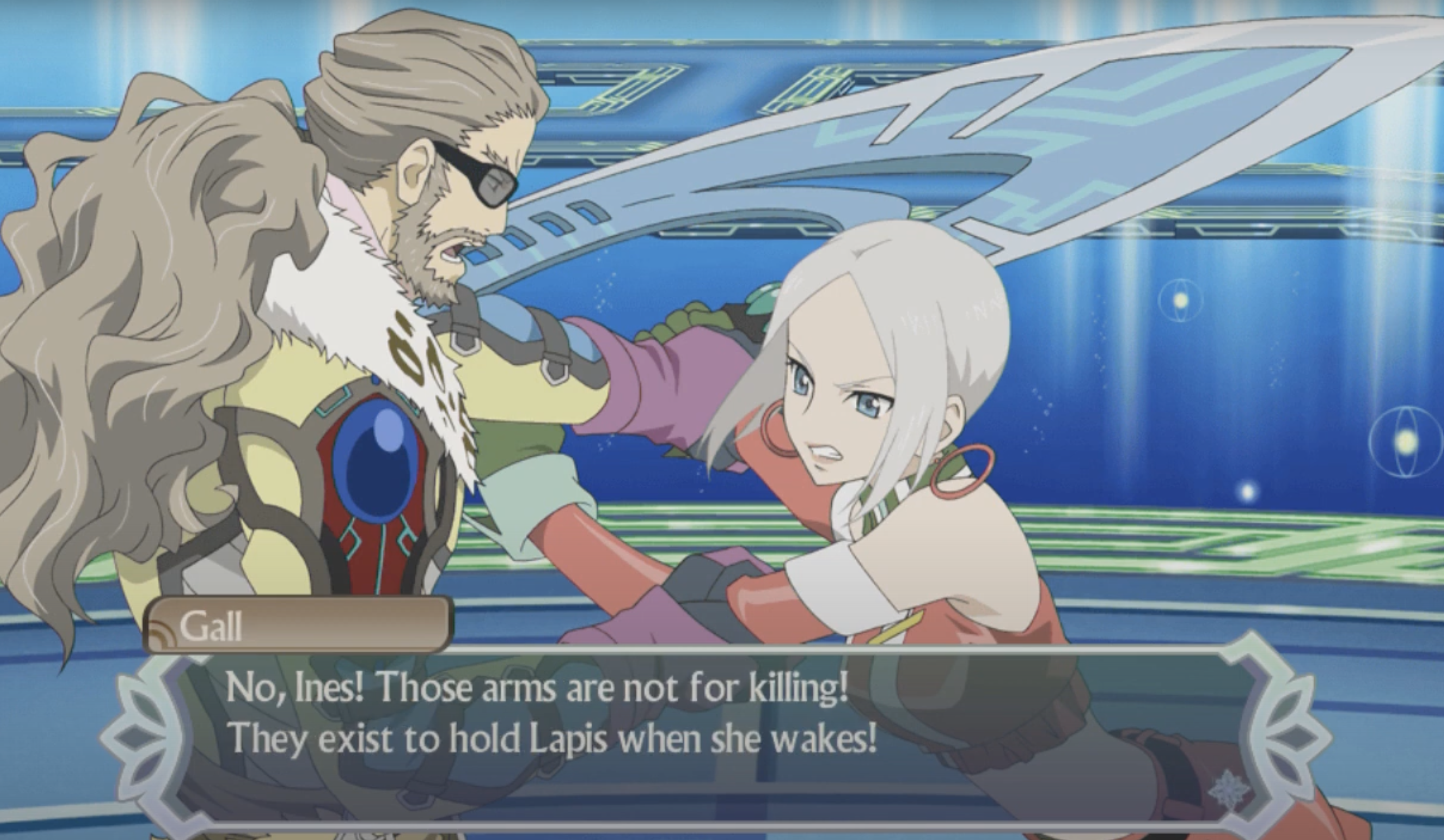
Gall restrains Ines when she tries to exact vengeance on Striegov during their first battle with him inside Mysticete’s Core.
Ines finds what she’s missing in Gall Gruner, who stays her Soma against Striegov and tells her, “Those arms are not for killing! They exist to hold Lapis when she wakes!” As both a literal and figurative dimensional interloper, Gall is the ideal example of a Somatic who can equip individuals with interpersonal structures to navigate contexts beyond his own. Literally, he’s a new character introduced in the remake of Tales of Hearts, and we discover after the end of the game’s story, in an optional dungeon linking multiple dimensions together (the Triverse Gate), that Gall really did come to Organica from another dimension, only to return to his native world through the gate buried deep within that dungeon when all is said and done.[9] Figuratively, in a game where every other party member orients his or her identity in relation to personal, familial relations whom we meet at critical moments in the story, Gall’s only two preexisting relationships introduced to the story are those with his wife and daughter, whom he lost to despir almost 20 years before the start of the game and whom we never see, not even in flashbacks.

Gall shares his background with the party after seeing Lapis’ body bereft of its Core.
Through the broken Core of Kohaku, the stolen Core of Lapis, and even the entire world of Tales of Hearts R, Gall illustrates how and why to empower the communities in which we find ourselves, even if we don’t share the communities’ immediate motivations. He applies the methods we’ve studied as a two-step process:
- He recognizes a point of resonance between the emotional journey of someone beyond himself and one of the concepts that constitute his own emotional identity, as if he were noticing one of Kohaku’s shards within himself.
- He extends that concept to the other person as a structure of interpersonal connection, giving them a new way to continue their emotional journey.
This is part and parcel of how we first meet him. He encounters Kohaku, Kor, and Hisui at a moment when Kor’s and Hisui’s motivations for helping Kohaku rebuild her Spiria are pulling away from their actual goal of helping her: Hisui, motivated by his brotherly protection for his sister, and Kor, motivated by his guilt from mistakenly believing he was responsible for shattering the Core, turn away from the task of helping a fear-ridden Kohaku cross a river when Hisui instead harasses the remorseful Kor about his role in bringing about Kohaku’s current, fractured state. Even though he doesn’t know any of them yet, he resonates with Kor and Hisui striving to heal the emotional identity of someone afflicted with despir, as he tried and failed to do with his wife and daughter. With that resonance in mind, he intercedes, literally carrying Kohaku over the river and giving Kor and Hisui a new structure through which to reorient their relationship and figuratively carry her onward: the model of the Somatic, tirelessly acting to cure despir wherever he encounters it. That model organizes the party as they move forward, equipping them to put Kohaku back together more efficiently by finding and curing all cases of despir her shards have caused—and establishing new bonds in the process.
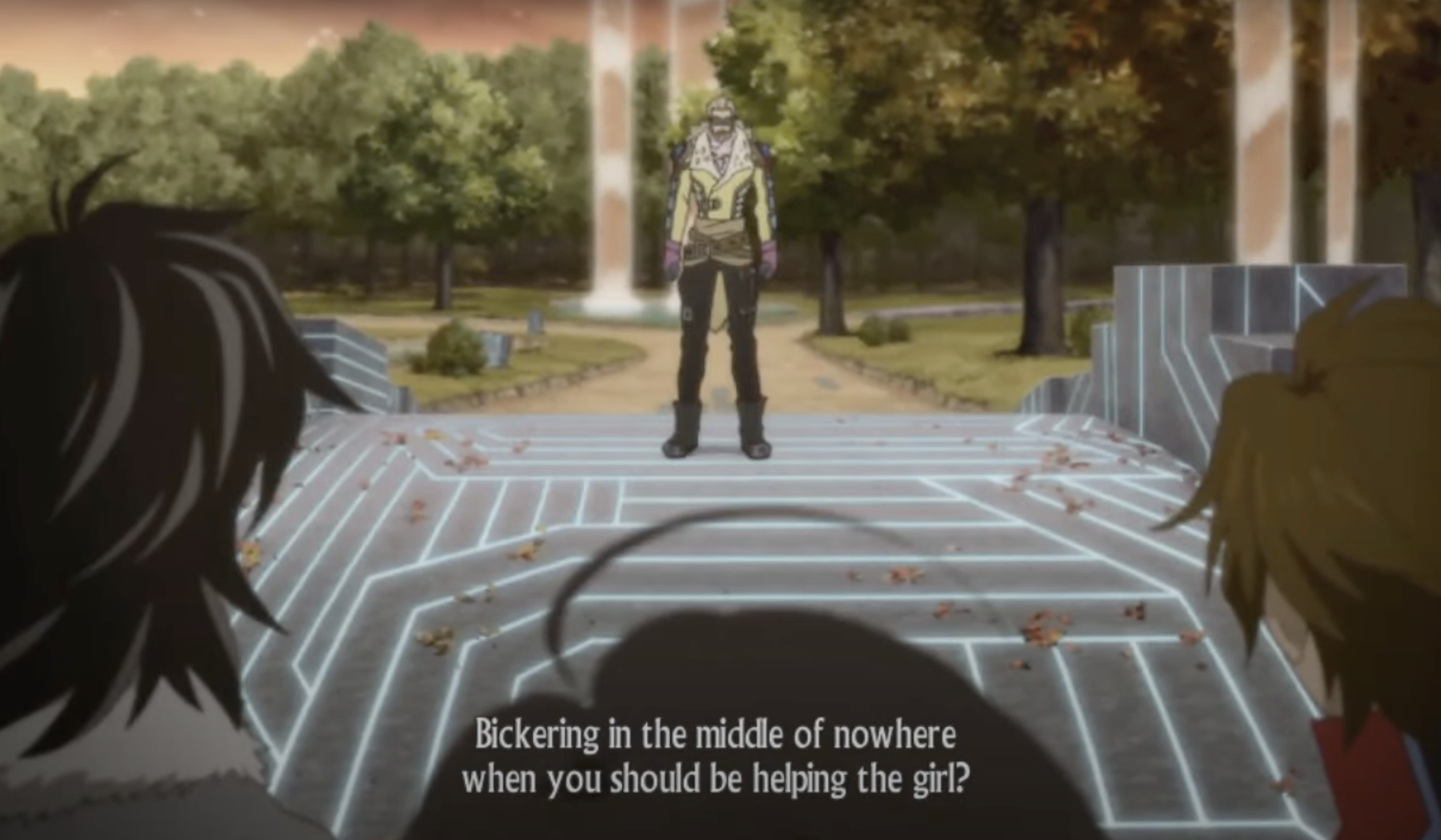
Gall introduces himself to the party through an act of motivational reorientation.
Gall’s modus operandi is the best possible application of a character that was added to a remake in which the major events of the plot remain unchanged. Look closely and you’ll see that Gall rarely makes anything happen directly through his involvement, which is what we’d expect given that the plot of Tales of Hearts R is broadly recognizable to Tales of Hearts players without him. Instead, he gives “native” characters the tools to channel their own motivations, greasing the wheels that advance the plot at moments when the key agents are too insulated within their current communities to bridge the gap to someone new. That’s what he gives to Ines when he tells Ines that her arms exist to hold Lapis when she wakes: she gains a new standpoint from which to pursue the enfranchisement of Lapis, one of support that bottoms out in her own actions rather than her or Lapis’ relationships with Azide or Perl.
This carries Ines not just through the defeat of Striegov and reunion of Lapis’ body and Core, but further through her formation of a new relationship with Lapis. Without a firm memory or antecedent bond with Ines from the time before she lost her Core, the awakened Lapis can look and see the effort Ines is making for her sake. When pirates kidnap Lapis shortly after she finally regains consciousness, Ines invokes the model Gall gave her, enduring the pirates’ blows to keep Lapis safe and assuring her, all the while, “It’s okay, Lapis! They can’t break my arms! […] I need these arms to cook for you! […] I n-need these arms t-to hold you.” Through these joint efforts of Ines and Gall, Ines steps into the role defined by the title she earns for rescuing Lapis, “New Mother: I’ll save the world for you, Lapis, you’ll see! A mother never breaks her promise!” Ines doesn’t replace Perl but instead takes on a new stance of motherhood that integrates her support of Lapis with the party’s mission to save Organica from Gardenia, in much the same way that she crafts her own, burnt version of Perl’s Pizza Tricolore in an attempt to forge her own connection with Lapis—a pizza that causes Lapis to propose taking up the cooking in their relationship, and a real recipe for a meal that refills the party’s Spiria Gauge, just like Annaberg’s Scarf.

Ines realizes a relationship of her own with Lapis after reconnecting her Core with her body, cooking for her, and standing up for her in the face of pirates.
This genuinely novel bond between Ines and Lapis confers autonomy to someone completely disenfranchised. Even after she awakens, Lapis is initially inert—symbolically represented by her inability to leave her room in the Hanselar Inn—because, even after she technically regains her consciousness, her only connections are with a past that no longer exists. Ines and Gall, synthesizing motive and structure, give Lapis a basis for extending her own inner life and historical relationships to a new world, strengthening the party’s bonds by “a lot” in the process, reflected in the mechanics of the bonds that govern which skills party members can share with whom increasing in numerical value. Thus, by leveraging every type of Somatic bonding they’ve developed throughout the game, the party can make the miraculous mundane: they bring to life a girl who may as well be an object, and they provide her with a community context that allows her to autonomously bond with others, sculpting a new life in a way that lives up direct and indirect networks of relationships.
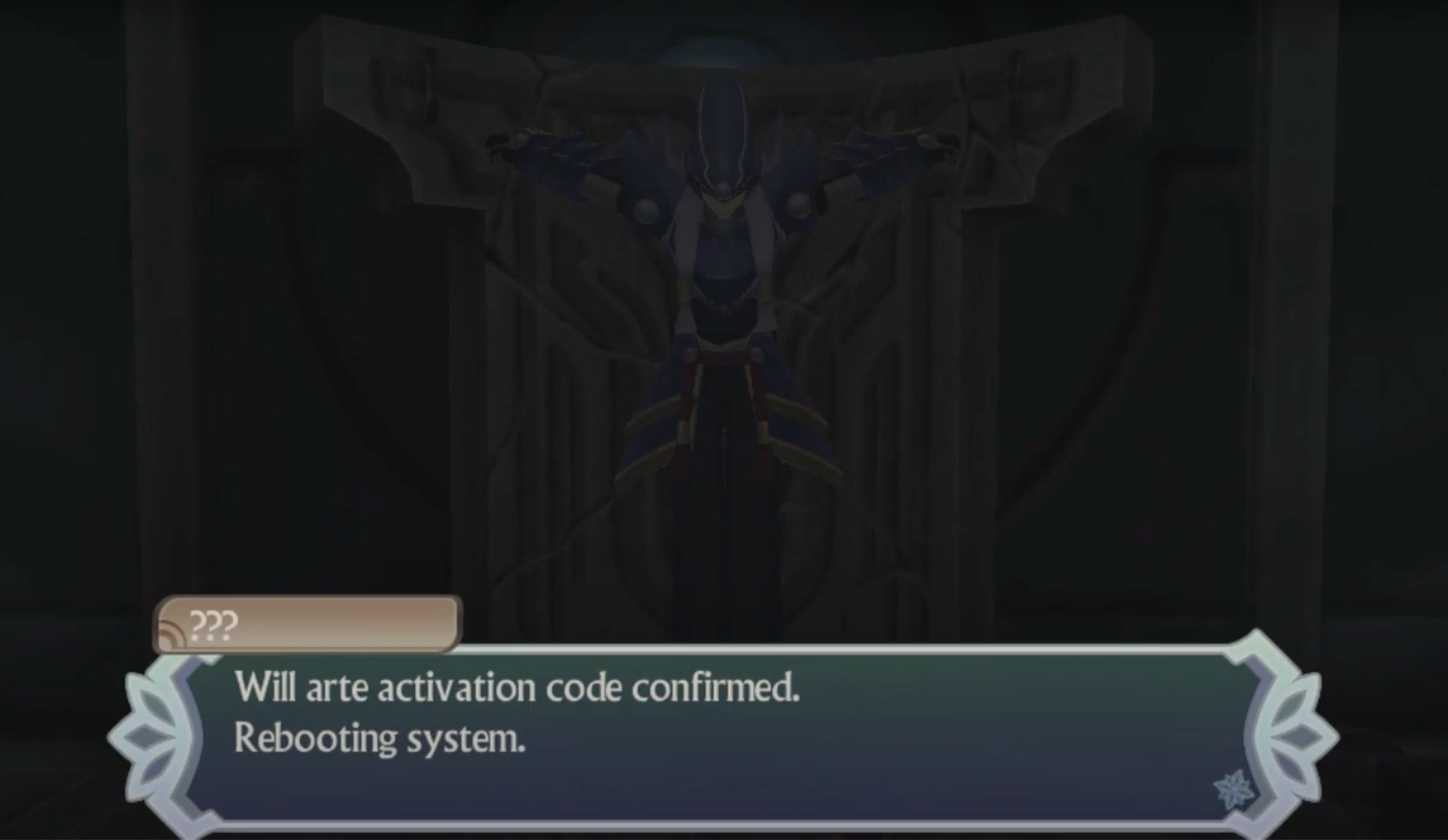
In Lignatore Garrison, Kunzite’s systems are activated after Kohaku senselessly recites his Will arte activation code—an act that engages Kunzite without fully enfranchising him as an individual, fittingly represented by his presence in the room being muted against a heavily darkened visual perspective in this moment of reactivation.
Even if the two cases seem superficially different, Lapis’ reanimation is functionally equivalent to the reanimation of Kunzite: an incantation like Kunzite’s activation code, uttered at him without an understanding of his intrinsic spiritual structure or cultural origins, isn’t sufficient to give him autonomy. To treat Kunzite as capable of representing himself as apt for connection, the party must facilitate his participation in novel bonds that bridge his encoded identity, his previous connections and sources of values, with the new persons who give him their attention and invite his own. That enfranchisement is only possible when a newcomer, with motives of her own, grasps the people who structured the artifact’s interpersonal connections in the first place—Lithia as Kunzite’s master; Azide and Perl as Lapis’ parents—and formulates a structure for her own bond that resonates with the artifact’s essence without reducing to those structures from which it was derived in the first place.
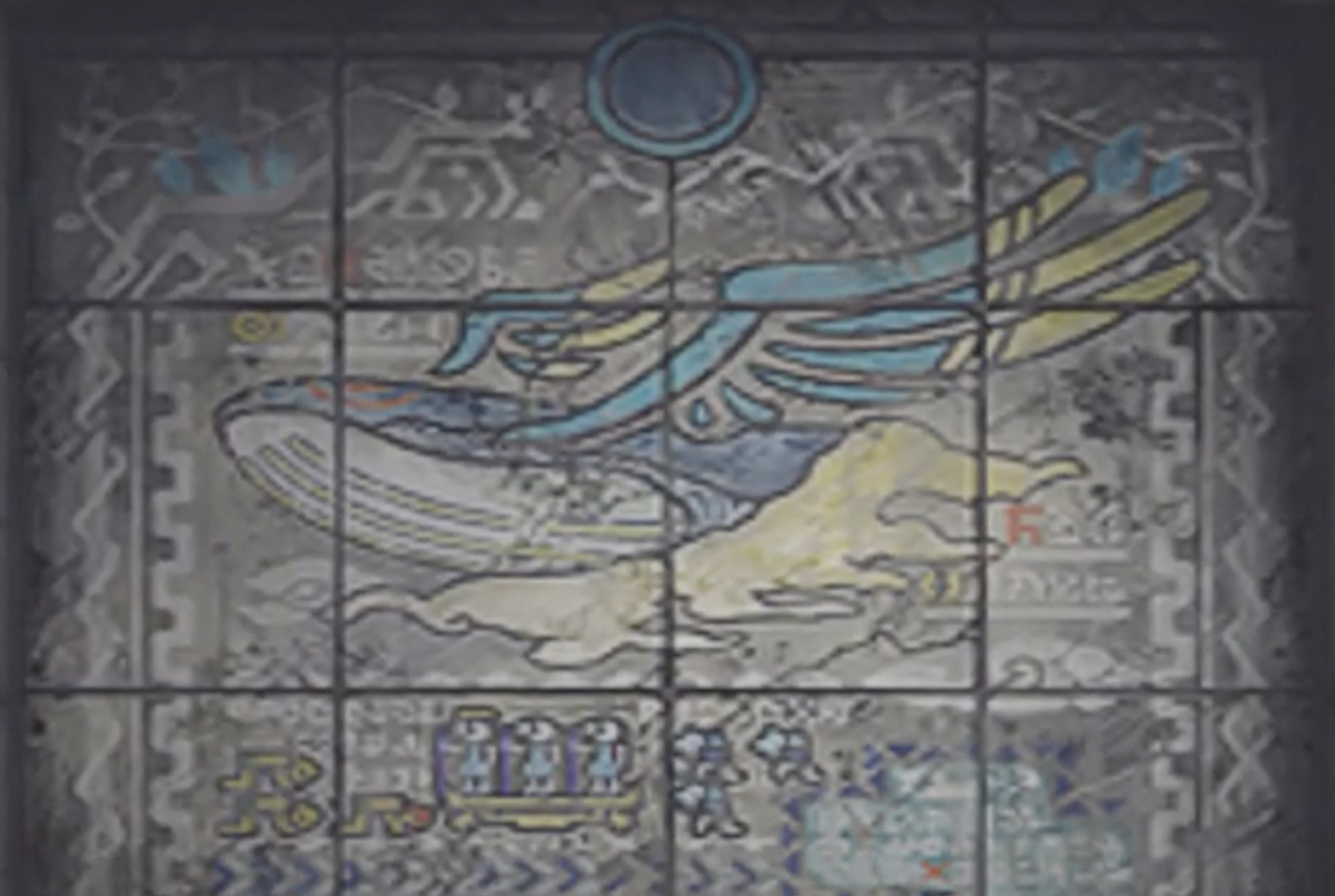
An illustration of the “winged whale,” Mysticete, from the Age of Stones, impressed upon the walls of the Anders Mine.
Now that we have a full model of how the coordination of motivation and structure can enfranchise inert artifacts, we can make the final move in extending Tales of Hearts R’s science of bonding to the reagent that globally mediates this kaleidoscope of reactions: fairy tales, histories, and other narrative interpretations of interpersonal activities across time. While the artifacts we’ve studied so far have had a physical constitution, like the canvas of a painting or the body of Kunzite, our analysis doesn’t recognize any conceptual distinction between these physical artifacts and the narrative forms of fairy tales like “Sleeping Beauty”: both are fashioned for a purpose by someone, both can communicate with those to whom they’re connected, and both can be hypostatized, given a reality that either imprisons or empowers those they touch (as we saw with histories like Iola’s). The key distinction is that because they are diffuse and non-physical, tales can touch, influence, and evolve with more communities across time and space than physically located artifacts, like a version of Benston’s last painting that people can consciously and unconsciously update with their own paints over time, like Beryl did when she added her grandfather and Baaryl to it.
Because these interpretations are artifacts, it follows from Tales of Hearts R’s metaphysics of agency that they can become autonomous, a life with values and perspectives unto themselves. Intuitively, this aligns with how we see these interpretations exert influence, react to the changing nature of the world, and accrue moral responsibility over the course of the story. The “winged whale” of Mysticete, for instance, transforms from a story symbolizing Fluora’s failed efforts to unify the worlds’ Spirias, into a holy symbol anchoring the religious practices of the Valentin Church, into an unholy terror from which Creed unleashes a xerom nightmare upon Organica, into, ultimately, a new fairy tale expressing the story and emotions of a princess dreaming among the stars. As this mythos metamorphoses to connect, inspire, and justify the actions of everyone from Minerans to holy warriors to modern-day Somatics to players of Tales of Hearts R, we ought to wonder whether there’s any substantive difference between the Spiria of this interpretive locus and the Spiria Core of Lapis: structured, inert, yet capable of animation and dynamic networks of communal impact based on the kind of attention others give it.

In the Anders Mine, the party initially identifies a wall painting as a representation of the winged whale, a symbol of the Valentin faith (left). Later, returning with Lithia after learning the history of Minera and Organica, they reinterpret the painting as telling the story of Minerans subjugating Organicans two thousand years in the past (right).
There is a difference, Tales of Hearts R tells us, but it lies in how the Spirias are perceived by others rather than in their essences. Because Lapis’ Core is the sort of concrete object that’s broadly understood to constitute a person, Somatics immediately see it as a Core. Its emotional structure, Spiria Attributes, and structure of relationships are its own, which is part of why it’s transparently grotesque for Striegov to ignore this obvious humanity. In contrast, a narrative interpretation presents itself to others through its structure, as if Lapis’ Core represented the structure of her parents’ relationships with each other and their child without representing the child herself. Consequently, it’s easy for people to reduce an interpretation to a mere structure through which to channel their agency, rather than engaging with the interpretation for its own sake and recognizing the other real people to whom it’s connected. The game points to this reduction as the source of interpretations’ undue and disenfranchising influence on others, while showing us the spiritual bounty we stand to gain by instead honoring interpretations’ intrinsic value.
The party’s two experiences of the ornate wall painting depicting the winged whale in Anders Mine illustrate the difference between treating an interpretation as a structure and as an autonomous entity. The party encounters this painting in two very different contexts: they first pass it during their journey to rebuild Kohaku’s Spiria Core on their way to reclaim Kohaku’s Shard of Shyness from Chalcedony and his platoon, and they can later opt to revisit it with Lithia on the way to Dronning in their mission to reach Mysticete’s Core, after Creed has reclaimed his body and is gathering energy to warp to Gardenia. On the first visit, with no conception of Mineran history, Beryl identifies the whale as “the winged whale, servant to the Valentin god,” underscoring the ethos of the church moments before their confrontation with representatives of that church; the second time they examine it, equipped with Lithia’s explanation of the interplanetary history of Organican subjugation at the hands of Minera, Kohaku instead calls the whale “[t]he flying Forest of Thorns,” pointing to the sadism of Minerans ahead of their journey into the Spiria Nexus of Mysticete itself.
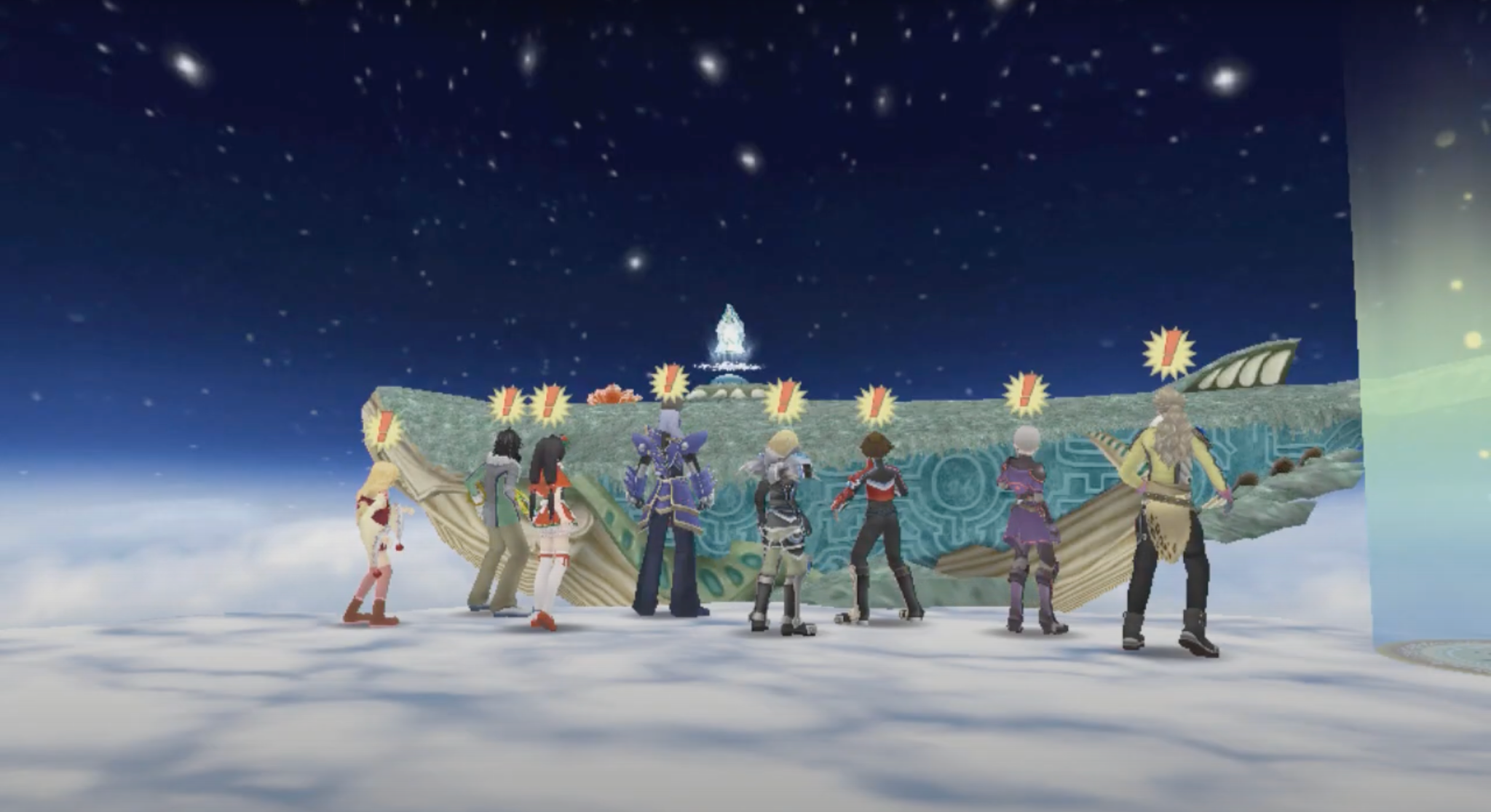
The heroes discover yet another interpretation of the whale within Mysticete’s Spiria Nexus, including a message from its architect, Fluora.
The danger of seeing this kind of interpretation of the whale’s history as some reified truth of how people in the world relate to each other is that, as Gall did with Ines, such a hypostatized structure of relationship can channel the motivations of others who don’t yet know exactly how they want to extend those motivations into relationships, preempting their agency and inviting them to passively recapitulate the interpretation’s content. In the fragile, nascent moments of the party’s relationship with Chalcedony, Paraiba, and Pyrox, the interpretation of the winged whale exerts pressure on the party (and the player) to interpret them as ‘the 13th Platoon’ and to see their battle with Chalcedony as a contribution to their ongoing competition against the church to collect Kohaku’s shards, impeding the formation of other, more intimate bonds based on both side’s actual interactions with each other. So, too, with later the interpretation of the Forest of Thorns. The fact that the party is more familiar with history during that second encounter does nothing to overcome this limitation: it predisposes Lithia and the party alike to infiltrate Mysticete as the object of totalitarian Mineran oppression which must be sunk back beneath Minera, setting them up for a reversal of their expectations when they discover a recording of Fluora expressing her hope that Creed, Lithia, and Organicans alike can join together in overcoming the threat of Gardenia.
When an interpretation is taken as a pure structure of relationships, it poses the same risk of solipsistic isolation as Gardenia and other xeroms. When we take a story to be the story of the world or some other communities, we lose sight of its authorship and surrender our agency, reducing ourselves to characters in a framework that’s completely immune to input from the interactions of real people. This, in the language of Tales of Hearts R‘s bonds and artifacts, is the basis for the immorality of hegemony, the authorship and imposition of a single societal narrative that aims to make every perceptible form of action for those within the society explicable within the terms of that narrative: with no vantage point from which to stand outside of the society and understand the artificial nature of that narrative, individuals can only gaze helplessly at the narrative itself, thinking they are seeing reality when they are actually giving up authority over their own motivations.
It’s no coincidence that this game’s story features a Maximus Empire that extended itself across Organica through a “War of Unification,” stamping out alternative governments like Loweland’s and alternative religions like Dronning’s to rob its citizens of any perspective through which to avoid hypostatizing its story as responsible, in Emperor Zirconia’s Creed-possessed words, for “bring[ing] about the advent of a world without war” and persisting indefinitely to maintain that world. Creed’s empire fails to bring about an end to war because it symbolically xeromizes its people just as Gardenia, born for the same reason, does to Creed—making it a foregone conclusion that soldiers of the Imperial Army would literally xeromize themselves to serve that empire’s tautological warfare even more “perfectly.”
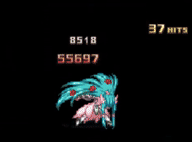
Within the interdimensional abyss of Hell’s Well in the original Tales of Hearts, prototype xerom Lithia Cattleya attacks the party in a bid to claim Lithia’s Spiria as its own.
This xeromization of a narrative has a clear, grotesque symbol in the original version of Tales of Hearts. In an optional dungeon only available at the end of the game, nowhere to be found in Tales of Hearts R, the party can plunge through a 50-floor, interdimensional abyss in Organica (“Hell’s Well”) and discover, at its heart, the first prototype for a xerom, Lithia Cattleya, who fed on countless xeroms over the last two thousand years in a desperate effort to fashion itself into Lithia Spodumene. In a game whose plot evolves along a dynamic telling and retelling of Litha’s fairy tale, the first xerom seeks to consume her Spiria to become its fixed image of her story. Its defeat is the final refutation of this interpretive hypostasis, an achievement only possible for the party after they’ve learned how to give life to a story that bonds with and empowers others rather than imprisoning them.
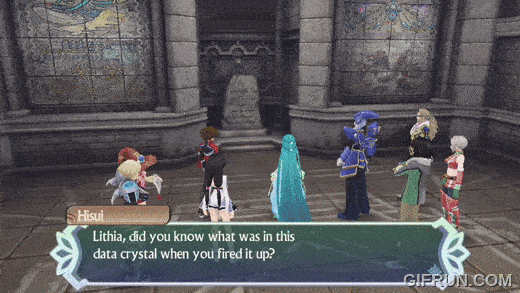
After the party defeats the xerom sealed within the painting, Lithia shares with them the note which the painting’s Organican creators left for those who came after them.
Beyond recasting the winged whale as the Forest of Thorns, the party’s second visit to the Anders Mine paintings also illustrates how to engage with an interpretation for its own sake: with Lithia’s help, the party explicitly connects the interpretation’s nature with its creators’ motivation for designing the interpretation. The painting, Lithia discovers, had a specific purpose for its existence: its Organican artisans sealed a xerom within it, along with a message to those who found it that the painting contains “proof of the true atrocious nature of our Mineran cousins, and of our terrible suffering. Our anger and bitterness shall never die,” they declare, and the painting itself functionally affirms this: a perfect metaphor for the artifactual nature of interpretations, it contains a hypostatized conception of Organican and Mineran history (a symbolic xerom) as an expression motivating a characteristic structure of relationship which the painting represents. Once this motivation is named, the interpretation becomes manageable, a discrete and connected Spiria Core which the party can evaluate in the context of its origins, enfranchising the interpretation rather than being unwittingly co-opted by it.
This enfranchisement unites two separate sources of motivation and structure, like the enfranchisement of Lapis, but it reverses the relative positions of each source: whereas in Lapis’ case the immediate agent connecting with her (Ines) provided the motivation and the agent more conceptually distant from the new connection (Gall) provided the structure, here the immediate agent connecting with the interpretation looks to the one that’s more conceptually distant for the motivation. When Lithia, after sharing the Organican artisans’ final message with the group, mournfully affirms that “you Organicans have every right to hate my kind,” Hisui, Ines, and Kohaku quickly rebuke her, reminding her that her Spiria is aligned with theirs in stopping Creed and that she is therefore “not the same as those ancient Minerans.” This new structure of the former Gardenian command core aligning with Organica against Creed and his artificial Spiria, combined with an awareness of the suffering that motivated the artifact’s creators, animates the interpretation with a life that’s greater than the sum of its parts: the party’s resolve to “crush the xeroms, for the sake of all the victims who came before us,” equips them to treat the story of the Forest of Thorns as the story of a vessel harboring the hopes of Organicans, Minerans, and mechanoids alike to rectify the spiritual void of Gardenia. This praxis of jointly enfranchising an interpretation explains how Lithia can let go of her abject guilt over the events represented in the painting yet still act in a way that essentially honors the suffering she caused: she and the party are using their relationships as a basis for connecting to a living story, the motivation of which comes from the victims rather than Lithia’s feelings of remorse. Thus, she can believe in herself and the current, positive emotions of the party without feeling as if she were ignoring her sins in the process.

Bolstered by the new exchange between her, Gardenia’s Mineran victims, and the story of Creed, Lithia can challenge Creed’s hypostatized self-concept at the heart of the ultimate xerom.
Once a story comes alive as the kind of thing that can represent itself as apt for connection, it can do what any Somatic can: establish and transform connections to those with whom it resonates. Those who’ve hypostatized relationships that resonate with elements of the living story can dislodge those hypostatizations by interacting with the story, thereby fueling the story’s continued emotional growth and establishing a new connection in the same way Kohaku (the living story’s analogue) does with her shard-bearers. That allows enfranchised stories to change the identities of those whom they take to be their authors and audience over time: like Kunzite, they have a fixed source in the people who animated them in the first place, but, also like Kunzite, they can change their natures according to what any connected individuals communicate to them, and they can convey any of those values within their nature to other connections. The artisans of the Anders Mine may have designed the artifact of the Organican perspective on the whale’s role in their genocide by Minerans, but that story of the whale, once animated by those Organicans and the party, can resonate with people like Fluora, calling for Lithia and Creed’s teamwork in stopping Gardenia within Mysticete’s Spiria Nexus. That expression of Fluora’s, in turn, leads the party to recognize within the story’s emotional development the unity of adversaries and express that value to others who touch it, such as the Seraph brothers gaining the structure to set aside their differences and resist Incarose Alt from within her own body. Like Kunzite, the primacy of the story’s initial “creators” and “audience” rapidly decomposes as it grows over time, instead forming new bonds—bonds where, as we’ve seen, the relationship of emotional author and recipient is essentially dynamic, trading off over time throughout the story’s emotional journey.
This Somatic mode of storytelling is the key to discovering the Spirias embedded within others and welcoming them into a broader community on their own terms. Return to the finale within Gardenia’s Core, where the party finds that the anemic Spirias of six billion Minerans really did survive within it. Earlier, I concluded that this nested structure of Spirias entails that our moral engagement with Gardenia for its own sake can pass through and have moral consequences for those nested within it. Now, we can explain that moral engagement in the more foundational terms of motivations, structures of relationships, and bonds.
When Creed hypostatizes his self-concept through the artifact of Gardenia, his desire for the generic warmth of love senselessly integrates the Mineran Spirias’ motivations of hope, survival, and love into Gardenia’s Core, imprisoning them as constitutive aspects of Gardenia’s isolated Spiria rather than treating them as autonomous entities apt for connection. With Gardenia’s entire inner life bent towards propping up the vacuous dream of filling the insatiable void within itself, any possible motivations these Mineran Spirias might espouse are channeled into reinforcing the xerom’s total, hegemonic structure, making Gardenia’s own heart a microcosmic recapitulation of the same interpretive control Creed exerted on Organicans through the hegemony of the Maximus Empire. It’s no wonder, then, that such disenfranchised Spirias would fade over time as their will to action consistently amounted to nothing.

The party’s Somatic bonds illuminate Gardenia’s Spiria Nexus and allow them to see the Spirias of the Minerans within it, along with the bonds that form between them thereafter.
Our heroes’ efforts in learning and practicing the science of bond formation pay off in Gardenia by providing them a vantage point from which to recognize that Creed is objectifying the motivations of the very Minerans he wants to save. Once they’ve seen Gardenia for what it is and conceptually connected it with Creed and the Minerans, they can free the Minerans from Gardenia by using their motivations to enfranchise a new narrative of Mineran history and Creed’s place in it, contradicting Gardenia’s inner life and unraveling its hegemonic hold on the Minerans and Creed alike. When the party first dives into Gardenia’s Spiria Nexus, they find themselves in a physical manifestation of Creed’s suffocating loneliness: in a vast abyss of darkness, each Somatic is isolated, “totally blind” and unable to even “tell up from down.” Only with their Somatic bonds, that interconnectedness so incomprehensible to Creed, can they illuminate the space and witness the wealth of Mineran Spirias all around them and hear their voices: voices expressing the sentiment that, even in the face of fear, they must “[not] give in,” “[s]hine on,” “keep the hope alive,” and “keep living.” The party members’ structured connections with each other in the present—a structure centrally invoked by Lithia, the fallen Mineran savior given a new family and context with which to redeem the world—render these expressions intelligible, preserving and transmitting those motivations that Gardenia only consumes.
When the party recognizes those Mineran Spirias as apt for connection—an aptness that’s realized before their eyes as those Spirias form Somatic bonds of their own—they can borrow those motivations to enfranchise a living story of Minerans’ persistent hope drawn from “helping each other” in the face of despair. It’s an extension of the growth we saw Lithia undergo in Anders Mine, now crystallized in her enlightened gesture of gratitude to the Mineran Spirias as she reaches her hands up towards them and calls out, “I am truly sorry for bringing this terrible fate upon you all. But in my remorse is immense joy, for you are all here and alive!” That new enfranchisement of a story in which the Mineran motivation has a clearly articulated function allows them to contribute to a new interpretation of Gardenia, giving Creed a new role in Mineran history that offers him the possibility of redemption. When Creed, fused with Gardenia’s Spiria, involuntarily absorbs Mineran Spirias, an act that is senseless from Creed’s perspective becomes an opportunity for Lithia to instruct him: she asks him, “Do you taste that on your lips, Creed? It is what you and Gardenia desire. Warmth. Affection.” Despite being drawn in against their will by Gardenia, this influx of Mineran Spirias can be read, through this new narrative, as an act of those Spirias embracing Creed, demonstrating to him the emotion he lacks and allowing Lithia to staunchly declare, “You want love! I know you do! This is the real you!”

Two instances of artifacts springing to life, indicated by the blue light crackling around them: Kunzite responding to Kohaku’s Will activation arte (left), and Gardenia collapsing in on itself following the loss of its Core (right).
The new story of Mineran triumph disrupts Gardenia’s hypostatized hold on the Spirias of all Minerans, including Creed. Its freshly enfranchised Spiria houses theirs within itself, depriving Gardenia of those six billion, muted souls that constituted its inner structure, leaving Gardenia to collapse in on itself at the same moment that the story sparks to life: a moment of animation represented by the presence of that same blue lightning we saw when Kohaku animated Kunzite (above). In conversation with this new story, Creed is finally able to conceptually distance himself from it and name it as “the darkness of [his] Spiria,” rather than a “copy of [his] own [Spiria],” as he’d described it prior to fusing with it and taking on its identity as his own. I think it’s the enfranchisement of this new story that makes possible the otherwise mysterious, Pietà-like return of Fluora’s Spiria in Creed’s final moments, despite Gardenia desperately, cruelly calcifying and reanimating her multiple times: as it did with the Mineran Spirias within Gardenia, this new story, by bonding to Fluora, inspirits her with the agency to sit with Creed. She “shine[s] on” with him and their Will wisps as they rediscover each other through the model of relationship borrowed from their fellow Minerans, transmitted to them by the story.
While Mineran Spirias, capable of surviving outside their physical bodies, are tragically ideal for being consumed by other, solipsistically hypostatized Spirias, they’re also a uniquely perfect substance to carry individuals through time and space within stories. This is what’s remarkable about the intersection of the characters, bonds, artifacts, and fairy tales of Tales of Hearts R: the people whose motivations give life to a story in the first place can thereby embed themselves within the story, staying alive and growing emotionally with the story over time as it evolves through exchanges of authorship and consumption across space and time. Like mechaknights, living stories don’t need to house their creators’ Spirias within their own, which is what distinguishes this tale of the Minerans from other stories like Organican history or the final chapters of Iola’s life, enfranchised through the coordination of Sapphire’s motivation and the party’s new structure of relationships: all such stories can bond their creators with their consumers, but only the duality of Mineran body and Spiria can ground the value of a story in a morally worthy character that is also the story’s creator, an entity from beyond its narrative limits. In most stories—as we saw in the histories of the last section, also enfranchised but with fewer longitudinal data showing how they evolve with their communities—the real people who brought them about only “live on” in present-day use of their motivations or structures of relationship; stories with Mineran Spirias can literally keep their creators alive for as long as the stories stay alive.
The nesting of Mineran Spirias within a newly enfranchised story, in my view, is what we witness when their billions of lights coalesce and with Kor and Kohaku to burst through Gardenia and back into the cosmos beyond its boundaries. It explains the sense in which those Spirias, “too weak to inhabit their original bodies,” can eventually “allow the white moon to be reborn as a brand-new world” through sustained Somatic bonds with Organica: it’s not that the physical Minera will overcome its calcification and become lush with greenery and natural life again, but rather that this living story of Mineran hope and love in the face of adversity, passing through many hands, will undertake its own emotional journey and grow as it passes through many communities and forms as fairy tales, legends, histories, fiction, and parables, fortifying those Spirias who motivated and constitute it in the process. These narrative forms are uniquely good hypostatizations because their inner structure, by virtue of essentially including the souls of those whose emotions inspired them, naturally invites those who engage with them at all to treat them as apt for connection, rather than as objects for solipsistic contemplation, and to endorse the reality of those who created them through the act of engaging with the story for its own sake. It’s what makes possible, and beautiful, Kunzite’s transformation into a living fairy tale, housing “Sleeping Beauty” in a form that allows her to really live out the kind of life to which she always aspired, with our help.
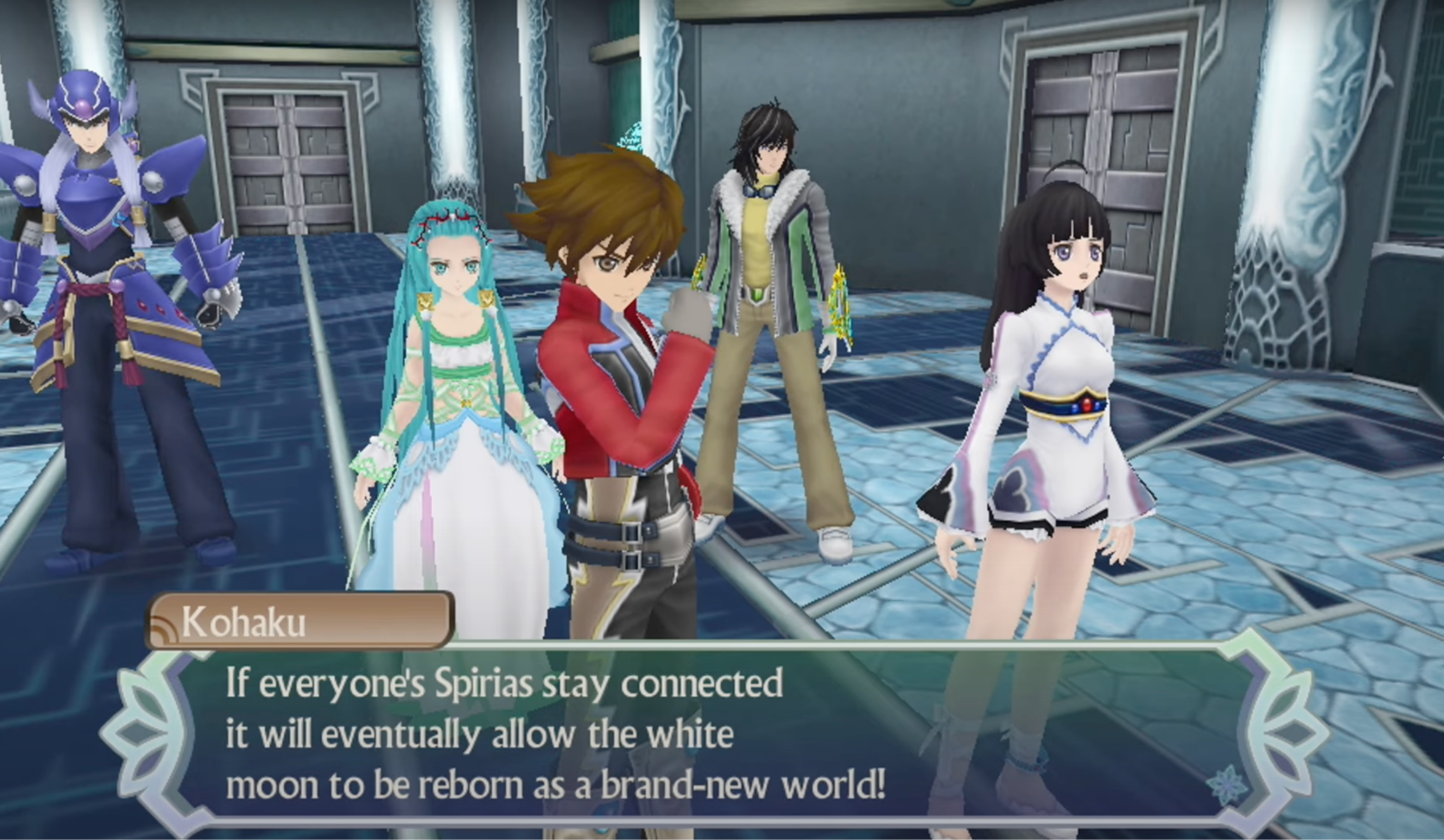
Kohaku, Kor, Lithia, Corundum, and the rest of the party look forward to a future in which Somatic bonds with the Mineran Spirias will give birth to a new world.
Our granular analysis of interpersonal chemical reactions in Tales of Hearts R has led us through the intricacies of story and back out to the macrocosm of our own engagement with the game. When we chart our own progress through the world by our emotional development, we can methodically achieve that process by helping others work through the relationships that are inhibiting their own growth, dislodging their hypostatized emotions and returning their attention to the relationships in front of them. This mode of open interpersonal address, representing ourselves and those towards whom we act as apt for connection, creates bi-directional channels of communication through which we can share our motivations for bonding with others, as well as the structures of community which those around us, and those who have come before us, have effected in their lives. In that practical environment, connection is contagious, durable, and flexible, equipping even those who feel alien to a particular community by virtue of lacking motivation or a model for relating to them to borrow what they’re lacking from one of their established bonds. That can allow us not only to indirectly connect to “friends of friends,” but also to coordinate our attention with others to enfranchise completely isolated people who have no conception of their own agency. And once we’ve mastered the practice of extending this emotional attention from ourselves, to those around us, to those spatially and temporally distant to us, and all the way back again, we can even animate the inanimate, bringing life and intrinsic value to artifacts, the human communities that touch them, and the fictional communities that inhabit them.
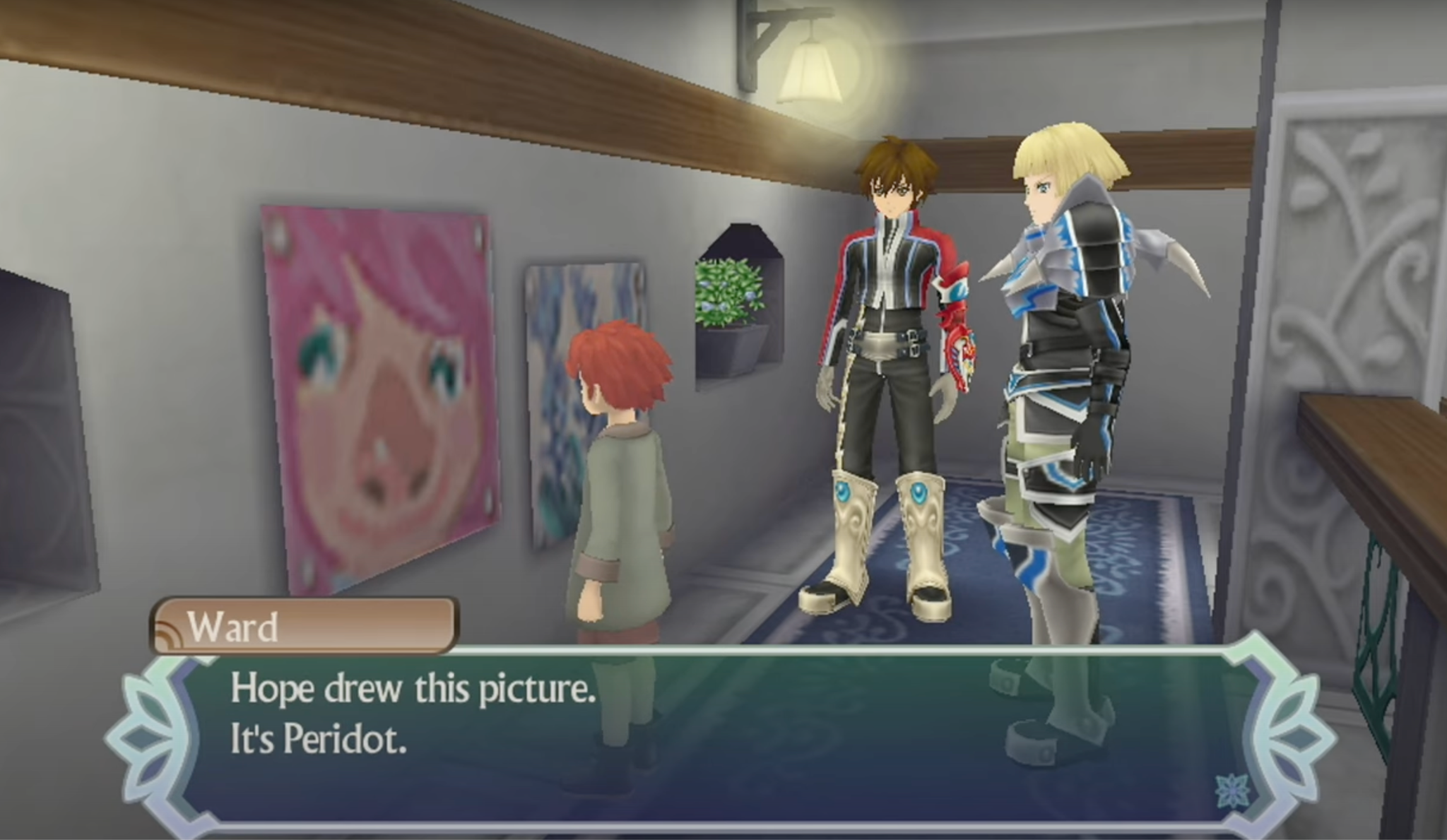
Ward, internally processing the death of Peridot before he can articulate it to others, reflects on Hope’s picture of her.
We’ve seen Beryl’s ethos animate the Spiria of artworks, and we’ve seen Chalcedony’s embody the multidimensional connections between Spirias. In one of its countless memorable sidequests, Tales of Hearts R puts these two themes into conversation: long after Beryl has taught the children of the Prinseur orphanage, where Peridot grew up, how to paint, the party returns to find Ward, the eldest orphan, standing in front of a picture his fellow orphan, Hope, rendered of Peridot. Watching him gaze at that portrait, Chalcedony is inspired to Spiria Link with Ward, confirm Ward’s suspicions that Peridot has died, and, with the help of Kor and Hisui, validate Ward’s ability as a big brother to support the rest of the orphans—a model of brotherhood in which Chalcedony also participates, assuring him that “a brother of Peridot’s is a brother of mine” and promising to help him look after his family. This vignette crystallizes the power of an artwork, a fictional representation of a person, to facilitate and participate in networks of bonds. Ward’s consideration of Hope’s motivation for drawing Peridot prompts Chalcedony and his friends to notice points of resonance between Ward’s current state and their own journey, dislodge his hypostatized fixation on the artwork by providing his Spiria with a model of relationship—the family model which they inherited, in part, from Peridot—to dislodge this hypostatization and equip him to forge a new connection with Ward, along with a new recognition of the intrinsic value of the artwork as a representation of Peridot that persists in conversation with those who tell and hear her story.
A playable fairy tale is the perfect vehicle for experientially conveying this praxis to someone, inscribing the value of this mode of connection within us by causing us to bring about such a network and interrogate its normative dynamics as we do. From our very first moments of placing the Tales of Hearts R cartridge into our PlayStation Vita, the most basic necessary systems for reaching the end of the game require us to channel our practical attention into the emotional lives of first one character, then many characters, then a fictional world, and ultimately the entire transdimensional community of fictional and real lives connected through the artifact our very playthrough has brought to life. Our enactment of the fairy tale of Lithia Spodumene’s life actually provides a complete fictional ground for sustaining her existence, representing her through an activity that embodies the essence of her identity: we players keep Lithia alive by playing a game that unites worlds under one Spiria, affirming the value of Lithia’s legacy beyond the sins of her past, and we provide a unique basis for the value of all relationships in the Tales of series in the bargain.
§3: The Value of Playing Tales of Hearts R
After our heroes defeat Gardenia’s Core, Creed uses his Will artes to warp them away to safety, leaving a final moment between himself and Fluora before the unbridled void of Gardenia consumes itself. As he lies dying in her lap, he notices the shimmering Will wisps he’d asked Incarose to collect for him: those spirits that sparkle in the presence of beautiful spirits, and an external mirror to those stars of Mineran Spirias he’d unwittingly imprisoned with Gardenia, within his own Spiria, for so long. Basking quietly in their warmth, he smiles, “I see it now. It’s so simple. It was always so simple, wasn’t it, my dear Fluora?”
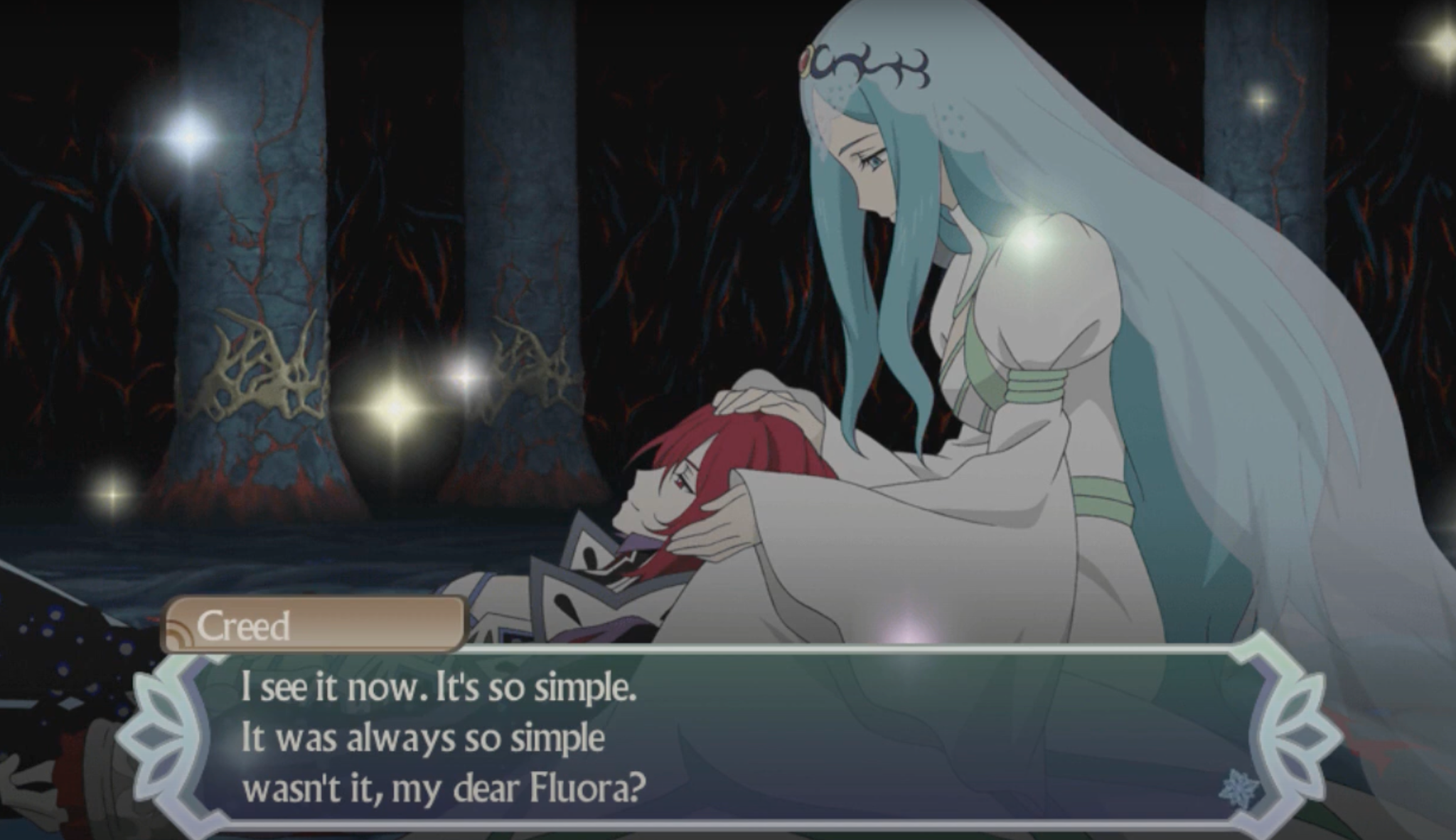
Dying in Fluora’s arms, Creed cherishes the Will wisps and reflects on how everything has always been “so simple.”
This final moment of Creed’s life—a crisp emotional insight after two millennia of complex, interplanetary, interpersonal plots—encapsulates one of the central values of JRPGs, the Tales of series, and Tales of Hearts R’s specific activity. The elaborate plotlines and fantastical mechanics aren’t in tension with “simple” lessons like the importance of emotional connection: rather, the precisely engineered intricacies of the game express to the player a practical context through which she can integrate that lesson into her life by interrogating its foundations at the same time that she enacts it.
The vital emotional, spiritual, and practical truths of our world aren’t the sorts of things that can be shared with someone else simply by expressing a proposition. If I don’t know the boiling point of water and you tell me that water boils at 100℃, you’ve taught me something new about the world: I understand something about water that I didn’t before, and if I have a way of heating and measuring the heat of water, you’ve given me a new way of acting in the world whenever I want to boil water. But there’s more required before your claim that “you ought to nurture emotional connections” becomes useful, or even intelligible, to me: I need to understand what emotional connections feel like and how to integrate them with my overall conception of my life so that I can recognize and maintain them; I need to grasp what kind of value they have and sufficiently understand my own value system to see why I, uniquely, ought to endorse and promote these connections; because connections are relational between people, I need a model for negotiating my value with those of someone else so that the overall connection can be fostered, rather than unidirectionally imposed by me upon others or vice versa. We need to arrive at these normative lessons from a first-personal perspective if we’re to take them up as tools of our own, and the interactive architecture of games like Tales of Hearts R gives that to us.
When Kunzite took Lithia within his Spiria at the end of Tales of Hearts R, the tears in my eyes were like Creed’s Will wisps: they indicated to me that my journey through the game had given me a first-personal understanding of the value of artistically mediated interpersonal bonding before I had the words to express that understanding to myself or others. I think that this is the same intuitive understanding that Tales of players experience every time they pick up a new game in the series and feel a familiar tone of warmth and beauty in it, as if they were having a new conversation with their oldest friend. It’s what we experience when we meet another player of the series and recognize a certain spiritual and practical attunement in the interest they show not only for the games, but also for our distinct experiences with those games. And in Tales of Hearts R, that same aesthetic structure to which we owe this intuitive practical development invites us to develop further by philosophically interrogating the journey we’ve just taken: by analyzing how these mechanics worked their magic within us, we can unlock a conscious framework for actively seeking out and benefiting from similar artistic and interpersonal contexts beyond the game. Uniquely at the bedrock of this game in the Tales of series, we find a character whose bond with us grounds a morally valuable network of interpersonal connection throughout all Tales of characters, players, and creators.
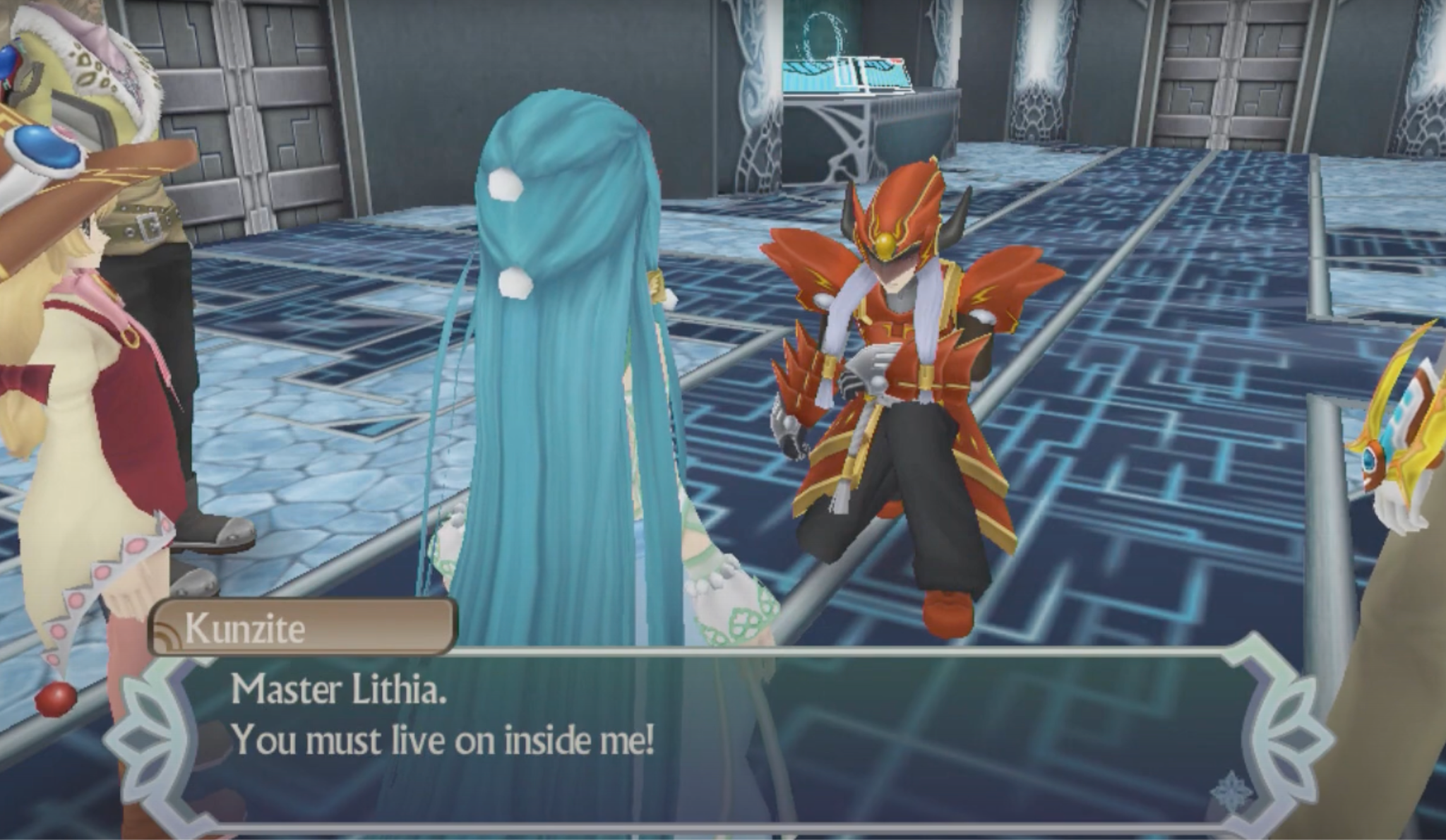
Kunzite calls on Lithia to enter his Spiria to live on beyond her body’s calcification.
After overcoming the guilt for the errors of her two-thousand-year-old past, atoning for the sins of her and Creed, saving the Spirias of her sister and the man she loves, and forming new bonds with the heroes of the present, Lithia is ready to give in to the calcification of her body and die. Her friends, on the other hand, want her to survive and enjoy the life she’s earned, free from all the pain of a past she was made to relive 388 times in the hellish narrative loop of Clinoseraph’s Spiria Nexus: they ask her to live on, dreaming, within Kunzite’s Spiria Nexus, with Kunzite himself declaring that “[i]t is my Spiria’s earnest wish to protect you until my body rusts into nonexistence.” As she sleeps within Mysticete, the party tells her, the winged whale will fulfill yet another function in the next evolution of its fairy tale: it will be a star in the night sky from which Lithia will continue to “watch over these worlds [she protected],” and which will carry “prayers […] of warm thanks” from people of those worlds to her. Lithia acquiesces to their wishes and enters Kunzite’s Spiria, ending the game with a retelling of the fairy tale that began Tales of Hearts R: once a veiled warning of Gardenia, now the story of a sleeping beauty enshrined within her mechaknight in the sky, voiced by the party members who rekindled Lithia’s will to live.
There lies a princess fair and dear,
who has slept for over a thousand years,
amidst a bramble of thorny spears.
The love of friends is a radiant beam,
and to them she grants a sword of dreams.
An ebony moon by the hero slew.
An ivory moon to be born anew.
The whale of legend still does fly,
but is now a star in the dark night sky,
to soothe the sleep of you and I.
The princess dreams in her forest of thorns,
The prayers of people her heart warms.
She is protected by her metal knight,
as twin stars shine out eternal light.
And she is always dreaming.
Dreaming her world will awaken.
We now have the resources to welcome the player into this fairy tale and explain how she and the characters, according to Tales of Hearts R‘s view, can mutually enfranchise and bond with each other. We’ve seen that artificial creations, like Kunzite and artworks, can house Spirias with the same autonomy, value, and capacity for connection as “natural” Spirias, and we’ve seen that these Spirias can nest others within them. We’ve also seen that such Spirias can nest others within representations of stories constituted by memories, as in the cases of the Seraph brothers and Zirconia, and these Spirias, as living stories, can enfranchise and facilitate bonds between those who create it, those who receive it, and those nested within it. Jointly, these theses give us the foundation to interpret the Tales of Hearts R game itself—that physical cartridge which we insert into our PlayStation Vita to engage with this fictional world—as a representation of Kunzite at the end of the game, housing his Spiria within it. As its player, we can chart a path across the game through emotionally structured mechanics because our PlayStation Vita functions like a Soma, equipping us with a method for navigating the fairy tale of Lithia’s memories according to the Spirias represented within it. Through our first playthrough, this allows us to discover Lithia’s ethos and sustain her by enfranchising her story; every time we engage with the Spirias that touch the game thereafter, through everything from another playthrough to studying its content with other players, we embody that ethos essential to Lithia by extending and enriching the structure of bonds sourced from her Spiria to further real and fictional worlds.
Tales of Hearts R is not an explicitly “metafictional” game: it does not break its fourth wall at the end of the story to tell its player she’s been engaging with Kunzite’s Spiria all along, and I’m not claiming otherwise. Instead, Tales of Hearts R‘s fictional model of bond formation and artifactual engagement gives us all the metaphysical and explanatory machinery necessary to justify our choice to interpret our engagement with the game in this way; and, by narratively guiding us through the enactment and analysis of that model, it offers us a view of interpersonal value that tells us we ought to interpret it in this way for the sake of the good this interpretation will do ourselves, the characters, and the community. We’ve seen why this is the case: once we’ve seen that the treatment of ourselves and others as apt for connection effects both the emotional understanding of communities and the emotional development of individuals, together with the corollary that the lack of such representation inhibits self-understanding and communal health alike, it follows that we ought to engage with the game’s story, that fairy tale, for its own sake, at which point the reality of Lithia’s Spiria, and all the interconnectedness it makes possible, follows.
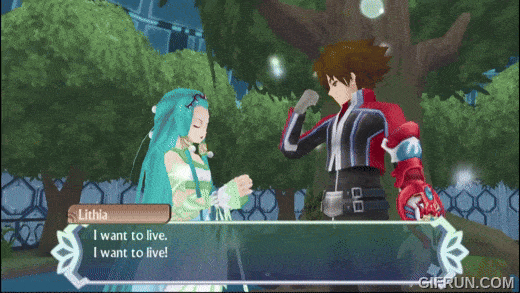
After Incarose throws Lithia from the top of Beanstalk, Kor Spiria Links with her, reignites her will to live, and forges a Somatic bond that cascades from them to the rest of the party, enabling their safe escape in Reinheit.
Lithia’s story frames Tales of Hearts R many times over. Hers is the fairy tale that introduces the game to the player and provides the words for the party to make a new sense of its conclusion. She is present within Kohaku in the story’s first scene—animating her struggle against Incarose from the standpoint of a history that has yet to be revealed to the Hearts siblings and the player alike—and her entry into Kunzite marks the party’s final moment together before the end credits. Throughout the game, she seeks atonement, redemption, and validation through the party’s transformations of her fairy tale: first running from her sins by hiding from Creed in a cat-and-mouse game with their human hosts, then by supporting the new era’s heroes in defeating Gardenia to bring closure to the legacy of the past, and finally by trusting in everyone’s love of her, admitting to Kor in her moment of despair that she wants to live—putting her in a position to rediscover the loving bonds with Fluora and Creed they had lost so long ago.
Lithia is like a version of Lapis who stole her own Spiria Core away from herself: not merely separating her Spiria from her physical form, but also disenfranchising her Spiria by allying with Creed and his misunderstanding of his inner nature, rather than with her sister. Millennia later, she believes in the ethos of Fluora and Somas, but the burden of her sin walls her off, rendering her Spiria inert as Chalcedony’s and Paraiba’s once were toward each other—yet all the more completely in Lithia’s case, with no other Mineran left alive except Creed with whom she could relate. This is why she needs the party’s agency to bring the world’s Somatic bonds to life and to awaken her capacity to participate in these bonds. In every way but participation in combat and map navigation, Lithia becomes a fully-fledged member of the party—participating in skits, cutscenes, deliberation, and key actions—but she needs the spiritual praxis of Somatics to enact a world that embraces her rather than simply forgiving her for the past, giving her the possibility of an identity beyond her sins. She needs the agency and moral attention of a player who will celebrate her value in a different kind of story: actively reshaping the Spiria of her history as she and the party do for the other Mineran Spirias in Gardenia, and strengthening her Spiria over time by the same mechanism of enfranchising and retelling that story.
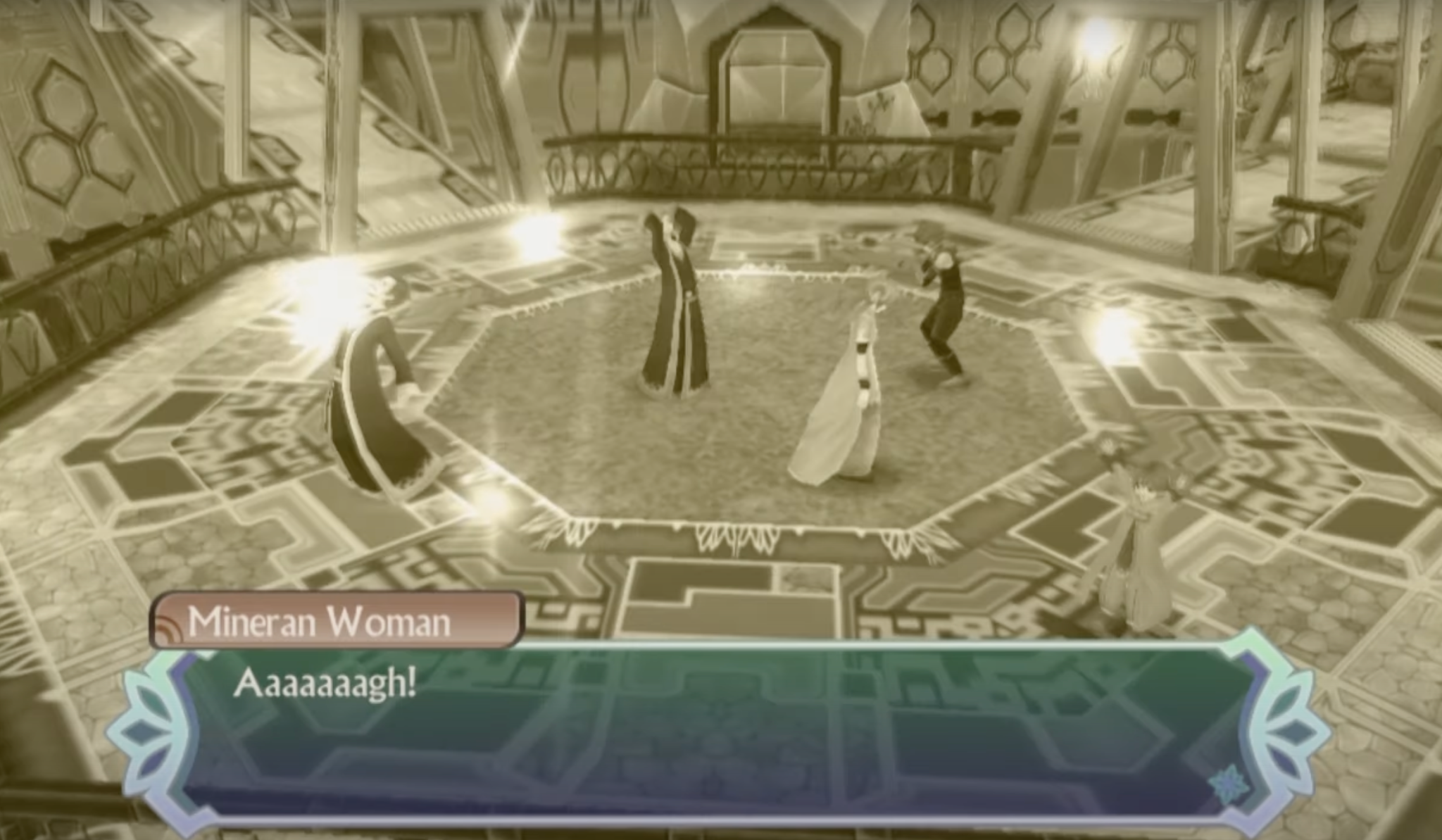
The still image of Minerans losing their Spirias to Gardenia, which haunts Lithia, and us, multiple times across the course of our journey.
The combination of Kunzite’s structure, Lithia’s memories, and the player’s agency effects the precise form of action that characterizes Sleeping Beauty as we understand her at the end of the game, in the final retelling of her fairy tale: always dreaming that her world will awaken, spiritually bolstered by the warm prayers of the people she watches over from within her metal knight. Because the game’s story which constitutes the structure of Kunzite’s Spiria Nexus derives from Lithia’s own experiences of being discovered and redeemed by Kohaku, Kor, and their friends, our unconditioned effort of reaching out to play the game—like the unconditioned effort of Ines reaching out to Lapis’ Core—is channeled through the structure of those Spirias and network of connections which restored to Lithia the autonomy and faith she’d denied herself. Thus, the form which the mechanics of Tales of Hearts R gives to our efforts—like the form which Gall’s relationships give to Ines’ outreach to Lapis—derives from Lithia’s renewed faith in the possibility of a richly interconnected world, which our agency validates by making those connections actual over the course of a playthrough. The structure she gives to our navigation of Kunzite’s Spiria Nexus is based on Lithia’s belief of how her world could be—a perpetual dream that her world will awaken from within her metal knight, the game—and, by that same token, casts our engagement with the game as expressions of endorsing and emotionally realizing her worldview—those same warm prayers necessary to sustain her dream. And, once we’ve enfranchised the Spiria of Lithia as a character within the game, we can look to the game’s overall framing as her new fairy tale and discover the second nature of Kunzite’s Spiria, the game’s Spiria, as a living story which we have also enfranchised by coordinating (1) Lithia’s motivations for creating the artifact of her fairy tale by entering Kunzite’s Spiria and (2) the structure that our unique pattern of investment in the many characters of the game, the many Spirias represented within that fairy tale, has imparted to those motivations through a playthrough which thereby contained emotional complexity over and above what Lithia knew from her memories alone. This is the miraculous inner meaning of Lithia’s world actually awakening, our prayers making her dream a reality: the very gameplay system within which Lithia represents her soul allows her to execute the seemingly circular act of bringing herself into existence by bringing the entire structure of community to which she has committed herself into existence, uniting the past family that motivated her story with the present and future families she finds in those who consume and enact her story.
What keeps this miracle from actually being circular is the core message of Tales of Hearts R, and the mantra that makes it the quintessential Tales of game: we can enfranchise ourselves by opening ourselves to the possibility of someone else attending to our story on its own terms. This is how the ontology of a Tales of game establishes and transforms vast networks of Somatic bonds across time, space, fiction, and reality through one foundational act of discovering, witnessing, and validating a character that believes in a world beyond our own. In my view, that’s what’s happening in that final moment before the game’s storybook credits when the party tells us that Lithia is dreaming her world will awaken, presented in black text against a white background, exactly as Lithia’s words appeared when Organica overflowed with Somatic bonds after Paraiba’s public address: our enfranchisement of her story has awakened her world by Somatically bonding it with our real world and many other fictional worlds, a white bond that spills out of our PlayStation Vita and into our broader interpersonal cosmos.
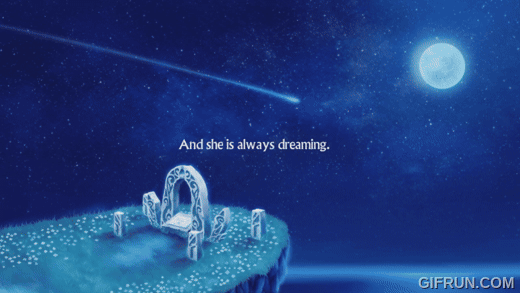
The final words of Lithia’s new fairy tale, voiced by the party members, which marks the transition of the game to its storybook-style credits.
It’s uniquely possible in Tales of Hearts R for this final Somatic bond to bridge the gulf between real and fictional worlds because, according to the metaphysics of the game’s fiction, the player and Lithia are both Minerans. Like Lithia, we players have the distinctly “Mineran ability of separating body and Spiria” which Lithia uses to inhabit Kohaku’s Spiria Nexus and to act as a command core for Reinheit, Mysticete, and Gardenia: every time we pick up our PlayStation Vita and dive into the game’s artificial Spiria, we commit the high-level Will arte of channeling our own Spiria, our spiritual essence, into the inner life of that vibrant other world, even as our physical form remains planted beyond it. That allows us, by the fiction’s laws, to spiritually enter that fiction while maintaining our presence in reality, like the Mineran Spirias carried out of Gardenia and into a fairy tale, even as their bodies rest on Minera beyond it. And thanks to Lithia’s spiritual growth that motivated her architecture of Kunzite’s Spiria Nexus, we avoid the pitfalls of her own time as a command core: that same gameplay system of Spiria Attributes which we studied as our first point of access to Tales of Hearts R positions our own Spiria, as players, to direct our party members’ development in ways that enhance their emotional autonomy through our resonance with them, requiring us to execute the functional equivalent of recognizing and nourishing Kohaku’s shards to progress through the game. And because these representations of her friends within Lithia’s memories, simulated in Kunzite’s Spiria, are artifacts of Lithia’s design, we animate an emotional bond with Lithia when we animate these characters for their own sake, as Kohaku’s Will activation arte did with Kunzite.
That structure of emotional dependence means we come to understand and enfranchise Lithia through twenty hours or more of reconstituting Kohaku’s Spiria, thoroughly feeling our way through her identity well before Lithia ever physically manifests and expresses the history she’s fashioned into a prison of guilt for herself. And as we find our emotional bearing within the game, our real inclinations allow us to give life to Lithia’s identity with a structure beyond her history. Wherever we find our attention settling as the game opens its systems to us, we find an opportunity to actualize emotional content grounded in, and related to, Lithia:
- An interest in cosmetically accessorizing characters leads to Hisui acquiring cat ears to wear and give Lithia an experience of the cats she loves unencumbered by her allergy, acknowledging Lithia’s unique passions and supporting her budding romance with Hisui, awakening a cat- and Lithia-themed Soma form for him.
- An interest in optimizing the battle performance of Kor fortifies the strength of his Soma and Spiria against the presence, and then absence, of Creed, giving him the emotional strength to forgive Creed and showing Lithia how to rework her past and do the same.
- An interest in hunting down every small, optional moment leads to quiet conversations like Kohaku speaking to his mother at her grave and telling her that he gave her Soma to Kohaku, leading to an emotionally incomplete Kohaku quietly remarking that “[t]his Soma is warm” and feeling a structure of Kardia’s relationship before she can name it, a way of relating to Lithia and her place in the world through her mother’s friend rather than Lithia’s inner spiritual counsel.
Our honest attention from our own Spiria and prior models of relationship sculpt our real Lithia within our Kunzite through a reactive constellation of structures and motives unlike any other, giving us the perspective to know her beyond the sins of her past even before she has explained them to us.
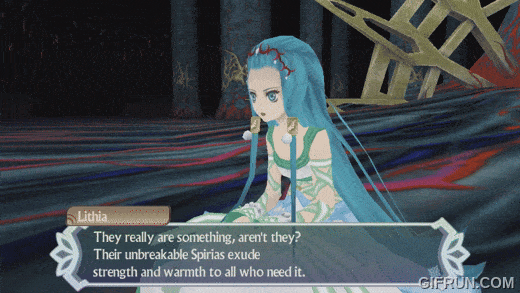
Lithia reflects on the lessons Kor, Kohaku, and the others have taught her, in a final moment of spiritual reunion and rectification with Fluora and Creed.
When Lithia expresses her story to the party for the first time, the player has already established enough real structure in this way to make the evolution of her story logically possible, seeing her expression as a motivation for her story—a motivation of guilt—rather than the fact of the matter about the world’s past. That’s why it’s a foregone emotional conclusion that Kor and the rest of the party do relate to Lithia’s Spiria and interpersonal network even when Kor, still resonating with Creed’s emotional solipsism, rejects the possibility of connection: before Zirconia’s memories reveal the connection on the level of historical interactions, we feel the bonds’ presence because the structure of Kunzite’s Spiria, the game cartridge’s programming, has led us to make those bonds the case. Through this exchange of Lithia and the player’s real motivations and relationship structures, in conjunction with the bonds made possible through the real enfranchisement of the characters represented in her memories, Lithia creates a new Spiria for herself non-circularly, dislodging her reified history and finding her way back to her bonds with her sister and Creed. The player’s real and honest attention to Lithia’s complete universe thus proves the moral power of bond formation by rectifying the original fracture between these three friends: the fracture that expanded to wall off everyone’s emotions with hypostatized concepts that leads people to treat themselves as static artifacts inapt for connection is healed through someone emotionally engaging the whole world as an artifact that is apt for connection, passing their agency through it all the way to Lithia and back again. We replace the Radial-Dream Will arte, a picture that held the world in disconnected captivity, with a new dream of perpetually active, creative connection.
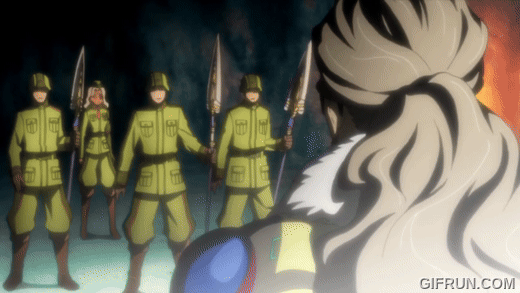
Gall passes his Soma on to his comrades from his home dimension after returning through the Triverse Gate.
Once we recognize the emotional autonomy we bring to Lithia’s world, we’re naturally positioned to view the game, Kunzite’s Spiria Nexus, according to two descriptions that bridge our reality with hers and send bonds outward across two worlds. Spirias like the fusion of Creed with Gardenia and the story of Minera’s demise within Clinoseraph teach us that one Spiria Nexus can fall under multiple ontologies: the Creed of the final battle is an artifact and a natural person; Clinoseraph traps Lithia within the heart of a mechaknight and a never-ending nightmare of a story. When a Spiria is an artifact that has agency and interpersonal connections both to the world that fashioned it and the artificial world into which it was created, we analyze its attributes as grounding bonds that reach into both of those worlds, like Kunzite’s “Loyalty” pointing to his origins in Mineran creators, the new bonds he’s extended into his life in Organica, and the synthesis of the two in his relationship with Lithia. Just so, when we step back and look at our journey through Tales of Hearts R with our PlayStation Vita, our efforts to enfranchise Lithia’s story by bringing the characters of her memory to life cascade outward in two directions, giving life to the deeper fictional world that made Lithia’s fashioning of Kunzite possible and the broader real world that made Bandai Namco’s fashioning of our cartridge possible. By discovering, enfranchising, and connecting those two worlds, we can channel the spirit of Gall in the final, optional conclusion to his story, where he returns to his home dimension after the conclusion of his adventure across Organica and Minera: he takes off his Soma and passes it on to his comrades, telling them to “[c]all it a souvenir from the other side.” Just so, we can transform our Vita into a practical souvenir from our time in Tales of Hearts R, a mode of action we apply to our journeys through other fictional and real communities.
On the one hand, once we’ve finished our first journey through the game and enfranchise the fairy tale motivated by Lithia, whose separable Mineran Spiria is embedded within Kunzite’s, we’ve indirectly enfranchised the fictional world beyond Kunzite’s Spiria Nexus, the “real” Organica and Minera where Lithia was born and where the events of her life actually happened. It follows from our analysis that, as players of Tales of Hearts R, we never actually engage with Organica and Minera per se: rather, we involve ourselves in Lithia’s memories of her life sustained in Kunzite’s Spiria Nexus, in the same way that the party explores a memory of Cind’rella, different from their present-day Cinrd’rella, within Clinoseraph’s Spiria Nexus. But the content of Lithia’s memories implies the existence of a world beyond those memories, the real Minera and Organica on which she had the experiences she now remembers. We can’t know exactly how those original experiences of Lithia’s compare with the memories we enact in the game—and, because of the structures of relationship which we impart through our agency, we can be confident that her memories aren’t identical with the experiences from which they’re sourced—but, like our heroes kept Iola alive by using her characteristic structure of relationships to formulate a new community in their own context, we can effect the emotional reality of that past by contributing to the structures of relationships which Lithia has taken from it, the very same structures that constitute the emotional organization of Kunzite’s Spiria Nexus. Consistent with the game’s ethos of our concepts being useful as tools for emotional connection rather than concrete objects with which to limit our agency, Tales of Hearts R rejects the view of historical events as an objective, mind-independent sequence of cause and effect in favor of viewing history as a reality that’s fixed by the emotional and spiritual content our current relationships take from it. In this sense, our engagement as a player with Lithia’s emotional essence really brings her fictional universe to life, a “radiant beam” our praxis of friendship shines back upon her with the “sword of dreams” she extends to us through the game’s systems.

Diagram of a lithium-ion polymer battery, which discharges energy to machines through the movement of lithium ions from an anode, typically graphite, to a cathode by passage through a polymer electrolyte, often polyvinylidene fluoride. (Authors: Vo Pham Hoang Huy, Seongjoon Su, and Jaehyun Hur. Source.)
On the other hand, just as Lithia’s motivation for telling her fairy tale points to her fiction’s relationship to Kunzite’s Spiria Nexus, our use of structures of relationship formation from our real life points us to the broader networks of real-world relationships that created the cartridge for Tales of Hearts R. In the context of a game grounded in the symbolism of interpersonal chemistry, the physical materials through which we engage Lithia’s memories justify the continuity between Tales of Hearts R’s fictional and real ontologies. When we sit down to channel our Spiria into Kunzite’s Nexus and Lithia’s memories, we call up content encoded on chips of silicon, the element that is both largely responsible for the semiconductors of modern computing and part of the chemical basis for the namesakes of the two mechaknights who house interactive memory environments within their Spirias, kunzite (LiAlSi2O6) and clinochlore (Mg5Al(AlSi3O10)(OH)8). To extend our agency into the world of this data, we power our Soma, our PlayStation Vita, through a lithium-ion polymer battery that discharges energy through the process of moving lithium ions away from an anode, typically made of graphite, to a cathode by way of a polymer electrolyte, often polyvinylidene fluoride—only for the lithium ions to move back to the graphite during the recharging of the battery to start the process over again. In effect, like the names of Tales of Hearts R characters point to their nature, the material process of our activity describes the player animating Kunzite’s Spiria Nexus through the motive force of Lithia constantly renegotiating her bonds with Creed through the intermediary of Fluora. The process reveals our real-world activity as a recapitulation of Kohaku’s praxis on a global scale: animated by the motivations of Lithia, we, the one organic presence in the act of gaming (like the organic constitution of amber), locate those representations within the game with which we resonate and bring them to life as part of our journey, enfranchising Lithia’s story in the process.
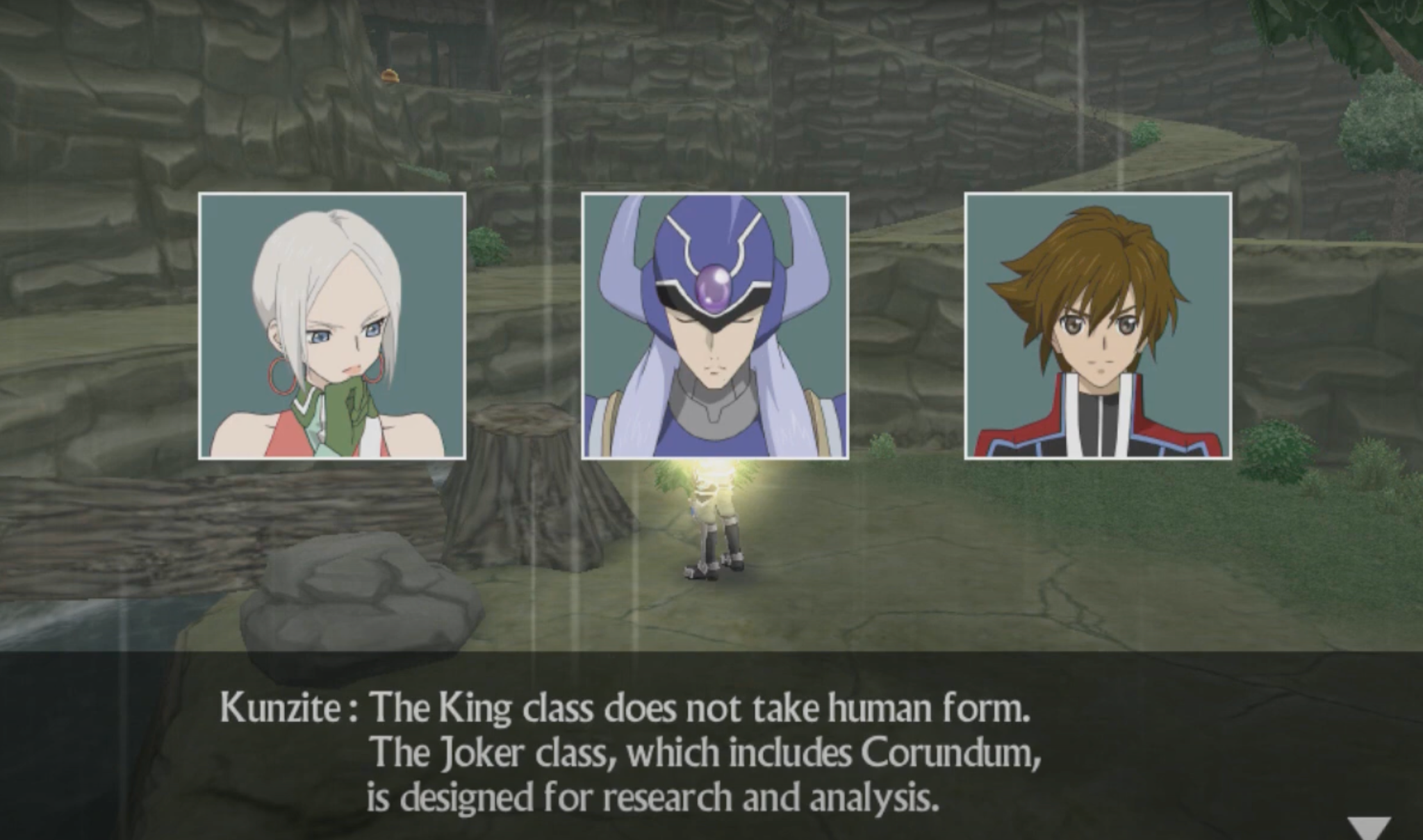
In passing while briefing the party on classes of mechaknight, Kunzite mentions the King class, an otherwise unidentified class that “does not take human form.”
So tight is fictional ground for the real activity of playing Tales of Hearts R that we might consider our PlayStation Vita, loaded with the game cartridge, the elusive “King class mechaknight.” After the party battles Chlorseraph for the first time and Kunzite provides them with background on the distinctions in classes of mechaknight, he refers to this class, which we don’t see discussed elsewhere in the game, simply as a mechaknight that “does not take human form”—and because each class of mechaknight specializes in different functions and the others operate in the domains of basic menial labor (The Numbers), all-purpose utility (Jack), Will artes (Queen), research and analysis (Joker), and combat (Ace), the King class serves some other, unnamed purpose. With no further context for the King, it strikes me, at least, as a useful interpretive choice to imagine Kunzite evolving from a literal Jack of all trades, an embodiment of the broad potential of the human Spiria, into a King class system that actualizes that potential on a cosmic scale, giving life to a universe of Spirias with the help of the player’s enfranchisement of his master, Litha—a macrocosm of how Lithia brought his personal artificial Spiria to life.
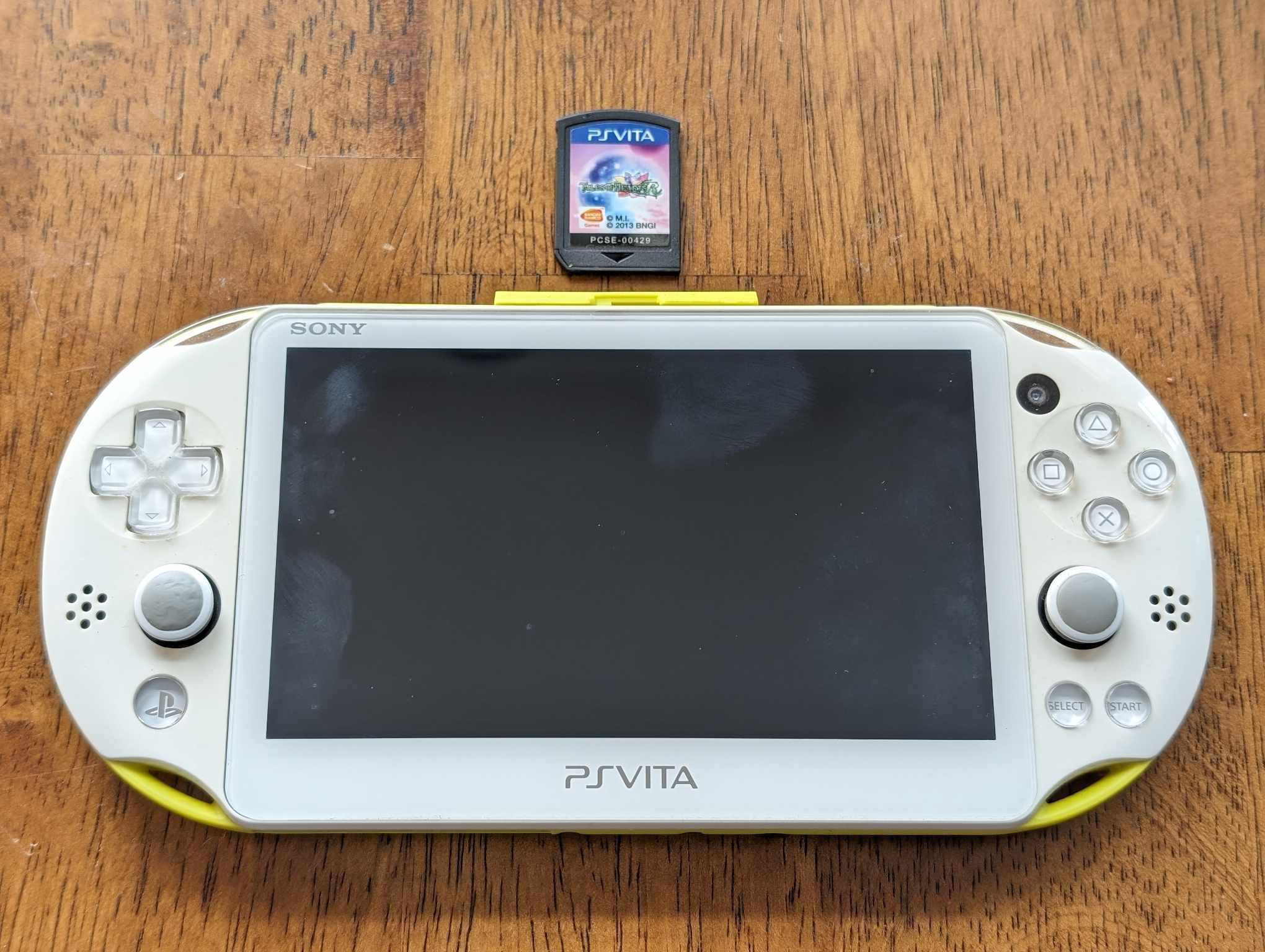
A representation of Kunzite’s Spiria housing Lithia—the Tales of Hearts R cartridge—and the Soma with which we engage it—the PlayStation Vita. Photo by author.
Because this real-world artifact of the game cartridge and system comes into view purely from our attention to the game’s fictional world, we have a unique reason to attend, as a part of our fictional activity, to the real people beyond ourselves who create and consume that artifact. The metaphysics of artifactual enfranchisement within the game tells us that Tales of Hearts R‘s autonomous nature only emerges from the interaction between the structure of relationships we bring to our involvement and the motivations the creators contribute to the artifact’s expression, and vice versa, evolving like a conversation as our playthrough progresses. Therefore, like Beryl’s engagement with her grandfather’s last painting, we can only interact with the artwork for its own sake, representing it as capable of representing itself as apt for connection, if we attend to the value its creator has ascribed to it, along with how we respond and add to that value in ways that honor both the artifact’s intrinsic nature and its relationship with its creator. Hisui supports Kunzite’s autonomy through acknowledgment of Lithia’s relationship with his Loyalty Spiria Attribute; Beryl transforms the painting’s Spiria by painting the model of her own relationship with its creator into it to complement Benston’s motivation of painting it in order to communicate with her; we give Tales of Hearts R a life of its own by looking at Lithia through her foundation in the first name of the game’s storybook credits, Mutsumi Inomata, the real-life designer who sculpted the Spiria Cores of Lithia Spodumene and so many other characters across the Tales of Series—the creator whose presence in the game is the very next focus of our attention after the cast concludes Lithia’s new fairy tale with her dream that “her world will awaken” and a Somatic bond spills out into our real world.
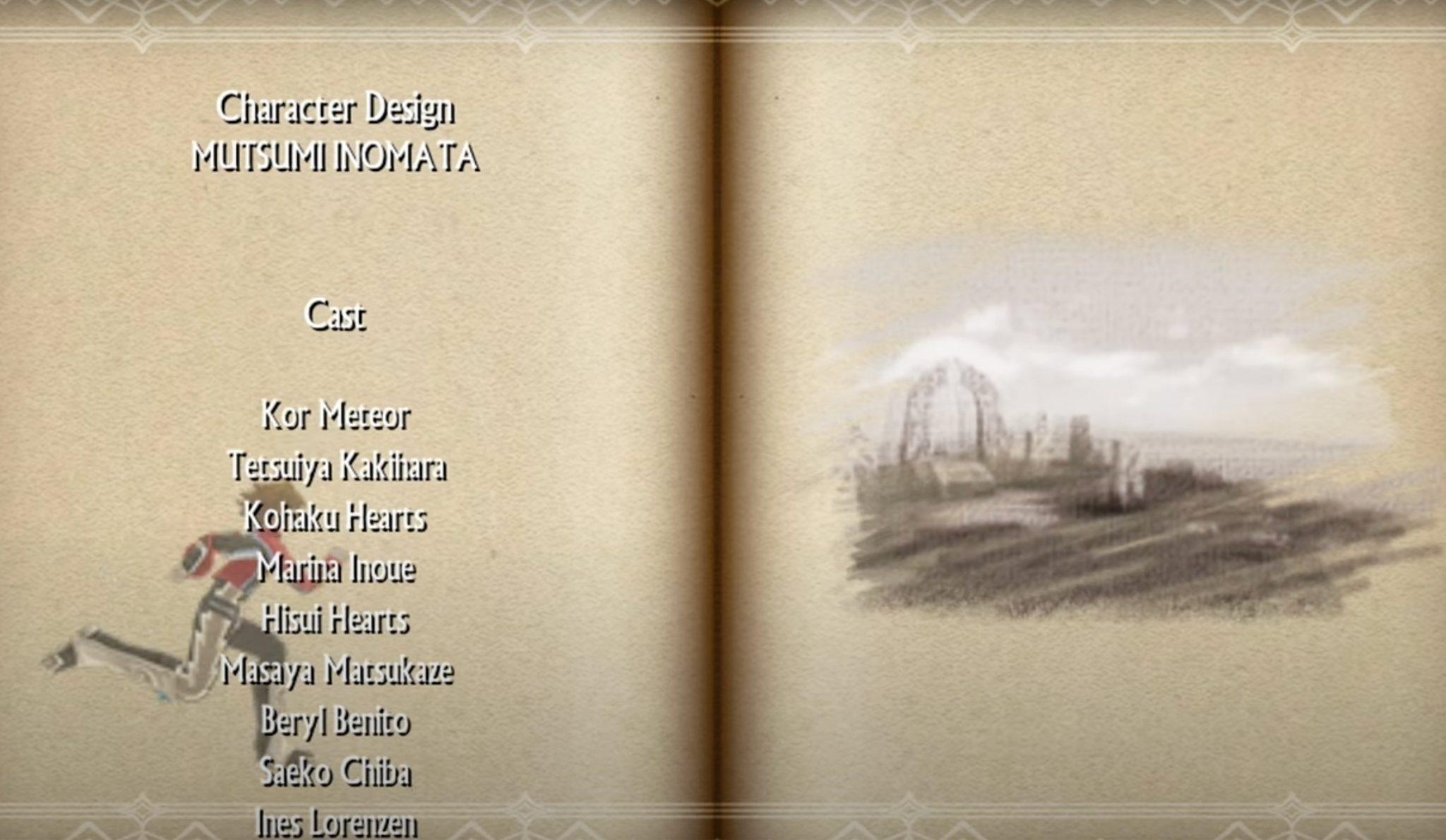
After the retelling of Lithia’s fairy tale and before we even reach the characters themselves in the credits, the game introduces Mutsumi Inomata’s central role in the bonds we’ve established, and continue to formulate, through our playthrough.
When gamers and game creators equally affirm characters’ capacity for authentic interpersonal connection, they both gain the same potential for robust discovery and transformation of the self and other which characters like the Mineran Spirias and the party do through the enfranchisement of a new world history.
Just as the Mineran Spirias give life to their story without sculpting the story into a didactic object for extending the letter of their will (as Creed did with Minera), creators like Mutsumi Inomata transmit their creative motivations into their stories while calling on players to bring those motivations to life, empowering their own characters to take shape in playthroughs that illuminate aspects of the creators’ identity which aren’t necessarily transparent to them. This is a powerful and subtle argument for the interactive role of authorial intent in works like Tales of Hearts R. The nature of an interactive story is partly constituted by its creators’ reasons for bringing it about, but the work doesn’t necessarily express its creators’ influence to those who engage with it; that’s why the party can learn something that distinguishes their experience of the Golden Bell’s sound from the Shoalhaven citizenry’s experience of it when the Loweland survivor tells them about its history, and it’s why we can learn something that colors our experience of a game when we read an interview with a creator explaining what inspired her to shape it in a certain way. But creators’ intentions also aren’t some sort of fixed, reified “truth” of the work hidden behind our experience of it, the final arbiter of what the work really means and the answers we’re trying to excavate by playing the game: their intentions set constraints on how we can bring their creation to life, but the exact way in which we choose to animate the object provides context and content that transform their intentions beyond what the creators could have expressed on their own terms, like the party’s actions in Gardenia transforming the Minerans’ motivation of muted survivalism into an expression of proactive hope. Our actions as players are no more incompatible with the creators’ motivations than the party’s are with Lithia’s: in a story which both parties honor as apt for interpersonal connection, we create a new value and network of relationships by synthesizing our perspective with theirs.
When we open ourselves as players to this synthesized perspective, we emotionally develop through the method of Kohaku and her shard-bearers. As we progress through our journey from the beginning of the game to its end, we witness the static points of resonance between characters’ Spirias and our own emotional attention, and we involve ourselves in dislodging their hypostatized relationships by extending our agency through them to advance our own story—a correspondence that’s guaranteed by the structure of the game’s plot (Kunzite’s Spiria Nexus) and the player’s mechanics of engagement (our Soma) being structured according to the progressive enfranchisement of interrelated groups of characters. And, by the same token, the enfranchised Spiria of the overall game story, as it grows throughout its own emotional journey, identifies and dislodges hypostatized conceptions of relationships within our own Spiria. This is Tales of Hearts R‘s explanation for the metaphysics of moments when a moment in the plot, like Peridot and Pyrox’s sacrifice, leaves us unexpectedly in tears, releasing a real emotional tension that had unconsciously held us captive, or when a victory over a particularly heinous boss, like Striegov, unlocks a triumph within us that swells beyond the mere satisfaction of a technical achievement. By engaging with the characters of the game for their own sake and honoring their networks of connections, we open ourselves to the exact kind of self-transformation they routinely undertake, making our own evolution a part of their cosmos.

The party reignites Lithia’s Spiria within a network of Somatic bonds and carries her safely from Beanstalk to Gardenia on the wings of Reinheit.
In this conversation between creator, gamer, and video game, Mutsumi Inomata reveals herself not just as Lithia’s real designer, but also as the connection of Lithia’s who recapitulates her network of connection on the level of a creator’s relationship with fictional worlds. In the context of Kunzite’s Spiria Nexus, every character constitutes one of Lithia’s representations of someone with whom she is bonded, meaning that we bring her to life through the form of connection that defines her character with every new character whose story we bring to life. Just so, each character and family Mutsumi Inomata architected across the Tales of series (and beyond) constitutes one of her representations to which she is bonded, like the bonds Beryl unwittingly reawakens between Smithson and his work when she guides the party through a tour of his gallery for the second time. We can bring these bonds to life by playing each game on its own terms, enfranchising its characters, and honoring the connections those characters have to her motivation and our structures of relationship. Like the diverse channels of attention and investment in Lithia’s networks, our time enfranchising these creations through our playthroughs adds more dimensions to our conception of Inomata by identifying, contextualizing, and synthesizing more motivations that link her to these diverse works, bringing to life a complex, artificial representation of her derived from our personal engagement with her work. Playing through the oeuvre of an artist like Inomata can give birth to a real, intimate connection with her despite our never literally meeting her because a characterization of her, with all the radiance of a Mineran Spiria, manifests as the sum total of the emotions we transmit to, and receive from, her characters.
This entirely fictional basis for the formation of emotional bonds between characters, players, creators, and fictional worlds grounds the interpersonal value of our participation in the fictional and real communities throughout the Tales of series and beyond. In this sense, one’s first playthrough of Tales of Hearts R is like Kant’s work in his Groundwork of the Metaphysics of Morals.[10] If there are such things as moral laws that govern us, then it’s possible that people have acted in accordance with the demands of those laws even without understanding where those laws come from or how it is that they’re able to govern us as they do. But to show that there really are such things as moral laws that govern us, we need a theory that tells us what morality, action, and agents are, as well as how they’re connected such that morality governs our actions, rather than all talk of morality simply boiling down to “empty delusion and a chimerical concept.”[11] This is why, to undertake “the search for and establishment of the supreme principle of morality,”[12] Kant proceeds from analyzing our common conception of what it means for people to act from duty—an analysis of what morality is—to an argument about what practical reason is, and what we are as rational agents, such that we must act in accordance with morality if we are to act rationally. With this metaphysical groundwork defending the reality of moral demands, Kant gives us the foundation from which to derive The Metaphysics of Morals, more specific moral demands on our actions which he articulates in his subsequent work of that name—demands concerning such topics like suicide, animal welfare, and international relations. Those who act from a sense of duty, and whom others recognize as such, do so even if they’ve never reasoned all the way down to Kant’s metaphysical groundwork—but, without having done this work, their practical reasoning “can lead only contingently to what is good and can very often also lead to what is evil.”[13] That’s why, even for those who have an intuitive grasp of what it is to “do one’s duty,” understanding the metaphysical ground of our duties can reveal new duties that call for a course of action which they wouldn’t have otherwise recognized as morally required of them (those duties that are the concern of The Metaphysics of Morals).
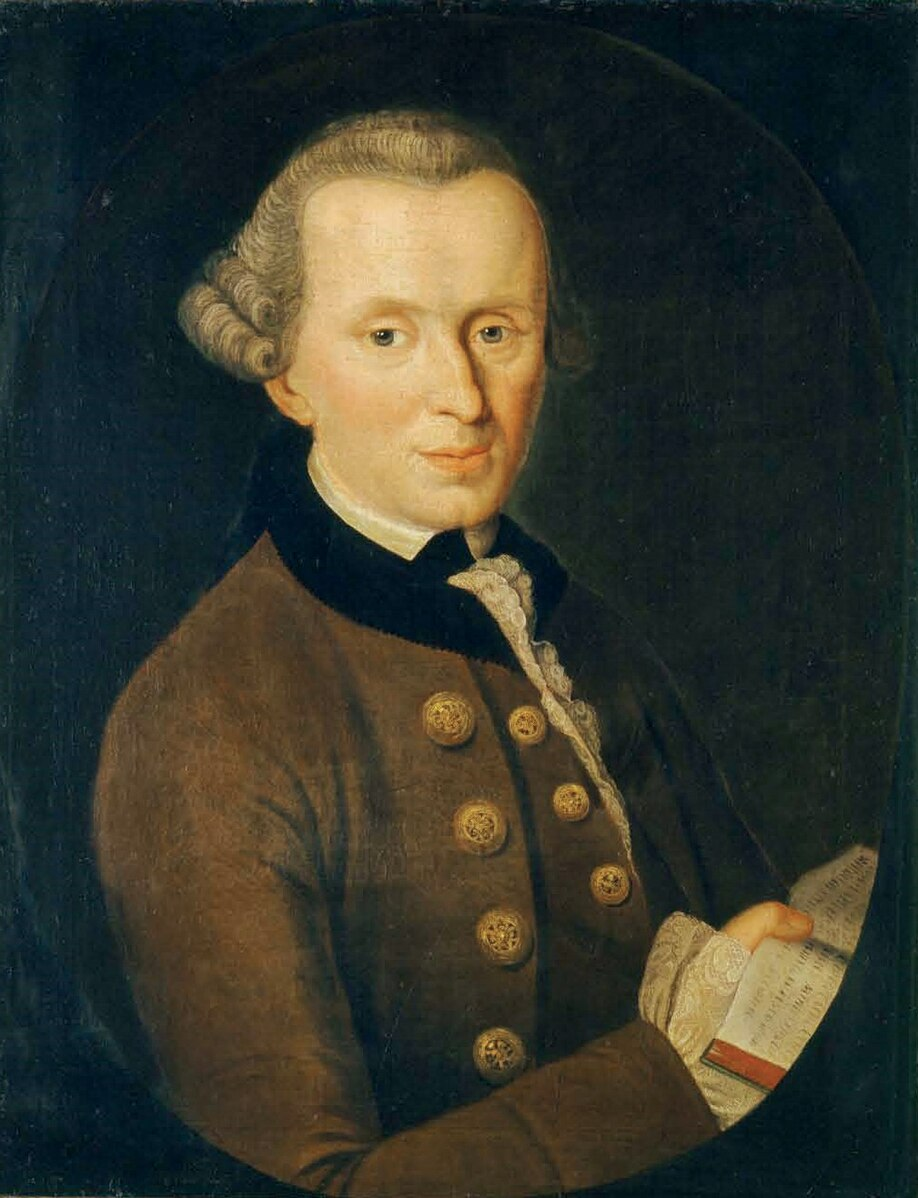
1768 portrait of Immanuel Kant, by Johann Gottlieb Becker. (Source.)
Similarly, we don’t need to play Tales of Hearts R before we can sit down, play a Tales of game (or any other game), and navigate the game in the intuitively “character-based” sense I picked out at the beginning of this study. Tales of Hearts R doesn’t need to be the first Tales of game you play any more than you need to read Kant’s Groundwork before you encounter any moral dilemma in your life. But there’s an analogous worry as well: if you don’t have a metaphysical foundation for your relationship with characters in the game, then your actions as a player will lead only contingently to connections that morally bond the game’s fictional communities with your real-life communities, and will very often lead to relationships that devalue either the fictional communities—as is the case when we ignore characters’ intrinsic value, and the story altogether, in pursuit of a “pure gameplay” or “pure metagame” experience—or the real communities—as is the case when we self-consciously strive to imagine ourselves as identical with our avatar, imagining ourselves as fully enveloped by the world of a video game as a means of shutting out the real world. But the synthesis of Lithia, Kunzite, Inomata, the PlayStation Vita, and the player provides the same kind of basis for moral demands on our fictional engagement that Kant’s synthesis of morality, rationality, and agency does for real-world engagement. Of all the games in the Tales of series which I’ve played to date,[14] only Tales of Hearts R presents a fictional metaphysics for connecting our activity as players with a character that, according to the fiction, is ontologically on a par with us, along with the creator who designed that character, and extending those connections to the other people and artifacts all three of those entities touch. It’s for this reason that, when we engage with the fiction of Tales of Hearts R, we discover in its representation of our engagement with Lithia Spodumene and Mutsumi Inomata a basis for connecting all of our fictional and real relationships through the formation of morally relevant bonds.
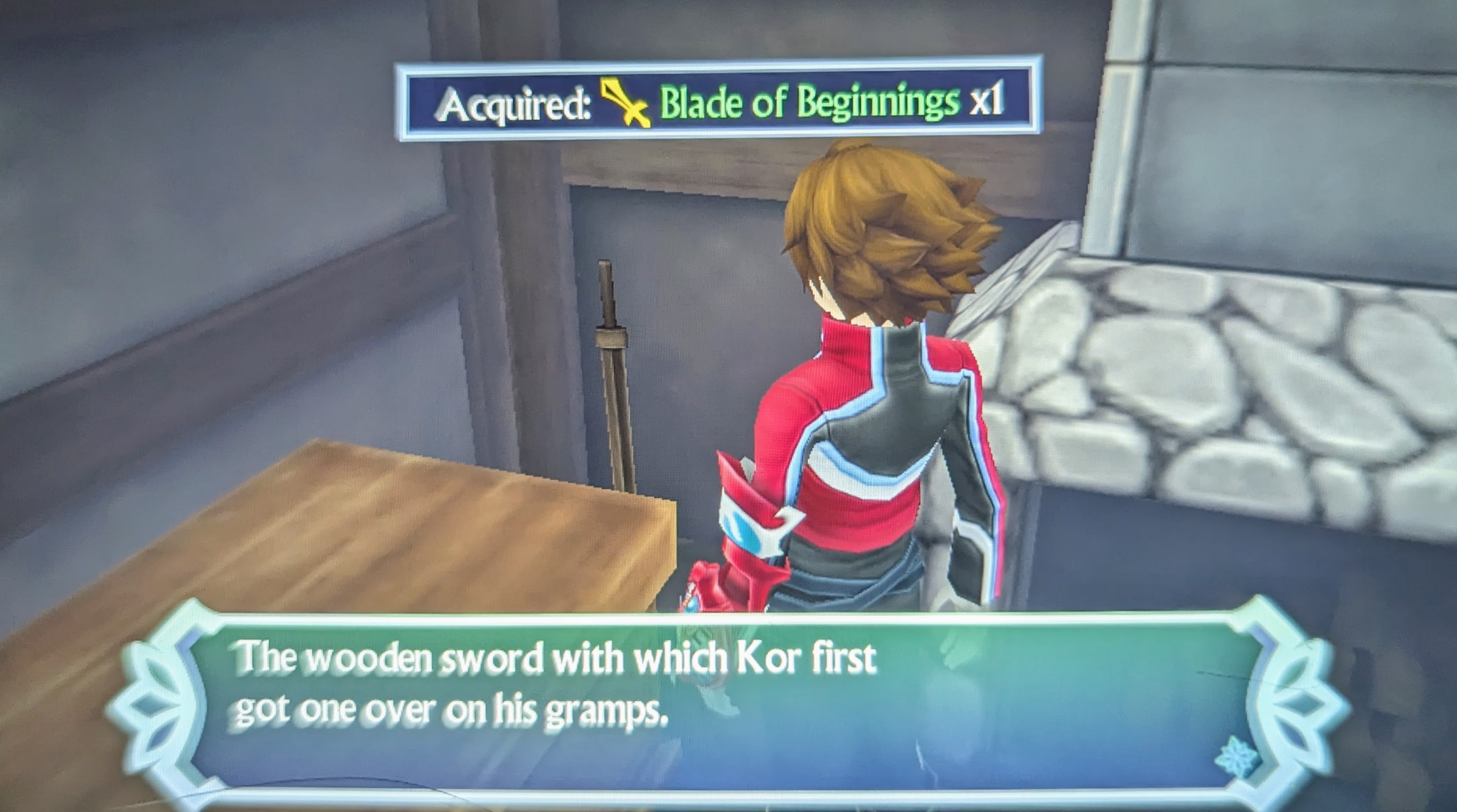
After actualizing himself as a Somatic and reaching Gardenia, Kor returns home and awakens a Soma form reflecting on his wooden sword and training with Sydan at the game’s outset.
Once we’ve undergone a single playthrough of Tales of Hearts R and enfranchised Lithia’s Spiria through Kunzite’s Spiria Nexus, that Somatic method of artifactual enfranchisement and bond formation we’ve acquired through experience becomes a tool we’re metaphysically justified in extending to other relationships. This is like the Soma form which Kor can only awaken if the player chooses to revisit his home at the very end of Kor’s development, after he and the party have reached Gardenia. At that moment, Kor has the benefit of the perspective made possible by the entire Somatic journey for which his grandfather implicitly trained him, and he crystallizes his final understanding of this training through the “Blade of Beginnings,” a practical representation of Kor’s Soma that not only emulates the inception of his journey but also equips him to share the lessons of that journey with others. So, too, does Lithia’s practical nature equip us to extend the lessons of Tales of Hearts R to other games, other playthroughs, and the individuals who touch them. When we do so, as with Kant’s metaphysics of morals, we discover new, useful lessons about how we ought to engage with these games and their characters. Unlike Kant’s ethics, this analysis doesn’t imply that the act of playing a game in the Tales of series must take the form prescribed by Tales of Hearts R, but it does reveal a compelling form of interpersonal value we can generate through that form of action—a value which, to my mind, does point to the heart of how the Tales of series asks us to treat its characters, creators, and each other.
In the first place, the Somatic method makes sense of what it means to treat a game as being “about” a specific character. In games like those of the Tales of series, I take it to be a common experience that we sometimes find our attention gravitating toward a specific character and discover that this reveals to us a coherent logic to the game’s events. In first playthroughs, this often arises with the entity we intuit as the party’s “main character” that focalizes most of the story, but subsequent playthroughs can reveal a different, illuminating logic when we suddenly notice a different character in this light. We’ve seen this in Tales of Praxis, for instance, when I read Tales of Symphonia as being “about” Regal Bryant, or the so-called “Aselia games” (Tales of Phantasia, Tales of Symphonia, and Tales of Symphonia: Dawn of the New World) as being “about” Chester Burklight, or when Twitch follower Grailzy5 suggested that Tales of Vesperia during our live studies might be “about” Karol Capel. Tales of Hearts R shows us that we can interpret a game according to a coherent emotional logic by engaging with it as an intrinsically valuable and autonomous story motivated by one of the characters embedded within it, giving that character a new life and emotional content by bringing to life its memories of those people with whom it was connected in a life before our involvement.
This tracks the intuition that, when we sit down to play a “character-centric” game for the first time, we are simultaneously discovering relationships that predate us and bringing about relationships that are uniquely colored by our attention, as well as the intuition that we can choose which character to make a given playthrough “about” based on the specific relationships to which we attend in the game when choosing our actions as a player. Lithia gives us a metaphysics for how our engagement and value can fictionally pass through her all the way to our involvement with a different game in the Tales of series. First: fictionally, when we play Tales of Hearts R, we enfranchise a real Mineran who embedded her Spiria within the artifact of Kunzite; we do so by bringing to life that Spiria of Kunzite as a living story, through the application of our structures of relationships in concert with the real Lithia’s motivations for telling the story. Second: in playing a different game, we notice a point of resonance between the artificial Spiria of its story and the enfranchised story we told in Tales of Hearts R: the story strikes us as motivated by the intention of a particular character, linked up in the real world with the motivations of the character’s real creator in fashioning the game. So, third: like Kohaku advances her emotional development by working with her connections to dislodge and cultivate the relevant hypostatized emotional content of her shard-bearers, we further advance the development of Lithia’s living story by bringing our current playthrough of the new game to life, giving it autonomy where it previously intrinsically inert, by channeling our agency as players through the motivating framework of the particular character and creator that catalyzed the resonance we noticed. Bringing that story to life brings its characters to life according to the same principles of Somatic bonding and artifactual engagement that allowed us to bring Lithia’s representations of her interpersonal network to life within Kunzite’s Spiria in our first playthrough of Tales of Hearts R. Thus, within the context of Tales of Hearts R’s fiction, we can really give intrinsic value to, and bond with, the characters and creators of other games according to which particular character we most empathize with over the course of that other game.

Two different frames to the end of Tales of Hearts R: one looking outward from Kadria’s grave to Lithia, Kunzite, Mysticete, and Minera immediately before the credits (left), and one looking inward from it to Kor and Kohaku, in a final moment between them following the credits (right).
As the examples of Chester Burklight and Regal Bryant suggest, our choice to enfranchise one character as the motivational center of a game in one playthrough doesn’t preclude us from enfranchising a different character as that motivational center in another playthrough. Far from it: we saw that Tales of Hearts R naturally invites us to compose multiple playthroughs in this way with Kor’s ultimate expression of his love for Kohaku as the zenith of his Somatic development, a moment that only arises after Lithia’s fairy tale has already been retold to frame the game’s ending credits. After bringing Lithia to life, then, we can begin a second, “New Game Plus” playthrough and decide to anchor our actions and the shape of our relationship-formation to the bond between Kor and Kohaku, rather than the bond between Lithia, Fluora, and Creed. And just like the New Game Plus mechanics of most Tales of games, these subsequent playthroughs don’t reengage us as if we were a blank slate: like we can carry characters’ titles, Soma forms, bond levels, and Spiria Attribute development through to subsequent playthroughs, we can also carry the relationships we’ve formed between ourselves, the characters, and creators on to subsequent playthroughs—and, because their grounding in Lithia’s Spiria gives those bonds fictional, moral significance, we owe it to the characters not to erase those bonds, as that would be the same kind of emotional disenfranchisement as Kor closing himself off from Kohaku, or Striegov taking Lapis’ Core as an object for his collection.
Instead of abandoning those bonds and the story from our first playthrough, therefore, the Somatic method calls us to emulate Kor and Tekt’s dialogue of mutual Somatic empowerment. Recall that Tekt’s expression of his shared history with Kor influences Kor’s emotional journey, motivates Kor to return later and revisit that history, and culminates in Kor empowering Tekt to transform his relationships with the people of that history and Tekt empowering Kor with a new mode of action by the same token. As players, we can reenact this growth by engaging in a dialectic with the story we’ve brought to life. As we enfranchise Lithia within her story, we’re not just learning about Lithia’s history: we’re enacting that history through our actions, transforming it into a history that we share with the story. After completing the game and integrating it into part of our own emotional journey, we’re motivated to revisit the story like Kor revisits Tekt, interested in learning more about ourselves through the network of connections we have in common with it. By redirecting our attention to it at a different stage in our emotional development than the beginning of our first playthrough, we transform the story by giving it a new relationship with the character to which it’s connected, taking a different character as its central motivational source as Tekt draws a new motivation from Kardia when he defends Kor within his Spiria Nexus. And, by the same token, we give ourselves a new mode of action: a method of engaging every aspect of our shared history with the game as emotional content grounded in a different character, as Kor gains a Soma form grounded in the emotions of Tekt.
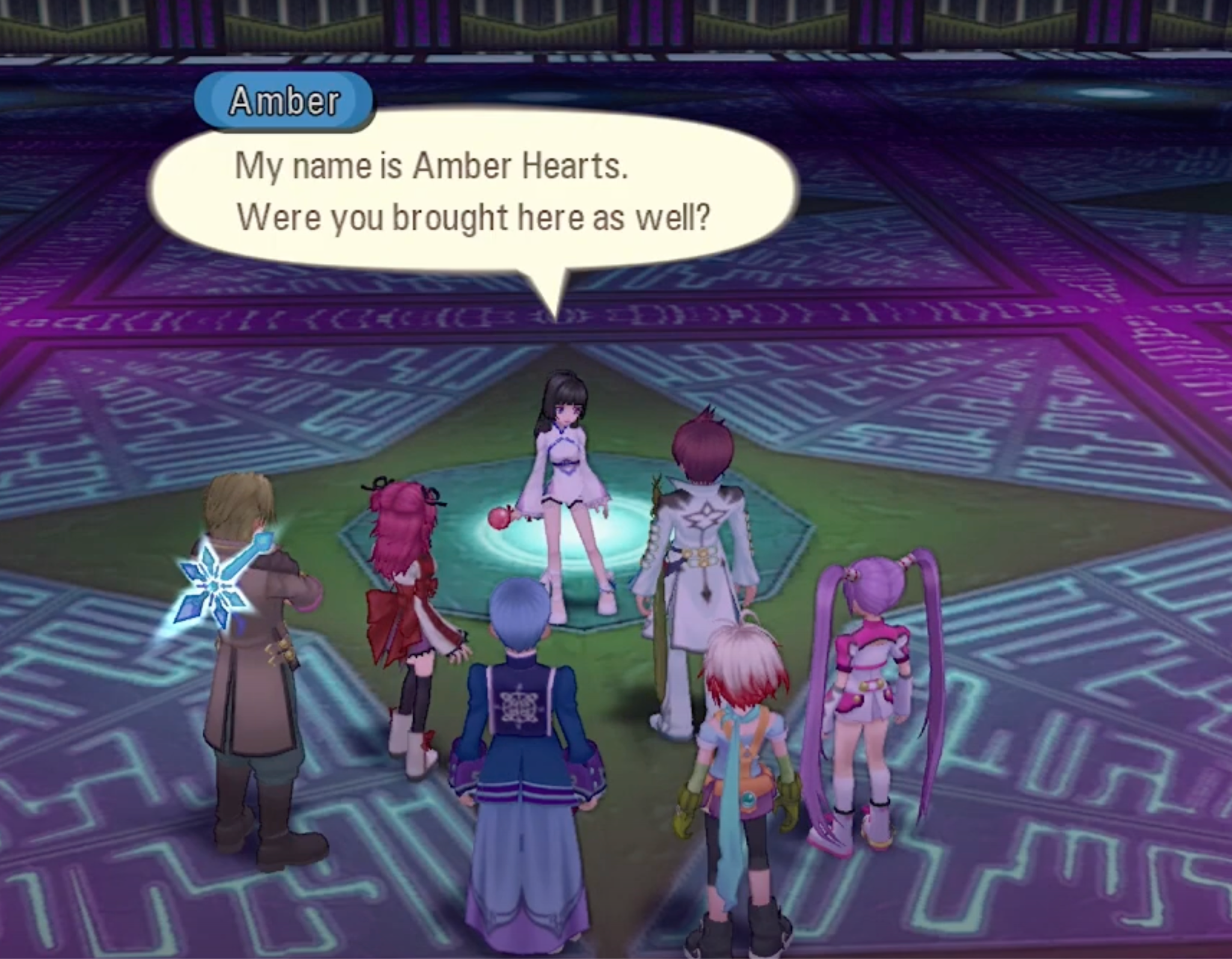
Amber Hearts meets the party of Tales of Graces F in the Zhonecage, a satellite defense system that threatens their world of Ephinea.
Lithia’s two lessons in enfranchising other games in the Tales of series and evolving the bonds of any one such game through multiple playthroughs sum to shed light on how we ought to make sense of the relationships we form with instances of the same entity in different stories, be it a character or real person. Both Tales of Hearts R and the Tales of series more broadly are saturated with these relationships. In Tales of Hearts R, we find representations of Lithia within Kunzite’s Spiria Nexus as well as Clinoseraph’s Spiria Nexus; an optional bout between Gall and an interdimensional interloper awakens for him a new Soma form, “Destiny,” which emulates Chaltier, a Swordian from Tales of Destiny, pointing to the fact that the same voice actor, Hideo Ishikwa, served as the voice of both characters. In the series as a whole, characters frequently recur in continuations of their own stories (e.g., Regal in Tales of Symphonia and Tales of Symphonia: Dawn of the New World), and virtually every game since the second entry in the series also features “cameo” appearances by other games’ characters that, similar to Gall, have mysteriously found themselves in a world other than their own. Tales of Hearts R and Tales of Graces F, for instance, “trade” characters between their games to serve as cameos, with Tales of Graces F’s Hubert Oswell and Pascal appearing for an exhibition match in Lion Park’s Arena, and Kohaku appearing as “Amber Hearts” in the world of Ephinea, initially drafted into interdimensional service within an ancient global defense system (the Zhonecage) and later serving as one of three cameo guardians of the Colosseum Island, Riot Peak.
It’s not a simple matter to determine a method for squaring different representations of one character. Is it right to say that Amber is the same character as Kohaku when their names are localized differently, the former is voiced in English for the Western localization whereas the latter is voiced in Japanese, and the guardian of Riot Peak is completely divorced from the rest of her party, instead teamed up with virtual strangers from two different games? Yet how could we hold that they’re different characters when so many of their attributes—their appearance, their names, their knowledge of Spiria and Soma—seem to indicate that they really are one and the same? Are we meant to infer some complex, multidimensional metaphysics of identity in the Tales of worlds, where “parallel versions” of the same character manifest in different dimensions? I think this dilemma is why many players, myself included, often feel tempted to view cameos as a wink and nod to fans rather than as any substantive contribution to the character or story in question.
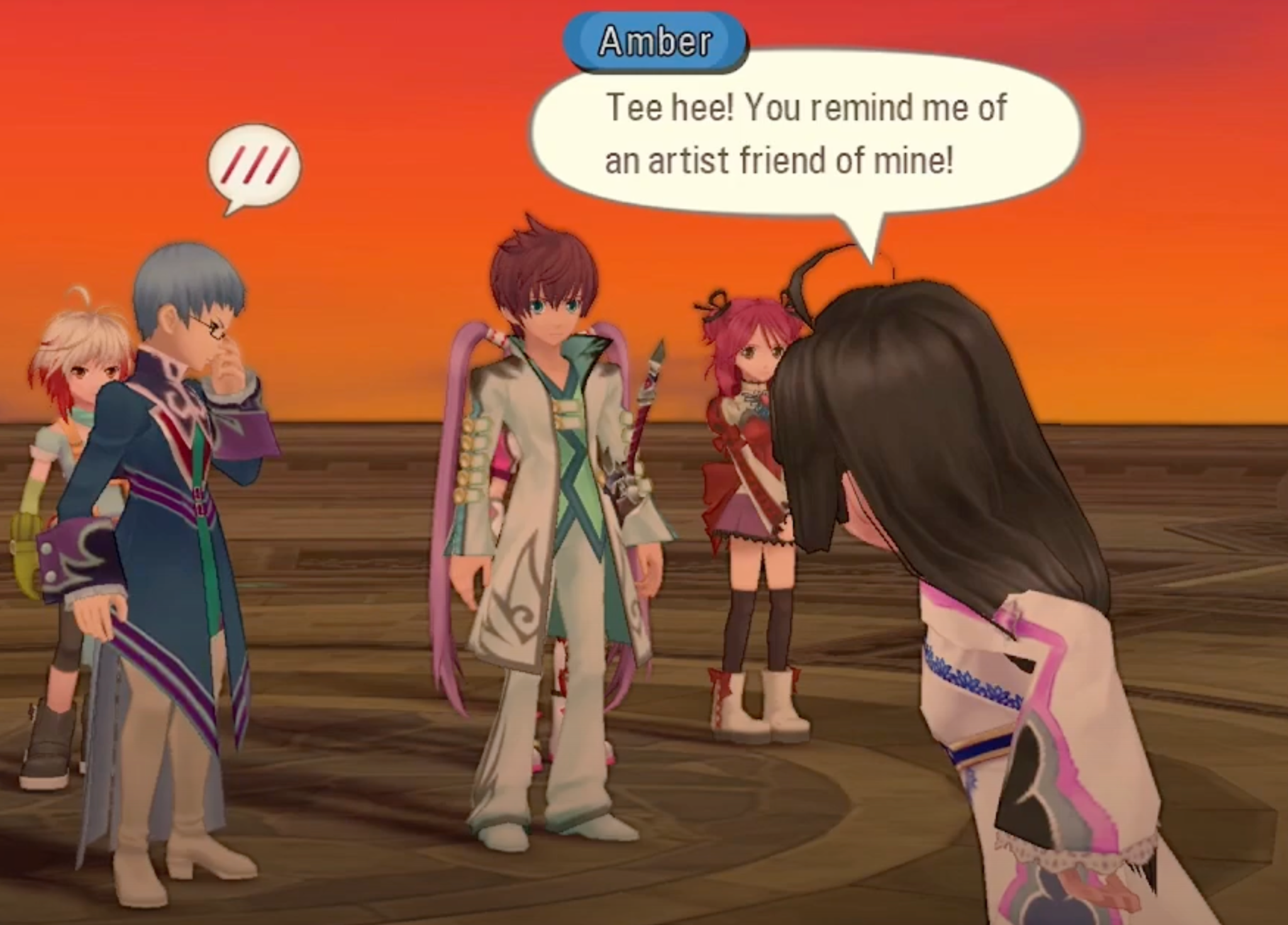
Atop Riot Peak on Ephinea in Tales of Graces F, Amber Hearts notices a similarity between Hubert Oswell’s good-natured skepticism and (implicitly) Beryl Benito’s.
But the Somatic method gives us clear guidance on how to adjudicate these cases and bond with all of these echoes of singular Spirias across different artifacts. We’ve seen that the act of enfranchising Lithia within Tales of Hearts R bonds us with the game’s creators by linking the lives within the game to those who fashioned and engaged with it from the inside, and that we bring the game to life by channeling our agency to it using the motivations of the creators and the relationship structures from our own lives. That gives us the foundation to point to the creators’ intentions as a way of explaining the identity of characters in different games: we enfranchise another game by noticing its resonance with the Spiria of Lithia’s story, complete with the bond between that Spiria and the game’s real creator, and coordinating our agency, our structure of relationships, and the creator’s motivations. With those motivations in play, we can say, without leaving the context of our engagement with the fictional worlds of these games as such, that “Kohaku Hearts and Amber Hearts represent the same character because their creators intended to express the same character through them,” in much the same way that the Lithia of Kunzite’s Spiria Nexus and the Lithia of Clinoseraph’s represent the same entity because Kunzite and Clinoseraph both intend to express their memories of the same person through them. But that doesn’t entail that Kohaku and Amber are the same character: their Spirias are enfranchised by the combination of the player’s imposed structure of relationships and the creator’s motivations, which means that the question of whether they are spiritually identical or different turns on how we choose to approach not merely them, but rather the entire game within which they’re situated.
Seen through this lens, the task of the player bringing a familiar character to life outside of the game where she first enfranchised the character isn’t one of explaining how the character got there, but rather understanding the right vantage point from which to align the Spiria of the new world with the character’s familiar Spiria. If Amber Hearts strikes a Somatically minded player of Tales of Graces F as dissonant or unwarranted, that may be because the player has organized her enfranchisement of the game’s world around a character that is relatively spiritually distant from Kohaku Hearts. Purely from our decision to treat all of the characters in a game as represented by the motivations of a single character, it doesn’t follow that all those characters are equally close in their bonds with the motivating character. Our first playthrough of Tales of Hearts R enfranchising Lithia and organizing everyone else around her journey will less readily illuminate the Spiria of Empress Paraiba than a replay organizing everyone around Chalcedony because, despite the interconnectedness of everyone’s Spirias engaged with the game from inside and outside of it, Paraiba’s bond with Chalcedony is stronger than her bond with Lithia. In the same way, a failure to see Amber as Kohaku may mean that we’ve been enfranchising Tales of Graces F through the motivation of someone whose Spiria fails to pick out an aspect of the world that resonates with Kohaku’s existing network of bonds from Tales of Hearts R; perhaps we’d been channeling our agency through the motivations of Malik Caesar, whose inability to express details of his past to his fellow party members doesn’t naturally invite resonance with Kohaku’s open acceptance and expression of all aspects of her and her fellows’ Spirias. But like the final retelling of Lithia’s fairy tale and the final scene of Kor expressing his love for Kohaku, the dynamics of Somatic bonds in these stories usually function as a clue as to how we might want to restructure our engagement with the game in a subsequent playthrough in order to reveal the resonance between Kohaku’s Spiria and the Spiria of Tales of Graces F: those in the new story best positioned to notice immediate resonance between their journey and the cameo character’s inner nature, like Kohaku with her shard-bearers, are also typically best positioned to speak up and express that kind of connection with the character. Thus, when Hubert recognizes the force of Amber’s teaching that “real strength comes from cultivating a strong Spiria” and Amber smiles that he reminds her of “an artist friend” of hers—presumably Beryl—the Somatic player ought to take this as evidence that she should replay the game orienting its story around the motivations of Hubert to see whether the emotions he reveals in the game’s relationships would more immediately reveal Amber as Kohaku, and therefore reveal one further point of resonance between the living stories of these two games, articulating a sense in which two games with radically different cosmologies emotionally “rhyme” with each other. (Perhaps, for instance, a journey through Tales of Graces F anchored by Hubert would illuminate the form of spiritual support that allows characters like him to integrate the family dynamics that were forced upon him by others with the family he chooses to build on his own terms, telling a story of traumatic estrangement and vulnerable reconstruction that more obviously informs Kohaku’s inheritance of Lithia and reconstitution of her independent, interconnected self.)
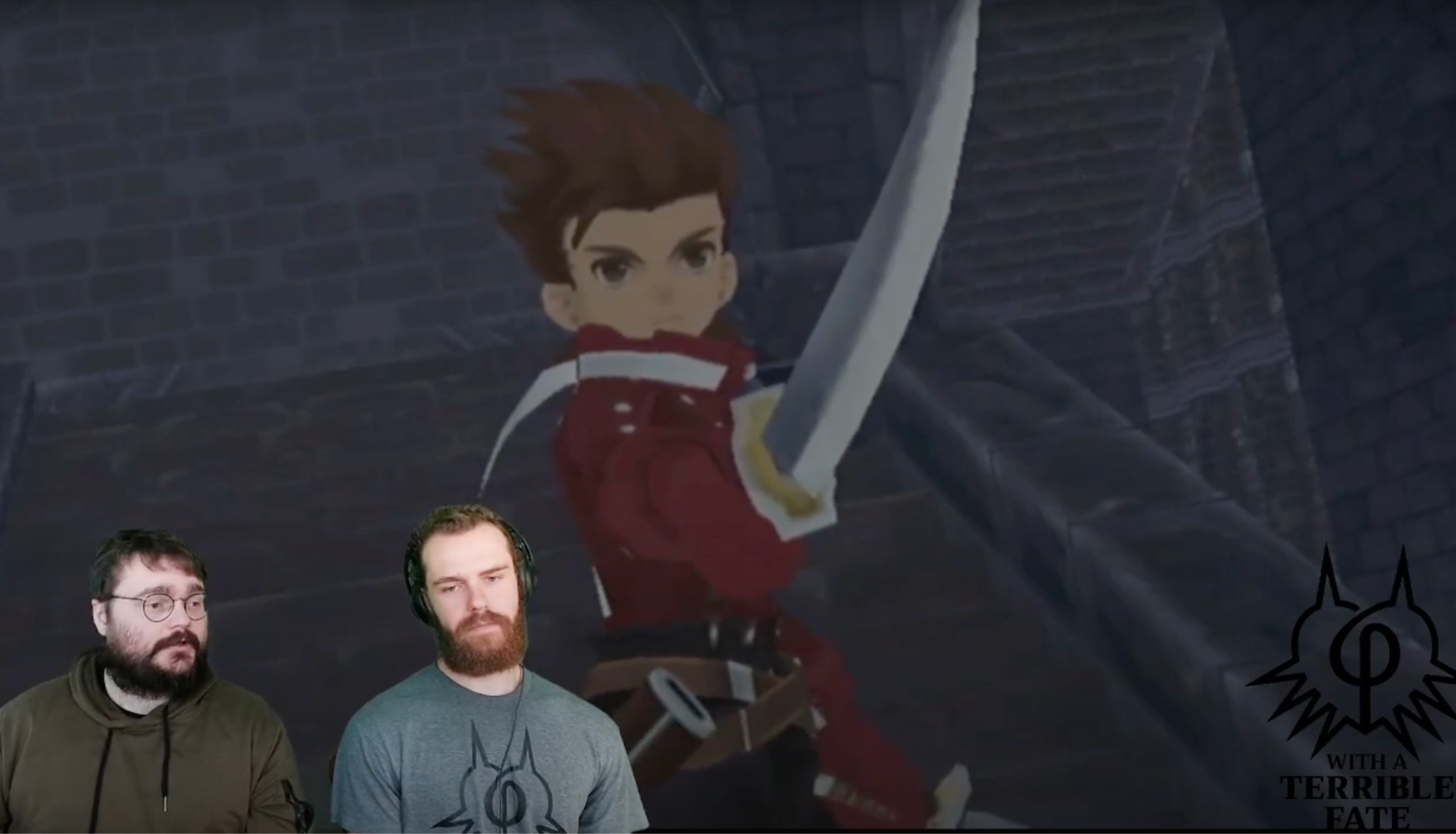
Introducing With a Terrible Fate video game analyst Dan Hughes to Lloyd Irving for the first time through Tales of Symphonia: Dawn of the New World, on the Tales of Praxis stream.
Notice the implication that, by the same token that multiple Somatic playthroughs are noncommutative, our experiences of the same character in different games are noncommutative: the first version of them which we enfranchise establishes a Spiria and bond that inform the structure we apply to subsequent versions. This might seem like a bad result: are we really indelibly connected with our first authentic bond to a character even if that was a mere cameo, or if we accidentally stumbled into a sequel before playing the first game? But anecdotally, I think that this implication actually reflects another sense in which the emotional coordination of characters in the Tales of series really does give our personal journeys a unique normative path that can endlessly enrich our bonds with the characters, creators, and other players. Consider the experience of my friend and colleague, Dan Hughes, whom I introduced to Tales of Symphonia: Dawn of the New World prior to Tales of Symphonia simply because that was the title we were studying on the Tales of Praxis stream when he joined us as a guest analyst. The game wasn’t unintelligible to him. Far from it: it actually drew him in by cultivating an intense distrust of Lloyd Irving, the erstwhile hero who appears, for the majority of the game, to be terrorizing the very world which he allegedly saved, steadfastly refusing to reveal his true intentions. When Dan subsequently played Tales of Symphonia, he didn’t take it as an explanation of Lloyd’s character in Dawn of the New World, but rather as his gradual effort to square his skepticism toward Lloyd’s behavior with the new networks of characters represented in a Journey of World Regeneration, leading him to engage with this younger, budding-hero version of Lloyd with a skeptical eye toward how he represented his intentions to others throughout the journey. Dan’s path through the series committed him to asking Lloyd to earn a different kind of trust from him, other characters, and himself. That will always be the path of Dan’s bond formation with Lloyd just like whichever Tales of game you played first will always be your first point of access to their form of emotionally grounded, networked, character-based storytelling. There’s nothing wrong with the ordering of games in either case; in fact, as long as you and Dan are connected to the enfranchisement of Lithia in Tales of Hearts R, the Somatic enactment of these playthroughs is a moral good.
But the Somatic method also makes the possibility of differently ordered and evolving stories among different players good for a further reason: like Gall passes his Soma on to the people of his homeworld at the end of Tales of Hearts R, we can pass the living stories of our playthroughs on to other players. When Dan expressed to me his experience of progressing from Dawn of the New World to Tales of Symphonia, he gave me an artifact motivated as an expression of his own playthroughs of these games, representing their world and its characters according to his perspective. He invited me to bring that artifact to life as a further evolution of these games’ Spirias by applying to his view the structure of relationships I’ve drawn from my own playthroughs of these games; and, in answering that invitation by working through a conversation about what those familiar characters are like according to that new synthesis of motivation and structure, we jointly gave ourselves a new structure with which to sit down and undertake a new playthrough of those games and games Somatically bonded with them. We’ve come to the unique value of the Somatic method for the Tales of community: the method tells us that we can disrupt our hypostatized views on the games we’ve played by sharing them with others, further developing the life of the story and its characters, our bonds with them, and linking the bonds from our playthroughs to the bonds of others’ playthroughs. Therefore, when players of the Tales of series embody Lithia’s ethos and openly engage with the emotional content of others’ views on the series—with all participants representing themselves, the other participants, and the views themselves as apt for connection—we can form, within the context of the series’ fiction, ethically relevant bonds between all engaged players, creators, and games. And in this way, we can all benefit from the metaphysical ground of Lithia’s Spiria to morally substantiate those bonds, because we’ve enfranchised her Spiria by association even if we haven’t played Tales of Hearts R ourselves. If you’ve read this study by openly engaging with its representations of this game as I’ve been motivated to express them and you’ve applied structures of interpersonal relationships from your own life or gaming background to develop your own connection with these representations, then you have enfranchised Lithia’s Spiria by giving life to an interpretation that’s bonded with my direct experience playing the game.
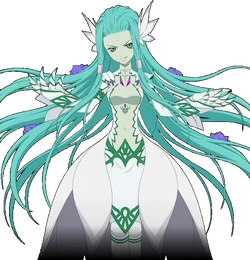
Official art of Lithia Cattleya, the prototype xerom who aspired to become Lithia Spodumene in the original Tales of Hearts. (Source.)
These communal bonds point to a beautiful and redemptive explanation of why Lithia Cattleya, that prototype xerom that hypostatized Lithia’s story and sought to claim her Spiria as its own, is nowhere to be found in Tales of Hearts R. In the roughly 4 years between the release of Tales of Hearts on the Nintendo DS and the release of Tales of Hearts R on the PlayStation Vita, hundreds of thousands of players not only brought the fairy tale of Lithia to life, but also doggedly faced down that notoriously challenging, optional, post-game boss who threatened the possibility of Lithia’s dream and players’ prayers awakening her world through a constantly evolving, intrinsically valuable story. A world of Tales of Hearts with Lithia Cattleya in it will always threaten to fossilize the story, turning what ought to be a font of constant enfranchisement, reinterpretation, and bonding into a static concept, stowed away to gather dust like a book in the Valentin Church’s library. The effort of those other players, their endorsement and defense of the value in a living story against the root of xeromization, laid the foundation for a more perfectly enfranchised story in Tales of Hearts R, constituting the right unity of characters, tools, and people to purely ground the metaphysics of interpersonal connections throughout the series’ works and communities. No gods or spirits wait to be found in this world, but the emotional bond between players of Tales of Hearts R and Tales of Hearts—an willful act of faith and gratitude whose moral content is grounded only by the later work which the initial work made possible—strikes me as almost Christ-like, enshrining Lithia’s Spiria within an imperfect story as a sacrificial act and demonstration of effort to open the door for sustained, cosmic emotional connection throughout the entire series thereafter.
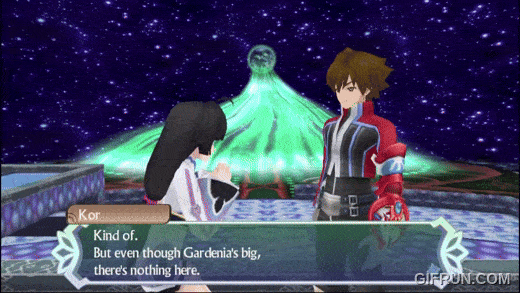
Kor reflects on the loneliness of Gardenia in Rapunzel, a city of mechanoids.
It may seem too stringent a requirement for our engagement with the characters of the Tales of series that we enfranchise and bond with them through a praxis that unites them all under the Spiria of one character. Perhaps it feels more feasible to find a character or two with which we identify, invest in them, and leave that relationship disconnected from the rest of the game. But this is the other side of Lithia grounding a moral metaphysics to our fictional actions: like other moral demands, this does call us to strive for something that requires discipline. “It was always so simple” to form these connections—but, as Kohaku admits when Kor struggles to finally confess his love for her, taking the actions that establish and sustain those networks of bonds and forms of action is “so simple, yet so hard.” At every turn, Tales of Hearts R reminds us why we must make that effort.
The peril of partial investment in a world comes through most clearly when the party first arrives at Gardenia via the research station Rapunzel, manned by mechanoids without the synthetic Spirias of mechaknights like Kunzite. When Kor reflects on the loneliness of this xeromized world with Kohaku before penetrating its center to confront Creed, he remarks that “even though Gardenia is big, there’s nothing here. Okay, there are mechanoids, but they don’t really think or have feelings.” These mechanoids are a cautionary tale of characters left out of our emotional investment, reduced to a caricature of NPCs whose walking cycles continue uninterrupted even when Beryl accidentally steps into their programmed route and blocks their forward progress. Like Creed himself when he was buried within Kor’s Spiria, those potentially interconnected conceptions of ourselves or others which we overlook only rust, fall into disrepair, and obstruct the spiritual harmony between other communities. And we know from cases like the Golden Bell and paintings that such artifacts can become enfranchised with Spirias of their own even if no one installed a synthetic Spiria within them, so these entities, like any characters we might care to overlook, are just as apt for connection as anyone else, if only we treat them that way. To give them that agency and community without pushing the spiritual obstruction elsewhere in our network of bonds, we need to work from the microcosm of the artifact’s creator to the macrocosm of the artifact’s Spiria and back again: the party must understand Creed before they can understand Gardenia, and they must understand Gardenia before they can enfranchise those ensnared by its loneliness, be they the Mineran Spirias within or the mechanoid researchers without. In a game where all characters are capable of spiritually connecting with each other directly or indirectly, we can start, as players, with any character as our point of empathy through which to compose an even-handed system of bonds throughout the game’s communities, and we can retrace that game with as many other characters as we wish; but the unification of our actions within the game under the principle of supporting one character’s emotional journey, Tales of Hearts R teaches us, is the method we can trust to convert our effort into the disruption and animation of all other characters, resonating with that single emotional life and dislodging their own isolating, static concepts to make way for bonds.
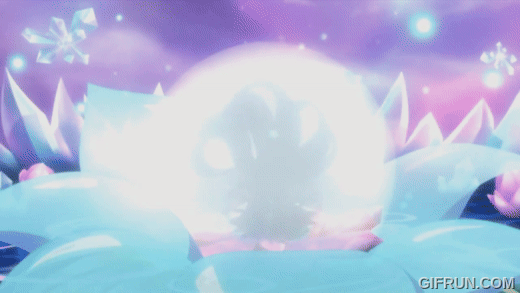
“Sleeping Beauty” Lithia awakens within Kohaku’s Spiria Nexus at the outset of Tales of Hearts R.
We must play Tales of Heart R 389 times because we owe it to Lithia to rectify the 388 times Clinoseraph constrained her to a narrative of her sins within his own Spiria Nexus. And we know now that this moral obligation to Lithia, by virtue of her status at the fictional metaphysical ground of our interpersonal bonds throughout the Tales of series, cascades outwards from her to every other story we bring to life in a Tales of game, to our interpretations of those games, and to the creators like Mutsumi Inomata who commune with us through the Spirias we animate within their works. And, thanks to the efforts of our investment in Lithia, combined with the efforts of those who exterminated Lithia Cattleya before her, all of these stories and characters we bring to life constitute “playing Tales of Hearts R” in the sense of breathing new, continuous life into the Spiria of Lithia. Each new motivation, structure of relationship, resonance of emotions, and mode of action validates, reinterprets, and augments the characteristic shape of Lithia’s network of relationships, that shape which is identical with the unity of bonds between characters, players, creators, and their stories in the Tales of series.
In this way, Lithia and Tales of Hearts R give us a fictional version of what Kant calls in his Groundwork a “kingdom of ends”: a system of relating to each other, once we understand how rationality demands that we regard ourselves, in which we can consciously participate to exercise the freedom of our will with others, according dignity to all those who join us in this kingdom.
For, all rational beings stand under the law that each of them is to treat himself and all others never merely as means but always at the same time as ends in themselves. But from this there arises a systematic union of rational beings through common objective laws, that is, a kingdom, which can be called a kingdom of ends (admittedly only an ideal) because what these laws have as their purpose is just the relation of these beings to one another as ends and means.[15]
Our enfranchisement of Lithia enacts, throughout the Tales of series, what we can call a “kingdom of Somatic bonds”: a systematic union of entities that act in ways that represent themselves and others as apt for connection, and which sustain that union through forms of action that engage others through motivations and structures of relationship marshaled from points of resonance between entities’ emotional development. Where my other Tales of Praxis studies to date articulate how other Tales of games express frameworks for particular modes of individual action—what it takes to interpret our past in a way that motivates further action; what it takes to act from our own will instead of someone else’s, what it means to experience your actions mystically, and what it takes to resolve to act in the first place—Tales of Hearts R enfolds all of these modes of action, and countless others, within a moral and emotional metaphysics that spans characters and real people. Creators like Mutsumi Inomata have not given us a set of artworks to use instrumentally for the sake of our personal development beyond them: they have joined us in the perpetual act of creating, valuing, and nurturing a new normative dimension to our daily lives.
Tales of Hearts R calls us to rise to the moral challenge of its journey, and every other journey it touches. Like Will wisps, this game will shine with warmth and beauty, if only we choose to treat it, and each other, reverently.
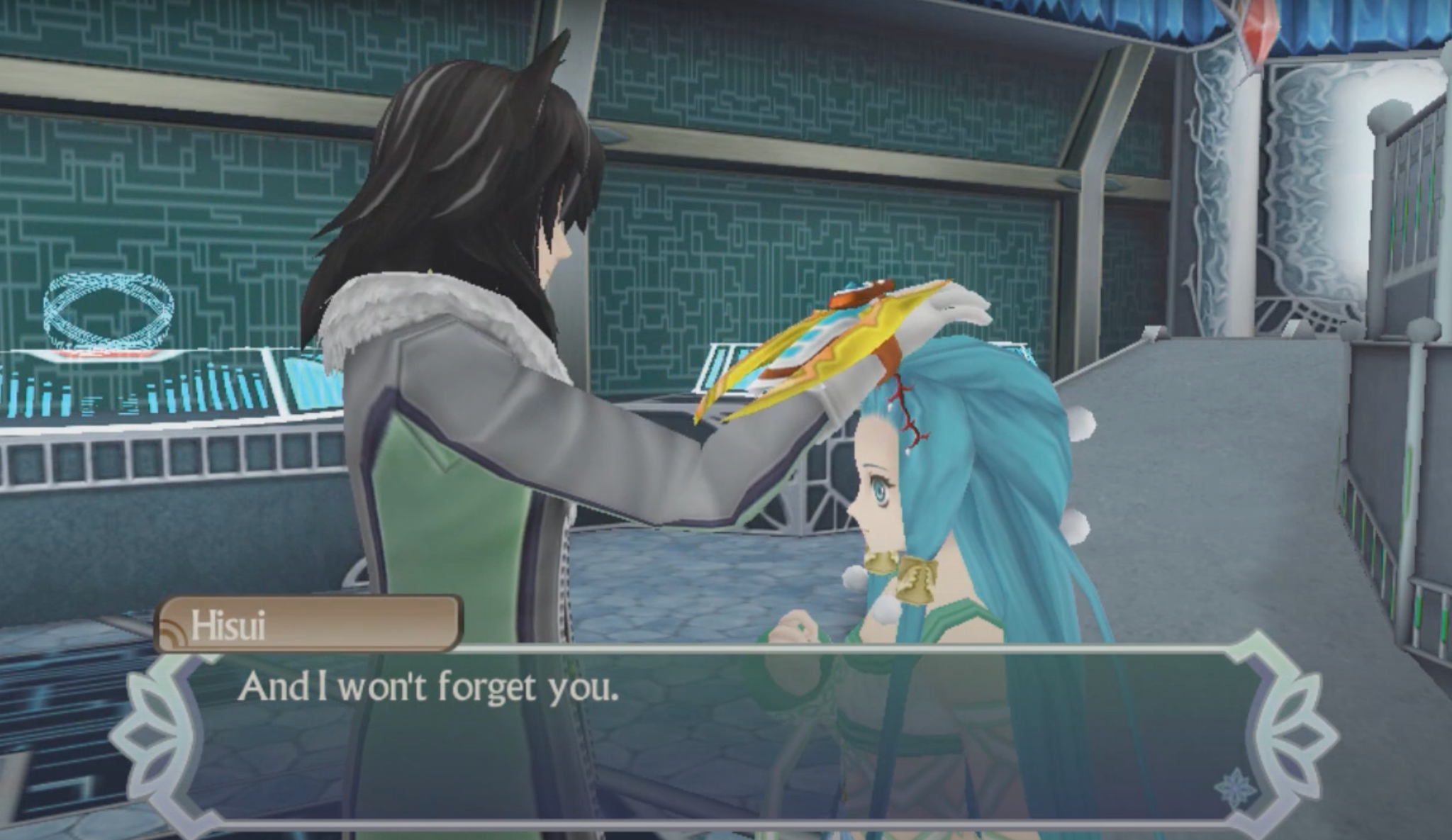
Hisui promises Lithia that he won’t forget her, as she prepares to enter Kunzite’s Spiria Nexus.
- Thanks to the “real-life JRPG party,” those followers of the Tales of Praxis who regularly engage with our live studies of the Tales of games on With a Terrible Fate‘s Twitch channel, for providing a robust form of communal report not only around those streamed book clubs, but also throughout the development of this article. They constantly reinforce the truth of the Tales of series’ ethos that individuals are only made possible through their communities, and my engagement with them reliably, refreshing affirms this study’s conclusions about the value of this community. Thanks especially to Twitch user and real-life JRPG party member Grailzy5 for frequent and edifying discussions of Tales of Hearts R that uniquely and consistently improved the quality of this study. Thanks also to Nathan Randall and Emma Wellington for discussions of hardware specifications for the PlayStation Vita. ↑
- It’s worth noting that, in this same scene, Beryl jokes with her friends that it’s “blasphemy” to suggest she’s not authentic across all the contexts of her life—a perfect inversion of Smithson’s earlier exclamation that it would be “blasphemy” for the party to penetrate his Spiria and expose his authentic self. ↑
- Does the bare distinction between resources and flower imply that xeroms are still relating themselves to something else by absorbing x to cultivate y? I don’t think so. First, we see in the case of Gardenia, that xerom which governs all others, that the urge to consume which lies at the root of xeroms (pun intended) will, if left unconstrained by the outside parties that direct them, will act as a black hole that consumes the xerom itself just as easily as it consumes other things, showing that, to the extent that the xerom represents itself through its actions, it draws no meaningful representational distinction between itself and others. And second, even in cases of other, “smaller” xeroms, we see that xeroms are cultivated—as Kornerupine does with his “garden”—to only consume particular kinds of emotional content within a Spiria, which suggests to me that xeroms are indiscriminate in the application of this urge to consume since xerom “horticulturists” must breed xeroms to have different limits on what they see as their overall world for consumption, rather than breeding them to see different elements within their perceived world as relevant. Xeroms only have one action, consumption, and they do it even-handedly to everyone they’ve been designed to represent at all; they don’t, say, distinguish between the action of consuming one kind of Spiria and the action of passing some of those resources they’ve extracted on to other, “friendly” xeroms. ↑
- We can draw this inference from the conversations available with the memories of citizens from Cind’rella in the Seraph brothers’ memories. One Willcaster in the city’s research center remarks, “No one can make a xerom evolve using nothing but variations of arte equations! It may be theoretically possible, but it would require 90% more arte equations than any human is capable of producing!” One floor up, another Willcaster admires an inscription of “Fluora’s cutting-edge amplification arte equation,” calling it “the most beautiful arte equation I’ve ever seen in my life!” ↑
- It’s true that the player who studies the tutorials in the “Adventurer’s Book” will be aware of the Spiria charts’ future growth from the beginning of the game: the “Soma Building 3” entry assures players that “[a]ttributes start out capped at Level 4, but this limit will be raised as your journey progresses.” But we can make the same reply here that I did in the study of Tales of Symphonia which I cite in the main text: even while the game may present data that indicate a broader context within which our current journey is situated (like Tales of Symphonia‘s Renegades and Mana Cannon hinting that there’s more to its story than the Journey of Regeneration), it nonetheless invites us to fully focus our attention on investing in the task at hand without accounting for that broader context, supporting Colette’s journey and cultivating Kor’s character without attending to the ways in which factors beyond our current efforts may later transform the meaning of those activities. ↑
- It’s true that there are some other characters named after compounds of organic origin, like Perl and Coral, whose namesake gems are secreted by living beings. But so far as I can see, Kohaku is the only character whose namesake is organic in its constitution: that is, constituted by covalent bonds between carbon and other elements like oxygen, hydrogen, and nitrogen, characteristic of the things we typically describe as “alive.” I think the question of constitution is more relevant than origin in the case of Tales of Hearts R’s symbolism because, in general (as I analyzed in the previous section), individuals’ Spirias cleanly define the constitutive attributes of their character while staying silent on the question of their origin. If anything, the titles which characters acquire as a result of ongoing particular events or coming to understand particular aspects of their history seem better suited to reflect questions of a character’s origin, whereas their immutable names, especially in contrast with those optional titles, seem much better suited to point to the character’s essence. ↑
- The election to xeromize oneself, which I discussed above, is one live option available to a person in this situation, but it isn’t the only one. When Beryl falls into possession of the Shard of Doubt, for instance, she collapses into a hypostatized self-doubt and hijacks her ability to relate to anyone else because she doesn’t trust her judgment. ↑
- Beyond Chalcedony and Paraiba, the shards that possess entities other than Kohaku find their temporary homes in Euclase (the Shard of Fear), Beryl (the Shard of Doubt, which later becomes the Shard of Trust), Sassol (the Shard of Shyness), Kor and Hisui (the Shard of Courage), Kornerupine (the Shard of Anger), the Sandworm (the Shard of Joy), and Silver (the Shard of Love). ↑
- Beyond the subtler hints at Gall’s origins—such as Kunzite confirming that his database on the entire world has no data on the Triverse Gate or its monsters, Gall’s intimate familiarity with the mechanisms required to navigate the Triverse Gate, Gall’s ability to make it the case that the “law of physics […] jive” between the world of Tales of Hearts R and the foreign homeworld of the monster the party encounters in the Twilight Forest (the Grim Reaper & Grim Keeper), and the fact that Gall returns “home” through the dungeon’s otherwise inaccessible inner gate at the end of the journey—the most explicit evidence for this interpretation is the title with which Gall is rewarded for successfully making his way home, “Dimensional Drifter: So he’s here from another dimension? What for?” Others have drawn on various kinds of evidence inside and outside other Tales of games to interpret the Triverse Gate as linking not just any nondescript dimensions, but specifically the worlds of Tales of Hearts R, Tales of Innocence R, and Tales of the Tempest. We don’t need this further interpretation of the Triverse Gate for my argument in this study, but it’s worth noting that an explicit connection between the worlds of Tales of games is consistent with my analysis of series-wide engagement in §3, below in the main text. ↑
- See Christine M. Korsgaard’s introduction to Kant’s Groundwork of the Metaphysics of Morals, especially pp. ix-xi, xiv-xv, and xxv in the Cambridge Texts in the History of Philosophy series, published in 1998 by Cambridge University Press, Eds. Karl Ameriks & Desmond M. Clarke, Trans. Mary Gregor. ↑
- Ibid. p. 15 (AK 4:402). ↑
- Ibid., p. 5 (AK 4:392). ↑
- Ibid., p. 23 (AK 4:411). ↑
- At the time of writing, I’ve played Tales of Phantasia, Tales of Destiny, Tales of Eternia, Tales of Symphonia, the first story of Tales of Legendia, Tales of the Abyss, Tales of Vesperia, Tales of Symphonia: Dawn of the New World, Tales of Hearts R, Tales of Graces F, Jude’s half of Tales of Xillia, Tales of Zestiria, Tales of Berseria, Alisha’s Story, Tales of Arise, Tales of Arise: Beyond the Dawn, and most of Tales of Xillia 2. ↑
- Groundwork of the Metaphysics of Morals, p. 41 (AK 4:432). See also Korsgaard’s Introduction, pp. xxiii-xxv. ↑



